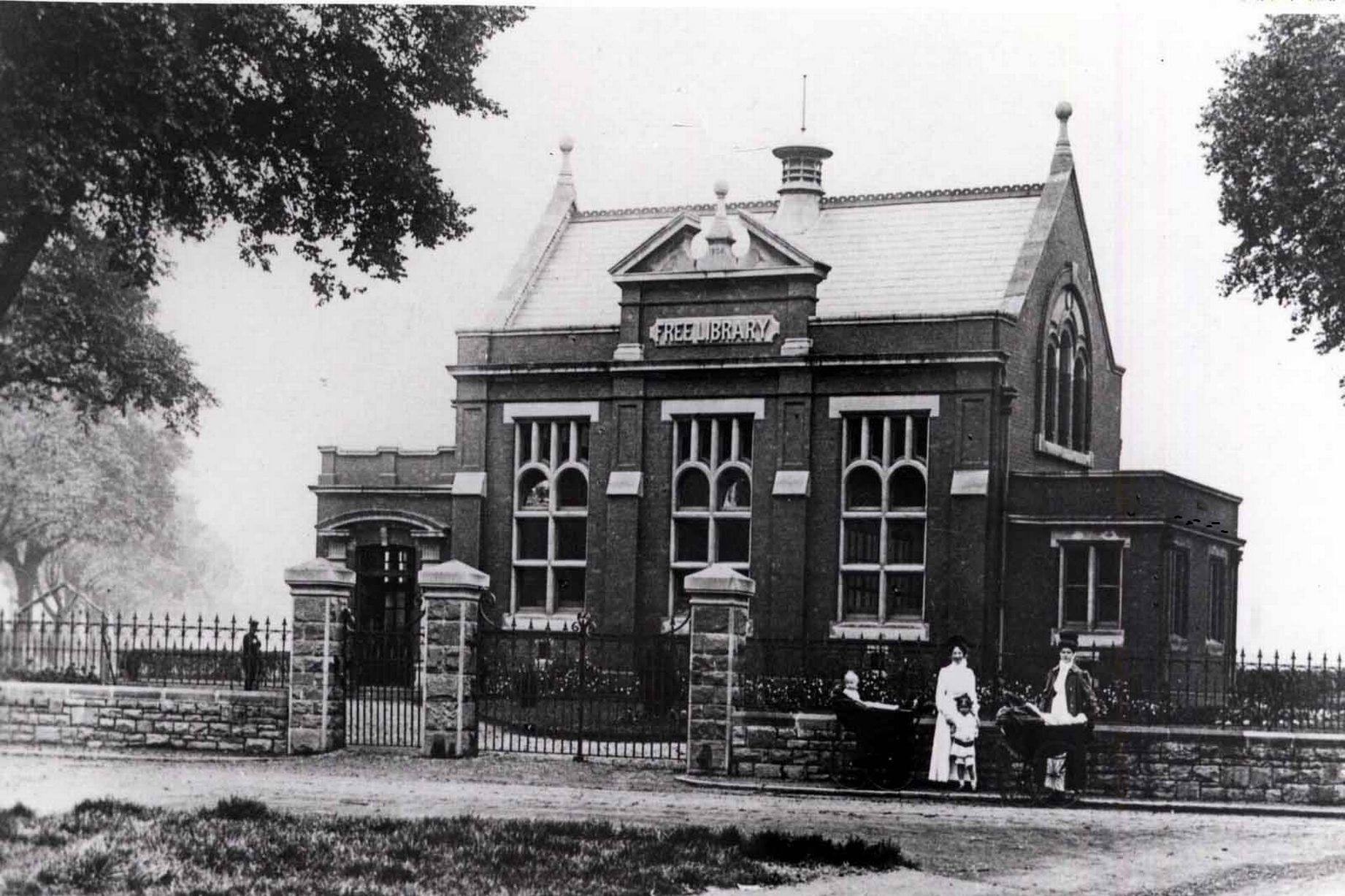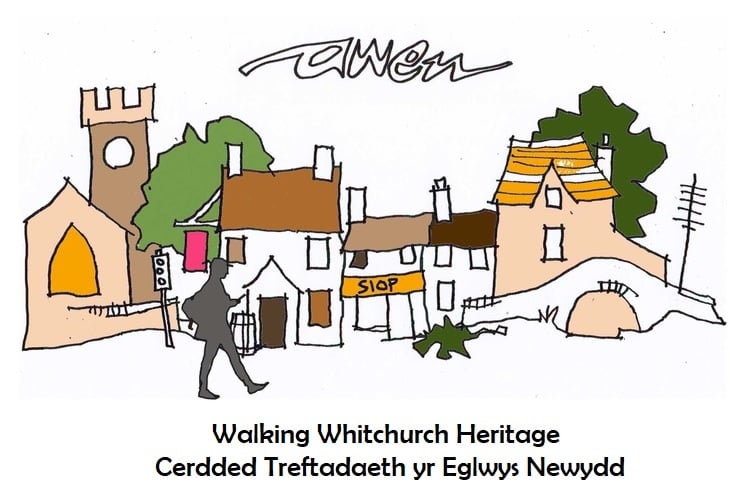Navigation
Newyddion / News
Letters to our younger selves and responses by Whitchurch High School students.
Memories of Whitchurch
Click on the article headings in blue below to view the full article
By: Terry Chard on 03/07/2024 LLANDAFF YARD (Ep. 6) - Our Pubs This is the last in the series. The local pub, like the church, was once the heartbeat of the Llandaff Yard community. You know of The Railway; The Royal Exchange and The Pineapple and many will also remember The Crown and The Cow and Snuffers, but, there was more. 200 years ago, for a pub to be viable, it needed a community of 250 people, now, it’s more like 3000. Just as in Whitchurch (and probably most of the land) these pubs and the ones you are about to hear about all fell foul of the vague interpretations of the old Sunday drinking laws and for ‘keeping a disorderly house’. Some were repeat offenders and a few, probably ceased to exist because of it, an evocative memory of another time as we lose more and more.
According to The Pub History Society, the 1872 Act apparently remains in force today and it is illegal to be drunk in charge of a horse, a cow, or a steam engine, with a possible penalty of £200 or 51 weeks in prison. Under the Act some drinkers became infamous “bona fide travellers”, those who could be served outside of normal trading hours. Travelling in good faith meant that you should not be “travelling for the purpose of taking refreshment”, but you could be “one who goes into an inn for refreshment in the course of a journey, whether of business or pleasure”. While people posing as travellers were regularly charged and prosecuted, it was difficult to prosecute licensees who had a handy escape clause in the law. To find the publican guilty, the prosecution had to prove that the licensee did not “honestly believe” that his customer was a bona fide traveller when serving outside of normal opening hours. The accepted distance for ‘travel’ seems to have been 3 miles.
The 1880’s didn’t bode too well for The Crown and landlord George Steel and his wife Frances, for whatever they were selling, they were each fined: him 13/- (13 shillings) and her 10/- + costs, him for having ‘unjust measures’ and her for ‘unjust weights’ and ‘unjust scales’ according to the South Wales Daily News on 5th April 1881. Our George came in for it again for “selling beer at an illegal time on Sunday” (6th Sept 1886 The South Wales Echo). He was fined 20/- + costs and 3 ‘customers’, who lived close by, were fined 5/- each + costs, (6 others got away). He was fined 20/- again in 1897 for the same offence (25th May The Evening Express). Enoch Griffiths got away with one though, in 1900 (The South Wales Echo 16th July) the landlord claiming that ‘he was a servant in the house and slept there’ even though he had run from the police at the time. “The bench considered the case a suspicious one, but dismissed it”. ** 13/- = 13 shillings = 65p today but probably a week’s pay back then
On 20th February 1900 The South Wales Daily News reported on Alice Davies, landlord of the Exchange, Llandaff Yard, she was “fined 10s and costs for selling rum 27 degrees under proof. Mrs Davies, in extenuation, stated that the liquor had been in the house since Christmas”. (A case of the ‘Angels share’ no doubt, the alcohol having evaporated to the heavens).
The Railway was in the occupation of Eliza Brookman when it was put up for auction in The South Wales Daily News on 14th April 1880. At the time it was under lease from Miss Harriet Diana Arabella Mary Richards and the Right Hon. George Rice Baron Dynever. In 1882, on the 16th December in The Weekly Mail, a “D.C. Samuel of The Railway Inn, Llandaff Yard, was fined 5s (5 shillings) and costs for having unjust measures”. A few landlords came and went and on 14th Jan 1888 The Cardiff Times reported that “Joseph Harding, landlord of the Railway Hotel, Llandaff Yard was summoned for selling beer on Sunday December 25th”. Eight men were in the bar claiming to have travelled from the dock area of Cardiff, however, 7 of the men were from Llandaff and one escaped. The landlord was fined £5, or one month (imprisonment) and had his license endorsed. The defendants were each fined 5s. A similar case was brought against William Amos, landlord of the Railway Inn, Llandaff Yard in 1893 in the Evening Express on 17th July, he had the same fine. One of the local characters was David Davies (Railway Hotel, Llandaff Yard), whose funeral was reported in the Evening Express on 29th December 1903, a shoe maker by profession, but best known as the toll keeper at the North Road Gate and ‘the last of the recognised gate keepers in the Principality’.
“Isaac Thomas, landlord of the Pineapple, Llandaff Yard was charged with selling beer at 20 minutes past eleven o’clock on the night of Sunday the 31st March”, according to the Cardiff and Merthyr Guardian on 13th April 1872. “A penalty of 20s and costs was inflicted”. The pub was put up for sale, by public auction and advertised in The South Wales Daily News on 15th Dec 1876, including ‘Skittle Alley, Stable and Cottage and held under lease from the Messrs Romilly’ and again for sale by public auction on 28th August 1880 in the South Wales Daily News, this time including the above as well as “Pigstyes, a good baking oven and a splendid Well of Water on the premises”.
Much could be written about The Cow and Snuffers, ‘one of the oldest pubs in Glamorgan’, but space is limited. It was sold in January 1878 according to the South Wales Daily News (24th Jan) and was bought by the ‘present occupier’ a Mr Tilley, but there was a problem, part of the house was built on the ground of Lord Romilly. They both claimed the licence for their part of the house. Perhaps this is the reason why, in old photographs, the new pub was built and at one time the old pub stood alongside the new pub. In 1882, Weekly Mail, 10th June, “William Mathews landlord of the Cow and Snuffers Inn, Llandaff Yard was summoned for allowing liquor to be consumed on his licensed premises at illegal hours”, he managed to get his case dismissed and got away with it again on 16th September according to the Weekly Mail. The pub was put up for auction, 11th July 1887 in the South Wales Daily News advertised as “Double Licensed Public House, together with the Skittle Alley, Stable, Coach House and Wheelwright’s Shop as well as Eight Well Built Freehold Dwelling Houses adjoining”. In 1889 (8th June in The Cardiff Times) landlord Evan Thomas faced a ‘serious charge’ for Sunday drinking. “Sergt Cole said the house was the worst in the district”. He was fined £5 and license endorsed. He faced the same charge on 30th September 1890 in the Western Mail where 11 men were seen in the bar. The distance one of the men, from Grangetown, had travelled was measured and found to be 2 and three quarter miles through Llandaff Fields, but his defence was ‘On account of the newness of the road’ and the case was dismissed. Close to the Cow and Snuffers were two cottages, Exmouth Cottage and Cardiff Cottage, if you have ever wondered where they might have been, both put up for sale 30th May 1895, in The Western Mail. On 24th July 1899, The South Wales Echo, Mrs Thomas, Cow and Snuffers Inn, was summoned “for selling whisky adulterated to the extent of 42 under proof”. She admitted the offence stating that it had happened while she was away on holiday, she was fined £3 + costs due ‘to the good reputation of the house’.
Some will know of “The Three Cups” beer house in Llandaff Yard. 0n 16th April 1872 The South Wales Daily News reported on landlord John Beynon who was summoned for ‘permitting drunkenness’, the issue here was that it was him who was drunk and by a quirk ‘within the letter of the law’ no conviction could be recorded, he was ordered to pay costs. In 1889, 1st October The Western Mail reported on landlord John Meredith who was fined 20s + costs for keeping his house open for sale of drink on a Sunday. On 30th November 1892 the Western Mail advertised “To be let, with early possession, The Three Cups Inn, Canal Bank, Llandaff Yard – Apply in the Premises”, again providing a clue as to its location. On the 28th August 1893, ‘Martha Davies of the Three Cups beerhouse’ had her case in print in the Evening Express with a long drawn out case ‘for keeping her house open on a Sunday’. She was fined £5 + costs and just managed to keep her licence. It must have been a tough old existence, the South Wales Daily News printed an advert on 26th July 1898 “Wanted, strong Girl, business house; good reference required – Three Cups Inn, Llandaff Yard” and again on 27th May 1899 “Wanted, Strong General Servant about 20 – Apply at once Three Cups Inn, Llandaff Yard”. Strength was clearly an essential requirement.
You might be surprised to know that there were other pubs. One of the older ones was “The Colliers Arms”, put up for sale by auction, in the Cardiff and Merthyr Guardian on 12th June 1858, at Llandaff Yard, “Public House and Garden thereunto belonging, known by the sign of the ‘Colliers Arms’ together with the Coal Yard and Wharf adjoining thereto”. Where on 11th June 1859 in the same paper, Jabez Thomas was charged with refusing to admit P.C.85 and for keeping his house open for the sale of beer after 10 at night”, but his case was dismissed. The Colliers was again put up for sale in Sept 1861 with coal yard and wharf and again in November 1865, this time complete with furniture and brewing utensils, also listing the house contents room by room, the end of the road for this pub, most likely. The ‘collier’ name is surprising, not knowing of any coal seams in the area, old pub names generally have a historic connection, but, it’s worth mentioning that the origin of the ‘collier’ derived from charcoal burning and this might well be the connection here. Perhaps this pub had a longer history than we could imagine.
In the same 1859 report as the Colliers above, we hear of Thomas Evans of “The Rollers Arms” beerhouse, Llandaff Yard who was also charged with keeping his house open during ‘Divine Service’ and for having his house open after 10 o’clock at night. He was fined 10s and 8s.9d. for the first count and 1s and 8s. 9d. for the second count. The Rollers Arms mentioned, brings the sad story of landlord Thomas Evans’s son who drowned in the Glamorganshire Canal aged 18 months, found by his parents (7th July 1860 in The Cardiff and Merthyr Guardian). Apart from the grim news, it gives us an idea of the location of this pub, it again being alongside the canal. It was here that a David Evans was charged with having an ‘offensive open drain’ a ‘foot thick of solid sewage in it’. He was discharged on payment of costs (12th October 1866, The Cardiff Times). The Rollers Arms was advertised for sale by auction on 5th December 1868 in the Cardiff and Merthyr Guardian, complete with ‘Household Furniture and Brewing Plant’ giving us a picture as to the extent of the business, this advert again probably signalling the end for this particular establishment.
Finally, in the Cardiff Times on 14th January 1871 “ a number of young men were fined 5s and costs for being in the Fox and Hounds, Whitchurch and the Greyhound Inn, Llandaff Yard during prohibited hours”. Unfortunately very little else is known about The Greyhound, where would this have been?
T Chard
(All the reference material here is obtained and accredited to: The National Library of Wales – Newspaper Archive) AWEN is a community group based at Whitchurch Library, it is a registered charity run for our local community by volunteers, all local people. To find out more and, or, to get involved contact AWEN by e-mail at awen.cymru@gmail.com or visit AWEN’s website at www.awenthelibrary.cymru  By: Clare Chambers on 17/05/2024 Caroline's book choice this week is Small Pleasures by Clare Chambers
An unlikely plot - a investigating journalist meets up with the woman who claims to have had a virgin birth. While the journalist puts her logical mind to this, the woman is very convincing, and the journalist also meets up with the woman’s husband to hear his side of the story. As she becomes more and more involved with the couple, events happen that no-one could have foreseen at the beginning. A beautifully written story that deserves to be better known.
Available from libraries and hubs as a book and large print book.
 By: Douglas Stuart on 10/05/2024 Caroline's book choice this week is Shugie Bain by Douglas Stuart
The sad story of Shuggie and his alcoholic mother Agnes. Shuggie and his siblings try to help their mother keep away from drink but without success. Agnes has been let down by so many others that you can understand why she is like she is. This is a challenging read but the detailed descriptions of their lives and the down to earth humour contrast with Shuggie’s struggles. Recommended if you like a challenging read.
Available from libraries and hubs as a book and from BorrowBox and Libby as an e-audio book  By: Terry Chard on 26/04/2024 LLANDAFF YARD (Ep. 4) - Sport Following Nigel’s successful “101 Things You (Probably) Didn’t Know About Whitchurch” for AWEN, Terry continues with our local history and heritage theme based on Llandaff Yard, this is no.4 in the series with more to come. This area is a gold mine for its history and stories. So far, we’ve covered the area in a general way and the last episode looked at local industries, giving us a good idea as to where and how our ancestors earned their living and how the area grew. Leisure time for them was at a premium, but sport played a big part in the lives of these people. Of the many sporting activities established here, one of the earliest was the 27th March 1886, the Cardiff Times described a meeting at the Llandaff Yard Working Men’s Club “for the purpose of electing officers and committee for the cricket and rounders club for the ensuing season. There were sixty members present.” On the 31st May 1886 The South Wales Echo printed the scores of a match played at Whitchurch against Roath Cricket Club in which Llandaff Yard C.C. lost by 13 runs. Some of the more ‘undercover’ activities were bare knuckle fighting, Enoch (Knocker) White and George Asplin (landlord of the Cow and Snuffers) being famously photographed in the act; ‘pitch and toss’ in which there were many prosecutions “playing this horrid game of pitch and toss—a form of gambling you have no right to indulge in”, heavy fines or 7days imprisonment being handed down as punishment and, wait for it...., cock fighting! In sharp contrast a popular activity at the time, believe it or not, was table tennis, popularly known then as ‘Ping Pong’ (hardly a fitting description for a great sport). The Llandaff Yard team was known as the ‘Hungarians’ playing at the Llandaff Yard Institute. On the 27th Feb 1902 the Evening Express printed the results of a match against ‘Firebrands’, Llandaff Yard winning by 66 points. The report went on to say that the Firebrands were handicapped by having two of their best men vaccinated that day, one being in great pain as a result. The Evening Express also published a report on the 27th Jan 1902 - “The ping pong table missed from the Hawthorn Schools, Llandaff Yard, was discovered at the Whitchurch Schools. It is not the property of the board. Thereby hangs a tale”. On the 22nd July 1904 the Evening Express published an article on ‘Whitchurch Boys’ Walk’ – “A walking match, for boys under fourteen, will take place tomorrow afternoon from the Three Cups, Llandaff Yard, to the top of the second hill above the Holly Bush Hotel, Whitchurch, the route being through Whitchurch and back by way of Llandaff Yard. Nearly 40 entries have been received. The first prize is a silver cup and among the other prizes is a suit of clothes. Mr. George Stone, the secretary, is assisted by a strong committee”. – (‘the top of the second hill’ ? - Pendwyallt perhaps and what an incentive 2nd prize!). We are all well aware of the Llandaff Rowing Club, apparently ‘Founded in 1946’ (according to their website). But, the Weekly Mail on the 13th June 1885 published an article on the ‘Cardiff Rowing Club’ as follows: “This flourishing club, which now has a large number of members and a good stock of boats, which are conveniently housed in the new boat house, situate near the weir, at Llandaff, commenced the season by a four oared race”. This tells us that although the boat house was new at the time, the rowing club had ‘flourished’ there for some time before 1885 and lo and behold The Taff Rowing Club advertised their “First Annual Regatta will be held in Llandaff” in the Western Mail on 25th Aug 1876. (Attached newspaper cutting is dated 1894). There’s very little record, if any, on football (Association Football - Soccer), but a club under the name of Llandaff North AFC did advertise for fixtures in the Evening Express on 2nd September 1910 also stating “average age 19”.
Rugby however was different; Llandaff Yard was a hot bed of local talent. Rugby was more commonly known as ‘Football’ back in the day, making research a little difficult to say the least. One of the earliest reports available, on Llandaff Yard rugby, was 10th Sept 1889, The South Wales Echo gave notice that “Llandaff Yard F.C. the annual meeting of this club was held on the 2nd inst., when the following officers were elected:- Captain, Mr John Smith; vice captain, Mr Tom Davies; committee. Messrs T. Jones, J. George, J. Brain, W. Phillips, D. J. Howells and W. Stansfield; hon. Sec., W. Jones, Gabalva-terrace, Llandaff Yard” and on the 7th Oct 1889 from the South Wales Daily News, “Pentre v Llandaff Yard Stars, in an away match “a rough and very unpleasant game, ended in a victory for the Stars”. The club had a regular fixture with Whitchurch, winning by two tries to one in a brief report in The Western Mail on 10th November 1890, but, reported as being “a rather rough game” in the South Wales Daily News. This local derby was a highlight on the fixture list and for many years they played each other 3 times / season, the ‘gate money’ being too good to forfeit. The extent of local interest was demonstrated on 18th Nov 1895 in The South Wales Daily News “Single Men v Married – Played at Llandaff Yard, and after a hard game resulted in a win for the Single Men by 3 tries to nil”. Strangely, notice was given in the South Wales Echo on 19th July 1899 that “Llandaff Yard Football Club – The second annual meeting of the above club was held at the National School, Llandaff Yard”, suggesting that in a formal sense the club’s first meeting wasn’t until 1898. The club, however, seems to have been active for some time prior as we’ve shown and also, because The South Wales Echo on the 30th March 1899 published the team lists for a “Llandaff Yard F.C. Past v Present” fixture on Easter Monday, listing all 30 players and their positions, past players could surely not have come from just one season! If you have wondered where they were based at the time, well on the 26th April 1899 The South Wales Daily News reported that “Llandaff Yard – Football Club – To celebrate the close of a very successful season the members of this club sat down to a capital dinner on Saturday evening at their headquarters, the Railway Hotel, Llandaff Station.” That day, for the record: Llandaff Yard F. C. Past v Present.—On Easter Monday. March 1899 Past - Back: S Chard; three-quarter backs, W Shapland, J Chard (captain), J Edney, and G Stone; half-backs, W Edney and D Owen forwards, D Stone, C Brain, V Taylor, J Godsall, W Watkins, F Brown, W Taylor, and W Lister Present - Back: W Davies; three-quarter backs, C Seaman, F Boothby, G Day, and S Evans; half-backs, P Chard and J Chard; forwards, D Seaman (captain), A Moss, W Evans, A Chapple, A Leaves, F Holtam, W Holtam, and C Samuel or F Thomas. Was your family involved?
More on Llandaff Yard rugby club next time. Watch this space. T. Chard (All the reference material here is obtained and accredited to: The National Library of Wales – Newspaper Archive) AWEN is a community group based at Whitchurch Library, it is a registered charity run for our local community by volunteers, all local people. To find out more and, or, to get involved contact AWEN by e-mail at awen.cymru@gmail.com or visit AWEN’s website at www.awenthelibrary.cymru  By: Terry Chard on 29/03/2024 LLANDAFF YARD (Ep. 3) - Local Industries Following Nigel’s successful “101 Things You (Probably) Didn’t Know About Whitchurch” for AWEN, Terry continues with our local history and heritage theme based on Llandaff Yard. Make no mistake, this was once a heavily industrialised area, where working people built a neighbourhood off the back of blood, sweat and tears. Some of the old industries in the area are well known, our families having worked in them, tales of those times told around the living room fireplace. Those fireside chats spoke of people commonly baking their home made cakes and bread at the local bake house, the ovens also occasionally used for roasting the Sunday joint, all for a small payment. The way energy costs are going perhaps it’s a shared community event we’ll see again. Many of you will know of the Glamorganshire Canal, Treseder’s, the Victoria Laundry on Andrews Rd., (mentioned previously within AWEN’s first post on Llandaff Yard, ref..January 2024) and the Melingruffydd works just beyond, but, how many would know of the Match Works, or the sausage skin factory? So much has changed.
Llandaff Yard owed its creation to the Glamorganshire Canal (constructed 1790 – 1795). Its path from Cardiff Docks to the canal head at Merthyr wove a path through the flat contours of pristine, open fields and meadows that were once around us, creating a support service industry for boat building and repairs, for lock operation and for loading and unloading manufactured goods and raw materials. Poor old James Jones (52) was a boat builder employed by John Rees James at his workshop on College Farm, found drowned at ‘Monachdy Lock’ apparently having fallen into the canal when returning to sleep at the workshop, “he having no proper place of abode” (Evening Express 9th Nov 1907). As far as can be determined, apart from farming, none of the following industries existed until after the canal was completed 230 years ago.
On the 2nd July 1890 The Western Mail published an article that tells us a lot of the old Treseder’s nursery that once occupied the site of Ysgol Glan Taf – “.....while Cardiff's streets are not dingy there are many things that would lead to the supposition that floral culture would be restricted. Yet it is not so, and in proof of this few towns of its size possess so many florists in an excellent way. One of the oldest of these is Mr. Treseder, whose headquarters are in Cowbridge-road and at Llandaff Yard, and Whitchurch has some 40 odd acres under cultivation....... The chief place of interest, undoubtedly, is the Llandaff Yard nursery, some sixteen acres in extent, beautifully situated on the banks of the Taff, and where the visitor has the advantage of the knowledge possessed by the head gardener, Mr. Leyland, who seems a perfect encyclopaedia of botanical knowledge. ........a visit should first be paid to the propagating house where the young plants receive separate life and are nursed during the first part of their existence. This house is most scientifically constructed, and so arranged that various temperatures may be maintained at one and the same time.”
The College Iron Works was located near the College Road roundabout directly opposite the Library Hub (Y Hyb). The 1898 map shows it as being ‘disused’. In 1856 it was purchased by a Mr David Davies a Merthyr man and a Mr Williams of Aberdare and prior to this the works “were carried on very irregularly, one of the company keeping a public house adjoining the works”. To the credit of Davies and Williams “one of the first things they did was to convert the public house into workmen’s houses”. Not only that but they expanded the works to “employ 80 to 100 men who are paid weekly” with no truck shop and “every man permitted to spend his wages where he thinks proper”. In the Merthyr Telegraph and General Advertiser for the Iron Districts of South Wales a report on 3rd November 1860 describes a meeting on the starting of the Penydarren Works in which Mr Davies (of the College Iron Works Llandaff Yard) spoke of making the works profitable by producing high quality pig iron “illustrated by his works own at Llandaff”, this suggesting that there must have been a blast furnace, giving us a picture of what went on here. Knowing that at least one ‘hammer man’ was employed there, in 1861, this also tells us that some kind of forging was going on there. By February 1863 The Cardiff and Merthyr Guardian reported that the works was to be enlarged and that ‘Messrs Lumley and Williams (the respected proprietors)’ had invited the workforce to meet them at The Red Lion Inn, Llandaff to ‘partake of a substantial dinner’.
The Eagle Foundry was on the site of what is now Lidl and before that James and Jenkins (vehicle sales and service). It was also known as the Evans Foundry and was well known. On 17th April 1863 The Cardiff Times ran an advert “J Evans & Co Manufacturers of Anchors, Chains & Chain Cables, Llandaff Yard, Near Cardiff” – The Glamorganshire Canal ran just behind it (now a footpath) and would have provided the essential haulage and transport link, upstream and downstream, for the business to flourish. This gives us a sense for its market operations. Some of the Evans foundry products can still be seen locally as drain and utility service covers.
The Crown Match Factory is shown on the old 1898 OS map, next door to the laundry, near the canal and on the opposite bank to the foundry. It opened in January 1894 and was capable of turning out 100 miles of wax tapers/day, there was a plant for wood matches capable of 43,000/day and arrangements were being made for making match boxes on the premises. Interestingly in 1897 they advertised on the 28th June in the South Wales Echo “Wanted, 100 Matchbox Hands for home employment: free instructions given – Apply at the Works, Crown Match Co., Llandaff Yard, Cardiff” - A bit of ‘pin money’ for some, but, either a sign of an expanding business, or an attempt to cut costs. Unfortunately, by December 1898, the business failed. (Did the Crown Works give its name to the pub, or the pub to the works? Were they connected to the Crown Patent Fuel Co.?)
“At Llandaff yard a serious nuisance had been caused by the manufacture of sausage skins and strings for musical instruments. The firm, which formerly carried on the manufacture at Cardiff, had promised to take measures to abate the nuisance” – Reported in the South Wales Daily News on 14th October 1880. Where would this have been?
The Manure Works / Slaughter House was on the old ‘Fram Works’ just north of Colwinstone Street at the College Road end (behind the old Crown pub). The old manure works (started 1889) caused a ‘right stink’ in more ways than one with many complaints and court actions being taken against it, animal slaughter (12 horses / week) and bone boiling took place there. It was forced to shut in 1892. It was previously the site for the Gwaun Tre Oda Engineering Works, built by De Bergue in 1861, ‘Iron Bridges, Girders, Roofing and Machinery for Bridge and Boiler Work’, announcing closure in 1879.
A malt house, was put up for sale in the Cardiff Times on 24th October 1868, at some location “convenient to Canal and near Taff Vale Station. Apply to Mr William Llewellyn, Llandaff Yard”. Where, I wonder?
Once the Taff Vale Railway (TVR) was constructed (c.1840s) it was the beginning of the end for the Glamorganshire Canal and slowly, but surely, the heavy industries on its banks, that once relied upon it, slowly died, changing Llandaff Yard once and for all. T Chard
There’s a lot more on Llandaff Yard. Watch this space...... (All the reference material here is obtained and accredited to: The National Library of Wales – Newspaper Archive) AWEN is a community group based at Whitchurch Library, it is a registered charity run for our local community by volunteers, all local people. To find out more and, or, to get involved contact AWEN by e-mail at awen.cymru@gmail.com or visit AWEN’s website at www.awenthelibrary.cymru
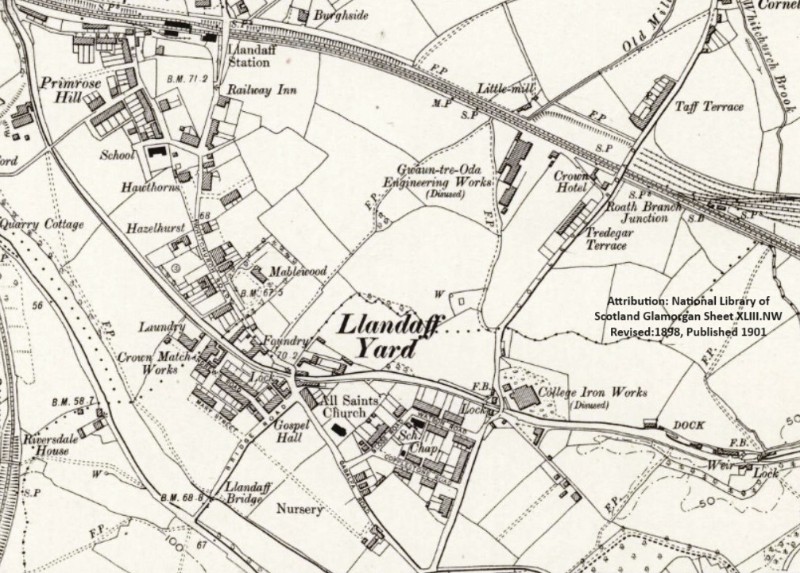 By: Terry Chard on 23/02/2024 LLANDAFF YARD (Ep. 2)Following Nigel’s successful “101 Things You (Probably) Didn’t Know About Whitchurch” forAWEN, Terry has picked up the baton on our local history and heritage theme to tell us moreabout Llandaff Yard.One thing that becomes apparent when researching local history and events is just howresilient and tough local people were and just how challenging life was in the 19 th century.We have to remember that the area was not as affluent and built up as it is now, but it wassomething of a development backwater on the outskirts of a burgeoning large town that hadits own problems to deal with (Cardiff was not a city back then).In 1865 (17 th Feb Cardiff Times) a ‘young man’ who, after work on pay day, had visited “afew of the public houses at Llandaff Yard” had got lost walking home and attempted to getinto the vacant, straw-thatched, ‘Gabalva Lodge’ believing it to be his lodging place.Because he could not get in through the door, or the window, he climbed onto the roof andattempted to lower himself down the chimney. Unfortunately he got stuck half way down,helpless, unable to move, “feet downward, thighs fast, hands up and his coat over his headand well besmeared with soot”. He remained there until 1pm the next day when a man andhis wife came to look at the lodge to see it if would suit them to live there. When they gotinside they heard the groans “O Jesu Mawr” (Oh! great Jesus) which frightened the life out ofthem and they ran off. Fortunately the man returned and on hearing the words again hemanaged to get help from the College Iron Works workmen, the very place where the youngman was employed. They then commenced pulling down the chimney because he was stuckfast and unable to be moved and as he “gradually became visible to the lookers-on theycould not refrain from laughing”. That’s mates for you, I wonder how long it took to live thatdown, or, what would have happened if someone had not been house hunting.There was an area of Llandaff Yard commonly known as ‘The Freehold’ and this seems tohave been at the back of the Cow and Snuffers around the river end of what we all know asCollege Rd. It was low lying land sandwiched between the Glamorganshire Canal and theriver and sanitation and drainage was a huge problem. Industry, housing, livestock and pubsin the vicinity all produced ‘waste’ and run off. By the 1870’s we hear of the local issues.There was no sewer system, no drainage and no piped water. By Aug 1885 a scheme wasput forward for draining Llandaff Yard for “removal of surface water, the great evilcomplained of”, however, “the open privies and cesspools would be left but if properly lookedto, would not be a great evil”. One solution being “deodorising tanks placed in a field nearthe Glamorgan Canal at Llandaff Yard. After being deodorised the sewage would bedischarged into the river”. All this, at the time, for seven houses. This all dragged on and onfor years until cases and fears of typhoid (4 x cases in Llandaff Yard reported in Sept 1893)and cholera accelerated progress and an eventual solution. – (Don’t ever refer to theGlamorganshire Canal as the ‘Glamorgan’ Canal, it’s an unforgiveable sin).Times were tough, there were many incidents leading to convictions, some serious, someless so. Poor old Billy Llewelyn was ordered to pay 6s 6d (32p now) and remanded for afortnight for keeping a ‘pigstye’ close to the highway, “a public nuisance because of thestench”. In December 1879, “on the Freehold at Llandaff Yard between 8 and 9pm, a manwalked up to the shop window of Mr Follet, butcher, and putting his hand through theventilator pane deliberately unhooked a leg of mutton and ran away with it”. A chasefollowed but he was never caught. It was December 1882 when W Murray and James Phillips, a grocer of Llandaff Yard, were each fined 10s and costs (10 shillings = 50p) forhaving unjust weights and measures in their possession, reported by the South Wales DailyNews, no doubt never to be trusted by locals again and on 25 th April 1892 George Hanleywas charged with stealing coal at Llandaff Yard on the 9 th and was fined 20s including costs,or 14 days hard labour (20 shillings - £1 – probably equating to a month’s work). In April1893 “William Williams alias “Billy Butcher”, a well known character who has undergoneseveral terms of penal servitude for various offences was placed in the dock at Llandaffpolice court charged with stealing two pigs from Thomas Lewis a Llandaff Yard haulier” fromthe College Works. Found guilty he was sentenced to 8 months with hard labour (aged 63).To some the old canal was a place of recreation, my father and his generation learned toswim in it. However, you would never believe the number of fatalities by drowning in thearea, many in the Glamorganshire Canal, some by pure accident, some suicidal and somethe heartbreaking loss of children of local people. One of the more common locations fordrownings was right outside the Cow and Snuffers, late at night, at the old bridge and canallock, after leaving the pub. Another was Llandaff Weir, at the weir itself and also at a spotwhere the old mill stream branched off from the river at a sluice gate. Here, as reported inThe Cardiff Times on 14 th May 1898, “the surface of the water is covered by a thickness ofbark, corks, dead timber and other floatage” washed down by the river. To the unwary itappeared solid but below it was a strong current 9 or 10 ft deep. “It is a gruesome spot,choked with carcases of dogs, cats and even larger animals and it has been the scene ofmany tragedies”. Again it took an age for it to be made safe despite The Coroner directingthe responsible authorities “to the dangers of this veritable death trap”. Fortunately therewere also reports of many heroic rescues, not least of all the actions of two youths namedFry and Day who were named in a report by the South Wales Daily News on 14 th Jan 1899for a ‘brave deed’ “rescuing an old man from drowning in the canal near Llandaff Yard” andin the Cardiff Times on 19 th May 1906 when John Harris of Andrews Road Llandaff Yardrescued a small boy by jumping into the river “without divesting himself of his clothes” and byresorting to “artificial respiration to eventually succeed in renewing animation”. Take a bow ifthese people are in your family line. There’s a lot more on Llandaff Yard. Watch this space......(All the reference material here is obtained and accredited to: The National Library ofWales – Newspaper Archive)AWEN is a community group based at Whitchurch Library, it is a registered charity run forour local community by volunteers, all local people. To find out more and, or, to get involvedcontact AWEN by e-mail at awen.cymru@gmail.com or visit AWEN’s website atwww.awenthelibrary.cymru 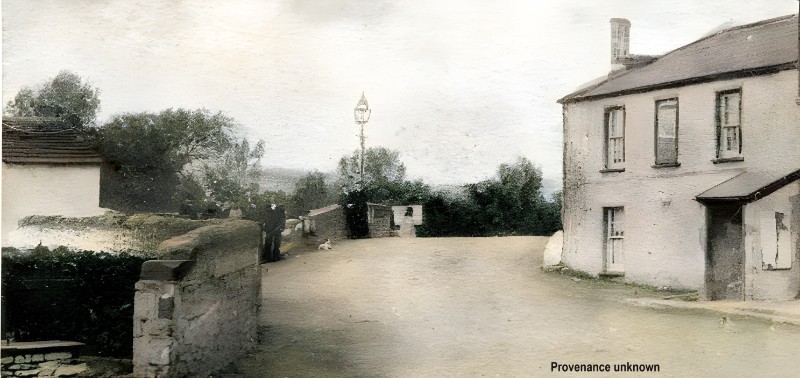 By: Terry Chard on 26/01/2024 LLANDAFF YARD Following Nigel’s successful “101 Things You (Probably) Didn’t Know About Whitchurch” for AWEN, Terry was invited to add more to our local story. The local history and heritage theme suits him, so here goes, hold onto something solid............. Llandaff Yard and Primrose Hill are names to conjure with before it all became Llandaff North. Primrose Hill was the area close to the railway station. My father and grandfather were ‘Yardies’, so I’ve taken more than a passing interest in this neighbourhood. The name Llandaff Yard is a legacy of its industrial past, the ironworks, foundries, boat repair and building that took place around the old Glamorganshire Canal there. It’s an area that forged character, numerous sports teams, gave rise to many incidents well worth reporting on and there were pubs you never knew existed as the Sunday Closing Act wreaked havoc.
On the 19th August 1871, according to The Cardiff Times, “a party of 150 persons, consisting of workmen of the College Iron Works, Llandaff Yard, with their wives and sweethearts, were brought down the Glamorgan canal in a canal boat and on reaching the gutway were taken in tow by a tug-boat and conveyed to Weston, where they purpose spending the day.” The gutway would be the canal lock and basin at Cardiff docks, but how incredibly adventurous and daring is this story, a small canal boat towed across the channel over to Weston, unbelievable.
Credit where it’s due, reported in The Weekly Mail on 20th February 1886, the Llandaff Yard Working Men’s Club gave ‘an entertainment’ in the National School room to aid those who suffered in the Mardy explosion. It was presided over by Lieutenant-Colonel Hill, who lived at Rookwood, with a large attendance reported and one of the chief features was the performance of the Llandaff Yard Club Minstrels. It was a fantastic gesture within a community, but who knew of the Llandaff Yard Working Men’s Club and where was it and what about the characters that made up the Llandaff Yard Club Minstrels?
Who knew of the Llandaff Yard Cricket Club that held a general meeting, according to The Cardiff Times in March 1886, at the Llandaff Yard Working Men’s Club to appoint officers and committees for the ‘cricket and rounders’? Was the rounders the origin of baseball in the area? Among the many industries of the area who would believe there was once Goodall’s Oil Merchants (ref photo above) seen advertised in the South Wales Daily News on 17th May 1889 and of the opening the Match Factory at Llandaff Yard, reported on the 8th February 1894 in The Evening Express? A much needed boost to the local economy, unfortunately not to last, being sold by the liquidator as reported on 14th Feb 1899 in the South Wales Daily News. The Victoria Laundry on Andrews Road would be known locally by many and on 17th Feb1899 in the Western Mail they reported on the laundry inviting 20 guests from Cardiff to view the works. (The great and the good no doubt - I’m sure they would have a great interest in clean white shirts and bed linen). Unfortunately, The Victoria Hygienic Laundry also failed, The Evening Express on 22nd July 1902 reporting on a meeting of the creditors with the Official Receiver remaining as trustee. However this was not the end, when on the 14th August 1902 the Evening Express was quick to announce that Gwyn Nicholls (the famous Welsh international rugby player) and his brother in law Bert Winfield had acquired it with the possible excitement of him moving from Newport to play for Cardiff. Even more of a boost to the area was that the Evening Express, on 18th January 1902, had reported on him having given a speech at a presentation for Llandaff Yard Rugby Club in which he mentioned “the first time I ever handled a football was on the ground of Llandaff Yard Football club and it is always the greatest pleasure that I pay a visit to this place.” (Rugby back in the day was commonly known as ‘football’). What of the name though? The Evening Express on the 25th Sept 1902 reported a ‘Lively Meeting’ – “The district of Whitchurch, below Llandaff Station has within recent years grown so rapidly that a short time since a movement was set on foot to give the place some other name than that by which it is at present known, viz.. Primrose Hill. ....The promoters of the meeting having stated their case, a heated discussion ensued. Several expressed their objection to the movement, and stated that they were quite satisfied with the name the district bore at present. They had lived in the neighbourhood for a considerable time - in fact, long before it had reached Its present proportions and they had not experienced any inconvenience. As time went on the proceedings became exceedingly lively, and the meeting ended without anything being done.”
Despite the resistance, change eventually came and on the 20th June 1906 The Evening Express published a small article that read as follows:....The Postmaster General has assented to the request of the inhabitants of Llandaff Yard that the postal address “Llandaff North” should be substituted for Llandaff Yard. This new regulation will come into force on the 1st prox.”
There’s a lot more on Llandaff Yard. Watch this space...... (All the reference material here is obtained and accredited to: The National Library of Wales – Newspaper Archive) AWEN is a community group based at Whitchurch Library, it is a registered charity run for our local community by volunteers, all local people. To find out more and, or, to get involved contact AWEN by e-mail at awen.cymru@gmail.com or visit AWEN’s website at www.awenthelibrary.cymru 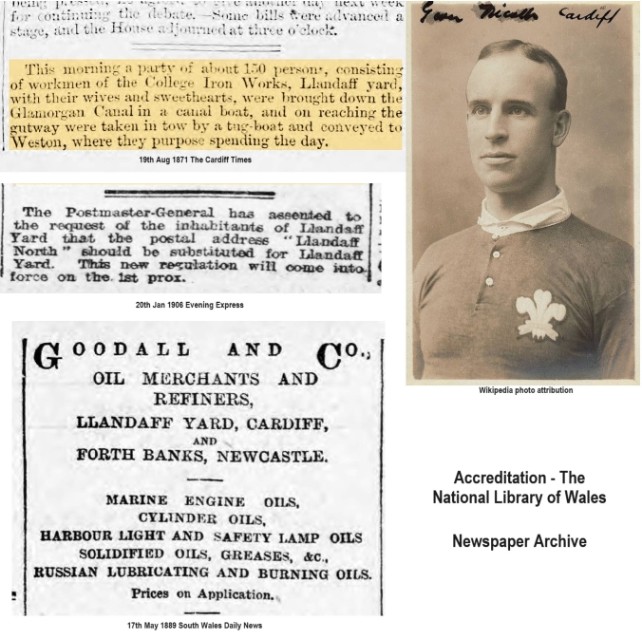 By: Terry Chard on 18/12/2023 Whitchurch (Cardiff) Heritage No. 4 Treoda - Medieval In our previous posts on Treoda, we looked at the origin of our ancient, sacred centre through Bronze Age, Iron Age and Roman occupation. Bronze Age ......... Iron Age ......... Roman ......... Medieval The period after Roman occupation until the ‘Norman conquest’ is complex, particularly in Wales, made more so because of the lack of reliable records, history being written by the victors, that some of what was written 100’s of years later as legend now passes off as fact and also because of original Welsh names being Anglicised to something different, as you will see. To a researcher it can also become confusing because of the complexity of names and the surprising number of similar names throughout the centuries. It was a long period of conflict and upheaval as ‘kingdoms’ were established and defined and for our Treoda all this has to be put into context: Prior to the Norman ‘conquest’, Wales was a divided ‘kingdom’ overwhelmed by long periods of rivalry and land grabs, region to region. Our Whitchurch was no different, being within the ‘kingdom’ of south Wales and part of the old Welsh Cantref of Senghenydd, bounded by the River Rhymney in the east to the River Taff in the west and from just south of Brecon (Brycheiniog) in the north to the coastal wetlands of Caer ‘Taff’ (now known as Cardiff) in the south. (‘Cantref’ – an old, established, Welsh system of regional administration and governance) Through strategic cunning, Robert Fitzhammon formed a power base at Cardiff (1089) after ousting Iestyn ap Gwrgant in a battle at the Great Heath (Mynydd Bychan) and this is believed to have taken place in Rhiwbina, behind Beulah Chapel. Fitzhamon was aided by an allied force of Welsh barons and fellow Normans who were duly rewarded for their involvement with areas of land throughout Glamorgan. Senghenydd cantref (Whitchurch being part of it), was awarded to Cedrych (Cedrych ap Gwaithfoed - a Welsh Lord/baron) with the new power base at Cardiff redefining the south boundary of Senghenydd further northwards towards Mynachdy at some local landmark, possibly a stream, or contour change. Over time, however, the diminishing boundary of Senghenydd became the cause of considerable conflict. Cedrych became the father of Cadifor (Cydifor) and Cadifor became the father of Ifor. This Ifor was Ifor Meurig, better known as Ifor Bach (‘Arglwydd Senghenydd’ – Lord of Senghennydd). By this time the established, lawful territory of Senghenydd had further diminished. Ifor Bach is noted for his attack (1158) on Cardiff castle (the seat of the Lordship of Glamorgan), when he “removed” William, earl of Gloucester, his wife and their son to his woods, refusing to release them until William had restored the lands taken from him and had bestowed upon him additional territory by way of redress. From north to south, throughout the land, a long period of conflict followed as territories were slowly redefined. Ifor had a son Gruffydd (Griffith) - (Gruffydd ap Ifor). Various landmarks acquired the name of Gruffydd throughout his time, Griffithsmoor being one and a mill in Whitchurch now known as Gruffydd Mill (our Melingriffith), being another. Gruffydd became the father of Llewelyn (Llewelyn ap Gruffydd), known as Llewelyn Bren (Llewelyn of the wood). As more and more of ‘Glamorgan’ was claimed by dynastic Anglo Norman warlords it resulted in a revolt by Llewelyn Bren, either at the end of 1315 or in January 1316, who set about destroying some of the ‘land assets’ in the region. One of these was the mill, Melingruffydd (burnt down – ‘this mill he was deprived of and petitioned to have it restored’), but mills in general seem to have been special objects of attack, probably on account of the custom of ‘suit of mill’ and the exactions and abuses to which it gave rise, however, a structure at Treoda was left untouched and this is thought to be because this area remained in Llewelyn’s possession. On 13th Feb 1316 a writ was issued to receive the ‘Welsh rebels’ into the ‘King’s peace’. This it seems was enough for Llewelyn Bren and upon promise of safety, or at least life, he surrendered. It looks possible that he was released in November 1316 under a writ for liberating Welsh prisoners and restoring their lands. But, he was later imprisoned by Hugh le Despenser who had obtained possession of Glamorgan in right of his wife Eleanor de Clare, this writ being dated 15th Nov 1317 and it was shortly after this that Despenser (Hugh Despenser the Younger) had Llewelyn Bren hung drawn and quartered at Cardiff (near the Black Tower), 1318 being the probable date of execution. Llewelyn Bren was buried at Greyfriars. By 1321 Despenser had been ‘rendered obnoxious’ and the ‘state of the realm amended’ leading to the Despensers being banished for a short duration in which it is believed that Hugh Despenser resorted to piracy. Having lost favour among the royal elite he was eventually captured and executed at Hereford, suffering a similar fate to our Llewelyn Bren - Hung drawn and quartered - the death of a traitor. Strange to think that our capital city has a Fitzhamon Embankment and Despenser Gardens, but no Gruffydd Gardens and no Ifor Bach, or Llewelyn Bren Boulevard. Greyfriars was spared when Owain Glyndwr laid siege to Cardiff and it is believed that he made safe his return through the gorge at Taffs Well, nicely suggesting that it must have been through Whitchurch and Tongwynlais that he made safe passage. 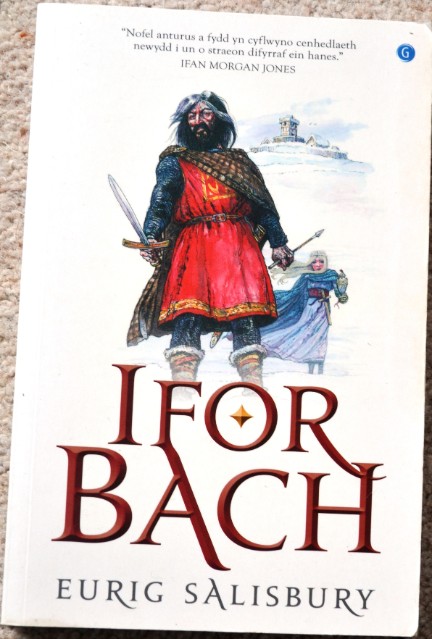 By: Terry Chard on 18/11/2023 Whitchurch (Cardiff) Heritage No. 3 Roman Treoda (Whitchurch) As part of the Whitchurch Heritage series the previous posts looked at the possible origin of our ancient, sacred centre in the Bronze Age (Ref: No. 1 Bronze Age Treoda) and the Iron Age (Ref. No. 2 Iron Age Treoda). Due to the extent of history attached to the Treoda site it has to be done in episodes, today we’ll look at Roman occupation in our village. Bronze Age ............. Iron Age ............. Roman The Iron Age communities (‘tribes’) of South Wales were the Silures and it is these people that the Romans would have faced as they expanded their empire coming eastwards from Caerwent and Caerleon. It’s certain however that they offered strong resistance. **‘The Silures, who inhabited Glamorgan and adjacent areas at the time of the Roman invasion, were subject to intermittent attack for more than twenty years before their final subjection in A.D. 74. Despite their prolonged resistance the Silures do not seem to have been severely penalised by the Romans.’ ** In script No. 1 (Bronze Age) reference was made to the survey work of G. T. Clarke in 1850 and of the 1965 excavation by Jeremy Knight B.A. and Eric J. Talbot B.A., prior to demolition of the ancient mound at Treoda. The 1965 survey reported that as they removed layers of clay and other deposits that formed the mound they came across “a small amount of abraded Roman material, including several weathered lumps of amphora and tile, the debris of roman settlement somewhere in the close vicinity”. Just a reminder here that this survey was only a partial excavation prior to the eventual demolition of the site and that any wider archaeology could not be carried out and so the finds only represent a small portion of it, any remaining archaeology was lost. The report went on to describe the finds as follows: i. Two flanged fragments of roof tile. (Several featureless pieces in similar fabric were also found). ii. Fragment of a rectangular brick 7cms thick in similar fabric iii. Abraded sherds from an amphora
The attraction here was the fertile land, fresh water, timber for construction and fuel, limestone and iron ore (at Y Garth) and it was a strategic post in the landscape both for a westward and northern movement. - “A road, called "Roman." leading from Tibia Amins to Rhieubina, runs at no very great distance”. If you didn’t know already, North Road, out of Cardiff centre and Caerphilly Road, was a Roman road. (Judging by the state of them all, maybe we should invite them back!).
It was G. T. Clarke’s survey of 1850 however that really shed light on Roman occupation on the Whitchurch site. This survey covered a wider area outside and beyond the mound at Treoda. The notes of Clarke mention more sherds of Roman pottery being found, notably, within the old churchyard (old St Mary’s, Old Church Road), but it is this survey of the area that really reinforces the Roman story here having discovered the outline of a ‘card shaped’ Roman enclosure. Remember, at the time of this survey there was no A470 (Manor Way) and the area around Treoda was mostly open farmed pasture land and formerly part of the Great Heath.
The sketches attached show the location and size of this enclosure. It’s quite remarkable to know of it. This enclosure was aligned in a north/south direction and was 195 mtrs long and 160 mtrs wide. The short stretch of Old Church Road near St Teilo’s Church and the Fox and Hounds pub lies on a north – south line. The centre of the Roman enclosure was, more or less, at the road entrance to the Fox and Hounds car park. It’s possible that the curving nature of the road at this point is entirely due to the ancient layout of this enclosure, controlling tracks inwards and outwards. (Heol y Forlan being a more modern addition). The northern edge of the Roman enclosure was just beyond The Pines (dental practice), but now rubbed out by housing developments over the years and its southern edge lies on a line coincident with a lane at the rear of the houses on Glan y Nant Terrace. The eastern edge was just over the brook (all now rubbed out) and the western edge lies at the boundary of the tennis club as shown, but the interesting thing to note here is that some of it is still there. The boundary of the tennis club has a short obscure ridge and this was the western embankment of the Roman enclosure. It can also be viewed from The Pines off Ty’n y Pwll Rd. (Unfortunately this Roman remnant might not be there for much longer).
The old maps (1875) show a “Roman Station - Supposed Remains of” just to the west of this outline but it would come as no surprise if this area also proved to be part of Roman occupation at the time. The edge forming the rear gardens of the houses on Ty’n y Pwll Road and the kerb edge of the road into the tennis club car park define this boundary.
AWEN is a community group based at Whitchurch Library, it is a registered charity run for our community by volunteers, all local people. To find out more and / or, to get involved contact AWEN by e-mail at awen.cymru@gmail.com or visit AWEN’s website at www.awenthelibrary.cymru
** Ref: RCAHMW: An inventory of the Ancient Monuments in Glamorgan Vol 1: Pre-Norman Part II: The Iron Age and the Roman Occupation
 By: Terry Chard on 17/10/2023 Whitchurch (Cardiff) Heritage No. 2 Treoda - Iron Age The previous post on Treoda looked at the possible origin of our ancient, sacred centre in the Bronze Age. Due to the extent of history attached to the Treoda site it has to be done in episodes and today we’ll look at the Iron Age. Bronze Age ............. Iron Age ............. The Treoda mound started as a Bronze Age bowl barrow and it was located on open flat land next to a water course (Whitchurch brook / Nant Waedlyd). As a sacred centre it could possibly have been chosen for bringing people together for festivals, feasting and for ceremonies such as the summer and winter solstice, the changing weather patterns and for eclipses and phases of the moon. It’s also likely for these to extend into such social ceremonies associated with trade, harvest and perhaps marriage, births and funeral rites, for congregating in celebration and also, to resolve disputes and injustice, whether that was Bronze or Iron Age. The Iron Age tribes of South Wales were the Silures, the name itself believed to have a meaning associated with being the ‘seed’, or descendants (a celebration of ancestral lineage). Although there was no mention of Iron Age activity at Treoda in the 1965 survey (ref. the previous post on Treoda - Bronze Age) the site attracted interest and occupation for millennia and evidence of Iron Age burials is scant, the “burial of the dead was not usual for most Iron Age communities in Britain or Ireland; in most areas graves are either extremely rare or completely absent”. There are however some interesting and intriguing coincidences regarding the Treoda location. We know that there were Iron Age hill fort settlements at Y Wenallt (where ‘hut platforms probably existed’) and at Caerau (Ely) and a large settlement at Dinas Powys. All 3 being located on high ground overlooking the fertile lower, flat, river plain below. Between Caerau and Y Wenallt there were two ancient crossing points on the River Taff: One near what is now Western Avenue bridge, from which Gabalfa gets its name (Ceubalfa – place of the boat / ‘ferry’ crossing, or ford) and the other, a ford, at what is now Llandaff Weir. The people in these settlements quite possibly could have interacted with each other as a commune in all the ways that people do today. From across the Taff valley, the people of Caerau and Y Wenallt would have seen each other’s camp fires at night. If a line is drawn on a map from the crossing point at Radyr Weir to the Wenallt site, as if walking in a straight line, it passes close to Treoda. A similar line drawn from a crossing point at Gabalfa is even closer and coincidentally, the halfway point for this line lies exactly at the Treoda mound. (“We’ll meet you halfway”). Tthe tracks these ancient people used, person to person, tribe to tribe, to access the river for transport and fishing, the routes they took to get metal ores and limestone, still remain as some of the main roads and pathways that we use today. It is remarkable to think that. It makes you wonder just what archaeology remains hidden in the gardens of local houses and even perhaps under Parc Cae Delyn, most other surrounding areas having been heavily rubbed out by ‘development’. Perhaps we could give ‘Time Team’ a call.
There’s a lot more on Treoda to follow that takes us into Roman and Medieval times, watch this space...... AWEN is a community group based at Whitchurch Library, it is a registered charity run for our community by volunteers, all local people. To find out more and, or, to get involved contact AWEN by e-mail at awen.cymru@gmail.com or visit AWEN’s website at www.awenthelibrary.cymru
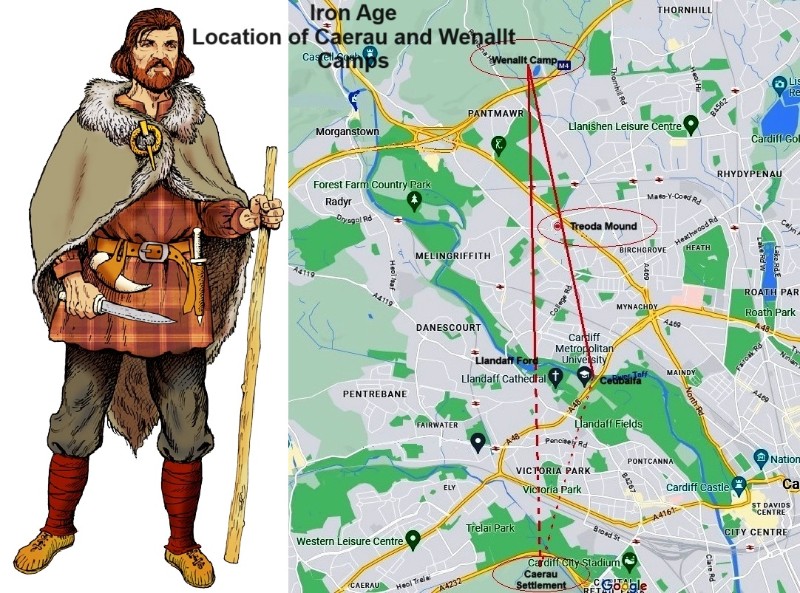 By: Terry Chard on 08/09/2023 Following Nigel’s successful “101 Things You (Probably) Didn’t Know About Whitchurch” we invited Terry Chard to add more to our story. The local history theme suited him, so here goes, hold onto something solid............. Whitchurch (Cardiff) Heritage No. 1 Treoda - Bronze Age Mound There’s only one place to kick things off with and it’s more or less where Nigel ended his ‘101 Things’, it’s the oldest site in our village and it dates back to the Bronze Age approx. 4000 years ago. It is the ancient, sacred centre of our community. Some of Treoda’s history has been well recorded, however, some of what you are about to read has not been and will be ‘fresh to the market’. By now you will already know of the ‘Castle Mound’ at Treoda (also known as a ‘twmpath’), those of us born before the 60’s will know of it, having seen it. The site was cleared for ‘development’ in 1966 when Treoda Court was built and now nothing remains of it. A Neolithic arrow head was found in the area and was once on display in the National Museum of Wales.
In 1965 an archaeological survey was carried out by Jeremy Knight B.A. and Eric J. Talbot B.A., the report is extensive and it would be difficult to summarise it for this short script. The excavation was carried out by cutting a section through the mound, but at demolition later, the rest was removed and any remaining, potential and valuable archaeology was lost. In the interests of our Bronze Age story this is what was concluded: There was no evidence of any burials, but there could be many reasons for this. In archaeology terms ‘absence of evidence is not evidence of absence’.
Before all this however, in 1850, the entire area was surveyed by a well known archaeologist of the time, G. T. Clarke. At the time he was an engineer based at the Dowlais ironworks and later, Edgar Chappell, in his book ‘Old Whitchurch’, described him as ‘the eminent military antiquarian and genealogist who was for a long period the managing director of the works’. At this time the land and the Treoda Manor house was owned by a Mr Rowlands (hold that name in the memory). The notes of Clarke’s survey were never formally published, but they have been used for later reference works on this site.
There is more predating G T Clarke though and oddly enough this has never ‘seen the light of day’ since and doesn’t appear in any research papers: In Sept 1849 there was the annual congress of The Cambrian Archaeology Association under the Presidency of Viscount Adare M.P. which went on for a full week discussing various ‘Glamorgan Antiquities’. On the fifth day of these proceedings the subject of ‘The Twmpath Near Whitchurch’ came up. The following was reported on the 8th Sept 1849 in The Cardiff and Merthyr Guardian: “THE TWMPATH NEAR WHITCHURCH..... In an early period of the association's meeting at Cardiff a subscription of £10 was entered into for the purpose of having this ancient tumulus opened and explored. The work of supervision was kindly undertaken by Mr. Fox, C.E., who this evening gave an account of the labours that had been engaged in. Mr. Fox said that the workmen had succeeded in opening the Twmpath to its centre. The only things they had found were a quantity of black offensive foetid matter and a little bit of iron. With regard to its origin he gave the following speculation for the consideration of the meeting:” (He went on to offer his opinion on the origins of the word ‘Twmpath’ which didn’t go down well amongst Welsh speakers) “—- The black matter that had been found in the interior of the tumulus was excessively offensive,—so much so as to render it difficult for the men to work there. Large stones, some of which weighed two cwt., appeared to have been thrown into this peaty matter. At some distance below the surface there was found moss or broom, quite as green as that found on the surface; but on being exposed to the air soon became discoloured. Mr. Whitlock Nicholl said he had seen the dark matter spoken of by Mr. Fox; and had found all through it the roots of fern. It appeared to him that that dark mass was at one time the upper surface but had been displaced.”
This was a very active and well organised ‘Association’ with a strong committee and other local sub-committees comprising of a large number of eminent members aided and abetted by a lengthy list of ‘influential’ people (The ‘Reverends’ and ‘Sirs’ of that world). Part of their activities was that of arranging excursions for members and visitors with one such excursion being arranged on Wednesday 29th Aug 1849 “To the Twmpath-y-rhas near Whitchurch”. The following report (extract) was published later, in The Cardiff and Merthyr Guardian on 26th Jan 1855..... About 150 yards E.N.E. of the church and in the garden south of Mr. Rowland's house is a circular mound, about 34 yards across at the base, 28 at the summit, and about 5 feet high. It was higher, but Mr. Rowland took off the upper six feet, and with it filled up a circumbscribing ditch or moat. While excavating, Mr. Rowland met with numerous stones, some of dressed ashlar, and employed them in building his own and other houses. On the east side of the mound, he found some strong, well-built walling, including what he thought to be a trace of a portcullis groove. He found also two coins of one of the Edwards the writer thinks, the “First." The recent alterations have destroyed all trace of the moat; but close E. of the mound runs a brook, which no doubt formerly fed it with water, and is itself a considerable defence on one side. ........ This is what G.T Clarke noted and it becomes clear that Clarke did not do any archaeology on this site other than to report on what Mr Rowlands had told him.
There’s a lot more on Treoda that takes us into Roman and Medieval times, but space here doesn’t permit. Perhaps it can be done in episodes. Watch this space...... (The reference material here is all obtained and accredited to: The National Library of Wales – Newspaper Archive) AWEN is a community group based at Whitchurch Library, it is a registered charity run for our community by volunteers, all local people. To find out more and, or, to get involved contact AWEN by e-mail at awen.cymru@gmail.com or visit AWEN’s website at www.awenthelibrary.cymru
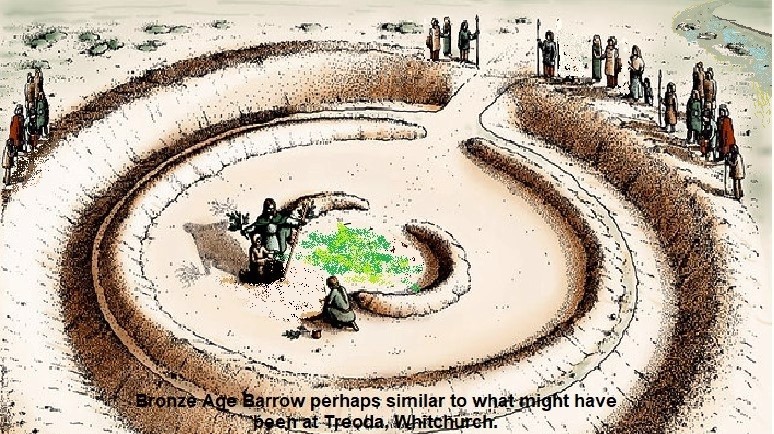 By: Nigel Lewis on 23/06/2023 101 THINGS YOU (PROBABLY) DIDN’T KNOW ABOUT WHITCHURCH 101 ALL DONE! Well, would you believe it?
101 things you (probably) didn’t know about Whitchurch, and perhaps now you do!
When we started this project back in those dreadful Covid days of April 2021, who would have believed that we would still be going all these (many) months later
The very first blog was all about the yew tree in St Mary’s Garden, which turned out to be the oldest tree in the village!
Since then, we’ve looked at some of the old characters in the village, the farms, churches and chapels, shops and pubs, prominent buildings, the festivals and the old industries which shaped and moulded the village we call home
And the old photographs! What an insight into village life
It all started when I was looking at the oldest of the OS maps which showed the (old) ‘St Mary’s Church and Vicarage’. I knew where the old church was, but where was the vicarage? Try as I might, no-one seemed to know
Russell, who lives next door to the Fox & Hounds told us, not so long ago, of an old family story suggesting that there was a tunnel under his house, crossing the road to the old church. Did that mean that his house was the old vicarage? Surely not; the house looks relatively modern
Then on an old photograph of the churchyard (see below), in the distance was the pub, and next door, an old house with what looked like a thatched roof. Could this have been the old vicarage? We know that St Mary’s was really old, but could a thatched cottage nearby have been the vicarage? I think I’ll leave this to another to explore!
So many things have developed from this project. Our monthly reminiscence group at the library has flourished and we’ve had so much feedback. The Walking Whitchurch History project, with the grant from CADW/Heritage Lottery Fund and our (soon to be fixed) legacy waymarker boards, has been wonderful, and so well supported. The links to local schools has stimulated such interest, and through Ceri, a special reminder of our war heroes and the memorial at the library
With AWEN, we’re looking at how to record and cherish all the things that we’ve discovered, have been given or shared stories. This is such an important part of the work, for the ongoing benefit of our community. We’ve been given some really good advice from national specialists, now we have to implement it all!
Where do I begin to thank people for their support, interest and encouragement to continue with this project? To Chris, my wife who is my amazing consultant, longstanding proof reader and frustrated organiser (of my complete haystack of a filing system!), to Terry and Chris S who are my go-to people for so much of the information used each week, to all of the reminiscence folk for their snippets, stories and unswerving commitment. And to all of the AWEN community for keeping me going when times were tough
To Anthony and Chris G for all of their artistic advice and involvement
Of course, I don’t think I could have started any of this without Edgar Chappell and Hilary Thomas for all the local knowledge in their books, and of course to Ernie Broad, the true ‘Sage of Whitchurch’ with his unbelievable stories of the village a hundred years ago
I’m so grateful to Steve Nicholas for the use of his many old photographs
Who would have believed that so much history could be crammed into such a small village. And the truth is that there is so much more! Tales of the canal, the railways, about Tongwynlais and Llandaff Yard, the famous (and infamous) people, the parish council and all of the politicians, and all the histories of Birchgrove and Rhiwbina too
So sadly, now is the time to end this weekly blog, but I’d like to think that we can continue on a more leisurely way with a new subject every few months or so
And I hope we’ll have more walks around the village, and talks in the library
I’ll be on Whitchurch Common with the AWEN stall on Festival Day if you want to pop along and say hi. Weather permitting, I’m hoping to share the story of ‘Robin Goch’ with the children and maybe make some paper aeroplanes
Anyway, thank you all for your continuing interest in our village, and indulging me on this ‘wild’ adventure. Remember, each one of us is a tiny piece of the ongoing jigsaw that is Whitchurch. Enjoy
God bless Nigel 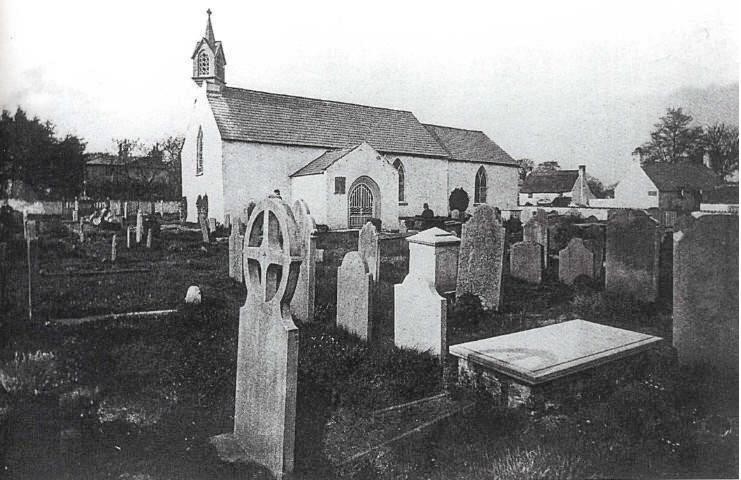 By: Nigel Lewis on 16/06/2023 101 THINGS YOU (PROBABLY) DIDN’T KNOW ABOUT WHITCHURCH 100 WHITCHURCH CASTLE
Wow! The penultimate blog. There are so many things still to look at, but I’ve run out of numbers!
I thought that Whitchurch Castle would be an appropriate last look; probably the oldest bit of the village
I can’t believe that the motte and bailey castle in our village has been literally razed to the ground while lesser mottes at Rhiwbina and Morganstown have rightly been given statutory protection
There’s nothing left of the castle now, buried under 1960s three-storey flats
So, what might it have looked like? There are aerial photographs which show the extent of the motte (the mound), and the old OS maps give a good indication of what was there in the 1920s
Earlier archaeological explorations suggest that the castle was a motte and bailey, that is a mound with a small enclosure over. There are suggestions however, that the motte was built over an ancient bronze-age burial barrow, and there have been some finds to support this
This old barrow was increased in height to form a defensive mound sometime around the time of the Conquest, with tales of skirmishes between the local Welsh Princes and the Norman invaders. The Nant Waedlyd stream was diverted to form a partial moat, and the stream still follows that line even today
Who built it? Either the local Welsh chieftains to defend their patch, or more likely, the Norman invaders to secure their tenuous hold on the area
How high would the motte have been? Possibly 5-6m high (taller than a double-decker bus), and the earth bank would have had a slope of 1 in 1.5, so plenty of space at the top for a bailey (or castle)
The archaeologist GT Clarke in the 19th century excavated the motte and found the remnants of an old stone keep on the top. He talks about a stone ’forcelettum’ dating from the 12th century
There is no way of establishing what the castle might have been, but the sketch below gives a flavour of a defensive motte and bailey with a stone keep and a substantial wooden perimeter. There would have been some form of wood and stone ramped access up to the castle. Not big enough to live in, the local chieftain and his family would probably have lived nearby
Over the following centuries, the mound would have been reduced in height, by both soil erosion and to provide easier access. It was lowered even further in 1848 to about 3.6m (12 feet) and landscaped as part of the garden
What were the finds from the various excavations? There were no burial remains found when the barrow was first excavated, but there were some bronze-age pottery crumbs found in the ditch. However, there was some minor abraded Roman material found between the barrow and later mound layers. Interestingly, an iron caltrop (a metal device to prevent animals galloping over open ground) and 14th century pottery shards were found in a second sifting of the motte ditch
Sometime in the last 200 years, a house was built in front of the castle, and in recent time this was called Treoda House. In the first census of 1841, it was called ‘Castale Motte’. This house too has been lost, demolished as part of the 1960s development
There was a final archaeological dig in 1966 by JK Knight, EJ Talbot and I Rowlands for the Ministry of Public Buildings and Works (the predecessor of CADW), as part of the site preparation for the flats, using a mechanical digger, but nothing further was found
We’ve been told that Sir Mortimer Wheeler (the television archaeologist of the 1950s) was part of an excavation of the castle, but there is no confirmed knowledge of this. Does anyone know?
So, here we are in 2023, knowing very little about (probably) the oldest building ever to have been built in the village. The lack of record is bad enough, but there is not even a sign to tell people!
Surely Whitchurch deserves better than this. What do people think?
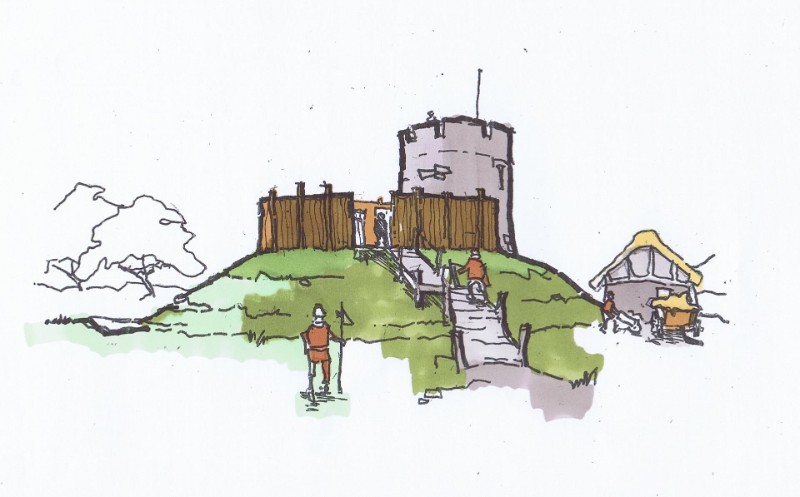 By: Nigel Lewis on 07/06/2023 101 THINGS YOU (PROBABLY) DIDN’T KNOW ABOUT WHITCHURCH 99 Elm Trees in Whitchurch
There must have been lots of elm trees in the village in the past. They would have been a common sight 200 years ago, growing in the hedgerows, standing alone in fields or even in groups. They were still around quite recently, some of our older residents may well remember them
The old photograph below might give you a flavour
There have been many references to elm trees in Whitchurch (and probably widespread across the parish) over the years:
We don’t see elm trees now; they were all killed off by Dutch Elm Disease in the 1970s
They were so common in earlier years, self-seeding and suckering, growing to a height of 30m (100 feet) and living for 3-400 years. Many of our local elms mentioned in the late 19th century newspapers could well have been growing in the reign of Queen Elizabeth 1, and maybe even earlier!
Elm wood was very versatile for our carpenter ancestors, constructing chairs and stools, table tops and of course coffins. With so many elm trees about, there was always a local source available
A newspaper report of September 1903 notes that ‘an old elm tree – a landmark in Whitchurch Common for nearly 200 years – has come to grief during a gale’. Growing in the early 1700s, would this have been one of the group of prominent elms adjacent to Ararat Church which lent its name to the pub opposite? The Three Elms pub was first mentioned in 1810, so the trees must have been an important landmark back then
There are various reports to the parish council dating from 1926 until 1961 noting that numerous old elm trees growing in the hedgerows around the Library Park (then the Recreation Ground) needed surgery or removal. These reports are fascinating. It seems that over the years a total of 4 elm trees were removed and another 14 were lopped/pollarded. There are none there now, so nearly 20 mature elm trees were in the hedgerows just around the park.
In 1949, and ancient elm tree in old St Mary’s graveyard was reported as ‘in danger of falling’, so needed to be removed. It too has gone
There must have been many more instances of these wonderful trees in the village, but we’ll probably never know now
There was once a magnificent avenue of elm trees in Cathays Park, alongside the City Hall. They were planted in 1897 by the Marquis of Bute. I used to park my car under these incredible trees when I worked in town. I can clearly remember them all being cut down because of the Dutch Elm Disease, it was heart-breaking! Even though they were ‘youngsters’ at 70-odd years old, they formed an incredible canopy along that grand boulevard. I’m told that in Cardiff alone, over a thousand elm trees were lost because of the disease
Apparently, Cardiff celebrated ‘Cardiff European City of Elms’ in 2005, and planted 100 disease-resistant elm trees in Pontcanna Fields. I don’t think any were planted in Whitchurch
Perhaps with Coed Caerdydd, and the renewal of interest in tree planting in the city, Whitchurch ought to plan for replanting some of these new disease-resistant elm trees around the village
Who knows, perhaps in 200 years’ time, people will say how forward-looking our ancestors were in restoring such splendid forest trees in our village. It’s a wonderful thought
What do you think?
Postscript Did you know that in December 1937, a commemorative oak tree was planted in the Library Gardens to celebrate the coronation of King George VI. This is the very large oak tree immediately behind the library today 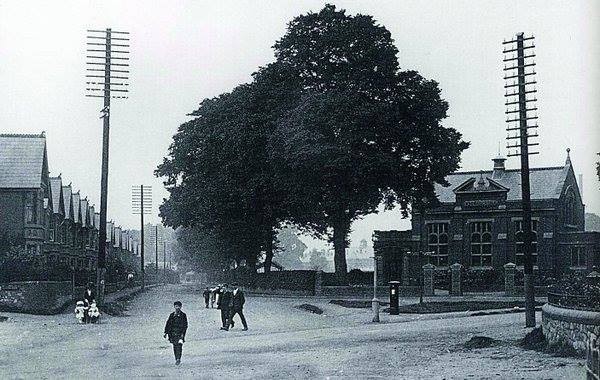 By: Nigel Lewis on 04/06/2023 101 THINGS YOU (PROBABLY) DIDN’T KNOW ABOUT WHITCHURCH
98 GABALVA HOUSE
Back in March we looked at some of the forgotten houses in the area. One of those mentioned was Gabalva House.
Gabalva was situated just south of the parish boundary between the Glamorganshire Canal and the River Taff, and was just inside the Llandaff parish. The house was set near the bank of the river within landscaped grounds populated with many trees. The old OS map of 1875 below shows Gabalva and its extensive grounds. It probably
included all of the land between the canal and the river.
Llandaff Cathedral was on the opposite bank, so there must have been splendidviews.
It was near an old ford linking Llandaff to the Whitchurch parish. Terry believes this was the old funeral way to Llandaff Cathedral. In ancient times it’s possible that this was also a Roman road to the north.
The house was ancient, dating from the 1580s, possibly built for a branch of the Herbert family (who also owned The Friars in Cardiff). We don’t know what this house looked like.
It was so close to the river; it has been suggested that it was periodically subject to flooding.
The original house was demolished and rebuilt during the early 1800s in a 16th century style. This was a mansion, three-storeys high, with dormers and steeply pitched roofs The coloured sketch gives a flavour of what it might have looked like at the time. It is very similar in appearance to St Fagans Castle.
In 1809, Gabalva was leased to Sir Robert Lynch-Blosse Bt. Is this where the roadname comes from?
The grounds extended to over a hundred acres and had two entrances. One off Llandaff Yard, through an entrance lodge. A second entrance was off Llys-Talybont to the east, and had a long carriageway along the river Terry suggests that there had long been a connection with Llys-Talybont house, hence the carriageway.
Ifor Bach lived at Llys-Talybont, the ancient home for the local Welsh chieftains, hundreds of years earlier.
In the 19 th century, Gabalva had a 2-acre walled kitchen garden with heated greenhouses including a ‘peachery’ (Velindre grew pineapples in their hot houses).
As well as extensive stabling, it had dog kennels too, so it probably had connections with the local hunt.
An advertisement offering Gabalva for sale, dated 1839, stated that the house had 16 bedrooms, a spacious drawing room, dining room, library and billiard room. The entrance courtyard could accommodate 5 carriages! Clearly, the largest house in the
area by far. I wonder if it was sold?
In his book, Matthew Williams has some fascinating illustrations of the house and grounds, and is well worth a read.
However, by the late 19 th century, Gabalva was in decline. A history of absentee owners with tenants had only accelerated its decline.
Acquired by the Marquis of Bute in 1890s (only to extend his castle lands) he showed little interest in the house. By 1900, the entrance lodge had disappeared, and by 1940, it had become Gabalva Farm, tenanted by a Mrs Beynon.
Sadly, Gabalva was demolished in the 1950s for the Gabalfa housing estate. What a lost opportunity, imagine what the area would look like today if the canal still ran through it, with the lock-keeper’s cottages and the old mansion!
Gabalfa Primary School now sits on the site of the old house, with the Lydstep flats next door.
It’s interesting to note that in the1580s, and the first mention of Gabalva, Elizabeth I was on the throne, Sir Walter Raleig had just circumnavigated the globe, and just a few years later there was the Spanish Armada! don't forget our Reminiscence Group meets on Tuesday 6th June at 2pm in the HUB.
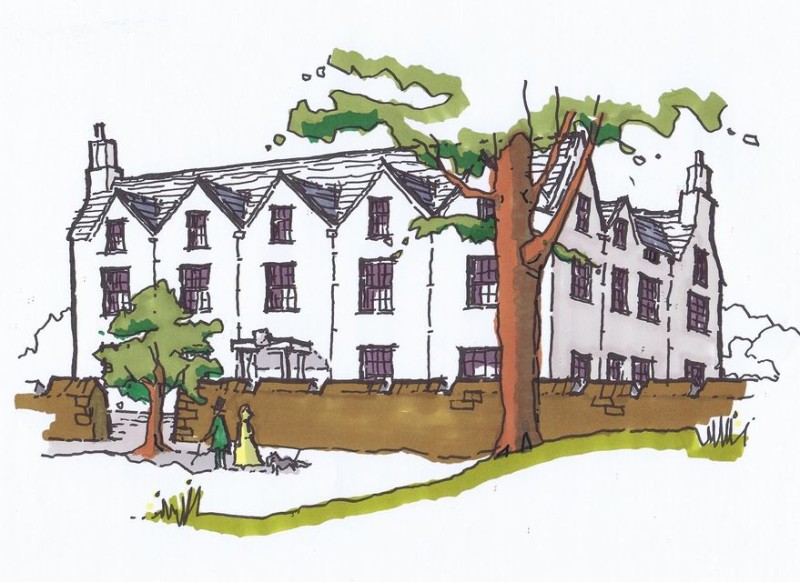 By: Nigel Lewis on 26/05/2023 101 THINGS YOU (PROBABLY) DIDN’T KNOW ABOUT WHITCHURCH
YET ANOTHER LITTLE THING
Gosh! We’re running out of time and there’s so much more to discover!
At AWEN, we’re busy planning our summer events, and in particular our Heritage Pub Walk as part of the Whitchurch Festival on 27th June.
We’re looking to walk four of the village pubs, and to learn a little of each one in turn. We hope to start at The Fox and Hounds, then onto The Plough, next the Royal Oak and finishing at The Maltsters Arms
Numbers for the walk are limited to 20 only, so we recommend early booking if you’d like to attend. Bookings can be made at awen.cymru@gmail.com. In all probability, we’ll repeat the walk again in the autumn
We know lots about the Fox and Hounds and The Plough, and we’re learning about the Royal Oak. The Maltsters Arms however, has proved to be more elusive, and some digging has been required. The results however, have proved to be wonderful
We’re so used to passing by this pub (maybe even going in for a quiet drink), but how old is the Maltsters? There are surprisingly few photographs of the pub, but it has been tweaked quite a bit over the years. The earliest photograph I’ve found shows a recently-opened Brains pub, probably late 19th century. More recent photographs show an imposing frontage with a front extension, and then more alterations and an entrance porch
But what about earlier?
The Tithe Map of 1841 shows the area, but with hardly any buildings around. The old thatched-roof terrace cottages are there, together with a long building fronting the road. Otherwise, there are only fields and the stream. Hannah Johnson was listed as tenant at ‘The Malthouse’. So, was this an early beerhouse? And where was it?
The early census returns are interesting. It lists Hannah Johnson (age 74) living in ‘the Maltsters Arms’ in 1851 and was a widow/publican. A change in the pubs name!
By 1853, a Hannah Evans was the publican, she was the niece of Hannah Johnson, and obviously inherited the pub
The Cardiff/Merthyr Guardian of July that year tells of a ‘housewarming event’ with Hannah Evans taking over the pub from her deceased aunt. A flower bedecked marquee had been erected on the garden where 120+ guests had dinner and celebrated the occasion. Hannah Evans was still there with her husband in 1861 hosting a celebration of the Booker family
The Cardiff Times newspaper of July 1864 lists an auction of ‘The Malthouse’, an adjacent Bakehouse and 8 cottages, with an adjacent (building) plot alongside. By 1866, just 2 years later, Tabernacle Chapel had been constructed alongside the stream. Was this the ‘building’ plot referred to in the auction notice?
What had happened to Hannah Evans? By 1865, Mary Phillips was the landlady, and by 1877 the landlords were Mr and Mrs Brinn
By the 1850s, there were a pair of cottages built alongside the old thatched cottages, and were called ‘Mile-End Cottages’. If you look at the old OS maps, there was a milestone immediately in front. This is where Roger Walters now has his shop
Another newspaper article of the time notes that the Maltsters Arms had been rebuilt. How so? I’m wondering whether there’s an interesting story here
We all know the old photograph of the drapers shop with its thatched roof, with its large shop window and shop keeper at the door. The photograph probably dates from the early 20th century
What if this shop was previously the old Malthouse and subsequently a Bakehouse?
The sketch drawing below imagines the area in about 1855, with the thatched cottage annexe as ‘’The Malthouse’, with the Maltsters Cottages alongside. The two Mile-End cottages are behind, with the (long lost) milestone in front. Beyond are the five other cottages from the Tithe Map. There’s no shop front, but it’s not difficult to imagine the original stone walls with small windows and a boarded front door instead
Stone garden walls, an unmade road (no pavements back then) complete the scene. Is this the garden wall which had iron rings where the regulars used to tie up their horses whilst they enjoyed a drink?
A few years later, the side garden of the beerhouse was developed as a ‘proper’ licensed public house, given a new name of ‘The Maltsters Arms’. A lease had been granted in 1857
Sometime thereafter, the pub was rebuilt, with the Maltsters Arms looking pretty much as we know it today
The old thatched building became a drapers shop sometime before 1897. Now it’s been completely rebuilt, and is now Pizzeria Villaggio
Whilst this is all speculation, it’s easy to see how this forgotten corner of the village might well have been. I know it’s dangerous to add one and one and make seventeen, but this is a great story and has more than a hint of possible truth
What do you think?
Our Reminiscence Group will meet at the Hub on Tuesday 6th June at 2pm, all welcome. 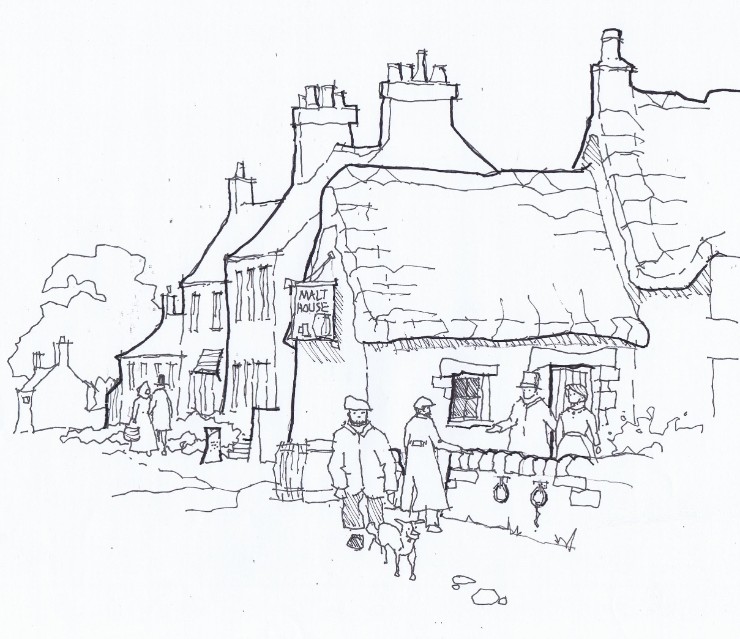 By: Nigel Lewis on 19/05/2023 101 THINGS YOU (PROBABLY) DIDN’T KNOW ABOUT WHITCHURCH 97 RAILWAYS
Imagine Whitchurch 250 years ago, you probably couldn’t. A pastoral corner of the country that hadn’t changed much in the hundreds of years previously. Quiet local tracks linking the various farms, and a ‘dodgy’ rural road down to Cardiff. Less than 700 people living in the whole parish
When the turnpike road was opened through the village in 1767, it must have been a rude awaking. Linking up to the countryside northwards, with traffic passing through the village for the first time. This was only worsened when the Glamorganshire Canal opened in 1794, winding its way south, through the village
This was the time of the Booker empire at Melingriffith and the Pentyrch ironworks. There had been a connection between the two industrial centres for many years previously. At first there were mule trains, crossing the river at Radyr at the ford, then about 1815, the Melingriffith and Pentyrch Railway linked the two with a narrow-gauge railway running alongside the river, complete with a bridge at Tongwynlais. The first railway in the village!
I wonder, did this line have steam engines? Does anyone know? The railway was improved in 1871 with the introduction of a standard-gauge track. This though was only a local railway with little impact on the village
Imagine the shock then, when the first ‘proper’ railway was built. The Taff Vale Railway in 1841 from Merthyr, which squeezed its way through Tongwynlais and crossed the river south of Melingriffith There was a station at Primrose Hill (named ‘Llandaff for Whitchurch’), and then running east towards Gabalfa, and into Cardiff
The next line was the Rhymney Railway in 1858, which crossed the Taff Gorge with its incredible Walnut Tree Viaduct at Taffs Well. It’s fascinating to learn that Taffs Well was known as Walnut Tree for many years previously, named after the local pub. And that Peter Finch’s father was the local blacksmith with his forge next to the pub! Sadly, only one of the mighty pylons remains as you pass by on the A470
This was the time when lots of railwayman’s cottages were being built in the lower village and Llandaff Yard, and the census’ began to list all of the various railway-related trades coming to the village
Then, in 1909 came the Cardiff Railway. This was the Bute attempt to get coal delivered to their own docks in Cardiff, branching off the Rhymney Railway line at the Heath, and cutting across the upper village with stations at Birchgrove, Rhiwbina, Whitchurch and Coryton. The line originally extended further, to Tongwynlais, Nantgarw and Rhydfelin, but it finished fractionally short of the main line at Trefforest (the TVR had acquired a vital strip of land, thus preventing the link up). Because of this, the line was never successful, and it was closed beyond Coryton by 1931, surviving as a passenger line only
Dic Mortimer says that at its narrowest point, the Taff Gorge shared the Barry Railway, the Radyr to Pentyrch road, the Melingriffith and Pentyrch Railway, the Pentyrch Feeder, the River Taff, four tracks of the Taff Vale Railway, the Glamorganshire Canal, the Merthyr Road and the Cardiff Railway, all in a space just 250 m (800 feet) wide! Nine arterial routes in such a narrow gap
Alan, from the village, has shared lots of stories about his life working on the railways, and the growth of the Radyr marshalling yard, just across the river. We’ve included an OS map of the Radyr yard, dated 1950, just to show how enormous it was. Of course, there was another yard almost as big at Gabalfa. Both yards are now long gone, replaced by housing. Only the old photographs and stories of the railway workers remain. Do you know of any?
We’ve been told from older residents that much of the local damage by bombing in WW2, was of German bombs aimed at the railway yards at Radyr and Gabalfa, using the reflected light of the River Taff as a silvery guide for the night bombers
So, what of the future? Welsh Government have exciting plans to upgrade the various lines which still remain, and also the possibility of extending the Coryton line to cross the River Taff to the main Merthyr line, thus creating a circle line for the city. I wonder if these plans will ever be accomplished, particularly as we seem to be in a continual time of recession
Dic Mortimer wrote a blog in 2011 about the railways and how they affected Whitchurch and Tongwynlais. It’s a really interesting read if you can still get hold of it
What are your memories of the railways passing through the village? We’d love to know more
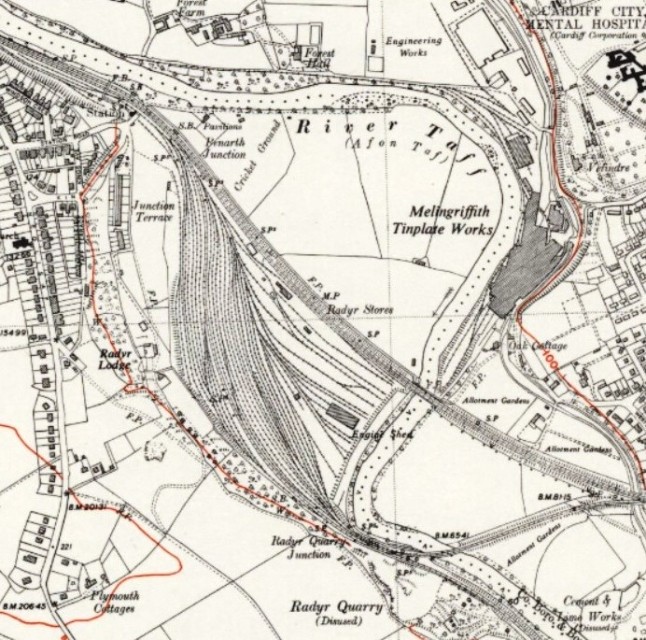 By: on 10/05/2023 101 THINGS YOU (PROBABLY) DIDN’T KNOW ABOUT WHITCHURCH 96 GWAUNTREODA ENGINEERING COMPANY
I’m told that the Brown Lennox factory in Pontypridd manufactured the anchor chains for the Titanic!
We had an engineering firm in the village which had just as memorable (almost infamous) claim to fame
The Gwauntreoda Engineering Company, which was formed about 1861, was part of a very successful manufacturing group based in Manchester. The works were built in Whitchurch in open countryside, just south of the recently constructed TVR railway line, and had vehicular access off College Road. There was ample water for the boilers and other plant from the outfall stream of Little Mill, which was north of the railway line. They even constructed their own branch railway siding into the works
They had built 10 workmen’s cottages on the main road (are these the cottages which are there today?). There were 2 lodging houses in the row too, for itinerant engineers in the works. With over a hundred people working there, I can’t imagine where everyone slept!
The Crown Hotel next door, built about the same time, was obviously an attraction
The works were very busy, and the successful Gwauntreoda Engineering Works manufactured all of the iron structure for the new two-mile-long Tay River Bridge in Scotland.
Why is this important you might ask? Well, the Tay River Bridge collapsed catastrophically, shortly after it had been completed in 1879, whilst a passenger train was crossing. It is thought that it was one of the worst train accidents ever to happen in Scotland, with 59 people killed. The Scottish poet William McGonagall even wrote one of his most famous poems about it!
You would think most people would play down any involvement in such a disaster. But strangely, the Gwauntreoda Engineering Company continued to declare their involvement in advertisements for years after!
By 1879 (shortly after the disaster) there was an article in newspapers advising: ‘we regret to hear that Messrs de Bergue and Co of Manchester, intend closing their branch establishment known as Wauntreoda Works, near Llandaff, as soon as orders which they have now in hand are completed. The works in question, which have been in operation some 18 years, and comprise plant estimated at £30,000, employ about 100 men in boiler-making, who will, inconsequence of the determination of the company, be thrown out of work’
This was about the same time that the Booker empire at Melingriffith collapsed too!
In 1884, in another vain attempt to sell, the works contents were listed as: erecting sheds, smiths and machine shops, gas works, railway siding etc, occupying about two and a half acres of ground, with good water supply. The works are complete with steam engine, boiler, shafting, smiths fires, furnaces, cranes, punching, shearing, planning, riveting, turning and other tools for the business of boiler and girder making you can almost taste the foul air of such a noisy and scary Victorian works!
The map below, based on the OS map of 1880, shows the works. It had a 3-bay building, with their own railway track access to deliver and dispatch the heavy iron sections manufactured. It had a gasometer, so was producing gas for their boilers and furnaces. There are no photographs that I am aware of, so we can only guess what the place was like
In the end, the company continued in some form and was sold a few years later by private contract to a Swansea tinplate manufacturer, and they announced that they were contemplating restarting shortly. I wonder, did this happen?
Can anyone cast any light on what happened afterwards?
Everything is so different now. The railway and bridge are still there, the Crown pub has gone, replaced by smart apartments and a row of cottages still front the road. Little Mill to the north of the railway line has gone, and I assume that the mill stream has too. And of course, all the open fields are now filled with houses
Were any of your family working there? Are there stories about this corner of the village that you can share? We’d love to hear 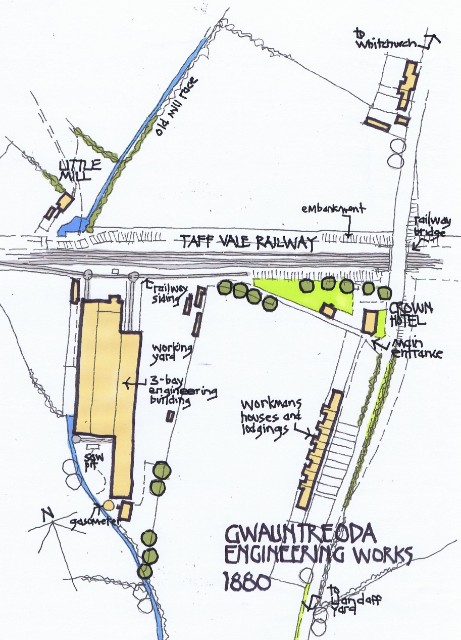 By: Nigel Lewis on 05/05/2023 101 THINGS YOU (PROBABLY) DIDN’T KNOW ABOUT WHITCHURCH 95 GREENMEADOW
Greenmeadow is yet another of the grand houses of the parish that has simply disappeared from view and memory. Fortunately, the history of the house and the genealogy of the Lewis family who lived there, is well documented by local historian Don Llewellyn
A lot of what follows is taken from his book of the same name
The Lewis’ of Van were an ancient part of the Lewis family, perhaps dating from 1540. It has been suggested that the family were in the area as far back as the 12th century, as ancestors of Ifor Bach
Greenmeadow was probably a modest farmstead originally, known as Congwynlais in 1570, Cwmgwynlais (in 1625) and Pantgwynlais (by 1785). The farmhouse would have been enlarged and rebuilt over the years until it became the mansion Greenmeadow by the early 1800s
In Yates’ map of Glamorgan 1799, a William Lewis was occupying Greenmeadow
A convoluted family history and wills lead Greenmeadow to become home to Wyndham Lewis and his young bride Mary Anne (she was 12 years younger than her husband). They married at Christmas 1815 and moved into the mansion a few years later
This was the couple who had a strange relationship and notoriety at the time. Wyndham Lewis was an MP and they both mixed in high society in London. There she met Benjamin Disraeli (who was later to become prime minister). There are numerous stories of Disraeli staying in the Cow & Snuffers in Llandaff North when visiting Greenmeadow, and even stranger stories of him having to decamp to the Hollybush pub when Wyndham Lewis returned home unexpectantly. I wonder how much truth there is in all this?
Wyndham Lewis died in 1838, aged 58, and Mary Anne married Disraeli in August the next year!
Greenmeadow passed through the family, and there were a series of Henry Lewis’ over the years. One Henry Lewis died in 1881 and is buried in Whitchurch. His son Col. Henry Lewis inherited the estate, and with his own son Rupert, Greenmeadow blossomed. Col. Henry Lewis died in 1925, and is buried at Llanilltern
The family were spectacularly wealthy and ‘lorded’ it over the local community. It’s said that, in the latter years, the mansion held many glamourous dinner parties and balls. John Bryant of Llantrisant was noted as harpist to Greenmeadow (listed in Who’s Who in Wales 1920)
Horses, riders and hounds of the Pentyrch Hunt were very familiar to the forecourt. There are also photographs of the hunt outside the family pub, the Lewis Arms in the village square
What was Greenmeadow like? The 1927 sale catalogue (after the death of Col. Henry Lewis) suggests numerous living and servants’ spaces with cellars, grand rooms to the ground floor, magnificent bedrooms and dressing rooms to the first floor and nurseries and further servants’ quarters on the second floor. One living room had previously been the ‘Justice Room’
The sketch shows the southwest ‘tower’ of the house in the late 1800s, with the coloured awnings over the windows to some of these grand rooms. Perhaps Colonel Lewis is discussing the hunt with one of his gamekeepers!
In addition, there were extensive kitchen and servants’ quarters and separate stabling and kennels. Strangely, there was no laundry in the house. All the washing was done in one of the Pine Tree cottages on the road from Whitchurch to Tongwynlais
The census of 1861 lists Henry Lewis (magistrate) with his wife and 4 children, and a house-full of servants; butler, cook, nurse, nursemaid (age 8), housemaid, page(!), errand boy (age 11) and stable boy. Lots of others including kitchen staff, gardeners, grooms and gamekeepers would have lived nearby
Sadly, the line died out with Col. Henry Lewis early in the 20th century, and the house became empty. It was left to deteriorate and finally became ruinous
Cardiff RDC acquired the land and council housing on the site began in 1930s and completed in 1947/48, obliterating every last vestige of the grand mansion that was Greenmeadow
Local folk talk about ghosts wandering around the grounds, but only the demolished house is the true ‘ghost’ of the village, along with its name
Today, all that one sees are the houses and gardens that were once a simple council estate, and is now a mature corner of the Tongwynlais village. If you look really hard though, you may just see the ‘ghost’ of Greenmeadow in the distance
Our thanks go to Pentyrch and District History Society for much of the wonderful information from Don Llewellyn’s book
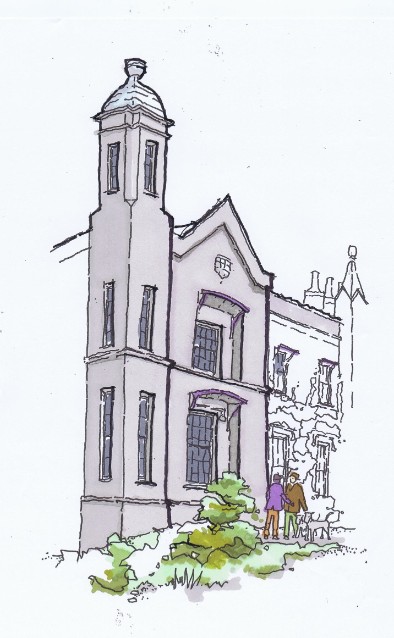 By: Nigel Lewis on 27/04/2023 101 THINGS YOU (PROBABLY) DIDN’T KNOW ABOUT WHITCHURCH
93 FORGOTTEN HOUSES OF WHITCHURCH 2
Previously, we looked at some of the houses in the parish which have been lost, where only the name and perhaps a vague memory or two remain. Ghosts of houses from the past which still leave the faintest of footprints; almost forgotten over time, but not quite
Here’s another tranche:
Velindre and The Grange We’ve looked at Velindre previously, but only scratched the surface of its replacement The Grange. Home for Edwin Goodhall, the superintendent of the new Whitchurch Hospital, even this house has now been demolished
Trewertha Was this built by Job Davies for his mother? Set back off Old Church Road at the end of a tree-lined carriageway, it was later the home of the Haddock family. Falling into disrepair after WW1, it was finally demolished in the 1950s and the site is now occupied by 3-storey flats
Ty’n-y-Parc An old farmhouse (giving its name to the busy road) which had been gentrified in the 19th century. It was home to Count Antonio de Lucovich and his family, and also Sir Henry Cory (who was living there whilst his new house Coryton was being built). Again, demolished and this one replaced by bungalows!
Penlline We know absolutely nothing about Penlline (opposite the Methodist Church), except that it was clearly a large detached house with gardens. Long demolished and replaced with 2-storey flats, all that now remains is a tantalising section of the tall red brick front boundary wall, and an old oak tree just behind. Does anyone know anything more about Penlline?
Greenhill The home of the newly-married John Partridge Booker and his bride Clara. It was previously an old farm called Pwll-y-Winci (weasels pool). The old photograph (courtesy of Cardiff Libraries) shows Greenhill in its splendour After the Bookers, and a series of tenants, Captain James Chappell and his wife moved into Greenhill in the early 20th century. They donated a new peal of bells to St Mary’s Church; I wonder if Captain Chappell gave his name to Heol Chappell? Greenhill was later acquired by Cardiff Council for use as an open-air special school. Initially, the house was converted and then finally demolished in the 1950s with a new school built on the site
Forest Hall This was an imposing house alongside Forest Farm, with Hubert Spence Thomas and his family, the manager of the Melingriffith works, living there early in the 20th century. Prone to regular flooding, Forest Hall was finally demolished in the 1960s and in its indignity, is now a car park. Only the garden trees remain. There is a photograph of the house in Steve Nicholas’ book
Treoda House This house on Old Church Road probably had a long history dating back hundreds of years, but nothing now remains and little is known. It is shown on the Tithe Map, and in the 1851 census it was called Castel Motte. A double-pitched house built tight to the main road, it was probably built in at least two phases, with a smart front wing added, most likely early in the early 19th century. Treoda House had extensive gardens to the rear, and incorporated the remains of the motte of Whitchurch Castle. The Bird family lived in Treoda before WW2 and used the extensive grounds for their market garden The house, and all of the gardens, were demolished and removed in the 1960s, replaced by the 3-story flats of Clos Treoda
What about other houses in the parish? Llwyncelyn on Pantmawr Road Hawthorn House in Llandaff North, or Bryn-Hyfred on Heol Don
What have I missed, what other long-lost houses have I forgotten?
I’ve deliberately not included any of the farms, as we’ve looked at them in previous blogs, but just in case, are there any other houses that you know about, that deserve special mention, please let us know.
Join us at our Reminiscence Group at Whitchurch Hub on Tuesday 2nd May 2pm.  By: Nigel Lewis on 21/04/2023 101 THINGS YOU (PROBABLY) DIDN’T KNOW ABOUT WHITCHURCH ANOTHER LITTLE EXTRA - Gabalfa
One really enjoyable part of being AWEN is meeting up with the schoolchildren from the local schools. Recently we met up with the children from Gabalfa Primary. They are exploring the history of Gabalfa, and we’re so pleased to help them with their researches
However, it only shows how little we at AWEN actually know about this corner of our old parish
Whilst we’re discovering quite a bit about the history of Llandaff Yard, we don’t know very much about the old part of the hamlet
We’ve recently found out a little about an ancient house called Gabalva, and how it was finally demolished just after WW2, when the Gabalfa Estate was being constructed. We’ve also discovered how the Glamorganshire Canal ran through what is now Gabalfa Avenue. Sadly, all the old lock-keeper’s cottages and canal-side docks have been lost under the new houses
There is one area however, where we’re really struggling, and this relates to the bottom end of College Road where it crossed the canal
Was this the area which Ernie Broad referred to as ‘the Freehold’?
The College Iron Works was located on the north bank of the canal, and opposite was a collection of small cottages forming a ‘vee-shape’. I wonder, was this the area, that in 1864 was known as ‘the Llandaff Nuisance’? An area of 12 houses with terrible sanitation and where ’the doctors did not like to go’! Does anyone know any more?
Looking at this area on the OS map of 1880, there was a cottage (nearest to the canal) which looked a little bigger than the rest, and had a rear annexe. Could this be the location of the ‘lost’ pub called the Three Cups?
The 1891 census says that the pub was located at Canal Bank, Gabalfa
I’ve produced a sketch, based on an old photograph, showing the pub about 1900, a stone double-fronted cottage with a rear annexe, with a smaller cottage alongside and others in the far distance. It’s a good contender, unless someone knows differently?
If one was to have a pub on the canal, locating it just downstream of the canal lock would be a really good spot. As it was only a quarter of a mile upstream from the graving docks would help too. And having an ironworks just over the canal would have been the icing on the cake
I can easily imagine a bargee sitting on a barrel alongside the canal on a hot day, with his horse enjoying a trough of water or some oats. I’m sure there must have been some challenging times though, when the bargees and ironworkers came to blows!
I believe this area is now the roundabout, where College Road and Gabalfa Avenue meet, with the Gabalfa Library/Hub on the south-western corner. All so different from two hundred years earlier when the canal was first opened
Can anyone help to fill in the gaps in our local history? We’d love to hear
PS As part of 101 Things, next month, we’re having a blog exploring and learning a little more about Gabalva House, so look out for that. And it goes without saying that if you have any information about it, please let us know and we’ll try to include it
 By: Nigel Lewis on 16/04/2023 101 THINGS YOU (PROBABLY) DIDN’T KNOW ABOUT WHITCHURCH 92 WHITCHURCH HOSPITAL 3
Last time we looked at Whitchurch Hospital during two world wars. This time we’ll look at what’s happened since
July 1948 was the watershed when the NHS started. In Wales we are so proud of Aneurin Bevan and his burning zeal to provide free healthcare for everyone
I don’t think Whitchurch Hospital changed much over the following years (but I’m sure Gwawr and the Friends of Whitchurch Hospital will have different views!). there was rationing and unemployment and then years of governments with differing views on state healthcare
The Victorian hospital hardly changed, but many poorly-constructed buildings were added all round
At some time, the farm was abandoned; does anyone know when this might have happened?
The hospital continued to provide an important role in metal health, and patients were encouraged to work and undertake recreation. Local artisans were often employed to teach skills, and the hospital sports teams continued
I’m sure many long-term residents of Whitchurch will recall seeing ‘lost souls’ wandering around the village (seemingly, part of their therapy), and I know of many interesting conversations held between these patients over the years
Belatedly, in April 1994, the hospital and ground were listed Grade II by CADW, considered to be the best example in Wales of a large mental hospital
However, poor maintenance continued, and medical attitudes to long-term care were changing with patients moving into the community instead. From the 1980s, the hospital went into a period of further decline, and was finally closed in April 2016. The Friends of Whitchurch Hospital held a celebration and exhibition just before closure
Since then, the local NHS Trusts have not been able to decide what to do with this 19th century legacy
Over the past 10 years, Cardiff & Vale NHS Trust has been seeking to obtain planning permission to redevelop the hospital, and a masterplan entitled ‘Whitchurch Green’ was published. They say it has no planning status, but envisages the old hospital site as a new community for housing, commercial and light industrial uses. Planning permission has already been granted to build houses on various parts of the site and at Ty Clyd
All the time, the old buildings continue to deteriorate, bringing the risk of demolition ever closer. I know that our local councillors, MS and MP are really concerned, and have been pressing for something to happen
The truth is, the vulnerable parts of the site are almost beyond saving already, and unless something happens within the next few years the whole site will be flattened
Don’t we deserve better? What do you think?
I’d like to think that parts of the old hospital could be used for local community use. As well as the old chapel, there’s a magnificent theatre and numerous buildings suitable as studios and workshop spaces. The old hospital could make a wonderful arts facility for the whole of the north of Cardiff and the adjacent valley communities (a ‘Chapter Arts’ for the north!). Other buildings could be adapted for residential use and for work/live spaces for all sorts of artistic uses. All that would be needed is a group of enthusiasts with a passion to save this iconic place. It would take ten years of hard work to design and fundraise for such a project, and it’s not too late. I’m up for it, but we’d need 20-30 similar-minded local folk ready for the fight. What do you think?
The sketch shows the splendid main entrance to the hospital and how it could look as the entrance to a wonderful arts facility. I think it’s too good to lose
As a postscript, in 2021, the Victorian Society added Whitchurch Hospital to its ‘most-at-risk’ register, noting that it had now fallen into such disrepair it is now one of the most endangered buildings in the UK!
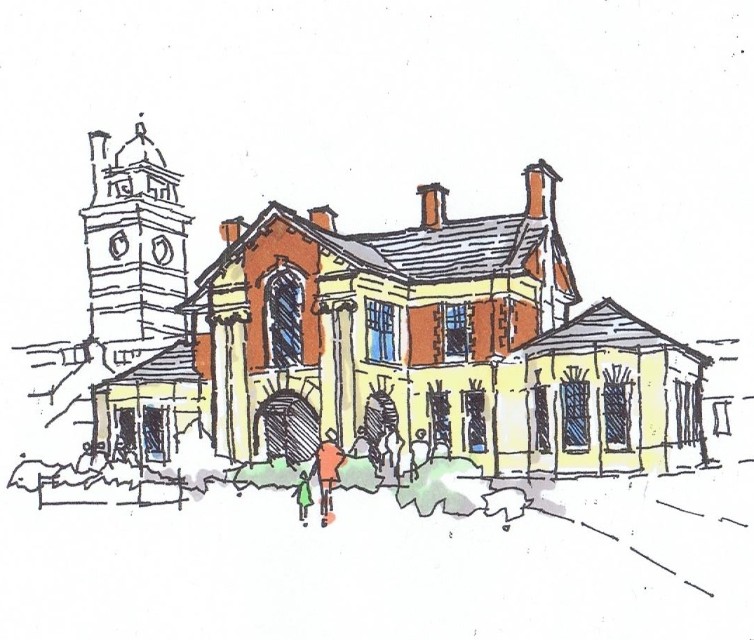 By: on 06/04/2023 101 THINGS YOU (PROBABLY) DIDN’T KNOW ABOUT WHITCHURCH 91 ST MARY’S
Because it’s Easter, I thought that we could look at our parish church and its place in the community
Behind the stone wall on the traffic lights, just north of the shops is our parish church St Mary’s. Glimpsed through the lych-gate, the church and bell tower with its crowded churchyard and yew trees has an almost ageless look
The sketch below shows St Mary’s from a viewpoint just inside the lych-gate, looking towards the tower, just as a bride would see on her way into church as an Easter bride
St Mary’s (designed by the Llandaff architect John Prichard), was built in 1883-4 at a cost of £3,559, and opened in May, the next year. It was built because the old church was too small and was becoming derelict
The churchyard was already there, it was opened in 1876. The old graveyard in Old Church Road was far too full and there were constant squabbles about fitting in any more graves. The first stone of the 2-acre graveyard wall was laid (without ceremony) in November of that year by Mrs TW Booker
The vicarage, a little further north along Penlline Road (also designed by John Prichard) had been built even earlier and is shown on the OS map of 1880
By 1908, the parish hall opposite was built
Whitchurch was only created as an independent parish from Llandaff in 1845. It’s fascinating to discover that 16 years later, in the census of 1861, Evan Price Thomas, the vicar of Whitchurch was a lodger at the Hollybush Inn!
When the church was first opened, the tower hadn’t been completed (it would be interesting to see how much had been built), and it wasn’t until 24 years later that the tower was completed and a new peal of bells provided, courtesy of Capt. and Mrs James Chappell of Greenhill
The enthusiastic group of bell-ringers (campanologists) still ring the church bells in the traditional way on high days and holidays. I wonder if we’ll hear the bells next month for the Coronation?
The lych-gate wasn’t always on the corner. When the churchyard was first opened, Church Road hadn’t been constructed, and the lych-gate was a little further up the main road. The well-known photograph of the Plough taken from the top of the tower shows the original lych-gate location! After 1902, when Church Road opened, the lych-gate was moved to the corner
Following WW1, vestries were added to the north, but the construction of the north aisle was deferred due to a shortage of funds, only to be built quite a while later
The church has a series of wonderful stained glass windows, and the striking east window with its crucifixion scene was installed in 1936 in memory of Mr WR Davies, managing director of the Melingriffith Tinplate Works
Originally, the church interior had bands of polychromatic brickwork, but it was later whitewashed over to make it a little lighter
AWEN have been given a set of booklets listing the graves in St Mary’s. Perhaps we could arrange for a library event later in the year, exploring family histories
2022 saw the centenary of the burial of Charles Burley Ward VC, and AWEN with the rector Father John Davis helped plan the successful commemoration
The churchyard holds a number of Commonwealth Graves, each with a simple white headstone. Ceri has been recording the stories of these fallen heroes, and in November last year curated a memorial talk, and a guided walk to the war memorial outside the library you can get a copy of the booklet from the Hub or download a copy from the AWEN@thelibrary website.
Geoff Foot has written a lovely book about the history of St Mary’s and in particular to the stained-glass windows. Geoff also writes about the history of the church and the chronology. If you can find a copy of the book, it’s well worth reading. I’m grateful for Geoff and his book as an invaluable source for chunks of this article 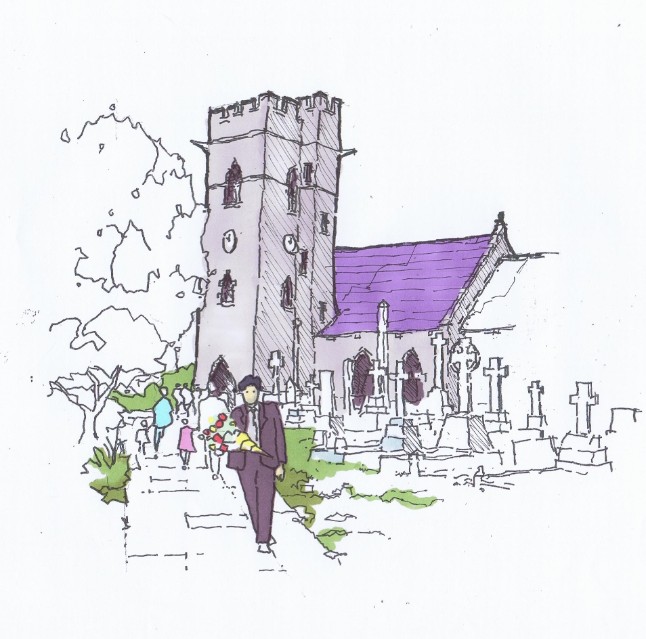 By: Nigel Lewis on 30/03/2023 101 THINGS YOU (PROBABLY) DIDN’T KNOW ABOUT WHITCHURCH ANOTHER LITTLE EXTRA
A few weeks ag we looked at some ‘forgotten’ houses, and there were so many there’s another tranche on the way, for a few weeks’ time
It got me thinking though, about another ‘proper’ forgotten building in the village, one with the scary title of Cardiff Regional War Room
I’m not completely sure where it was, but in an article by Nick Catford dated July 2003, he says it was located to the rear of the Wales and the Marches Telecom Board HQ at Coryton, close to Junction 32 of the M4 motorway. Is this the old Coryton House?
Does anyone remember any of this?
Coryton was one of 13 regional War Rooms across the UK, built in 1952 in the aftermath of WW2. Coryton was built to house the regional administration for Wales in the event of a devastating nuclear attack on Whitehall
According to Nick Catford, it was a two-storey concrete building with the lower floor completely below ground. It housed offices with an operation room below. It had separate men’s and women’s dormitories, a large kitchen and toilets, all behind massive steel blast doors
The layout was a maze of corridors with rooms off, all mechanically ventilated and artificially lit
It remained operational until 1958 when the network of regional war rooms was replaced by Regional Seats of Government (with the Wales seat based in Brecon)
The old war room was retained as a centre for training until 1965, when it was reactivated as the Cardiff Corporation County Control (later South Glamorgan CC) Emergency Centre, remaining in use until 1991
After that, the building was abandoned, and quickly deteriorated, with the lower storey having standing water
Back in 2003, the chairs, tables and bunkbeds were still in place, but vandalised
We’ve discovered a photograph of a concrete building with a glimpse of an older building behind. Was this the bunker?
Nick Catford in his article said that local children had broken into the war room in recent times, but little internal damage had been caused. Were you one of those children? Or do you have any family stories about such an adventure?
It sounds like a cross between ‘The Famous Five’ and ‘Doctor Strangelove’!
Apparently, some years later, the abandoned facility was sold to a property developer and the office block and war room were all demolished
We’d love to know more about this most secret of village places. If you have a story, or know anything about where it was, especially if you have a photograph, please let us know. Don’t forget AWEN’s Reminiscence Group on 4th April at 2pm and a very interesting talk about place names in Wales at the Hub on Wednesday 19th April at 2.30pm. 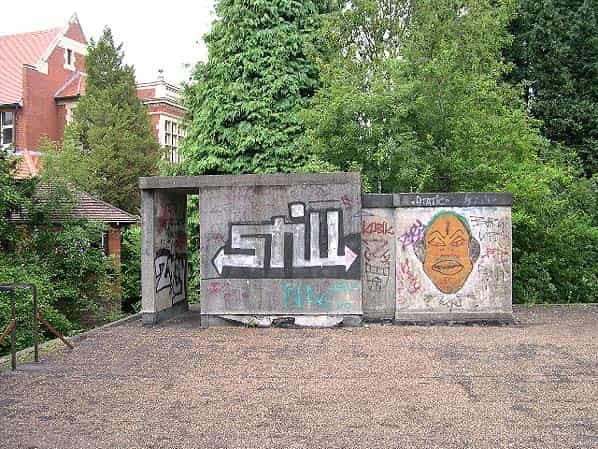 By: Nigel Lewis on 23/03/2023 101 THINGS YOU (PROBABLY) DIDN’T KNOW ABOUT WHITCHURCH 90 WHAT HAPPENED TO VELINDRE HOUSE?
We’ve looked previously at the saga of the Bookers, and how the Melingriffith works failed
TWB junior (some say the villain of the piece) simply left and moved with his family to another swanky house at Southerndown
Velindre, was left empty. I wonder what happened to all of the contents? They must have been spectacular. Did TWB junior take it all with him to Southerndown, or were they just auctioned off?
After the Bookers left, the old house was only sporadically tenanted, and for the next twenty years or so, slowly deteriorated
Finally, in 1899, the house, gardens and all of Ty-Clyd farm were sold to Cardiff Corporation for their new ‘Asylum’
So, when was Velindre demolished? It would be lovely to know
We’re told that a complete set of house plans of Velindre were handed over to the council at the time, but these have been lost in the passing years! How sad
You would hope that lots of important items would have been salvaged before the house was knocked down. We’ve discovered that the magnificent clock over the stable entrance was salvaged and reused at Roath Park, on the roundabout at the bottom of Fairoak Road, where the trams terminated. Are there any photographs of this? It’s not there now, I wonder what happened to it?
Cardiff Corporation obviously felt that an old mansion wasn’t modern enough for the new hospital superintendent, so a new house was built, called The Grange. Ironically, they built it over the footprint of Velindre. From the photograph below, it was by no means a modest place. Does anyone know what rooms it contained?
The pleasure gardens and lawns of the old house which had been so beautifully maintained ended up under the main hospital building! All of the exotic plants, greenhouses and pineapple plants lost. Only a few of the specimen trees to the perimeter of the site are still there, 120 years later
Surprisingly, the stone boundary walls along Velindre Road, the main entrance way to the old house, and the entrance lodge, all still remain. The lodge building is all boarded up now, looking for a new use. Perhaps it would make a great local history base for the village! What do you think?
Sometime, during the long life of the hospital, the superintendent chose not to live in the Grange any more, and it was repurposed for a variety of hospital uses. In its last form, it was a base for the security staff on site
Finally, the Grange itself became subject to vandalism, and the building was demolished. I wonder when this was? Does anyone know?
Nothing now remains of Velindre or the Grange. Just a piece of scrubby waste ground, behind the hoardings, awaiting its fate (along with the rest of the hospital). But that’s for another time 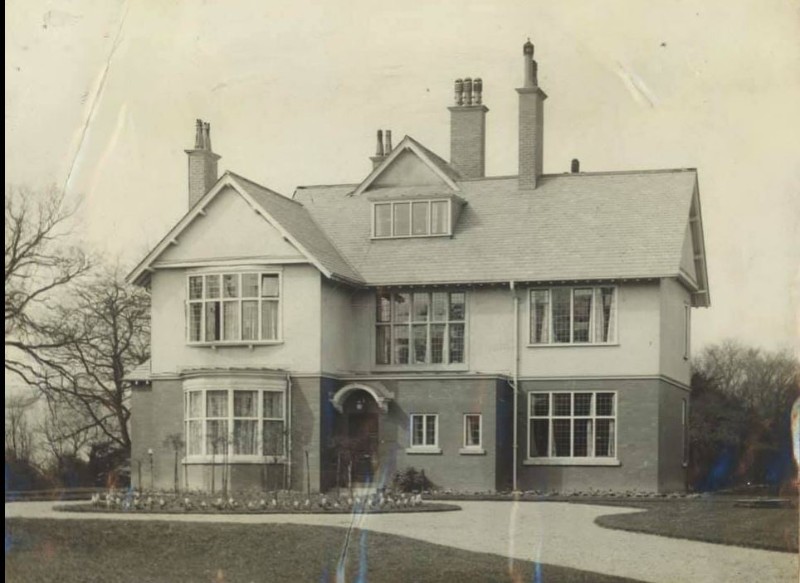 By: on 17/03/2023 101 THINGS YOU (PROBABLY) DIDN’T KNOW ABOUT WHITCHURCH 89 SHOPS
Back in blog 60 we looked at the corner shops in the village, and it attracted lots of comments. I thought it might be fun to look at the village centre shops this time and see what we can discover
There’s so much history to discover about all the old shops, not just in Whitchurch, but in Llandaff Yard, Tongwynlais, Birchgrove and Rhiwbina; probably enough to fill a few books at least
Today however, I’ll just look at Whitchurch, and then only a small part, from the Plough to the Royal Oak. This little block, bookended by the two pubs in Whitchurch is a fascinating journey on how our village grew, and surprisingly when!
At the time the Tithe Map was surveyed, the plot was just a large field on the corner of the main road and the winding side road (later to become Old Church Road). By the 1841 census, ‘Whitchurch House’ had been built on the corner and was occupied by John Thomas, a tailor and his family
Ten years later, this detached house was occupied by Reuben Lewis and his family. He was a blacksmith, and it looked like another house had been built next door called Ty Clyd (and was occupied by a retired farmer)
By 1861, another double-fronted house had been built at the southern end (the future Royal Oak pub), and five small terraced cottages built in between. The house next to the Plough had a roof much higher, I wonder whether it had been built like that originally? These eight properties, forming the block, remained pretty much unchanged for the following 90 years
The census of 1861 lists Reuben as now living in ‘The Plough Inn’, and he was now a publican; the start of the village shopping area!
We’ve all seen the old photographs of the block, some from the tower of St Mary’s and others from street view, showing how the block changed (or didn’t change) over the following decades
By 1877 the Royal Oak was an established pub (with the landlord George Roberts, in deep trouble with the licensing bench), but the terraced cottages seemingly still family houses
Kelly’s directory of 1916 notes that the house next to the Plough was now a fish and chip shop. It must have been sometime later that the Plough expanded into this house
It wasn’t until after WW1, that half of the Royal Oak was extended into the front garden to become a chemist. I’ve heard folk talk about ‘Ducks’, would this have been the same?
The sketch shows the block back then with the Plough on the left-hand end
There’s a terrific BBCTV archive video of the village (dated 1959-62) which shows the block hardly changed, but with the tiny chemist shop displaying a ‘Boots’ sign. There was also a hint of building work at the front of the Royal Oak
There’s also an old photograph which shows one of the small cottages as Tru-View (was this an early TV shop as well as wireless sets?). That old photograph also shows the redeveloped Boots in the distance
By the early 1970s, when we arrived in Whitchurch, the terraced houses had all been replaced with the large block of shops we know today. The Maypole had two of the four units, then Halewood’s and then John James next to Boots. Chris remembers Bartletts the hairdresser being over the shops
Since then, it’s all changed again, with Peacocks next to the Plough, then a charity shop, and then a solicitors shop alongside Boots
I wonder when the Royal Oak had its ‘mock-Tudor’ frontage added? Might it have been in the late 1950s when the Boots shop was redeveloped. Does anyone remember?
The last 170+ years has seen such a change to this little corner of the village, and the other parts have been just the same. What memories or photographs do you have which will help AWEN grow the archive of the village?
And what about Llandaff Yard, Tongwynlais, Birchgrove and Rhiwbina? So much to explore! Maybe, if we have time, we can look at the shops in these areas in a further blog
And in the summer, perhaps, we could have a session in the library with the large maps and the old photographs and see what the shops were across the parish at different times. What do you think?  By: Nigel Lewis on 10/03/2023 101 THINGS YOU (PROBABLY) DIDN’T KNOW ABOUT WHITCHURCH 88 FORGOTTEN HOUSES OF WHITCHURCH Over these past months we’ve looked at so many aspects of our village and the old parish, and discovered many things that we probably didn’t know. People, places and events now long gone and lost from memory
But then there are a few things that linger on. Ghosts from the past which still leave the faintest of footprints; almost forgotten over time, but not quite
Whilst many of the old places have gone, sometimes their names remain. This is particularly true of our lost houses, our forgotten houses. I can think of over a dozen houses from the old parish which, with their owners were prominent in past years, and I’m sure that you could add to them
There are too many to list in one article, so here’s my suggestions for a first list:
Greenmeadow I’m amazed that Greenmeadow hasn’t been mentioned before. Almost the only ‘stately home’ in the parish, with the grandest of families living there. Long gone now, and replaced by quite a large estate of council housing. We’ll need to look at this in a bit more detail before we finish this saga, but perhaps the photograph will remind you
Minafon Not a huge house, but in a prominent location (particularly as the A470 now runs past). The house was badly damaged by bombing in WW2, and was demolished in the 1960s, being replaced by flats and townhouses. All that remains today is the front boundary wall and the old name
Archbishop’s House Ever since we’ve lived in Whitchurch, we’ve known about the ‘Archbishops’ house in Westbourne Crescent, but haven’t discovered anything about it. It’s been converted into flats now, but there are still intriguing glimpses over the front boundary walls into the grounds. Does anyone know about this house?
Bryn Glas We’ve previously learnt a little about William Vachell and his Gentleman’s Residence on the Philog. It’s all gone now, and sadly, there are no photographs of it. The old OS maps give a hint, and we’ve suggested what it might have looked like in its prime. Retford Court now occupies the site
Plas-y-Llan Another Gentleman’s residence, this time on Penlline Road for John Ignatius Williams. He was a stipendiary magistrate, and after his death, his widow lived on in the house for many years. In addition to the house, there was a bungalow for the gardener! Plas-y-Llan was demolished in the early 1920s, and it’s been replaced by an estate of semi-detached houses. We don’t know what the house looked like, but it sounded quite special
Gabalva This house deserves an article on its own, so I’ll be exploring this in a month or so’s time. Gabalva gives its name to the large suburb alongside the river, but there’s no sign of it now. The house dates from the 16th century and had extensive landscaped grounds. Sold as a farm by 1940, all is now lost, but we should be celebrating it!
Maplewood Strangely, this house still remains, although most folk walk or drive past it every day without realising it. Set back from the main road, the large house has been brutally altered from its original appearance, with a changed elevation and poorly designed windows inserted to form flats. The gardens have been built on so there is no hint of what used to be, except the name of ‘Maplewood’ Avenue off the main road through Llandaff North. Can anyone help with its story?
Treoda (of ancient heritage) This is not only forgotten but completely lost too. Edgar Chappell suggests that it might have been located to the north of the Common (hence the name Wauntreoda), but it has also been suggested that it was somewhere to the north of Whitchurch Castle. All we know is that it was of ancient heritage and was quite special. Who was ‘Oda’?
What about other houses from Tongwynlais, Llandaff North, Birchgrove and Rhiwbina? What are we missing from these corners of the old parish?
Next time we’ll gallop through some more of our forgotten houses, including Trewertha, Ty’n y Parc, Penlline and Forest Hall. If there are others that come to mind why not tell us and share some of the forgotten ‘treasures’ of our village? 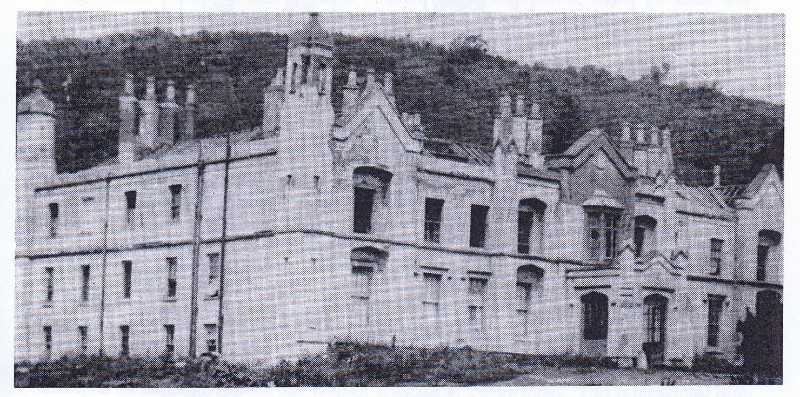 By: Nigel Lewis on 03/03/2023 101 THINGS YOU (PROBABLY) DIDN’T KNOW ABOUT WHITCHURCH 87 ST TEILO’S The sketch below shows the most modern-looking of our village churches. It is St Teilo’s RC on Old Church Road
This striking white-rendered church was opened in 1964 (so its Diamond Jubilee will be next year!). It sits next to the Fox & Hounds, one of our oldest pubs and is opposite the old St Mary’s Churchyard, the site of our oldest church
The history of St Teilo’s is intriguing. Before the Reformation, St Mary’s (or using it’s even older name of St Dionisus) would have been Catholic, with all services and celebratory masses in Latin. With Henry VIII’s purging of the Catholic faith in 1534, St Mary’s/St Dionisus became the new state church with services conducted in the new Protestant religion, and all Catholics ruthlessly hunted down
We know next to nothing about Catholic worship in the years after, but in all probability, many of the local landowners and farming folk would have been torn between the two religions. A little later, during the Civil War, there were skirmishes and full-scale battles locally, with many who secretly still clung to the Royalist cause and the ‘old’ religion, whilst many others favoured the new Parliamentary style of Puritan worship
It's hard to imagine the turmoil that happened in the intervening years
Over many centuries, Whitchurch had remained a simple pastoral village, with a static population. Then in the 18th century, with the coming of the tinplate works, iron foundries and the canal, the population exploded. And then the railways arrived. I’m sure that many of the new villagers would have come from Catholic stock. Where would these folk have worshipped? Does anyone have family connections?
A hundred years later, even though the Catholic St David’s cathedral in Cardiff was the centre for worship in Cardiff, there must have been those in the parish who wanted a local church
In fact, it took another hundred years. It was only in 1924, the first Roman Catholic Mass since the Reformation was celebrated in the village (another centenary celebration next year perhaps?). It was held in the Fox Schoolroom, next door to the pub, and it must have been very successful, as it wasn’t long before the worshippers outgrew the premises and moved into the ‘skittle alley’!
There was a need to build a ‘proper’ church. It was only a year later that this church group had raised sufficient funds to erect a ‘tin tabernacle’ on land adjacent, the site of the current St Teilo’s. This was always to be a temporary church, but remained for the next 40 years until it was replaced by the bold design we see today
That is still not the end of the story, as the Catholic families in the village started to outgrow the new church, and additional accommodation was provided, in 2004, forty years after it was first opened
Pause for a moment next time you’re driving along Old Church Road, and consider the history of this tiny corner of the village
Does anyone have any stories about St Teilo’s?  By: Nigel Lewis on 24/02/2023 101 THINGS YOU (PROBABLY) DIDN’T KNOW ABOUT WHITCHURCH 86 CHARACTERS OF WHITCHURCH 2
Well, here we are again!
Another list of possible candidates for the ‘Character of Whitchurch’ award
I could have included the any number of the Booker family, Disraeli (of Greenmeadow fame), famous recent sportsmen (Bale, Thomas and Warburton from Whitchurch High School) or even earlier sports personalities (John Williams, Ken Harris). What about our local poets and bards (Peter Finch and John Tripp). What about Sir Malcom Pill and his son Huw
Anyway, in no particular order:
Edgar Chappell Edgar (dare I call him by his first name?), lived in Rhiwbina, but is famous for his encyclopaedic books on the village and Melingriffith. So much of our history and folklore that remains is thanks to this man. We don’t know much about him as a ‘character’ but from the introduction to his book we get an impression of an incredibly studious man fascinated by his local history
Eli Evans (Sculptor) The more I learn about Eli, the more I am impressed. He was our local ‘sculptor’, and designer of memorial stones in the village. He lived at Vine Cottage and was Welsh-speaking. He was the organiser of the local Eisteddfod and lots of local groups, and very active at Ararat. He left an autobiography which is held at Swansea Library
Brian the Road Sweeper Brian and his brush seemed to be a fixture of the village twenty years or so ago. A quiet unassuming man, but he obviously made an incredible impression on folk, as he was recommended for a ‘gong’, and was given a BEM for his work
Maxxi the Big Issue Vendor I said I wouldn’t include any living persons on this list, but Maxxi is the embodiment of a ‘local character’. She always recognises me by name and has a cheery disposition, selling Big Issue outside Tesco by the library, whatever the weather
Eddy (of bakery fame) Most people I speak to about local history mentions Eddy. I hadn’t realised that Eddy was the family name, so what was his Christian name? The bakery on the Philog was legendary, but does anyone know of the story and the rest of the family?
The Misses Jones Their shop in the village seemed to have been there forever. If you wanted milk or ice-cream or anything else dairy, it was the place to go. So much so, that when they finally retired and the shop became a trendy wine bar, it was renamed ‘The Miss Jones’
Richard Lougher the Village Blacksmith Richard lived at the end of the 19th century and was the blacksmith next to the Three Elms. He lived on the Philog, and was well-known for walking to church every Sunday wearing his top hat with his wife alongside dressed all in black
Reuben Lewis Reuben was another local blacksmith, who was also landlord of the Plough Inn. Terry has discovered lots of information about the life of Reuben and how, many years after inventing his ‘novel’ plough, disastrously became bankrupt. He stayed in the area and was well known in frequenting many of the other pubs
Charles Horace Watkins Recently, I wrote about CHW and his monoplane. Whilst he lived just outside the village boundary, his flying exploits over Whitchurch in the early 1900s alone qualifies him as ‘character’
John Ignatius Williams Apart from his wonderful name, JIW lived in a huge house opposite the rectory on Penlline Road. We know he was the stipendiary magistrate at Merthyr, but not much else. His house, Plas-y-Llan, long demolished, has been replaced by dozens of semi-detached houses. Does anyone know more about him?
William Vachell William was a ‘retired druggist’ when he lived in the village. He built a grand house called Bryn Glas on the Common with plans for pleasure gardens running down the north side of the road. Sadly, William died before these garden plans developed. His only son inherited everything and moved to Llandaff where he became a ‘character’ over there
William Flay Everyone refers to ‘Flays Farm’ on the common, and so is this a case of ‘location character’?. The Flays not only farmed the local fields, but also collected the household refuse in the village. In later years, the Flays had a successful furniture removal business from the farm Glenys who lives opposite, tells of Old Mr Flay who used to park his Daimler motorcar in the arched driveway of their small cottage
Shoe Repairer (on the Common) I was told recently of a shoe repairer, who occupied the brick building on the Common, who, after WW2, used to ride around the village on his old black bike. This had a large wicker basket on the front, and a metal advertising plate between the wheels. The sign apparently read ‘Jesus saves your Soul, but I save your Soles’ Does anyone remember him? Perhaps the sketch below might prompt your memory!
Griffith Phillips He lived in the Pines some time after Richard Booker, and was Mayor of Cardiff at one time. Ernie Broad refers to him as ‘The Squire’, and tells that at Christmas, small children would stand at his front door singing carols, to be awarded with bags of sweeties!
Herb Clare Herb lived on Merthyr Road, and was a ploughman on College Farm Fields many years ago. Ernie Broad tells the story that Herb could plough a whole field and would cuss and swear the whole time. His foul language was so appreciated by the young boys of the village that they would congregate just to listen!
And finally…
Chris Harris It’s sad to report that Chris (of local cycle shop fame) has recently passed away. It was my pleasure to know Chris for most of the last 50 years, and he was everything that encapsulates ‘character of the village’. Instantly recognisable, he would always have a word with everyone he met. Probably, most children in the village have ridden one of his bikes, or had one repaired by him. Damian continues the family name with his shop, now specialising with electric bikes…
If you have further stories to share on these or other characters, please do. 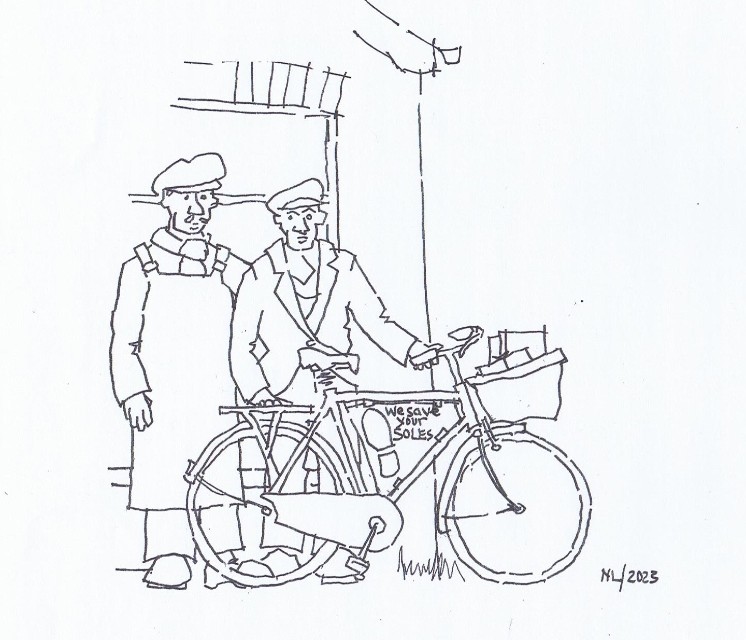 By: Nigel Lewis on 17/02/2023 101 THINGS YOU (PROBABLY) DIDN’T KNOW ABOUT WHITCHURCH 85 BUST AT MELINGRIFFITH The story of the Booker family is like a Victorian melodrama. Starting with an unexpected inheritance, the growth of a tinplate works (and the acquisition of both an ironworks and coalmines just upstream at Pentyrch). Fabulous wealth, TW Booker becoming MP for Herefordshire and all-round philanthropist to his workers and the local community
As in all the best melodramas, there was a villain-of-the-piece. TW Booker (junior) inherited the business after his father died unexpectedly and his two brothers died young too
TWB (junior) was so unlike his father. In true Victorian style, it’s been suggested that he greedily expanded the business, exploited his workers and milked the profits. Corners were cut and health and safety issues totally ignored
When financial pressures increased, he turned his business into a limited liability company and borrowed heavily from his bankers
The Franco-Prussian War of 1871 (who ever heard of that?) caused a world-wide financial slump and the trade for tinplate suffered. Business was not good, but TWB (junior) still had standards to keep!
The Booker-owned coalmines and ironworks at Pentyrch seemed like a cash cow, with very little investment, they were milked for all they were worth. In December 1875, there was an explosion at the Lan Colliery when there were 150 men and boys working underground. According to Dic Mortimer, Lan was a disaster waiting to happen; claustrophobic tunnels, dripping walls, sagging pitprops, and methane. 16 men and boys were killed on that day!
The subsequent inquiry (with jury members pretty much all Booker employees!) found the company accountable for the disaster, but were given the mildest of rebukes; ‘they should show greater vigilance in future’
In the same year, 1875, the West of England & District Bank, who had lent huge sums to the Bookers, failed and crashed with huge debts. The following year, the Booker enterprises failed too, with permanent closure of the Pentyrch works and only fitful working at Melingriffith, all run by a liquidator
Amid this catastrophe, TWB (junior) and his family simply walked away. They left Velindre and set up home in a swanky house in Southerndown, overlooking the sea (but still with lots of servants to help). The sketch below shows Velindre at the time, perhaps with the elegant daughters having a lingering last look before leaving
In Whitchurch, many workers and their families found themselves without work and home, so left the area. The subsequent crash caused widespread recession locally and took many years to overcome
What about Melingriffith? It was put up for sale in 1881, but there were no takers. It was leased to the Cardiff Iron and Tinplate Co Ltd and limped on until 1887 when it too was placed in liquidation
Finally, in 1888, it was sold in lots by public auction, and the Melingriffith works, its railway and 39 freehold cottages were bought by Richard Thomas of Lyndhurst for a knockdown price of £12,000, plus a further £10,500 for all of the plant and machinery
He set up a new company, Melingriffith & Co Ltd with wealthy and powerful shareholders. It prospered with increasing world trade, no debt, ample free water supply and skilful management. By 1916 Richard Thomas & Sons took control with Spence Thomas as managing director until 1934, when it was sold to Richard Thomas & Co Ltd
Melingriffith remained in profitable production, through two world wars, until 1957
What about Velindre? Sadly no one wanted it after the Bookers had left, and it remained empty (although it was sometimes tenanted) for the next few decades. We’ll take a final look about the house in a few weeks
So, what happened to the Bookers? TWB (junior) had 8 daughters, so no male heir. Richard Blakemore Booker remained a bachelor, and although John Partridge Booker married, was there any family? Does anyone know?
Dic Mortimer suggests that TWB (junior) died a broken man in 1887; I wonder? Are we being too harsh on the man. What do you think?
No happy ending sadly! Just lots of new houses built on the site of an historic works which (some will say) made our village
What do you think?
Thanks to Dic Mortimer for information on ‘Cardiff’s Mining Disaster’ taken from his blog posted 23 September 2011 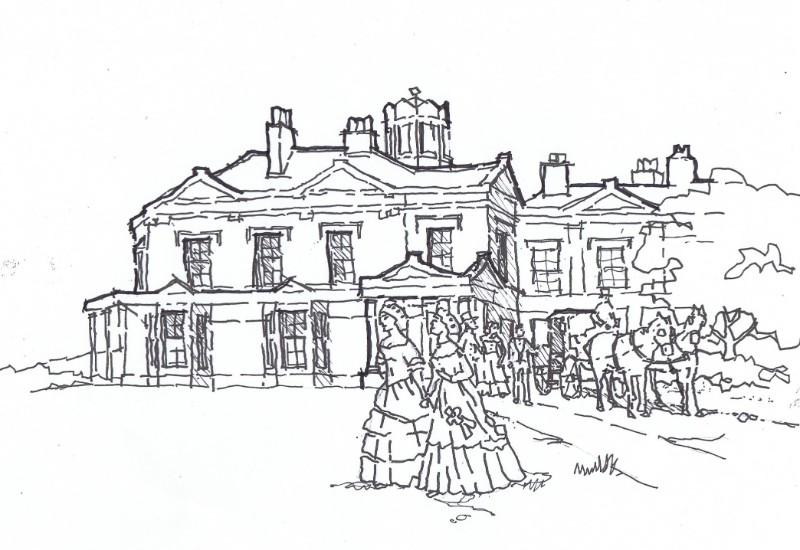 By: Nigel Lewis on 10/02/2023 101 THINGS YOU (PROBABLY) DIDN’T KNOW ABOUT WHITCHURCH 84 PUBS
We’ve previously looked at churches and chapels and remarked how many there were. We’ve also been surprised at how many local farms we had too. So, imagine my surprise when I started to research how many pubs we have, and what a thirsty lot our village ancestors must have been!
Have you ever made a mental list of the local pubs?
Trying to do it in a systematic way (and realising that the parish once was a lot larger), this would be my list, starting from the north: Hollybush Plough (slight divergence eastwards) Fox & Hounds and Masons Arms, then Royal Oak Maltsters Three Elms (off to the west) The Crown (and then, tight to the parish boundary to the south) Birchgrove and New Inn
Then just south of the parish boundary into Cardiff were: Three Horse Shoes Cross Inn
In Tongwynlais: Lewis Arms The Ton Cardiff Arms
In Llandaff North: Station Hotel Royal Exchange The Pineapple Cow & Snuffers Three Cups
And in Rhiwbina: Butchers Arms The Deri
Not counting sports clubs or the British Legion, I make this over 20 pubs, with 9 still open in Whitchurch village alone
We’ve learned a little bit about the beer houses which started in the 1830s (one called the Farmers Arms was where the Pines now stands); I wonder whether any of the pubs listed started off as beer houses? Does anyone know?
Then there were pubs which have disappeared altogether. Terry tells me about one called The Greyhound. This was a notorious Whitchurch pub which was attempting to renew its drinks licence in 1869 (the magistrate was assured that it had improved its behaviour so the licence was renewed). Does anyone know where this pub was? Then there was another called The Rollers Arms in Llandaff Yard (with an incredible story to share)
There’s too much to write in just one blog, so we’ll re-visit the pubs again in a month or so, to share some of their individual stories. If you’ve got any that you’d like to tell us about, we’ll try to include them
I did wonder about organising a future village walk, to include the pubs. Clearly, this would be very popular and probably greatly oversubscribed. The trouble would be that most folk wouldn’t get past the first two venues, and anyone reaching the fourth or fifth pub would never remember, so maybe not. Too much like the ‘Grog Trot’ of blessed village folklore
And just to finish this article, the sketch attached is of one of our most recognisable pubs, the Plough. This and lots of other illustrations are being prepared for two permanent waymarker boards which will be unveiled in the next month or so. One board will be adjacent to the Three Elms on the Common, and the second at the Library/Hub. These will be part of our legacy for our Walking Whitchurch Heritage year, which was made possible thanks to grant funding from CADW and the Heritage Lottery Fund. The boards will show both locals and visitors some of the features that have made our village over the past thousand years. Look out for them
We’d like to have further boards and walks, but they will have to wait a little while (as we catch our AWEN breath!). You can enjoy our three heritage walks by downloading the booklets and maps from our website or ask at the Hub. 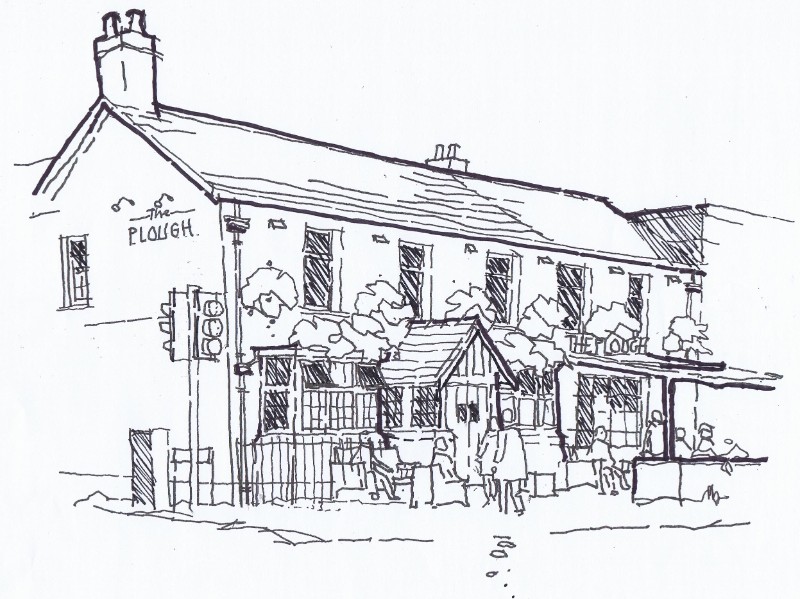 By: Nigel Lewis on 02/02/2023 101 THINGS YOU (PROBABLY) DIDN’T KNOW ABOUT WHITCHURCH 83 OLD WHITCHURCH PLACE NAMES
When you live in a village with over a thousand years of history, and three languages (Welsh, English and Norman French) and probably a bit of Latin too, there must be some scope for an incredibly wide range of local place names
When you then add in the ‘Anglicisation’ and ‘Wenglish’ derivations (not to mention Anglo-Norman influences) we end up with a complete hotchpotch of names
Our village is called/spelled in the earliest written examples as Blancminster and Album Monasterium, both c1266, Witechurch (in the 13th century), Whitchurche in 1376 and Wytchurch in 1385. By 1314 the village was referred as Blackminster (or Blanchminster), and not until John Leland in 1536 as Eglwys Newydd
In various legal and church papers, the local area and farms have an incredible range of names and spellings. Some of the names we know today are hundreds of years old, whilst others are more recent. The Cardiff Records of British History Online are an invaluable resource
Many of the names that we’ve come across have no location, so have been lost in the mist of time. Whilst we can guess some, where do you think the following might be?
1492 Cae-y-Parc (caireparke, 21 acres in the Lordship of Whitchurch) Gardd-y-Crug (Garthcreke, the hillock garden) Tir-Berth-y-Lan (land by the hedge of the hill, 3 acres of demesne land) Tir-Calanmni (the Mayday land), and Tristype (a parcel of land held with the fulling mill)
1536 Eglwys Newydd
1605 Plwca Halog (ancient place of execution) and Heol-Rhiw’r-Cyrph (lane at the slope of the corpses)
1700 Velindre and Y Felindre
1708 Rhiwbinau (the slope of the pine trees) Pant-Mawr (a great hollow)
1712 Pen-Dwyll (Pendowallt, the dark hill)
1731 Rhyd-y-Tywod (the ford of the sand across the River Taff)
1733 Pant-Bach (little hollow, a tenement on the west side of the road to Rhyd-Waedlyd)
1735 Fforest-Isaf (the lower forest), and Cwm-Nofydd (a tenement in or near Whitchurch)
1760 Dwy Erw’r Ysgubor Ddegwin (the two acres opposite the tithe barn) Llyn-Fraith (the motely lake on the River Taff)
1791 ancient farm Rowldon
1811 Philog and Ffilog (a brook and a hamlet near Gwaun-tre-Oda)
1828 Hollybush Inn. Probably took its name from a local tenement Llwyncelyn
1840 Pwll-y-Wenol (the pool of the swallows)
By 1841 and the publication of the Tithe Map we begin to discover where some of these places were. The copy of the map below shows the central part of the parish. Many of the farms and fields are shown with names, many in English, but mostly in Welsh (or phonetically Welsh/Wenglish). Many of these we’d recognise even today, but what about:
WhevecKer (six-acre field?)
Peder Erw (four-acre field?)
Cwm-y-Fwyalchen (dale of the blackbird) and
Nant Gwaedlyd (bloody brook)
Some names are more prosaic, Pumer Heol y Gelli (five-acre field on the track to Gelli Farm?). or family names, Cae Mamgy (Gran’s field). What or who was ‘Croft y Withers’ or ‘Cae Rhyd yr Evel’?
Where was Ynys-y-Ysgallen-Frith (the marsh island of the milkthistle)?
And perhaps the oldest of all local placenames, Treoda, the abode of Oda or Odyn. Described as an ancient messuage (a dwelling house with outbuildings and land assigned to its use) in the village of Whitchurch, immediately north of the remains of Whitchurch Castle (or was it just north of Whitchurch Common. Who knows?)
The joy of discovering all of this just adds to the pleasure and enduring mystery of living in our wonderful village. Do you have any names that you can add to the list, or perhaps you can translate some of the names? We’d love to hear
We’re planning to invite a specialist to the library later in the year, to give us a talk about the old names and the lost places. Look out for the posters, it should be a hoot!
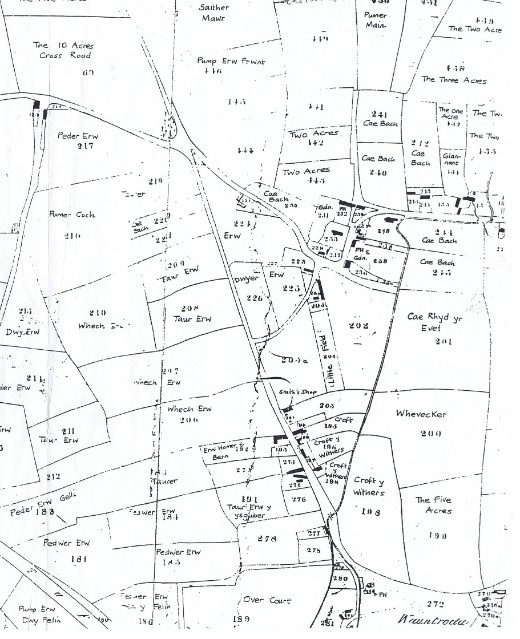 By: Nigel Lewis on 27/01/2023 101 THINGS YOU (PROBABLY) DIDN’T KNOW ABOUT WHITCHURCH 82 PROPER RESPECTS/FUNERALS
Apologies for the mawkish subject of this week’s blog. Not a subject for the fainthearted, but perhaps worthy of asking a few questions
We’re so used to using a local funeral director at the sad time of bereavement that perhaps you’ve never given much thought to what happened in earlier times
In the village, we have churchyards at St Mary’s and Ararat, old St Mary’s graveyard and Pantmawr cemetery. Further afield there is Thornhill and the ancient church at Eglwysilan (but Cathays, a Victorian cemetery, covered Cardiff)
What happened at Tongwynlais, Llandaff North or Rhiwbina? Does anyone know?
We’re so used to fantastic healthcare and palliative care these days (even with the incredible pressures on our NHS), we tend to wear ‘blinkers’ when it comes to end-of-life. It wasn’t so long ago that there were childhood illnesses, infant mortalities, industrial and farming accidents (no health and safety then), and of course heavy smoking, alcohol consumption and the local water quality. Extreme old age seemed to be very unusual for folk in the village
I can remember family stories about ‘the deceased’, grandparents, uncles or aunts being ‘laid out’ in the best room of the house, with family, friends and neighbours wanting to ‘pay their respects’. I’m sure that there are many Whitchurch stories to be told
Who were the funeral directors in the village back then? Ernie Broad talks about Tom Evans and his son Huw, who traded as undertaker and builder. They had workshops behind Barclays Bank in the village. They had 2 black horses and a glass-sided hearse. I wonder where they were kept?
The incredible photograph below from Denise shows DJ Evans & Sons on the Philog just after WW1, with their fleet of motorised and horse-drawn hearses (and their van!); a different age. Were DJ Evans the same family as Tom and his son?
Who was the local coffin maker? Coffins tended to be made from elm, and there were plenty of elm trees in the village and countryside around. We know that the local blacksmiths could turn their hand to many things, so probably the local carpenters would be called upon too
In Pantmawr Road was a large house built in the late 19th century called Llwyncelyn, as the family home of the Mossfords. I wonder if they were the family of monumental masons that started in 1821? We’d love to know
I’m told that, in every village there would be lady (always a lady), who knew how to wash and lay out the deceased, and was always called upon. Who was this in the village, in years gone by?
In the 19th century, old St Mary’s graveyard was becoming very full after hundreds of years, and there were stories in the local newspapers about preventing people who were not ‘local’ being buried there. In fact, there is one story where family from ‘away’ were buried there and grumbling meant that the bishop had to intervene to prevent the graves from being dug up! By the early 1880s, land for a new graveyard had been acquired and opened to relieve the problem
By 1931, the new cemetery at Pantmawr had opened
Today, there are many family graves in the village, most of them full (and sadly many forgotten), although AWEN are fortunate in having some good records donated by Jean. How about having a session sometime at the library, to help locate long-lost family graves and discover some family history?
We had a sculptor, Eli Evans who lived on the common in the 1840s and 50s who carved many of the decorative headstones at old St Mary’s and Ararat. Eli was the man who designed and constructed the Booker family mausoleum. Chris Soughton has given me a photograph of an elaborate headstone at old St Mary’s, where Eli has signed his name in the corner. What an artist!
Ernie Broad tells some hair-raising tales of the local gravediggers between the wars. Does anyone know who they were?
When I was young, respect for the departed was very important in the community. Men would stop in the street and remove their hat when a funeral procession passed. Neighbours would always keep their curtains drawn, and most folk would wear black (widow’s weeds)
I’m told that older traditions at funerals included stopping clocks in the room (to prevent bad luck), covering mirrors (so their soul wouldn’t get trapped in the glass), and even turning family photographs face-down (so that people in them wouldn’t be possessed by the spirit of the dead!). Does anyone have any other sayings or customs?
Was there ever a tradition for holding a funeral wake in the village? Does anyone know? I know that the Ffynnon Wen pub now has a reputation for holding funeral ‘celebrations’ today, but this is probably due to its location opposite the cemetery entrance on Thornhill Road
To finish, AWEN were given some old photographs a few years ago. One was of the interior of a church with an open coffin in the front. The occupant was clearly visible! We were asked if we could identify the church. We’ll keep on looking
If you’ve found this blog a bit hard going, apologies. Next time we’ll consider something a little ‘lighter’ Our Reminiscence Group meets next on 7th February 2pm at the Hub all welcome. 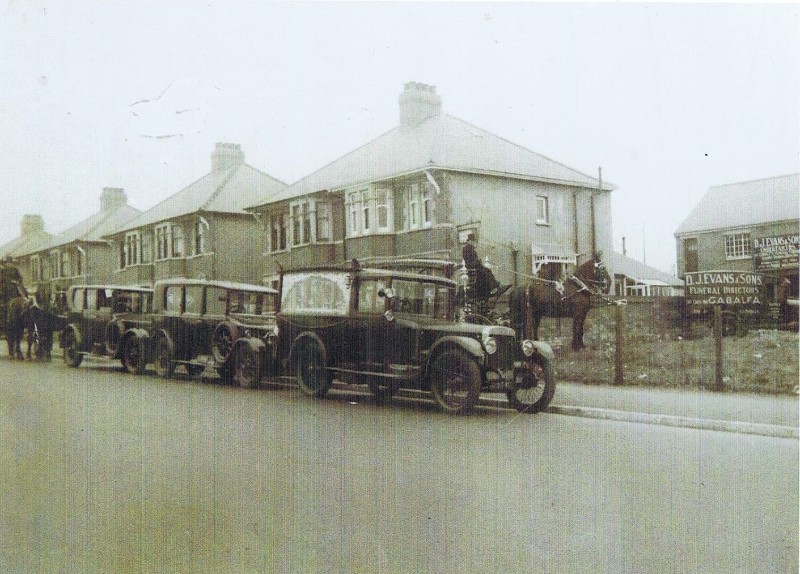 By: Nigel Lewis on 20/01/2023 101 THINGS YOU (PROBABLY) DIDN’T KNOW ABOUT WHITCHURCH 81 THE WOOLLEN MILLS
If you were asked to produce a list of industries in the village over the past couple of hundred years, you’d probably include the tin works at Melingriffith, the College Ironworks behind the Common or perhaps the industries in Llandaff North and Tongwynlais associated with the canal and the railways
How many, I wonder would include the woollen mills in Ty’n-y-Parc Road?
Who even knows there were two woollen factories alongside the stream by the Masons Arms in the 1870s-80s in this corner of the village?
According to the Tithe Map of 1841, there was a small hamlet of houses and cottages along Ty’n y Parc Road and around the stream, Rhyd-Waelyd. There was a detached farmhouse (later to become Ty’n-y-Parc), a farm on the north side of the road (Glanynant) and Elm Cottage on the south side (later Elm Farm). Around these houses were a few small cottages and an early pub
One of the local landowners at the time was John Homphray, who not only owned land at Tyn-y-Parc, but also around Old Church Road and on the main road from the Vicarage southwards. Terry has discovered that John Homphray had married a daughter of the Marquis of Bute’s land agent and by 1846 had acquired the Penllyn Castle estate in Cowbridge. Perhaps that’s where the name Penlline Road comes from
By 1869, the Cardiff Times newspaper reported that John Homphray was said: ‘to have decided upon building a woollen factory on his own land in Whitchurch which, when completed will give employment to 60-80 men, women and children’
Eleven years later, the 1880 OS map shows that the hamlet had expanded with two woollen factories and a row of semi-detached worker’s cottages (probably single-storey) fronting the main road. They were called Tyn-y-Parc Row. Further buildings nearer the stream look more substantial and might have been manager’s houses, offices or stores
The woollen industry in Whitchurch didn’t last long though. By the 1900 OS map, Tyn-y-Parc Row was still there, but the eastern woollen factory had been replaced by cottages. Additional terraced cottages had been built adjacent to Elm Cottage. By 1921, Tyn-y-Parc Row had disappeared and replaced by the 14 terraced houses we see today on the main road. The buildings behind were intriguingly called Tyn-y-Parc Square!
Census information is fascinating too. In 1861, the local population consisted of workers from Melingriffith with a few agricultural workers. And the local pub was called ‘The Swan’. The local cottages were called ‘Queens Square’ and ‘Park Street’; were these local corruptions from ‘Tyn-y-Parc’?
By 1871, the census refers to ‘The Square, Tyn y Park Road’, and the local population were mainly woollen workers; weavers, spinners (and a dress maker). There were still a few mill workers too
There’s a lovely online article by Dave Hilling, listing his own research. He tells that the two factories produced flannel, a soft woven fabric. He believes that the western factory (close to where the Masons Arms is now) was the first; it could have been converted from farm buildings, followed by the eastern factory built c1860
By the end of the century, the eastern factory had finished and had been converted into six small cottages, each with a long rear garden with an outside privy at the end. The cottages are still there today as Upper Tyn-y-Parc Terrace. Dave Hilling and his wife lived there in the early 2000s
It’s hard to understand the layout of the area in 1880s, as so little now remains. The wonderful photograph of 1911 from Edgar Chappell’s book shows the view eastwards along Ty’n-y-Parc Road. Today you’d be queuing to turn into the Tesco Garage!
Is the Masons Arms a survivor of that time? The Rhyd-Waelyd brook from the photograph has been re-routed, and Manor Way confuses everything. Glanynant Farm is now the site of the Toby Carvery, with Elm Cottage replaced by the Tesco Garage. Even Tyn-y-Parc (home of Antonio de Lucovich and later the Cory’s) is no more
What happened to the families of woollen weavers and spinners; the Powell’s, the Wilde’s or the Morgan’s? Even Philip Norton with his 2 children and 5 step-children? Did they move away, or did they simply change employment more suited to the changing times?
Are you part of one of these families? Or, does anyone have any information to help grow the lost history of this part of our village?
We’d love to hear from you 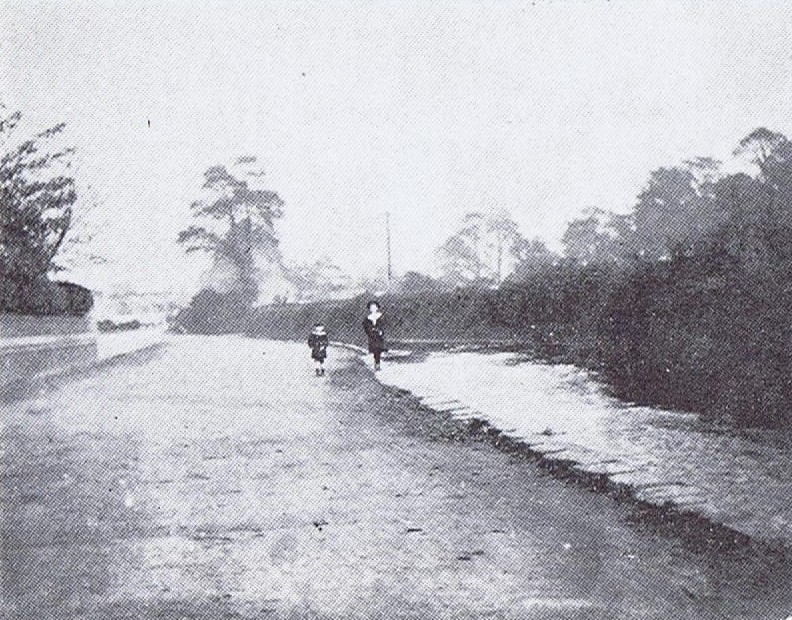 By: Nigel Lewis on 13/01/2023 101 THINGS YOU (PROBABLY) DIDN’T KNOW ABOUT WHITCHURCH 80 CHATEAUNEUF DE TONGWYNLAIS
We’ve got a grapevine in the garden. It was planted over 30 years ago, and it has been terribly neglected and is looking very gnarled
In spite of this, in recent years we get an incredible crop of grapes every autumn (I put it down to neglect and global warming!). The grapes are large and sweet, but I’ve never made wine though
During one of our (many) Covid walks over the past few years we discovered a ‘proper’ vineyard around Gelynis, stretching up towards Tongwynlais. At the time, we put this unusual land use down again to climate change
How amazing is it then, to find that the Marquis of Bute had the same idea over 150 years earlier
Having rebuilt and restored Castell Coch, the Marquis decided to plant vines on the south-facing fields just below the castle (is this where the golf course is now?) to produce wine
There is a terrific report in the Cardiff Naturalists Society Report of 1926 documenting all of this. The report was written by AA Pettigrew whose father had been head gardener for Lord Bute
Back in 1875, the Marquis was hoping that his new vineyard would produce a ‘hock-type’ wine, and a magazine at the time suggested that ‘Lord Bute had a Bute-iful vineyard at Castell Coch’
By 1892, the grape harvest produced ‘luscious golden wine’ which ‘resembled a first-class still champagne’, according to some expert commentators. The wine went on sale commercially both in Cardiff and London, and a dozen bottles could be bought for sixty shillings!
In the Cardiff Naturalists report there were some illustrations, and attached below is an example of the bottle label of the time. There’s also an illustration of the harvesting of the grapes (which were taken by horse and cart to Cardiff Castle for crushing, wine production and bottling)
Alas, the quality of the Castell Coch wine differed from year to year. Nonetheless, the Marquis persevered. He opened other vineyards in Swanbridge and Cowbridge to increase his yield
Sales of the wine never amounted to much though. The best they could muster was ‘eminently honest and wholesome wine’. Damned by faint praise perhaps!
This didn’t deter the Marquis though, and he continued winemaking for the next 45 years. Vintages varied enormously with only 7 years of sufficient sunshine and warmth to achieve full ripening and good flavour. He finally gave up in 1920 when the Castell Coch vines were uprooted and the land’ thrown up to other uses’
Perhaps the observation by Punch magazine in 1875 was damningly prescient: ‘If ever wine was made from the vineyard, it would take 4 men to drink it – two to hold the victim and one to pour it down his throat!’
Perhaps the good folk at Gelynis will have better luck, although I don’t think I’ll bother making any Chateauneuf-de-Eglwys Newydd any time soon
Does anyone else have any stories about Lord Bute’s vineyard, or even a bottle or two stashed away in their cellar? What about your own attempts at winemaking? We’d love to hear, and to add to our village history. There will be a talk at the Hub on Mr Pettigrew, Cardiff’s gardener on Wednesday 22nd March 2.15pm. 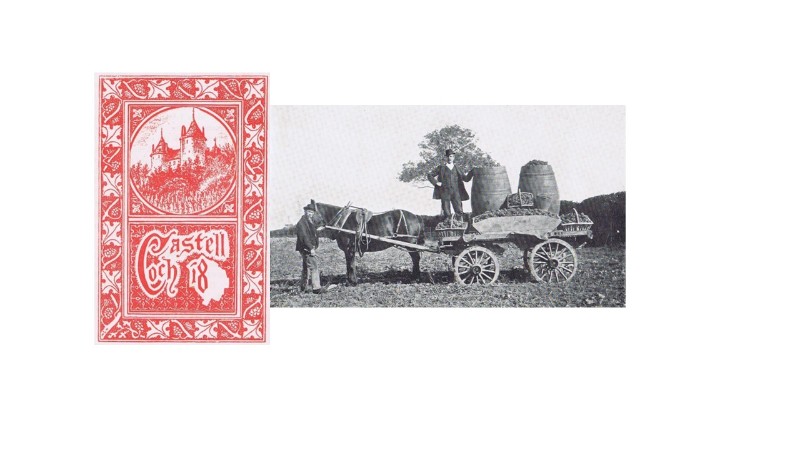 By: Nigel Lewis on 06/01/2023 101 THINGS YOU (PROBABLY) DIDN’T KNOW ABOUT WHITCHURCH Another Little Extra
I think we need something a bit special to cheer us all up for the New Year, so how about a love story or two!
Just before Christmas (blog 77) we looked at how Whitchurch Hospital fared during two world wars the people who worked there and the damaged soldiers who were billeted in the hospital. As usual, we had a terrific response, thank you
Joy responded with a lovely family story about her grandfather (who hailed from Suffolk) who was a patient in Whitchurch during WW1. There he met with his future wife who was volunteering at the hospital at the time. They fell in love and he married her after leaving hospital. Sweetly, Joy tells us that he did not return to Suffolk, but instead they settled in Llandaff North. If you’d like to share more on their story Joy, we’d love to hear
Wonderful Gwawr, of Friends of Whitchurch Hospital, provided so much information before Christmas that we couldn’t include anything like enough, but she did share the lovely story of Florence Raynes
Florence was Matron at Whitchurch before WW1, and continued in her extremely challenging role during the turbulent war years. She must have been a really indomitable person to run the nursing staff and manage the influx of damaged soldiers arriving every day
As I write this, I can almost conjure up a picture of our Whitchurch Matron as Hattie Jacques in uniform in her ‘Carry On’ matron roles! I’m sure she wasn’t as stern though!
The photograph below (courtesy of Gwawr) shows Florence on Ward 1A early in WW1, with the room bedecked with home-made Christmas decorations in a very formal setting with staff, nurses and patients in their beds (Florence is seated centrally, resplendent in her uniform). I wonder who all the others were?
During the conflict, Florence met a wounded soldier under her care (sorry, I don’t know his name) and they became friendly. Romance blossomed and they married!
However, as was typical of that time, Florence was obliged to resign from her position on marriage, and sadly left the hospital. She and her new husband moved away and set up home in Sheffield
Does anyone know more about Matron Florence and her wounded soldier patient? And, what happened to them. I’d like to think that they lived happily ever after (well, it is a love story after all!)
If anyone else has a story of Whitchurch Hospital during either of the wars that they’d like to share, please let us know. It’s such an important part of our village history. Don’t forget to pick up your free walk booklets and maps from the HUB, covering Old Church Road, the Philog and the Memorial walk all part of our Walking Whitchurch Heritage Project funded by the Heritage Lottery and Cadw 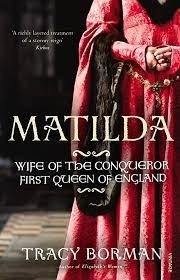 By: Nigel Lewis on 30/12/2022 101 THINGS YOU (PROBABLY) DIDN’T KNOW ABOUT WHITCHURCH 79 THE FARMS OF WHITCHURCH 3
This is the third part of the farm story. The first two seemed very popular with lots of comments and feedback, so this time we’ll look at the farms on the west side of the old Merthyr Road. You might like to contemplate the old farms whilst you enjoy your New-Year celebratory cornflakes
WEST OF THE TURNPIKE (starting from the north):
Llwyn Mallt (Maud’s Bush Farm) This was the most northerly of the farms, sadly now long gone and swallowed up within the roundabout and intersection of the M4/A470. However, there are a few old photographs showing the farm and yard. Back in 1841, the farmer was William Williams, and John Harbottle as farmer in 1897
Ty Clyd (Sheltered House) This is another ancient farm, and was located alongside the old tithe barn. In 1841, the tenant was Thomas David, and was owned by TWB Booker. The fields abutted the old Merthyr Road and northwards towards Llwyn Mallt. A newspaper article from 1855 describes how the farm ducks were stolen one night; simply walked off by the burglars!
Ty Clyd was purchased for the Cardiff Asylum development, and the farmhouse and yard were demolished and rebuilt for modern farm use by the patients. The remains of this rebuilt farm still exist just north of the City Hospice
Forest Farm Denise tells us of her family (the Browns) who farmed Forest Farm from 1829. John Brown, was born in Scotland in 1779 and moved to south Wales as a young man and worked for Benjamin Hall MP. He moved with his wife to Forest Farm on Benjamin Hall’s death. Successive generations of Browns farmed the 200 acres, until 1878. The last will and testament of Mary Brown, John’s wife, is fantastic (made just the day before she died) and lists not just her chattels, but the farm items too, including cart horses, fillies, lambs, pigs, cows, hay, wheat, barley, turnip slicer, potatoes, carts, rollers and much more
Later, the Jones’ sisters lived on the farm and opened a shop in the village selling all sorts of dairy products from the farm. It’s not long ago that the shop closed and became a trendy wine bar (currently closed, perhaps a victim of Covid or austerity)
Forest Farm is now the centre for the country park, and whilst the farmhouse has been renovated, many of the outbuildings are in a poor state of repair
Ernie Broad tells scurrilous tales of raiding bird’s nests on the farm when he was a boy, and also helping with building works when he was older. He also remembers Forest Hall, the house adjacent to the farm, which was tenanted by Spence Thomas who was Manager of the Melingriffith Tinplate works long after the Bookers. Forest Hall was always flooding and things became so bad that it was demolished. It is now a public car park
Ty Mawr (Great House) Farm The old farmhouse, whilst much altered, still remains. It is recognised as the oldest surviving house in Glamorganshire. It had a carved date over the fireplace mantle of 1583 and is listed Grade 2 by CADW. The photograph below shows the house
The farm fields ran down to the River Taff, but were separated from the farmhouse when the Glamorganshire Canal was constructed. The remaining fields were again separated when the railway line was built a little later
Ernie Broad knew the family who lived there in the early part of the 20th century and tells a wonderful story of a ghost in the old house with a lion’s roar!
Cornel y Waun Ernie Broad refers to this as the Waun Farm and describes its location adjacent to the stream. Ernie notes that the farmyard had three large barns and fields which ran down as far as the railway on College Road. The Phillips family ran the farm for many years and subsequently by William Davies. Ernie recounts the disaster of foot-and-mouth disease on the farm
The old farmyard is long gone and is now occupied by Whitchurch Builders Merchants
The current Cornel-y-Waun (no longer a farm) is a very smart house on the east bank of the stream. There is some controversy, but it is possible that an earlier farmhouse existed on the west bank which would have been of much earlier age. There are photographs dated 1892, which show thatched roofed cottages on the west bank; perhaps they were part of the original farm buildings. The Tithe Map gives tantalising clues too. Does anyone know?
Waun Treoda/Flays Farm Sometimes referred to as Gwauntreoda Isaf or Court Farm. In the 1840s William Vachell tenanted all of this farm with fields on both sides of the turnpike road. He built a grand house for himself opposite, called Bryn Gas, now long gone and replaced with a block of flats. In 1841, the farm tenant was Evan Griffiths, but there’s also a reference to a Frederick Blurs. Does anyone have any information?
In latter times, the farm was tenanted by the Flay family. Their fields ran down to the parish boundary near to Manor Way. As well as farmers, the Flays were given the contract to collect the rubbish from local houses (using a cart pulled by shire horses), with the rubbish dumped in the quarry which is now Maindy Stadium. The Flays also ran their removals business from the farm
All trace of the farm is now gone, apart from a sole survivor on the common, near the bus stop. Would this have been a store or workshop of some kind?
Gelli Farm This is a bit of a black hole. Was this farm, in Llandaff North, located where the Royal Exchange pub is now? Does anyone know of the history and extent of Gelli farm? We’d love to know
College Road/Lock Farm This too is a bit of an enigma. Ernie Broad tells us that it was located at the end of College Road near the canal lock. There was a barn at the beginning of the farm road, and the fields reached as far as Gabalfa Lock on the canal. Ernie notes that a field nearby was used by Llandaff North Rugby Club some time in the past. Can anyone help with any more information?
Other Farms There is reference made to an even more ancient farm on this west side of the turnpike, Rowldon. On a map of 1760 a farm by this name is noted. Is this a candidate for yet more exploration? Does anyone have any clues?
A piece of trivia for you. Big Ben (in Westminster) was apparently named after Benjamin Hall MP (see Forest Farm above)
And; have a Happy New Year!
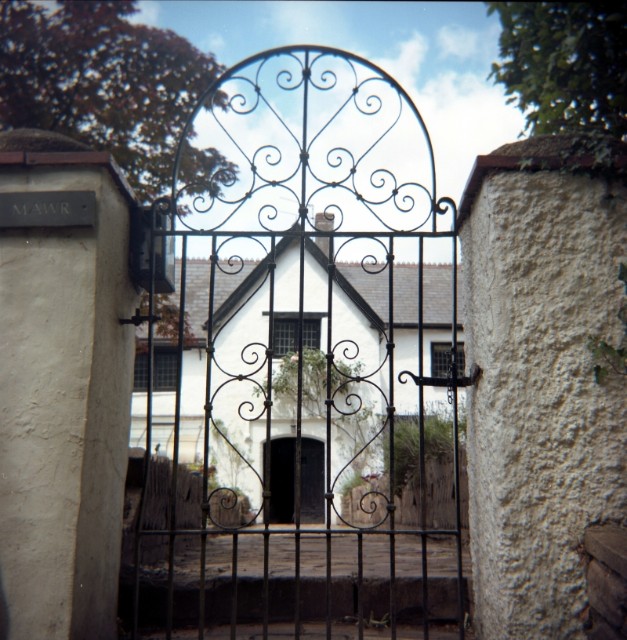 By: Nigel Lewis on 23/12/2022 101 THINGS YOU (PROBABLY) DIDN’T KNOW ABOUT WHITCHURCH 78 CHARACTERS OF WHITCHURCH 1
A special Christmas edition of ‘101 Things’
By now we’ve all put up our decorations, decorated the tree and written our letter to Santa (or Sion Corn) saying how good we’ve all been during this last year
By any stretch of the imagination, this has been quite a momentous year, with any number of national and international personalities and characters, seemingly popping up most days in our newspapers and on TV. These people (some quite unforgettable others very forgettable) may linger long in the memory. But what about locally? What about the characters of our village?
How do you even define a local character (I’m guessing it’s a person not the place)? Is it a person who would recognise you in the most unlikely of circumstances and have a lovely chat? Someone, perhaps unassuming, who has (or had) a claim-to-fame for a special reason?
How would one even compile a list of characters? I concluded that it’s probably dangerous to list living people in this blog, so I’ve decided to restrict the list posthumously
It’s relatively straightforward within living memory, but then we have to rely on memories of people and notes. Even earlier, local folk hardly get a mention, it’s only the great and good(?) who are recorded. Here’s a list of local characters who I think might meet the shortlist, and in no apparent order. What do you think?
Henry Hopkins (b 1842) Henry worked for his uncle Eli (the sculptor) and was the son of a butcher. By 1867 he was the Relieving Officer for the parish (doling out the parish relief) and had married Mary Wride, the daughter of a local farmer. He became the Registrar of Births and Deaths (even completing the forms for the infant deaths of some of his own children) and was later a local councillor. Philog House, where he lived, is still called ‘Hopkins Corner’ by many local folk
John Povey We don’t know much about John apart from Census information from the 1860s, when he moved to the village. We know that he lived on the Philog and ran a market garden with his extended family helping He must have become a local character, as in 1904 the parish council referred to his house as ‘Old Povey’s House’ when proposing to change the names of local streets
Winston Griffiths Winston lived off Pantbach Road, and was a salesman. He became a local councillor and represented Whitchurch for many years. In the 1970s and 80s Winston was instrumental in setting up the Whitchurch Festival (still going), and organising the annual Father Christmas float, driving around all parts of the village and handing out tangerines to the children. A real local character
Ernie Broad Ernie lived in the heart of the village, almost opposite Tabernacle Chapel. There are tantalising photos of Ernie as a child, but we’ve all got to know him through his wonderful jottings about village life in the earlier years of the 20th century. To my mind, Ernie is not just a local character but is the unabashed ‘Sage of Whitchurch’
Billy (and his memorial bench) Billy was one of the ‘lost souls’ who wandered around the village in the 1970s and 80s, always ready for a chat, and always had a pencil or two to hand out to anyone who needed one. The local shops took Billy into their hearts, and on learning of his demise, fundraised enough money for a memorial bench
Trevor Ford (football legend of the 1950s and 60s) Ceri Stennett tells me that Trevor and Ceri’s dad Stan were great friends. When Trevor looked to retirement after a lifetime in professional football in the 1960s, Trevor took to managing a car garage. First in Llandaff North at the Tivoli Garage and then at the Roundabout Garage on Manor Way
Billy Brian (trick cyclist) I’ve included Billy and also Steve (the yoyo champion) as ‘proper’ local characters. We know next to nothing of them, and in spite of their unusual sporting prowess, they’ll live on local folklore!
Albert Bullock The only pictures I’ve seen of Albert Bullock were when he was complete with a top hat and a wing collar shirt, so I really couldn’t call him by his first name. I can’t imagine him as an Al or Bert so the best I can do is call him AB! He was chairman of the parish council and was so instrumental in achieving our Carnegie Library. I’d like to think that he was a real character in the smoke-filled rooms of the parish council though! The attached photograph from 1903 (AB is far left with umbrella) shows the members of the Whitchurch School Board. Just the thing for a Christmas Card!
River Jordan I’ve included this man only because of his name. He lived in the lower village in the late 19th century, but we know nothing more. Can anyone help?
Charles Burley Ward No list of characters would be complete with our local hero (who wasn’t local at all!). CBW was the last man to receive the VC from Queen Victoria, and he’s buried in our local churchyard
Count Antonio Lucovich How can any list of local characters not include an Adriatic Count who lived in the village, rode with the local hunt and sported the most splendid beard I’ve come across so far!
Herbert Cory I’ve included Sir Herbert because my friend George remembered this man walking every day from his house at Coryton past the Hollybush pub to catch a train to his office in the docks in the 1920s. George remembered his demeanour, bowler hat and gold watch chain. An obvious candidate
Who have I left out? What names ought to be added to the list?
I’ve deliberately not included lots of the names of noteworthy or prominent people (both famous and infamous) who’ve lived in or had an influence on the village, because that’s for another list!
I’m sure we all know of a local character either by personal knowledge or a family story. If you’d like to share (as long as the stories are not too libellous) we’d love to hear and add to our village story 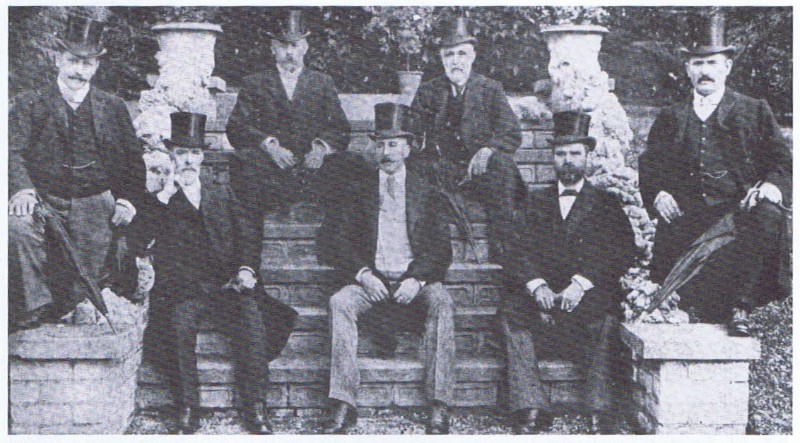 By: Nigel Lewis on 15/12/2022 101 THINGS YOU (PROBABLY) DIDN’T KNOW ABOUT WHITCHURCH 77 WHITCHURCH HOSPITAL (THE WAR YEARS)
We pick up from last time and our blog number 52. Whitchurch Hospital (the Cardiff Asylum) had opened in 1908 with space for 750 patients and 150 staff, all within landscaped grounds with its own farm
The far-sighted Edwin Goodhall was the first Medical Superintendent
Only 6 years after the hospital opened, everything changed with the outbreak of WW1. The hospital was taken over by the military as the Welsh Metropolitan War Hospital, and many of the patients had to be evacuated elsewhere. However, some stayed, to continue working on the farm
Edwin remained in charge, but he was given the rank of Lieutenant Colonel, with other doctors and male nurses given military rank. Gwawr tells us that as more of the male nurses were conscripted, the female nurses took over many more of the duties, including caring for male patients (which was most unusual at that time)
It wasn’t long before injured soldiers began arriving in Whitchurch, many from the trenches of France and Belgium. Hospital trains began arriving at Coryton Station with horse-drawn ambulances ferrying the injured men to the hospital adjacent. Edwin Goodhall tried hard to persuade the authorities to extend the railway line into the hospital, but this never happened
Whitchurch became an orthopaedic war hospital dealing with broken bodies, as well as those with mental issues
Ernie Broad, our local sage recalls: ‘As a boy at the time of the Great War, the station was a gathering place after school. One of my friends and I used to watch the ambulance trains coming in, carrying the wounded soldiers from the front line. These casualties were then taken by ambulances to Whitchurch Hospital, which was made part of a military hospital at that time. When these boys were on the mend some would stroll about the village, and we boys would be told lurid tales about the fighting in the frontline. One chap by the name of Joe Simpson was shell-shocked, this being an injury to the mind caused by constant shelling by big guns. He stayed with us at our home for a few months. He was one of the lucky ones, and was eventually able to return home to Birmingham, and resume his work at the glass factory’
Like Joe, many of the soldiers were crippled by ‘shell shock’ and Edwin and his medical team began new therapies to help. Nowadays, this would have been diagnosed as PTSD
There’s a photograph in Steve Nicholas’ book showing the Old Oak Tearoom, on Pendywallt Road. It was sited opposite the main entrance to the hospital and is now Blandthorn Court, a modern block of flats. I’ve often wondered how such a tearoom could survive so far away from the village. Then, when you realise how many families of patients might have visited the hospital over the years, it would have been a godsend; a walk just outside the grounds for a cup of tea with their loved one just to break the monotony. Visiting in Whitchurch was only allowed twice-a-week, and only then in special visiting rooms!
We’ve been privileged to read some autograph books of local girls helping at Whitchurch. Many are really innocent and playful, but later there are entries with more poignant stories from ‘a soldier injured at Gallipoli’ and others. We’ve included a page for you to see showing the innocence of 1910, and just 6 years later from Private Kelvie of the Royal Scots Fusiliers and the horror of the trenches
Whitchurch continued as a military hospital until 1919, when it reverted to its previous use; and all of the former patients returned from their enforced stays elsewhere. Edwin remained as Medical Superintendent for another 10 years; I wonder did he keep his military rank?
During all this time, many of the nursing staff lived on site, and until the 1930s often worked 60-hour weeks. Their social and private lives were strictly governed. Does anyone have family memories of the staff at that time?
After Edwin, Peter Knight McCowan became the new Superintendent, and then in 1937 Dr Thomas Hennelly from Ireland took over
Then, just twenty years after the end of WW1, everything fell apart again. At the start of WW2, the hospital was once again taken over by the military, this time as the ‘Whitchurch Emergency Hospital (becoming the largest emergency services hospital in South Wales). Who would have believed that in such a short period of time, the staff would have to re-introduce their methods of dealing with ‘broken’ soldiers again. This time, not just British, Allied and American soldiers, but wounded German prisoners too
We’re told that during WW2, about 20 of the original hospital beds were retained for civilian use with the remaining patients transferred again
So much upheaval!
Then in 1948, the hospital was taken over by the Ministry of Health, when the NHS was formed
A personal note to end; my own dad was injured early in WW2 with a head wound, and ended up in Whitchurch Hospital. He was later discharged, but for years after he returned for therapy. One of my most treasured possessions is a tiny woven purse made by my dad as part of his therapy whilst there
Does anyone else have stories or memories of the hospital during wartime? We’d love to hear
We’ll conclude next time with what’s happened since
Thanks to Janet for the autograph books and to Gwawr and the Friends of Whitchurch Hospital for so much information, and for all of their sterling work over the years. Don’t forget you can catch up with all the 101 Things on the AWEN@thelibrary website https://www.awenthelibrary.cymru/index.php?page=memories 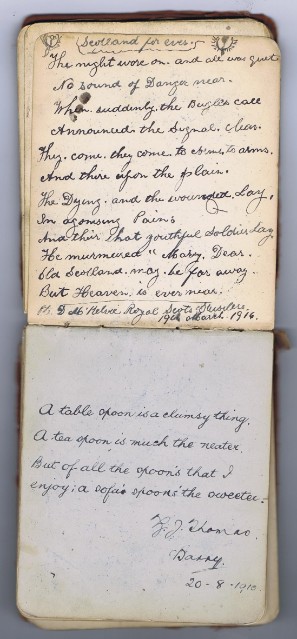 By: Nigel Lewis on 09/12/2022 101 THINGS YOU (PROBABLY) DIDN’T KNOW ABOUT WHITCHURCH
76 14th DECEMBER 1904: THE OPENING OF THE FREE LIBRARY
We’re over threequarters of the way through these blogs, and I’ve realised that no mention has been made yet to the library (sorry Hub!). So, as today is the 9th of December, it’s the nearest in date to the official opening of The Library
Whitchurch is not over-blessed with civic buildings, so we should take great joy in the fact that we still have a splendid ‘Free Library’ in our midst. There was some worry some years ago that Cardiff Council were looking to close the library (in fact all of the libraries in north Cardiff), but thanks to the effort and determination of local folk, together with our MS and MP, not only do we still have our library, but one that has been refurbished and extended. It is now a delightful (and warm) place to visit and linger. The fact that it is also the local repository for books, reference and digital exploration mustn’t be forgotten. There are folk in AWEN who have worked tirelessly in campaigning to save and now develop the facility to whom we should all be incredibly grateful!
Anyway, back to the story: By 1902, Whitchurch Parish Council had written to Andrew Carnegie (at the time, the richest man in the world) asking that he fund a free library for the village, and to subsequently discover that he was willing. He had agreed to provide the whole budget of £2,000 to build the library, provided that a free site could be found. After much searching, a corner of the new Recreation Ground was found to be the only contender
Plans were drawn up, and tenders invited. The Library Committee of the parish council reported that the accommodation would comprise of: A Reading Room, a Lending Department and a Librarians Room. On the first floor would be a Kitchen and 2 Bedrooms for a Caretaker. There would be two entrances to the Library, with one being reserved for ladies. The Reading Room would have a folding partition, 15 newspaper stands and tables for magazines. The Library would have seating for 64 readers, and bookcases in the lending department would store 6,000 volumes
It would be interesting to compare those facilities with the new library!
By February 1904 building tenders had been returned. However, some bargaining was required as the lowest tender, from builders WT Morgan was slightly in excess of the Carnegie budget. Finally, a scheme was agreed and work commenced. By the end of the year, the Library was completed and plans were made for an official opening
The old photograph below must have been taken shortly after completion, as the Library is surrounded by an old hedge and the gates are wooden. Another photograph only a few years later shows the Library with smart iron railings and gated entrance
By then, the Library had managed to acquire 1,000 books, but an appeal had been launched locally for more to fill up the shelves
The official opening on 14th December 1904 seemed to be a grand affair for the village. Andrew Carnegie had been invited, but his agent explained that he was detained on affairs in America. A procession was held from the council school (the old Boys School at a far end of Ty’n-y-Pwll Road to the new Library, setting off just before three o’clock. Leading the procession were the members of the volunteer Fire Brigade in their uniforms and brass helmets, with the Whitchurch Brass Band following, immediately succeeded by the members of the parish council
At the Library, Mr Edmund Lewis, the chairman of the council called upon Mr Sidney Williams, the architect of the Library, to present to Mr Albert Bullock, chairman of the Library Committee a silver key on behalf of the architects and contractor, for a ceremonial door opening. This key is still at the library in its original velvet plush case and can be seen by special request!
The Weekly Mail newspaper a few days later reported: The main room was filled with 300 local people who listened to speeches by the local dignitaries. The chairman proposed that as the building had been given by Mr Carnegie, it would be fitting if they had an American tune, and he called upon the band to play ‘The Stars and Stripes’ which was stirringly rendered. The Rev Ll Davies led the company in prayer, and Mr Bullock gave a history of the movement which had resulted in Whitchurch attaining possession of a free library. Mr SH Jones, in proposing a vote of thanks to Mr Bullock for his services, spoke of the utility of the free libraries’. Mr Bullock replied and the proceedings then terminated
All of this bonhomie didn’t last however, as the Library experienced teething problems, with an intermittent heating system, resulting in a small fire! Accusations of scrimping on the specification and construction and blame were passed back to the architect and contractor. This would never happen these days, would it!
Anyway, 118 years later, we still have our wonderful library in its parkland setting. It’s worth noting that our Grade-2 listed library is included in John Newman’s book, The Buildings of Glamorgan, where he describes the Library as: Set boldly across the corner with Velindre Road, small but thumpingly Jacobean!
The library is a real gem, possibly the best building in the village, but with its recent refurbishment and technological development for the 21st century, we should all enjoy it
Long may it last! Join AWEN at the HUB on Saturday 17th December at 3pm for a festive singalong with Melingriffith Brass Band.  By: Nigel Lewis on 01/12/2022 101 THINGS YOU (PROBABLY) DIDN’T KNOW ABOUT WHITCHURCH 75 HORTICULTURAL SHOWS
Where was ‘The Square’ in Whitchurch? And when did we have horticultural shows?
The answer to the first question is the land in front of the Three Elms Public House. I hear you cry ‘there’s no square, it’s just a thoroughfare’, and you’d be right. However, up until the First World War the pub, which was a much older structure, was set at an angle to the main road, with the land in front making an informal triangular ‘square’
And what about the second question? Well, we need to go back into the first half of the 19th century and the largesse of Thomas William Booker Blakemore MP, owner of the Melingriffith Tinplate Works
When TWBB inherited the works and also Velindre House from his uncle in the early 1800s, he became fabulously wealthy. He wanted to expand the works and consequently grow his own wealth. This he did, and by adding new mills and increasing capacity, and bringing in new workers. He built terraced cottages for them alongside the works. He also filled all the spare old buildings on the site with his new workers (but that’s a tale for yet another time!), and many families lived 2 or even 3 to each house
Business was booming and his growing workforce of hundreds were earning wages they probably hadn’t known before
But TWBB also wanted to ensure that his workers were looked after (in the context of early Victorian standards). He made sure that his workers had access to rudimentary healthcare, he introduced a savings scheme and also a (sort of) pension for those workers who lived to retirement age. He also ensured that all of the new cottages built had gardens so that the worker families could grow vegetables to supplement their diet
This was being done at the same time as he was transforming Velindre House from a magnificent luxury property to a fabulous pleasure palace (at least in Whitchurch standards!) within extensive gardens and grounds
To look after his growing family, TWBB had a small army of servants. And to look after his gardens and grounds he employed a head gardener, who lived in a house near to the stables, and probably another small army of gardeners and boys who would grow his vegetables, fruit and exotics in his glasshouses (and of course cutting the lawns by hand!)
To encourage his workers in their leisure time (did they have much?) he wanted them to compete in their own cottage garden efforts. He did this by holding bi-annual horticultural shows at The Square. He also encouraged the local villagers to take part too
We’ve been given a copy of a newspaper advertisement for the show in September 1846 by Darren, and this is copied below. The Wauntreoda Floral and Horticultural Show was obviously a grand affair with buses running between Cardiff and Whitchurch throughout the day. The landlord of the Three Elms obviously didn’t want to miss out on the opportunity of extra business either. I wonder what his fare was like for two and sixpence?
There are numerous newspaper reports of these shows, and they became incredibly popular. One dated 21st June 1845 reported that ‘The Melingriffith Floral & Horticultural Show, under the patronage of TW Booker Esq was held in the square in front of the Three Elms’
There were all sorts of categories in each show not only for vegetables but for flowers too. We don’t know too much about the humble workers who won various prizes over the years, but the newspapers made great reference to the head gardener at Velindre, who won numerous prizes each year. Well, if you’re going to hold a horticultural show and present prizes, it’s only natural that you’d want to win most of them yourself!
After TWWB died in 1858 there is very little report of his shows, so probably, the whole idea died with him. Although, by March 1862 (after the death of TWWB) the Cardiff Times reported Gwauntreoda Eisteddfod It is a source of great pleasure to the committee to find that the forthcoming meeting has been met with such a warm reception by the public generally; and no doubt many of the Cardiffians as well as the inhabitants of the suburbs of Cardiff, will find far more edifying and amusing than the Llandaff Fair
Does anyone know anything about later Eisteddfodau in Whitchurch? We’d love to hear from you
Nonetheless, the Whitchurch Horticultural Shows sound as though they were incredible spectacles whilst they lasted
The sketch below shows what the Three Elms might have looked like in 1892. I know this is years after the horticultural shows finished, but it still gives a flavour of how rural our village was, not so long ago. This sketch is one of a series used on our ‘Philog Experience’ walk back in the autumn
Is there any enthusiasm for reinstating the horticultural shows? What do you think? But probably not in ‘The Square’ as the traffic would win every time! Don’t forget our final Reminiscence Group this year is at the HUB on Tuesday 6th December at 2pm, all welcome.  By: Nigel Lewis on 25/11/2022 101 THINGS YOU (PROBABLY) DIDN’T KNOW ABOUT WHITCHURCH 74 ROBIN GOCH
Yet another story of a local man with an incredible story
Has anyone heard of Charles Horace Watkins? I hadn’t until a week ago, when Derek from Pontypridd told me a little about him and his connection with Whitchurch
Charles Horace Watkins was born on Mynachdy Farm, just south of the parish boundary in 1887 and was an inventor. He used one of the barns on the family farm to carry out his experiments and to make all sorts of fantastic equipment
In the very early 1900s (when he was just in his teens) he started experimenting with the idea of powered flight. From the basic principles of a lighter-than-air-machine Charles started to design and assemble an aeroplane. Remember this was before anyone had conquered powered flight
He built a monoplane with an open wooden structure with piano wire as straining wires. The engine was home-made and had a wooden propellor at the front. The bodywork was painted bright red so he called it Robin Goch (Robin Redbreast)
If this sounds far-fetched, it gets even weirder. The seat of the plane was a chair from the farm kitchen, and he proposed to navigate using an egg-timer! He even arranged 2 lengths of weighted string to dangle from underneath to warn himself of how close to land he was coming, to achieve a safe landing. Can you believe this?
The Wright Brothers had managed to achieve a maiden flight in America by 1903, but that was in an incredible spider’s web of a plane with skis underneath and managed a few extended ‘hops’
By 1908, Charles had completed his monoplane and (according to Derek) he took off from Whitchurch Common, flew around Whitchurch for a bit and then landed safely. There is no verification of this, although there are newspaper reports of the time of him flying around Whitchurch, as far as Caerphilly Mountain and then back again. If this is all true, then Charles Horace Watkins would be the first aviator in Wales! Apparently, he even went on to be the first aviator ever to land at night
If only we could prove this it would make an incredible local story. But incredibly, it is true! Charles offered his designs to the government at the time (this was pre-WW1 of course)
The black and white photograph below shows a young Charles standing outside the barn at Mynachdy with Robin Goch. After a few years, the aeroplane suffered a cracked engine block and Charles wasn’t able to repair it. So, the Robin Goch was ‘grounded’, back at the barn
Charles survived both WW1 and WW2, and in 1959, started to build a replica of Robin Goch (some reports say the aeroplane was restored not rebuilt). RAF specialists were sufficiently intrigued and asked if Robin Goch could be an exhibit at their new museum at St Athan. He agreed and it was on display there for many years
And then what? Well, Charles died in 1976, somewhat in obscurity, but he had been continuing with his inventions all the time. He told some young neighbours about an early RADAR device that he had sold to the Americans (apparently the British authorities wanted to turn it into a secret and so avoid paying him). In late life he still had a shed full of unfinished experiments, such as a laser beam which could ‘burn’ through solid walls and also a rudimentary flying saucer!
What an incredible man!
But what about Robin Goch you might ask?
Well, the replica was transferred to the Swansea Industrial Museum when it opened in the early 2000s, and it is now the most admired of all of their displays. Countless small children vote for the Robin Goch as the ‘best’ item in the museum still. It is suspended from wires high above the other displays in the main hall. The second (coloured) photograph shows Robin Goch on display ‘soaring’ above the other exhibits at Swansea
So, why don’t we know more about this special man, born just south of the village and flying his home-made monoplane from the common? I can’t believe that boys and girls in our local schools don’t know more about this incredible man. What do you think?
PS if you’re wondering how Charles used an egg-timer to navigate, it’s quite simple. Once flying, he’d set the egg-timer on the dashboard and fly straight until the sand ran out. He’d then turn the plane through ninety degrees and reset the egg-timer. Two more goes and he’d be back where he started from!
Thanks to Amgueddfa Cymru for the photographs (just to prove it’s all true!) don't forget to pick up your Walking Whitchurch Heritage Booklets from the Hub. 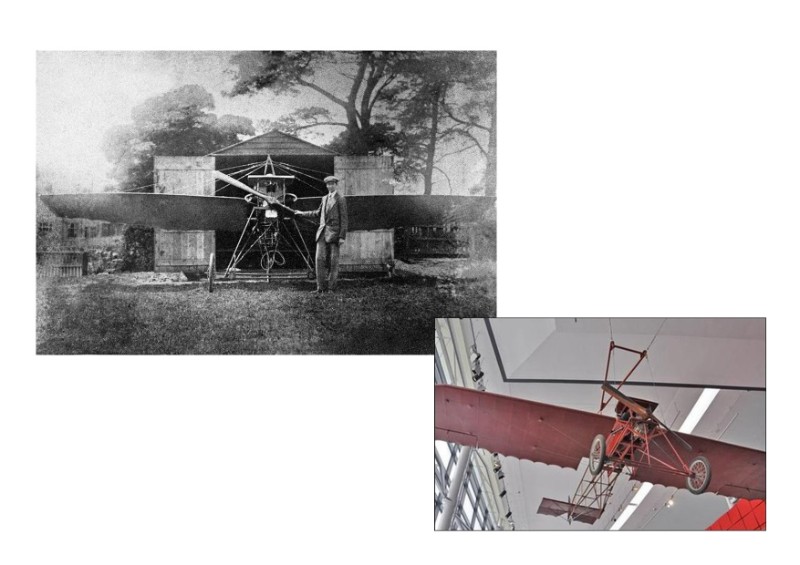 By: Nigel Lewis on 18/11/2022 101 THINGS YOU (PROBABLY) DIDN’T KNOW ABOUT WHITCHURCH CATCHUP As we’re approaching threequarters of the way through this marathon of ‘101 Things’, I thought that we might have another catch-up (or more of a ‘gallop-through) of what we’ve explored so far
When we started these ‘meanderings’ back in May last year, who would have believed what we’d find? I certainly didn’t!
The very first blog looked at the oldest tree in the village. An ancient yew that had been planted just before the start of the English Civil war. And more recently, we’ve learned that the family of Oliver Cromwell, one of the major characters of that war, lived in the parish!
We’ve been discovering some of the farms of Whitchurch (and there’s still more to come), the names of the farms and the fields, and the stories of the farming families. We’ve been fortunate to have the digital Tithe Map, and the large OS Maps to guide us
We’ve learned that we had the families of 2 Chelsea Pensioners living in the village, the Richards and the Badgers. And we’ve learned some history on the Beer Act of 1830 and the establishment of quite a few ‘beer houses’ in the village; the Farmers Arms near the old church and the Blackbird Inn down at the Philog. We’ve yet to explore the local pubs (I’m keeping that for later)
The blogs then took us back to the times of the Norman Invasion, and the battles and skirmishes that happened a thousand years ago. How the first church was built in the village (relocated from the banks of the river), and the construction of our very own castle. We’ve learned about Iestyn-ap Gwrgan and how his flag now forms the central part of the insignia of Cardiff
Who could forget Count Antonio de Lucovich (and his magnificent beard), the Adriatic nobleman who made his home in the village! And what about William Vachell and his mystery house, Bryn Glas built on Whitchurch Common?
We’ve looked at Old Church Road (and Church Road too), the Merthyr Road and some of the folk who lived on them in years gone by. We also explored the old turnpike road and the horse-driven coaches, and of course the ancient footpaths. We’ve even started walking some of the streets, and hopefully there’s more of those to come
Where were the lost places, and possible locations for the stocks and gibbet? Will they remain ‘lost’?
We’ve looked at lost houses and cottages (like Scrap Row) and forgotten people, we’ve discovered ‘lost’ places where polo and football were once played
Then we remembered the local traditions of seasons like harvest and seedtime, and the old celebrations of Christmas, New Year and Easter. Then there were the ghost stories!
Earlier blogs looked at the old tithe barn and our first fire brigade and we’ve flirted with our local parish council
We’ve discovered special people like Charles Burley Ward VC, Eli Evans our local sculptor and John Cornish who was probably our first shopkeeper. Look out for the next edition to learn about another really ‘special’ person
Over the months we’ve looked in some detail at the Booker family and Velindre House, and their rise to fabulous wealth. We’ve yet to see what happened and how everything came crashing down. Keep reading
We mustn’t forget Melingriffith and the other mills and their history. And of course, there was the blog on the Glamorganshire Canal, and the canal police
Then there were the blogs on cinemas, local builders, schools, the ‘Asylum’, the War Memorial and our uniformed organisations
The list goes on; sportsmen and women, street vendors, corner shops, dentists (arggh!), the Americans on the Common and so many local chapels (there’s still more to come!)
And of course, there are all the personal memories from you! The feedback on just about every blog is so fantastic. Without these, the whole exercise becomes just another dry history lesson
The black and white photograph below is from Terry, and dates from around 1900. It’s taken from the middle of Merthyr Road, looking north. It encapsulates our village. There are no shops yet, the road and pavement are rough stone and it’s been raining. If you look carefully, you’ll see a one-legged man, a horse-driven cart, and a bull, wandering into (what will later become) Church Road. Who could possibly believe it?
This village of ours is so special, and the history we’re discovering makes each one of us a unique piece in our ongoing village jigsaw
Another 28 blogs to go, and still so much to share. Join us at the next Reminiscence Session at Whitchurch Hub, Tuesday 6th December 2pm.
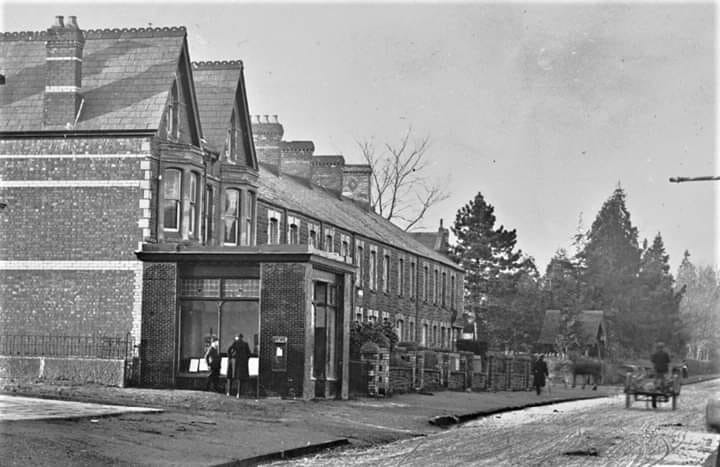 By: Nigel Lewis on 11/11/2022 101 THINGS YOU (PROBABLY) DIDN’T KNOW ABOUT WHITCHURCH 73 WARTIME MEMORIES OF WHITCHURCH Today is Remembrance Day, 11th November 2022 There are not many people left in the village who now remember WW2. Those who do were only children at the time, but there must be lots of stories. We’re privileged to have been given a few
Ceri Stennett has written an incredible account of Whitchurch in the lead-up and the period of the war, and is well worth reading. He has kindly agreed that I can use a few of his reminiscences
War was declared in September 1939, and within months the standing army, navy and air force were vastly increased by volunteers from all over the country, including Whitchurch Within months, many adult men were conscripted into these armed forces, with some women volunteering too Other women worked in the various war factories. On Caerphilly Road was the ROF factory where many locals worked As the hostilities continued, older men and adolescents were added to the conscripted numbers so, eventually most adults were involved in war effort. Those older volunteered as ARP wardens, as volunteer firefighters and special policemen. Older schoolboys did their bit as well
Many of the open spaces in the village were turned into allotments for growing vegetables and fruit An aerial photograph of 1948 we’ve found, shows the patchwork of small plots throughout the village still visible, 3 years after the end of hostilities
Curved, corrugated Anderson shelters were erected in many back gardens. I know of one still in Llandaff North, backing onto the lane at Hailey Park. Are there any others?
In addition, communal air-raid shelters were erected throughout the village. There is one, still standing in Penlline Road (used by Boy Scouts to store their tents in later times). Where were the others?
I’m told that the ‘Batter’ at Melingriffith was excavated as a bomb shelter for the men at the tinplate works. There’s no obvious sign now, but can anyone remember when they were filled in?
Water tanks were located on the library park and on Whitchurch Common for firefighting. Where were they sited?
Anti-aircraft lights and guns were sited locally too. Does anyone know where?
There was an air raid siren located on the police station in Bishops Road. I can recall this being tested still in 1970s (just in case?)
Rationing was introduced very early into the war, with only the very basics left off. Meat, butter and cheese were in very short supply, and no imported fruit. Sweets and sugar were still rationed until the early 1950s There’s a copy of a ration card from one of our reminiscence group shown below. If you look carefully, you’ll see that card had been faithfully stamped weekly by the local butcher Ceri reminds us of the British Restaurant at St Mary’s Parish Hall where nourishing meals were available every day at modest cost. Apparently, the locals weren’t too impressed though!
Blackout was enforced at night, and all street lighting was turned off. I’m sure there must have been lots of accidents
Many children were evacuated to Whitchurch from London and other major English cities and they were taken in by local families The secondary school in Manor Way was split morning/afternoon with local children attending in the mornings and evacuated children in the afternoon. Did other schools adopt the same rules?
Gas masks were issued to everyone, and you were expected to keep it with you at all times Dorothy tells of welcoming evacuated children to her house, and there was even a gas-proof ‘cradle’ for tiny infants
Just like WW1, Whitchurch hospital again used for military casualties, and as well as injured British soldiers and sailors, allied and enemy injured were treated there as well
There were air raids and damage at the Philog with lots of localised damage, and sadly a number of fatalities. There was damage too to houses on Pantbach Road and in Ty’n-y-Pwll Road. There was even a bomb crater on the Common. Ceri suggests that the enemy bombers followed the line of the River Taff, with targets of the Melingriffith works and the railway sidings at Gabalfa We’ve got a few stories of the bomb damage, but I’m sure that there must be a lot more
Everyone knows of the Americans based on the Common, but it’s surprising to learn that they were only here for a few months, in the lead-up to the D-Day invasion. There are so many stories, and clearly the American troops were well received. In appreciation, they raised the sum of £133-10s to provide for the twin avenue of trees to be planted along the Common. There’s a super photograph showing the American Consul unveiling a memorial plaque on 5th May 1948
There were many other American soldiers based at Heath Park for a longer period. There’s some video film of American soldiers on Heathwood Road. There’s also a 1941 film of local soldiers/home guard marching around the village (BFI film well worth seeing)
Much like WW1, iron railings and gates were removed from many houses, for melting down for the ‘war effort’
Both the Rialto and Tivoli cinemas remained opened and showed patriotic films (as well as the latest Hollywood ‘western’). I think they are still showing many of these now on TV!
And of course, at the end of hostilities with VE Day, there were many street parties in the village. With rationing still in place, I shudder to think what sort of sandwiches were on offer! Does anyone have any family stories or photographs of these parties?
With the end of the war, and much like WW1, the local ‘worthies’ began to look for a venue to construct a suitable memorial hall. This again proved fruitless, and it was agreed that the names of the lost heroes of WW2, including civilians would be added to the parish memorial. Ceri tells us that the revised memorial was unveiled at ceremony on 26th Sept 1948 So, next year, as well as the centenary of the original unveiling, it will be the 75th anniversary of WW2 unveiling
Sorry that this blog has run away, but there is so much to tell, and so many questions that remain unanswered. If any of this jogs your memory of stories told long ago, please get in touch. We’d love to hear of your stories from this period to add to our growing knowledge of our village. If you have anything, please let us know. Come and share your memories at our next Reminiscence Group meeting is on Tuesday 6th December 2pm at the Hub all very welcome. 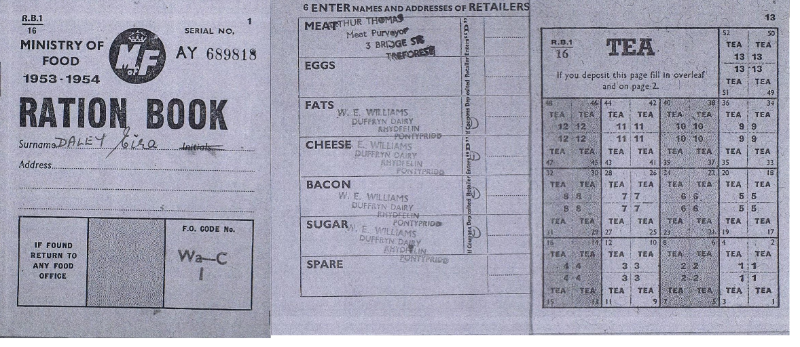 By: Nigel Lewis on 02/11/2022 101 THINGS YOU (PROBABLY) DIDN’T KNOW ABOUT WHITCHURCH 72 THE FARMS OF WHITCHURCH 2A few weeks ago, we looked generally at the 16 or so farms which made up much ofour early village, and we’ve had an incredible response. This time we’ll take a bit of alook at the individual farms and see who lived in them at various times. Whilst we’vegot information from the Tithe Map and the early census returns, there’s not muchelse. There are odd snippets in the local newspapers and historic gossip. If you’vegot anything more, please share it as we want to grow this story of oursI mentioned last time that Forest Farm was the only survivor in the village with thebarns and outbuildings remaining. This isn’t completely true. As you drive up (ordown) the A470, at the traffic lights with Pantmawr Road, you’ll pass two otherfarmhouses; Pentwyn on one side (now the club house of Whitchurch Golf Club) andAshgrove on the little hill diagonally oppositeSo, using the turnpike road (the old Merthyr Road) as a dividing line, and starting atthe north (the M4 for this list – sorry Tongwynlais!), we can have two lists of farms.This time we’ll look at the east side:EAST OF THE TURNPIKE (starting from the north):PentwynSometimes referred to as Pentwyn Ucha (Upper Hilltop) Farm. This is now theWhitchurch Golf Club, with the clubhouse based around the original farmhouse. In1791, it belonged to the Jones family (of Fonmon), and then with John Sankey astenant farmer in 1893. The southernmost farm fields now house the RhiwbinaGarden VillageAshgrovePam has researched Ashgrove and has kindly shared the information. In 1760 it wascalled Pentwyn Isaf (Lower Pentwyn) with fields to the west and south. It gives itsname to the upper part of the A470 adjacent. Many of the farm’s fields were givennames, with one field fronting the old Merthyr Road called ‘Dwy Erw’r YsguborDdegwn’, the two acres opposite the Tithe Barn. Daniel Evans tenanted the farm inthe first half of the 1800s with his family, and we’ve been shown a copy of his willdated 1861. Truly wonderful!Ty’n y CaeLocated in what is now Caedelyn Park, this ancient farm was adjacent to the NantGwaedlyd stream and had a wooden bridge as access (the stream has now beenstraightened). Mary James was farmer at the time of the Tithe Map, with WilliamMorgan farming it later. The farmhouse was still in existence in the early years of the20 th century, and Ernie Broad describes it in in his jottingsGlan y NantI can remember this farmhouse when we moved to Whitchurch in the early 1970s. Itsat where the Masons Arms bedroom block now is. I’ve included a colouredphotograph below of the farm to see if it jogs anyone’s memories. The farmhousewas probably early 1800s, but the farm itself was probably much older. According tothe Tithe Map, the farms fields extended as far west as the crossroads (where thelibrary now stands). Edward Lewis was farmer in the mid-19 th century, with ThomasStephens taking over later. Does anyone know who the later farmers were? Ty’n y ParcEdgar Chappell tells us that this was an ancient farm, developed into a ‘gentleman’sresidence’ in Victorian times, and occupied by Count Antonio Lucovich and his familyat the end of the 19 th century. Previously, the extensive farm was listed on the TitheMap, with Edward Lewis as the tenant farmer. By 1861, his faithful farm labourerThomas Stephens had taken over the tenancyThe ElmsThis farm was located just adjacent to the Tesco petrol filling station on Ty’n y ParcRoad. Victor Skeats was the farmer at the end of the 19 th century and had fields tothe south. There are two newspaper reports about the farm; in October 1901 therewas a report of a fire at the farm with the headline ‘5 horses burnt alive’. The whole ofthe outbuildings and stabling were consumed. Three years later, the same paperreported that ‘Mr T Skeats of the Elms took first and champion prizes at the MaestegShow on Monday with his Show Horse’. So, not all lost clearlyTy’n y PwllThis farm was located where the Anton Court flats are on Ty’n y Pwll Road. Thefarmhouse and yard remained until the 1950s, and the Ordnance Survey maps showa duckpond in the corner of the yard. William Preston was the farmer in the mid-19 thcentury. Ernie Broad tells of his exploits there, and a recently-discovered aerialphotograph shows the farm yardPentre (Village) FarmThis is a farm shown on the Tithe Map and so was of considerable age. It waslocated in the middle of the village (where Domino Pizza is now), and was onlydemolished in recent timesEdward Williams was farmer in the 1840s and 50s, and Barrie Wride (whose familyfarmed Graig Farm) was farmer laterTom Samuels was the farmer from the end of the 19 th century and had fields on bothsides of the main road. Cattle could always be seen crossing the thoroughfare! ErnieBroad tells of Tom Samuel’s son, who didn’t want to be a farmer, running a shopopposite the farm (where the newsagent/post office is now). He also had the very tallbuilding behind constructed for a mangold-slicing machine, providing fodder for thelocal animals (what are mangolds you might ask!)Other FarmsThere are stories of a truly ancient farm called Treoda, which might, or might not,have been located behind Ararat Chapel on the Common. Certainly, there were oldcottages still there at the time of the Tithe Map. Does anyone know anything?And then there was Fred Hales’ farm. Ernie Broad refers to this farm as being just300 yards from Pentre/Village Farm, but I cannot locate it. Can anyone help?And then there was Penlline (so called because it was built on land owned by thePenlline Estate). Was this Fred Hales’ farm? Ernie Broad describes the house withgreat detail. Does anyone know about this?Then there are the farms in Tongwynlais, Rhiwbina and Birchgrove. Just a little tooremote for this blog, but if anyone knows about them, please help Next time, we’ll conclude this mini-series with a look at the farms on the west side ofthe turnpike 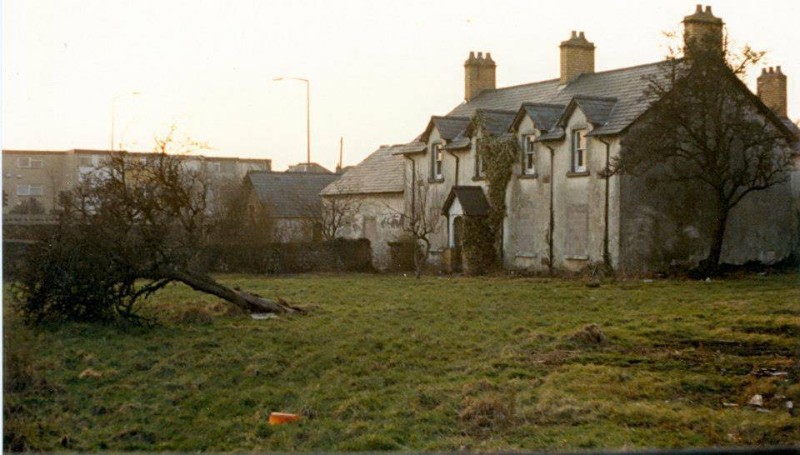 By: Nigel Lewis on 27/10/2022 71 WALKING WHITCHURCH HERITAGE Last Saturday, we completed our second heritage walk. Meeting on Whitchurch Common (opposite the Three Elms), over 60 folk met up ready for another instalment of local history and healthy walking
The weather forecast had been dire in the preceding days, but for the duration of the walk (and a few hours after) the sun shone and the showers, pretty much held off
Learning so much from our first walk, we had positioned our colourful waymarkers around the lower village. Each showed an illustration of the stop, and with bilingual ‘teasers’ to tempt passers-by. The fourteen stops covered another tranche of our village history with local characters, lost houses and even hints at a more gruesome ancient past!
The illustration below is by Chris Griffin (thanks Chris!), and is one of the sketches on the waymarkers. It shows what Baylis’ shop might have looked like a hundred years ago. Other sketches were generously produced by Anthony Evans and Chris (and even a few from yours truly!)
With funding from CADW and the Heritage Lottery Fund, we were able to have a foldable map and coloured booklet to guide our walk. These bilingual maps and booklets are still available free-of-charge from the Hub/Library if you want to walk the route yourself. The Waymarker boards will also remain in position for the next week too
We’ve had incredible feedback from those on the walk saying how much people enjoyed it, and also from others who couldn’t make it on the day, asking if the walk will be repeated. I’m sure we will, so watch out on our website for details
The walk (more of a gentle amble really), took us east along Gwauntreoda and the Philog as far as the old parish boundary. We looked at Ararat Chapel, Holly Cottages and the old Baylis shop. Names of old residents popped up and talk of long-demolished houses, sadly no longer here. Where was Old Povey’s House? And what did the Filog Cottages look like?
The return leg, on the other side of the road looked at the bomb damage in Violet Place and Wauntreoda Road, the site of Flays Farm and stories of American soldiers camped on the common. We discovered a little of Eli Evans our local sculptor and Vine Cottage, finishing back at the Three Elms pub
We had so many people booked on the walk, we split into two groups, with Terry Chard leading the second group in reverse order
There was so much to see that the walk took two hours, and we were delighted how many of the really hardy folk managed it all. Well done you! A well-deserved pint of cwrw helped at the end
If you’re interested in our project, we’re holding a free event at St Mary’s Parish Hall in Church Road on Saturday afternoon (29th October), starting at 2 o’clock. We’ll be celebrating our Walking Whitchurch Heritage project, with displays, short talks and refreshments. There’s something for all ages and everyone’s cordially invited
We’re planning further walks before the end of the year. Ceri Stennett is curating and guiding a Memorial Walk over Remembrance weekend starting at St Mary’s and finishing at the Parish War Memorial outside the Hub/Library. This walk has to be restricted to low numbers for health and safety reasons. We’re also looking at a walk, suitable for children in December in the village with a ‘Christmas’ theme. Watch out for more details
Even though our grant funding runs out at the end of the year, our walks have proved so popular that we’re hopeful that we’ll continue them into 2023 (and maybe beyond)
If you have any ideas for other walks around the area, please let us know by messaging us through our Facebook page or emailing awen.cymru@gmail.com  By: Nigel Lewis on 22/10/2022 101 THINGS YOU (PROBABLY) DIDN’T KNOW ABOUT WHITCHURCH 70 THE FARMS OF WHITCHURCH 1
It’s thanks to Ernie Broad and Edgar Chappell that we know so much about the farms of the village. They have written so much and given us a glimpse of how things were not so long ago
Ernie Broad tells us about the farming characters of his childhood and Edgar Chappell has lots to say about the history. He tells that from 1295 Whitchurch was one large medieval manor, with farms and bound tenants, but for the last 2-300 years there were a handful of separate landowners. Does anyone know any more about this?
It’s amazing to think that (almost) within living memory there were at least 16 farms in Whitchurch and Llandaff North. There were even more if you include Tongwynlais, Birchgrove and Rhiwbina
From the Tithe Map of 1841, it’s clear that nearly all of the farms were tenanted with absentee landowners. The old Welsh names signify that many of the farms were of considerable age, so in all probability the farms of the early 20th century were the same at least 200 years earlier. Many of the farm fields listed on the Tithe Map had names which reflected their size, shape and quality
Attached is a map, based on the Tithe Map showing the village and the hundreds of fields surrounding it. There’s probably hours of fun with this looking at the names and working out where our modern village is
None of the farms were huge, the biggest no more than 20-30 fields, with many of the others much smaller. To do justice to all of the farms needs either a very long blog, or two smaller ones. So, I’ve decided to write this first blog in general terms, and then follow up with a list of all of the farms I know about
Our local farms were a mixture of both arable and pasture. Arable growing crops, mainly of wheat, barley and oats, whilst the pasture provided grazing for cattle, some sheep and plough oxen
Whilst the farms varied in size, each had its own farmhouse (some really old ones might have housed animals as well as the family), a barn, cowshed, stabling, cart shed, piggery and hayrick, all within a walled or hedged farm yard. Adjacent to the farmhouse would be a vegetable garden (and probably a henhouse), the domain of the farmer’s wife, for family produce
Many of the farms were located adjacent to a stream where there would be plentiful supply of water, but others like Ty’n-y-Pwll and Pentwyn had ponds. The pond at Pentwyn (now Whitchurch Golf Club) is now a water hazard on the course, and you can still see it through the trees on the A470!
Some of the farms specialising in dairy, such as Forest Farm, had milking parlours. And of course, dotted around each farm were the hayricks and occasional field barns
The early census returns list the farming families and their live-in workers, but there were many others in the parish whose occupation was listed as ‘agricultural labourer’. Clearly in those days, farming was very labour-intensive, and at different times of the year (such as seedtime, ploughing and harvest) required even more assistance. I’m sure you’ve all seen the terrific photograph of a farmer ploughing on the old Forlan Farm with a pair of horses drawing the plough (Old Whitchurch, by Edgar Chappell)
As mechanisation crept in, the need for large numbers of labourers diminished, and after WW1, the shortage of men only accelerated the decline. By the 1950s, the widespread introduction of tractors and mechanical ploughing meant far fewer farm workers were needed
In the latter part of the 19th century, the area around Gwauntreoda and the Philog changed to market gardening with the whole family helping out. This meant even less agricultural employment on the farms, with the local families tending to their own plots
Then after WW1, Whitchurch began to expand dramatically with more and more houses being built on the farm fields. Initially on the fields nearest to the centre, but over the years gobbling up more and more open space
Now, only the street names reflect the farms and fields that once dominated the area, and with only the last few of the farmhouses surviving. In fact, Forest Farm is the only local example remaining with its barns and sheds, and tumble-down outbuildings
Next time we’ll look at all of the local farms and some of the farming families. See how many of them you know about!
 By: Nigel Lewis on 22/10/2022 101 THINGS YOU (PROBABLY) DIDN’T KNOW ABOUT WHITCHURCH 69 OLIVER CROMWELL Researching items for these weekly blogs is always a delight, and the number of strange facts that come to light never ceases to amaze me
If you were asked to list which important people in history might have a connection to the village you might be left scratching your head. There are recent sportsmen and women who attended our schools, and there are various notable people who have lived in the village in the past. You might even suggest that Benjamin Disraeli and his love affair with the widow at Greenmeadow might qualify
Nothing prepared me for the fact that Oliver Cromwell might be linked to Whitchurch! Yes, that Oliver Cromwell of Roundheads and Cavalier fame (or infamy). Many know the history of the Civil War when the country was divided into the opposing camps of Royalists v Parliamentarians, and the battles (there was one on the Great Heath in Rhiwbina, and another at St Fagans), all of which culminated in the execution of King Charles I, and Oliver Cromwell being declared Lord Protector of the Commonwealth
So, how likely is it that Oliver Cromwell’s family were from Whitchurch, and where’s the evidence?
Terry Chard tells me of a television programme on BBC which explains the local story. It’s still available on iPlayer and is well worth watching. If you google ‘BBC The Story of Wales, Episode 3’ and scroll 41.25 minutes into the film you’ll see Huw Edwards in Whitchurch Village, entering into St Mary’s churchyard explaining all in about three minutes!
You might have read the Hilary Mantel book, Wolf Hall, about the scheming Thomas Cromwell and King Henry VIII. You might even have watched the TV series
Two Whitchurch brothers Morgan and Richard Williams were very loyal to the first Tudor king, Henry VII, and were rewarded with grants of land, and later were connected by marriage to Thomas Cromwell (of Wolf Hall fame). We’re told that Morgan Williams married Katherine who was Thomas Cromwell’s sister (still with me?)
Thomas Cromwell was such an illustrious person in the royal court, that Morgan Williams’ children took on the name of Cromwell in order to better themselves. It was Morgan Williams great grandson, who was born in 1599, who was named Oliver Cromwell (otherwise Williams)
John Leland, c1538 in his journals around Wales helpfully wrote: ‘Commotes in Glamorganshire – Kibworth lyeth from the mouthe of Remney up on an hille, in the commote caullid Keyen On, about six miles on from the mouthe of Remney. This hille goith as a waulle over-thwart-betwix the rivers of Thane (Taff) and Remney. About two miles from Cardiff, be vestigial of a Pile or Manor Place, decayed, at Eglius Newith (Eglwys Newydd), in the Paroche of Landaf. In the south side of this hille was born Richard Williams, alias Cromwelle’ So, at this time, Cromwell must have been well known to Leland
So, where was this ‘decayed pile’ of the family home of the Williams/Cromwell’s? The father of Morgan and Richard Williams was William ab Yevan of Whitchurch (b1443) and he was Bailiff to King Henry VIII
Edgar Chappell in his book ‘Old Whitchurch’ notes that John Williams, a contemporary of Morgan and Richard Williams wrote: ‘The said Ievan ap Morgan (differing spellings!) dwelled in the p’ishe of newchurche w’thin a myle to Cardiff where the heire of the younger sone of the said Ievan inhabiteth at this time’
The family home was called Llanishen Fach and there is evidence that the family occupied the house for the next 3-400 years. What’s even more surprising is that the 18th century version of the house still remains, and it is located on Heol Erwin, just behind the shops on Heol Llanishen Fach
I can’t think how many times I’ve driven along that road, with no idea of such an historic property adjacent. CADW have listed the house Grade 2, and if you go onto their site there is a map
Rhiwbina was always part of the old Whitchurch Parish, so the old Williams’ house fell into Whitchurch
Why have I never heard of any of this? And why is there no local record?
Where are the statues, plaques or street names? Isn’t it about time that Whitchurch started to celebrate such an incredible ‘son’ of the parish?
Does anyone know of other notables that we ought to explore? Please get in touch
Thanks to Terry Chard for lots of the information on this local connection, and for whetting my appetite for the hunt
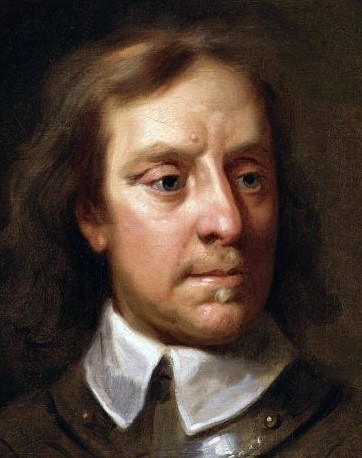 By: Nigel Lewis on 29/09/2022 101 THINGS YOU (PROBABLY) DIDN’T KNOW ABOUT WHITCHURCH 68 TELEPHONE BOXES Where have all the telephone boxes gone?
I know that the old red telephone boxes have all disappeared from our streets, but the silver replacement boxes seem to be disappearing as well. I’ve been looking around at where the boxes still are, and there aren’t many. There’s one at the roundabout by the library, and one right at the bottom of the village where Manor way starts. But there’s nothing in between. Surely there used to be a phone box in the village? Where would it have been, anyone remember?
Driving West from the library, there isn’t one until you come to Hailey Park. Surely there was one in Llandaff North near the shops? And what about Tongwynlais and Rhiwbina?
So, who still uses a public phone? We used to guess that the only people using the box in St Margaret’s Road were making clandestine calls. But who else? Don’t the statistics say that most people have at least one or two mobile phones each
It can only be a matter of time before the final few phone boxes disappear
It got me thinking; Terry Chard tells me that the old telephone exchange was in a little terraced cottage in Old Church Road, and that people used to queue up outside to make a phone call to distant relatives at Christmas in earlier times. The exchange has gone now, but there’s an old photograph showing the telephone exchange sign over the front door, and the GPO junction box is still outside on the pavement. Does anyone remember it?
And when did you last send a telegram? Can you still send one? Another old photo shows the telegraph office in the village (where the Monmouthshire Building Society is now)
Where did all the telegraph poles go? Many of the old photos show telegraph poles (with multiple cross spars), looking like forest trees throughout the village. I think they also carried the electricity too. They’re all gone now. We’ve still got one outside our house, but it’s very modest and is for telephone and broadband
And then there are the pillar boxes, we’ve still got them thank goodness. But are they the next ones to go? Does anyone write letters any more?
The pillar box in the village is an unusual one in that it is a ‘double’, with 2 slots. Obviously very busy not so long ago.
We’ve also got an Edward VIII pillar box, located in Heol Don. This is very rare, as I’m told that there are only 2 in the whole of Wales! The photograph below shows the royal cipher on the box. Why aren’t we making more of a fuss of such a special pillar box?
Many of the other boxes in the village are George VI or Elizabeth II, but does anyone know of any earlier ones? Are there any Victorian pillar boxes locally?
Apparently, pillar boxes started c1859 after the Royal Mail introduced stamps (the penny black!). Before then, people had to pay to receive the letter. That’s when letter boxes started to appear on the front door of houses, as the postman didn’t have to knock any more
In 1861, Henry Lewis at Greenmeadow had, amongst his servants, an 11-year-old as an errand boy. I bet he had to take lots of letters to the post office. The Bookers had a letter-carrier on the staff at Melingriffith too
There’s a lovely newspaper article in the Cardiff Times of 27th February 1866 regarding our local letter-carrier (not postman then!) who had been replaced: Letter Carrying The inhabitants of this thriving village are greatly benefitted by the change that has taken place in the letter carrier. The old carrier, in spite of many complaints made by individuals to his master, of the careless manner in which he executed his duty, was retained in office until about a fortnight ago, when as the old saying was verified by the master himself that seeing is believing. The carrier was then discharged as a matter of course; and it is satisfactory to find that his successor is a little fellow of stern and persevering habits. He delivers the letters at an average of threequarters of an hour, earlier than his predecessor Just 160 years ago, but it seems like another age!
No doubt, we’re going to lose the pillar boxes and postmen (and women) before too long. Then even more of the ugly Amazon collection boxes will spring up throughout the area instead, and electric delivery vans will probably replace the postie
Not quite yet though (I hope) 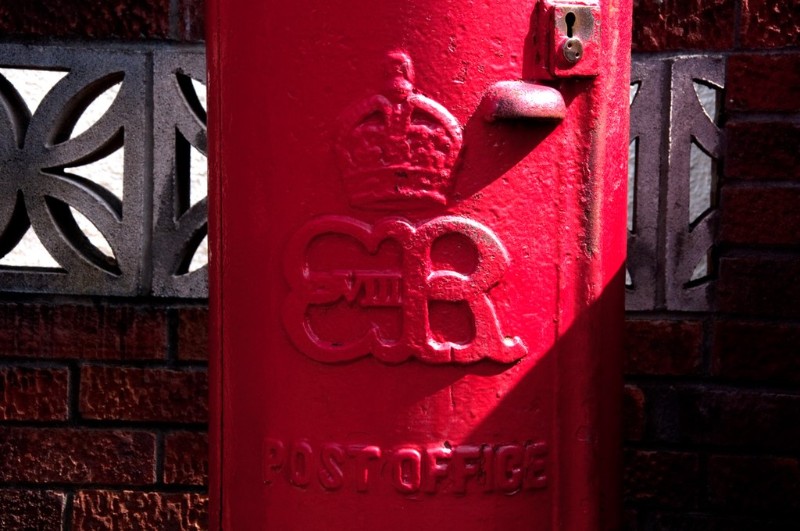 By: Nigel Lewis on 22/09/2022 101 THINGS YOU (PROBABLY) DIDN’T KNOW ABOUT WHITCHURCH 67 OTHER BOOKER HOUSES
The Bookers had 5 children, and they all lived the life of luxury in Velindre with a host of servants at their beck and call
One daughter, Anna, died early, but the three boys, Richard Blakemore, John Partridge and Thomas William (junior), and their sister Mary grew up in the big house watching their father grow the business, and enjoying everything that a fabulously wealthy Victorian family could aspire to
As they reached maturity, TWB Blakemore began planning for his children’s future. Mary would be married, so a suitable husband needed to be found, and suitable girls (as future Booker wives) would be needed. Mary would be provided with a dowry, but the sons needed homes of their own. TWB (junior) showed an interest in the family business, so he would live in Velindre, but new homes would be built for the other two. Richard, the eldest had The Pines, near to the old church, and John Partridge had a new house on Rhiwbina Hill called Greenhill
However, the best laid plans etc, TWB Blakemore died at the young age of 57, so the business fell to the sons. His widow, Jane remained at Velindre until her death
Let’s look at the houses:
VELINDRE We’ve looked previously at Velindre and how it changed over the years by TWB Blakemore. After he died in 1858, his youngest son TWB (junior) moved into the house with his new wife Caroline and his young family. This man was nothing like his father and plundered the business and estate for his own ends (more of this another time!). He spent further fortunes on Velindre and the grounds, and the OS map of 1880 gives a tantalising glimpse of where the money was spent, extending and upgrading the house and completing the extensive lawns and gardens. When everything collapsed in the 1870s, TWB (junior) left everything and simply moved to another mansion. This time in Southerndown, overlooking the sea. He died in 1887. Velindre had various tenants in the coming years, and finally was acquired by Cardiff Council as part of the new Asylum. It was demolished c1900 Prior to demolition, Cardiff Council were given a complete set of plans for the house; these have been lost, what a shame. We’re told that the grand stable block had a splendid clock and tower, and this was taken down and reused at the trolleybus terminal at Roath Park. This too has been lost!
THE PINES This was the home for the eldest son Richard Blakemore Booker. In earlier times it was the site of an old cottage which became the Farmers Arms. This was demolished sometime after 1841, with the Pines was constructed subsequently The Pines is still there, and is the only part of the Booker enterprise to have remained Richard never married and the Pines was his bachelor pad Edgar Chappell in his book ‘Old Whitchurch’ refers to Richard as ‘a man of dissolute habits’; a man who obviously burnt his candle at both ends, and died only 32 years of age! Later tenants changed the name to ‘The Cottage’, and Ernie Broad refers to ‘Squire’ Phillips, who was Mayor of Cardiff when he lived there. Does anyone know of other tenants? The GPO acquired the orchard and built a sorting office fronting onto Heol-y-Forlan. This too was later demolished for the housing development there today The Pines (now back to its old name) is now a dental practice, but thankfully nearly all of the original exteriors, including the wonderful Georgian chimneys remain intact. The stone boundary wall onto Old Church Road is incredibly high, and is clearly original to the house. I wonder why it was built so high, does anyone know?
GREENHILL This was the home for John Partridge Booker and his family. Originally a farm called Pwll-y-Winci (Weasel’s Pool?), the house and lodge stood in 4 acres of garden, but surrounded by land of another 90 acres. Quite modest! The house was huge, comprising a hall, study, drawing room, dining room, morning room, servant’s hall, footman’s bedroom and butler’s, plate and China pantries. It had six bedrooms on the first floor along with dressing and maid’s rooms. There were also two ‘good’ attics over for servants’ quarters There were also extensive stables and kennels for the local hunt (both fox and otter) JPB died in 1868 aged only 34. His widow Clara lived at Greenhill for many years after In the 20th century, Greenhill became tenanted. In 1909, the Evening Express newspaper reported that: ‘Capt. and Mrs Chappell of Greeenhill donated a new peal of bells to St Mary’s’ In later years, the 90 acres were sold off for development, and housing crept ever nearer to the big house. It was then sold to Cardiff Council who used it as a special school, and was subsequently demolished for a new school
And what about the Stacey’s? After her wedding in the old parish church of St Mary’s in April 1860 to Rev Cyril Stacey, the couple enjoyed a fabulous reception on the lawns at Velindre, complete with hundreds of guests, a brass band and 24 cannons (set on the banks of the River Taff below). Cyril was no ordinary vicar though; he had inherited land in Roath and built lots of houses. Mary moved away from Whitchurch, had 2 children, but unfortunately died soon after. She was buried in the old churchyard where she’d been married not long before. Streets in Roath were named after the family, Stacey Road, Richard’s Terrace (after Cyril’s uncle) and Booker Street for his wife. The photograph below shows the street Thanks to Ted Richards of Roath History Society for this information
Does anyone know where Mary and Cyril lived after their marriage? We’d love to know
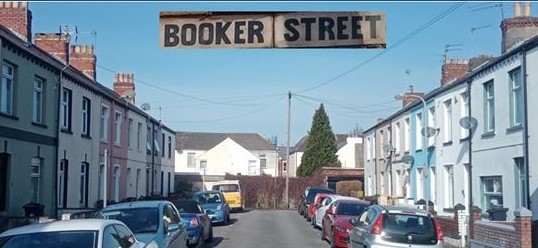 By: Nigel Lewis on 15/09/2022 101 THINGS YOU (PROBABLY) DIDN’T KNOW ABOUT WHITCHURCH 66 AMERICANS ON THE COMMON It’s common knowledge that there was a camp of American soldiers on Whitchurch Common for quite a time during WW2
It was quite a shock to discover that instead of years, the Americans were only here in Whitchurch for a few months!
The Second Evacuation Hospital Unit (a bit like MASH on the TV) was only formed in 1940 and were stationed in the UK from September 1942 until D-Day in 1944. According to their unit history, they were posted to Whitchurch between February and June 1944 (yes, only 4-5 months!), departing for the Allied Forces concentration area at Henley-on-Thames, and then to France just after the D-Day beachhead
They appear to have been billeted with private citizens while their semi-permanent barracks were under construction that February
There are numerous stories of local girls finding all sorts of reasons to walk in the general vicinity of the Common, just to see
A canteen was set up in St Mary’s Church Hall to feed the servicemen, where local girls would prepare sandwiches
The American Padre was known to preach at Ararat Chapel opposite the camp, but nothing is known of the sermons
After June 1944, the camp was dismantled (and probably shipped over to France), so nothing remained. However, the Americans must have been impressed with the hospitality offered to the soldiers by the local Whitchurch folk as they donated money for the avenues of trees which line the main road. They also organised for two plaques to be set, either side of the road in appreciation
The photograph below is the only evidence of the Americans in Whitchurch. I suspect that the taking of photographs of a military establishment during wartime was expressly forbidden! The surviving photo shows the American Consul unveiling one of the plaques with an American flag, with lots of local ‘worthies’ looking on
The avenue of trees, a mixture of poplars and cherries was not considered really appropriate, but they have proved to be a lasting memorial to an important moment in our village history. Over time, as the trees matured, one by one they either blew down or became dangerous, so were replaced with newer trees. I think there are only one or two of the original trees left
The plaques themselves, suffered more than the trees and deteriorated. In 2011, the local WI and Cardiff Parks set about to refurbish them, and the stones now have handsome, but replica plaques continuing the story
Do you have any tales of this period? We’d love to hear
We’ll be passing underneath the trees during our Walking Whitchurch Heritage walk in October, when we can re-tell the story. If you’d like to know more about the walk, keep an eye on this fb page, see the AWEN website or even better join AWEN@thelibrary! Email awen.cymru@gmail.com to get a membership form.
Look forward to seeing you there! 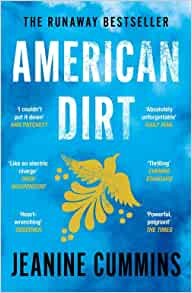 By: Nigel Lewis on 09/09/2022 101 THINGS YOU (PROBABLY) DIDN’T KNOW ABOUT WHITCHURCH 65 ELI EVANS Did you know that we had a sculptor living in the village in the 19th century? His name was Eli Evans
Perhaps you did, and that he lived in Vine Cottage on the Common. But who was he, and why Vine Cottage? Lots more unanswered questions that need to be unpicked
Chris Soughton has discovered that Eli was born in Roath in 1811, but had moved to Wauntreoda by 1836, so he would be about 25 years old. We don’t know anything about his early life, but by the first census in 1841, he was living on Wauntreoda, as a lodger with Thomas White who was a carpenter, Thomas’ wife and family and a servant. Eli’s occupation was given as ‘sculptor’
By the 1851 census, Eli is still calling himself as a sculptor, but is living on his own at Wauntreoda with 2 servants
In Websters Trade Directory of 1852, Eli changes/refines his occupation to ‘stone mason’, and 3 years later in the Ewans Trade Directory of 1855, describes himself as a ‘stone cutter’
By then, Eli is living in Vine Cottage with a new wife (20 years younger than himself), and is making a name for himself as the go-to man for headstones/gravestones in the village. Chis S has shown me a photograph of a beautifully designed, shaped and tooled headstone in (old) St Mary’s Churchyard. We know that this is Eli’s work as he has signed it in the corner with his name and profession (all in Welsh)
In 1859, he was given the commission to design and construct the family mausoleum for the Booker family. The Cardiff & Merthyr Guardian newspaper of 16th July states: ‘…the tomb of the late TW Booker Esq in St Mary’s Churchyard in Forest-of-Dean stone, interspersed with iron railings. All executed by Mr Eli Evans of Whitchurch who has exhibited considerable skill in the general treatment of it’ The mausoleum is still there, but the railings have been lost (I wonder if they were melted down as part of the WW1 war effort?)
By the 1861 census Eli has a family of 2 small daughters and 2 smaller sons. He now refers himself as a ‘stone sculptor’ and employed 2 men and a boy. Eli’s nephew Henry Hopkins is also living with, and working for Eli as a ‘burial mason’ (more on Henry Hopkins another time!)
By 1871, Eli and his wife have had another daughter, and by the next year Eli’s eldest daughter had married the new minister at Ararat, Rev Thomas Thomas
Just three years later, Eli died, at the age of 63. An obituary from the Cardiff Times of 24th July 1875 says: ‘at 3 o’clock on Wednesday 21st inst the remains of Mr Eli Evans were consigned to their last resting place in the family vault, Wauntreoda Chapel Whitchurch. The Rev Horatio J Thomas, vicar of Pentyrch conducted the service. There were several hundred persons present, including the Mayor of Cardiff. The service was conducted in Welsh. Hardly a dry eye was to be seen’
So, back to the beginning of this blog with Eli living in Vine Cottage. Where was Vine Cottage, and why such an unusual name? There’s an old black and white photograph in the Heritage Library in Cathays, dated 1892 and showing a thatched cottage alongside a stream on Whitchurch Common. By a process of elimination, the photograph is probably of Vine Cottage, and in all likelihood, the old farmhouse of Cornel-y-Waun farm. Was Vine a corruption of Waun? Waun Cottage becomes Vine Cottage? Sounds plausible to me
The sketch below is based on the old photograph and shows Eli and his wife outside the cottage
I’d welcome any thoughts you might have of this local character
Apparently, there is a letter book of ‘Eli Evans of Whitchurch’ dated 1865 held in the West Glamorgan Archives. Opportunity for further exploring by someone in the future! 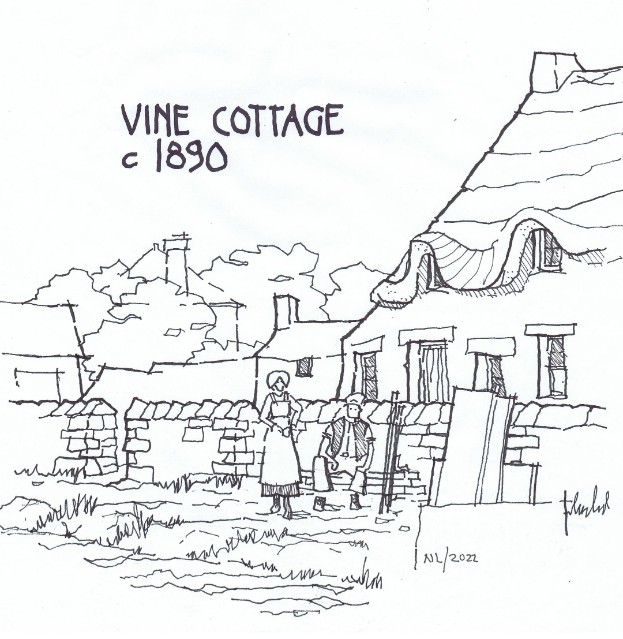 By: Nigel Lewis on 01/09/2022 101 THINGS YOU (PROBABLY) DIDN’T KNOW ABOUT WHITCHURCH 64 Y FILOG The southernmost part of the village (nearest to the parish boundary), was incredibly rural 200 years ago. A few isolated cottages and fields, and a rambling roadway
British History Online tells us that Philog (or Ffilog) in 1811 was: ‘a brook and a hamlet in the chapelry of Whitchurch near Gwaun-tre-Oda. The name applied particularly to an old thatched house on the north side of the highroad to Whitchurch, where a lane branches off eastwards to the Heath’
This was 30 years before the tithe map and 70 years before the first OS map. However, from the BHO description and looking at the early maps, we can locate Y Filog with some degree of accuracy
Nowadays, the main road south bends at Philog House to the traffic lights on the A470. Traffic driving north merges near the nail bar shop and the triangular grassy verge
Back in 1811 (and for probably 150 years before then!), Y Filog was a row of tiny thatched cottages sitting plumb in the middle of the road. Many years later, the building which was to become Eddy’s the baker would replace Y Filog when the road was widened
The roadway (or highroad as BHO describe it) back in 1811, would have been an unmade track, not quite wide enough for 2 wagons or carriages to pass one another, almost impassable in the worst of the winter weather, and bounded on each side with grassy verges and hedgerows. I’m sure that it wasn’t anything like as pretty as imagined though
There were one or two other cottages close to Y Filog which would have formed the rest of the hamlet, and the fields behind would have grown arable crops and some pasture
But which one in the hamlet was Y Filog? There is a well-known early photograph simply entitled ‘Philog’. I assume this is it
The sketch below, based on this photograph shows Y Filog in the 1850s with a typical deliveryman and his cart outside the cottages (or perhaps not!)
If it’s tricky to locate Y Filog and what it looked like, then identifying the early residents is almost impossible. The early censuses seem to hop around quite strangely. We know that Thomas Howells and his wife Blanch were living in the hamlet in 1851 (he was then 65), so he could have been living there in 1811! They were both there 10 years later
Lewis John (more of him later) was 48 years old in the first census, and he was still there in 1871
Jane Ray was 85 in 1841, but there was another Jane Ray (who was 42) 10 years later. Clearly not the same lady, but perhaps a daughter or even grand-daughter. That second Jane was still there in 1871. Were they in a family house? Was it part of Y Filog?
George Hancox was 37 in 1851, and he was around the lower village for years after
As Whitchurch expanded later in the 19th century, the fields gave way to a surprising number of market gardens supplying vegetables (and even flowers) to the local community
Y Filog was still there in 1881 at the time of the first OS map, still there in 1900 (but with Philog Terrace creeping up on it), but gone by the 1920 OS map. So, probably demolished before WW1
In an early blog I wrote about a cottage called Cwm-y-Fwyalchen (the dale of the blackbird), and an image held in Cardiff Library. In the early census of 1841, there was a cottage called Blackbird Inn, and on the earliest OS map there another cottage was called Mwylach-Bwlch (Blackbird’s Gap). Where were they all? Did they form part of the hamlet? Does anyone know?
In response to my blog, 2 families provided feedback, and a wonderful wedding photograph from 1909 in front of a cottage the family called Mwylach Bwlch. The family were the ‘Johns’. Lewis John (I mentioned him earlier) was in the hamlet in 1841, so were they the same family? The cottage looks almost identical to what I surmise to be Y Filog. Did the name change over the years? Does anyone else find this all amazing?
We’ll be passing by the site of Y Filog as part of our second Walking Whitchurch Heritage stroll later in October. We’ll try to discover some more of the history then. If you’d like to learn more about the walk, visit the AWEN website events page https://www.awenthelibrary.cymru/ for the dates and email awen.cymru@gmail.com if you would like to join AWEN@thelibrary. 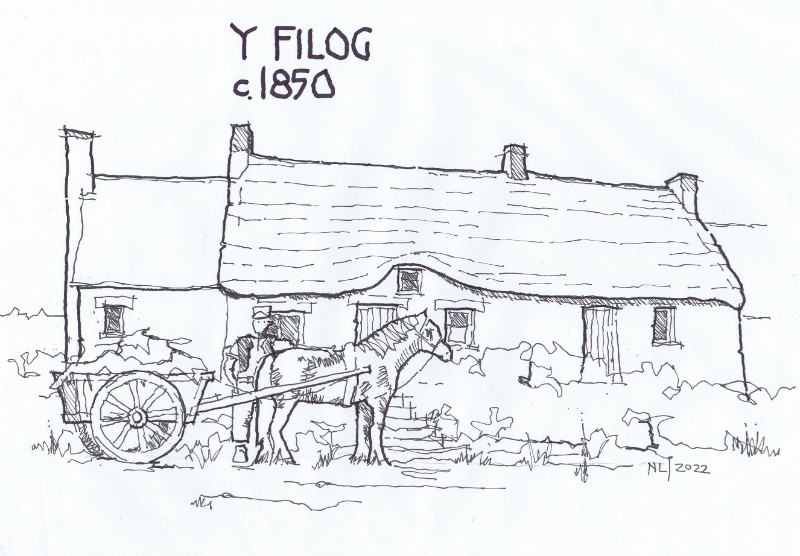 By: Nigel Lewis on 25/08/2022 101 THINGS YOU (PROBABLY) DIDN’T KNOW ABOUT WHITCHURCH 63 THE BAPTISTS
It never ceases to amaze me about our village. This week I’m wondering why we’ve got 2 Baptist Churches within half a mile of each other
Edgar Chappell tells us that there were tiny Baptist communities established in Lisvane and Caerphilly in the late 18th century
Because travelling was difficult, local Baptists agreed to meet here in the village instead. First at the old farm Gwauntreoda on the common, and then as numbers grew, in 1824, they built a small chapel across the road. This they called Ararat as the plot was on slightly raised ground. Even though they called the chapel Ararat, it was always referred to as Capel-y-Waun (Church on the Common)! Like most of the village, they were all Welsh-speaking
The brook adjacent provided a very convenient location for baptisms until they were able to build their own internal Baptistry in 1879
On the edge of the village, Ararat was very rural, surrounded by fields and hedgerows. During the 19th century, the village expanded, and the small hamlets all morphed into the long village which we would recognise even today. As the village grew, so did Ararat, with membership increasing from 79 in 1829 to 136 in 1860
In 1851, the chapel was rebuilt (at a cost of £600) with seating for 350 people. The sketch shows the chapel in 1901 with the graveyard in front
By 1915, Ararat was rebuilt again as the building we know today (although with many extensions since)
In the late 19th century and the first half of the 20th centuries, churches were famous for their fundraising through ‘Grand Bazaars’. Does anyone remember stories of these?
The Welsh-speaking congregation at Ararat came under pressure from the (mainly) English-speaking incomers, and so both Welsh and English services started. However, by 1865, a small group of English-speaking Baptists decided to form a separate house church, based in another farm on the common (Cornel-y-Waun). This new congregation chose the name of Bethel for their group
Of course, the Welsh-speaking congregation at Ararat continued to meet, albeit with fewer numbers
Within a few years, Bethel outgrew their barn and started meeting in a thatched cottage behind the Maltsters Arms pub. In time, even this proved too small, and 2 years later they acquired a plot of land in Penlline Road to build a ‘small vestry’ with seating for 100
The Bethel membership continued to grow, and in 1884, fundraising began to build a new chapel. It took 10 years, but the Bethel we see today was erected (at a cost of £1,024). It had seating for 350, although they only had 42 members
The sketch below shows Bethel about 1900
By 1901, with a new minister, Bethel’s membership had grown further so that a gallery was installed. By 1920 the original ‘small vestry’ had been demolished and replaced by 3 new schoolrooms. Whilst the work was progressing, Bethel met in a large marquee in the ‘Plas-y-Llan’ fields opposite, where Whitchurch High School stands today
Then in the 1950s, a new building was erected on land behind Bethel to provide additional schoolrooms and hall. This allowed children’s work and the uniformed organisations to flourish
In more recent times, Bethel’s interior has been transformed with the removal of the fixed pews and formal pulpit enabling more flexible worship. On Penlline Road, a glass vestibule has been inserted
Very recently, the rear schoolrooms near the car park have been remodelled as the Whitchurch Centre with totally new facilities
With a succession of younger ministers recently, Bethel has attracted a younger membership which continues to grow, with great emphasis now on family worship, and outreach to the community
Back to Ararat. With the loss of many of their English-speaking congregation in the 1880s, membership dropped, but over time regrew. By 1905 membership stood at 150 (double that of 1883)
It is ironic that at the start of the new century, Welsh-speaking Ararat finally succumbed to be an English-speaking church
The story of Ararat during the 20th century and beyond is one of great encouragement. A growing membership (in spite of the world wars and economic hardships), Ararat expanded its accommodation front, back and sidewards. A series of very charismatic ministers helped with growth. The most recent of alterations with the Ark Cafe has made Ararat incredibly accessible not only to the local population, but as an events-location for the whole city
Whilst Ararat retained its pews and gallery, the front worship area allows total flexibility and as a result marches fearlessly onwards
So, 2 English-speaking Baptist churches in the village. Over the years, each had its own uniformed organisations for both girls and boys, and very intense rivalry. I’m sure there must be stories to share
PS Much thanks to Chris Soughton for the information on Ararat, and to Bethel for the information on their early life (from their book ‘Born in a Stable’)
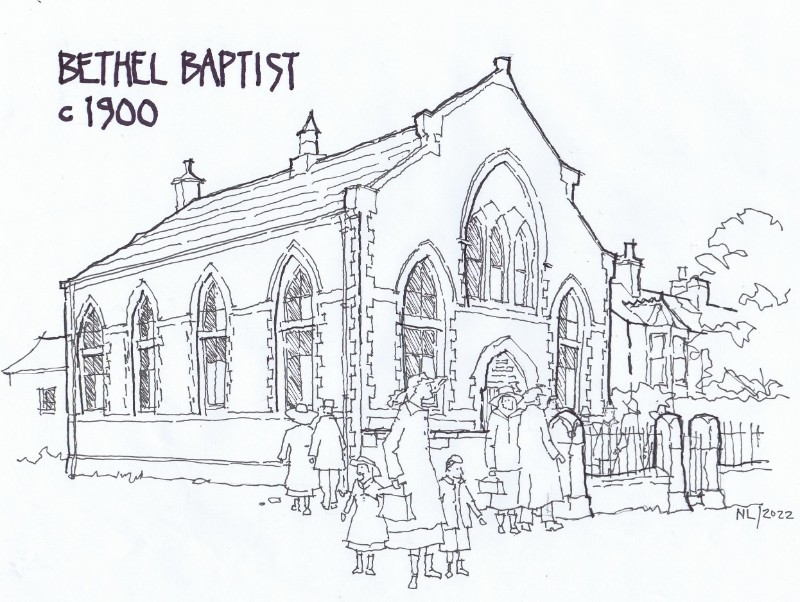 By: Nigel Lewis on 18/08/2022 101 THINGS YOU (PROBABLY) DIDN’T KNOW ABOUT WHITCHURCH #62 STREET VENDORS For over 40 years we’ve had the privilege of having a ‘Johnny Onion’ man visit us here in Whitchurch, usually three times every year. Sadly, in the spring this year Patrick made his last visit to us selling his Breton onions and shallots, announcing he was retiring. What a loss, and the end of a long tradition!
As a boy, we had a Johnny Onion man (not the same man though) visit us in Cathays, with his bicycle almost lost with his strings of onions. Perhaps the sketch below will bring back memories. Patrick hasn’t used a bike for many years, preferring to sell his onions door-to-door from the back of a white Transit van. He did however, wear his French beret
All this made me think back to the other street vendors, providing our necessities and essential services. From memory (always dodgy now), they included:
The Knife Sharpener With his sharpening wheel on the front of his bike. He’d pedal furiously to spin the grinding wheel
The Salt and Vinegar Man He had a hand cart and sold block salt which he would saw off from an enormous chunk. The vinegar was dispensed from a wooden barrel with a tap at the bottom. Wonderful smells even now
The Coal Man They would drive an open lorry with the heavy sacks of coal on the back. My mother always wanted ‘best’ Welsh coal. Chris remembers her mother would always count the sacks being carried through to avoid being caught out
The Insurance Man Did everyone have a policy which would pay out a small sum in the case of death? The insurance man almost became part of the family with his weekly visits to collect a few pence
The Football Pools Agent My dad religiously filled out his pools sheet every week, choosing which football teams might draw, just in time for the football pools man to call. Dad always dreamed of winning big; he never did, but once he won a few hundred pounds and we were all treated royally over the next few weeks
The Gas Man and the Electricity Man My mother wouldn’t have gas in the house (because it was dangerous), but the electricity man called every few months, to read the meter and to empty the coins. I seem to remember that the electricity meter used to take the old one-penny, but that changed with inflation
The Newspaper Boy Everyone seemed to have a paper delivered most evenings (it was the South Wales Echo, and the pink Football Echo on a Saturday). On a Sunday most everyone had at least two Sunday papers. When I was younger, I hated delivering the Sunday papers as they were so heavy!
Rag and Bone Man In Cathays we had Harry Parfitt who would wind his way around the streets with his pony and cart collecting most anything. Who did this in Whitchurch? Does anyone know. Now its all done with a Transit pick-up and a loudspeaker calling out!
Road Sweeper Oh! The road sweeper; remember them? Was it Bill who lived in Heol-y-Forlan who was our local sweeper. No one now of course. Just an occasional visit by the mechanical ‘hedgehog’ sweeping machine
The Dustman Who can forget the dustman and the noisy metal bins, and the ‘slidey’ covers on the back of the lorry. All so different now!
The Milkman ‘Mustn’t forget to put out the empties last thing each night’. That was the call in our family. I can only remember the electric milk floats with their ‘whirrey’ motor as they whooshed up and down the street. Many here in Whitchurch tell stories of milk deliveries off a horse and cart with the milk ladled out from a churn
What about the others? Sarah told me recently about the bread delivery man in Tyn-y-Pwll Road with his horse and cart, with all of the different types of bread in large wicker baskets. Can anyone else remember?
The window cleaner, obviously. We still have one every month, but no ladders any more. Only long poles and hoses. My mother always recalled being reminded by her mother about scrubbing the front doorstep (a garden path if you had one) and an arc of the pavement outside your front door. If this wasn’t done very regularly, the neighbours would talk!
I’m told there was a paraffin man too. Anyone remember him? And was there a ‘wet’ fish man?
In Cathays there was a ‘pop’ man who called once a week selling Tizer and Corona. Was this the case in Whitchurch too?
What happened to laundry? My mum seemed always to be washing, boiling, pegging out clothes and then ironing them. But in Cathays (again, sorry) there were Chinese laundries, which always smelled of soap and had steam billowing. Was the Victoria in Llandaff North like that?
Then some really strange vendors. A swill man (if you donated you could get a discounted joint of pork at Christmas), and a stick man who sold kindling for the open fires
Ice cream was a real treat, sold by a man in a white uniform at Roath Park with his tricycle with a large icebox on the front. Nowadays, it’s the musical ice cream men and women driving their vans around the streets
And of course, there was the grocery boy on his big black bicycle with the huge wicker basket in front, delivering the goods ordered earlier at the shop. This is really strange how this has gone full circle, and he has returned as a Tesco, Asda (and all of the others) man delivering the groceries from their vans
I wonder what vendors our children and grandchildren will talk about in the future? Perhaps it’ll be the Amazon delivery van man, or the charity bag collector man
What do you think? 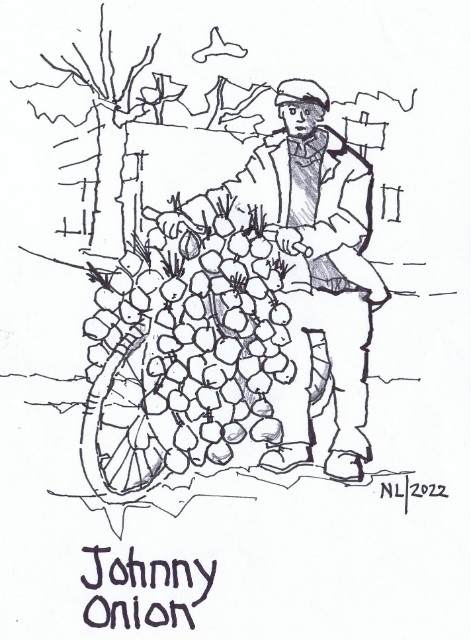 By: Nigel Lewis on 11/08/2022 101 THINGS YOU (PROBABLY) DIDN’T KNOW ABOUT WHITCHURCH 61 GWYL MABSANT
Next Monday is the 15th of August. The saint’s day for St Mary of our local parish church (thanks to Fr John Davis for confirming this date as there are 3 or 4 other dates during the year, but this one supports my story!)
In the past times, the locals relied on special days throughout the year to determine the village calendar. These included: Christmas, Easter, Whitsun, Mayday (and the other quarter days), and then the farming calendar of ploughing, seed sowing and harvest
Added to this was the celebration of the local church saint’s day. In Wales this was always called Gwyl Mabsant, and in villages up and down the land, called for a celebration
I don’t believe that there are any written records of Gwyl Mabsant in Whitchurch, but we’d love to hear if you know anything?
Summer was always a special time, especially prior to harvest as it was a quieter time; time for a village holiday!
In really ancient times villages held Revels, particularly during the Tudor period, and these were wild events. There are suggestions that Whitchurch was no different. When the Revels morphed into Gwyl Mabsant, who can tell; perhaps they continued with both!
Saint’s day celebrations varied from village to village, but usually included feasting, drinking, singing, dancing, playing silly games (and even more drinking!). we know that it was not unusual for these celebrations to last 2 or even 3 days
Where would Gwyl Mabsant have been held in the village? In the fields around the old church, or perhaps on the common
We know little about Gwyl Mabsant in the village, but we do have a record of one event in 1741. John Wesley, the famous preacher was staying overnight in Whitchurch and was invited to the celebration. It’s hard to imagine what this pious English-speaking preacher made of the partying by the Welsh-speaking locals
But, in his journals he wrote about it. When he addressed a large group of people in the Shire Hall in Cardiff in October that year, he was preaching on ‘God hath given unto us eternal life, and this life is in his son’. But he went on to say “there having been a feast in the town that day, I believed it needful to add a few words upon intemperance: and while I was saying “as for you drunkards, you have no part in this life; you should abide in death; you choose death and hell”
At that point he was heckled. A man cried out vehemently “I am one; and thither I am going”. John Wesley went on to say “But I trust God at that hour began to show him and others a more excellent way”
It’s safe to say that John Wesley was not impressed with how we Whitchurch folk celebrated our local saint’s day!
We don’t know when the Gwyl Mabsant celebrations might have finished, but probably in the 19th century waned with the coming of industrialisation and chapel growth
What is clear though, is our current Whitchurch Festival with games and booths on the common is a lingering aftermath of an ancient celebration. The photograph below shows a tug-of-war competition in 1985. Such competitions were typical of Gwyl Mabsant celebrations. In fact, it wasn’t that long ago that there was an annual ‘Grog Trot’ in the village, but that too has finished
May be, thought could be given to changing the summer festival to the 15th August (even if as a first step). What do you think?
PS Thanks to Fr John Davis for the dates of St Mary, to George Craig for the sobering information on John Wesley and to Steve Nicholas (again) for the use of the photograph
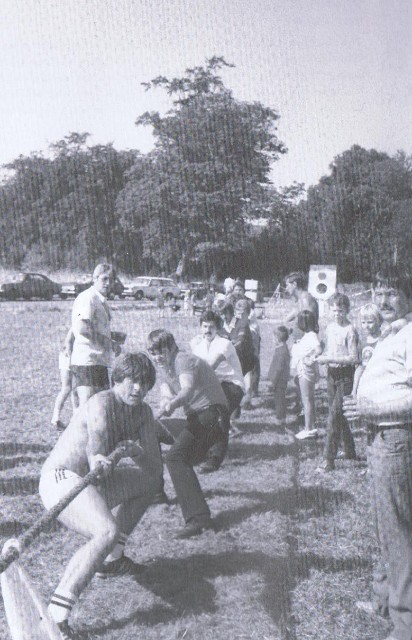 By: Nigel Lewis on 04/08/2022 101 THINGS YOU (PROBABLY) DIDN’T KNOW ABOUT WHITCHURCH 60 CORNER SHOPS
What’s the definition of a corner shop? Well, either a shop on the corner of a block, or maybe a single shop in the middle of a terrace of houses. But, definitely not a shop in a long line of other shops (or a parade). Do you agree?
When we moved to Whitchurch in the early 1970s, there were lots of corner shops, but perhaps the definition needs to be further refined; a tobacconist/newsagent (like Madley’s – later Thakker’s in Foreland Road), but perhaps not the hairdressing salon just around the corner in Heol-y-Forlan. A grocer, yes; a butcher or a baker, but probably not a florist. Not even a cobbler. What do you think?
Many ‘corner’ shops were converted from a traditional house with the front room as the shop (there are lots of examples of this on the Philog). Others were built as shops within a new development. Sometimes as a lock-up and other times with a flat over
Most of these ‘corner’ shops have been converted back into regular houses, but there are still a few tell-tale signs of the old shops if you look hard enough
On the roundabout near the library (sorry hub!) are a line of shops. Back in the 1970s they were more specialist; Best’s greengrocer, Jackson’s butcher, Ferda’s, Jennifer’s, even Tim Davies expanding grocery shop (now Tesco). But I don’t think any of these fit my definition of a ‘corner’ shop. On the opposite corner by the Methodist Church was a dairy. Maybe this was a corner shop
On Manor Way there was a shop with its own layby!
In the village proper, there were so many shops, they couldn’t be classified as ‘corner’, even if they were quite specialist. Janet remembers some of these from her childhood; Buckner’s butcher, Parkman’s sweets, the Fforest Farm Café, Seale’s delicatessen, the 2 shoe shops, Millward’s and Halewood’s, Edwards grocer – but none of them ‘corner’ shops
The sketch below from 1910, is of a thatched-roof shop near to the Maltsters; was this a corner shop?
To my shame, I was once sent by my wife on Christmas Eve to the butcher in the village, to collect the turkey that had been ordered. After queuing for (what seemed like hours), the butcher couldn’t find the order and the people behind were getting restless. I was then sent out of the shop to Dewhurst next door! I was never trusted to collect the bird again. There were too many butchers!
We need to go south of the village centre towards the Philog to find some of the older shops. Richard remembers shops from the 1930s; Ivor Jones small general store at no 27, the Ideal Stores at no 33, Alf Bayliss the greengrocer (where BroDan are now), Rowland Loveluck Jenkins tobacconist/newsagent at no 57, and everyone talks about the Victoria Bakery run by Mr Keeping, and later the Eddy family
Yes, all of these must be considered as proper corner shops (using my definition)
Then there was Phillips the grocer on the corner of Gwauntreoda Road which was destroyed by bombing in WW2
And a chip shop at no 102, just qualifies as a corner shop (or does it?)
Adjacent to Flay’s farm, Mrs Rogers and her son ran the Post Office (I can remember the pillar box outside), was this a corner shop? It was on the corner, so probably yes
Then there are shops further away in Old Church Road, the Post Office by Park Crescent, another Post Office in Heol Don and more recently, the parade of shops in Westbourne Crescent and at Tynewydd. If we drift into Llandaff North, Tongwynlais, Birchgrove and into Rhiwbina there are so many more
What memories does all this invoke? What were the shops which were important to you, and can anyone remember what did they sell? We’d love to hear
Perhaps we’ll look another time at the shops in the village centre, the ‘non-corner’ shops Don't forget our walk from the Plough to Manor Way on 23rd August - see our events page and do book in .
 By: Nigel Lewis on 28/07/2022 101 THINGS YOU (PROBABLY) DIDN’T KNOW ABOUT WHITCHURCH
59 WHITCHURCH RUGBY CLUB
I need to tread carefully with this blog, as there are lots of Whitchurch people who have a great interest and knowledge in this. I have to rely on others (again) for the information
Most of my knowledge about the club is relatively recent, sitting in the bar drinking a pint and enjoying the camaraderie
History books tell us that the Laws (not rules mind you) of the game were first standardised in 1870 or thereabouts, and the first game of Football played in Whitchurch was in 1885, just 15 years later. There is confusion about what the game was called even; Football, rather than association football (soccer). Association football apparently dates from 1863 with its rules, and introduced into Wales by 1876
Perhaps for clarity I should refer to the game as rugby football for the rest of this blog!
If I thought that the naming was difficult enough, the scoring was even more fraught. According to a match report in the Western Mail dated 27th October 1885 (copied below) between Whitchurch Football Club and Penarth resulted in a win for Penarth with 3 goals and 2 tries against 1 try and 1 touchdown from Whitchurch. Matters were decided by a majority of goals scored
The match didn’t live up to much, but then again it was their first proper match
Thanks to Gary for the early history of the club, and how, after some debate, the date of formation was finally settled as September 1885, making the club 137 years old this year
Whitchurch RFC, from its inception seems to have been centred at the Fox & Hounds public house in Old Church Road, playing their home matches on what is now the hockey pitch of Whitchurch High School
Terry is also a mine of information and has provided a lot of what now follows:
It seems there are records of Whitchurch playing Taffs Well on 20th November 1885, just a month after their first game against Penarth. A brief report of the game reads: ‘Play owing to a very unpleasant incident came to an abrupt conclusion, it was decided that the result should be a draw’. No further explanation was offered!
In July 1899 the South Wales Echo reported that the AGM of the club was held at the Fox & Hounds. The report is copied below, and it would be fascinating to know what happened to all the people mentioned. We already know about JH Cory (who the following year moved into his posh new house at Coryton). But who was the hon sec Mr D Davies and where was Skier Villas?
The finances seemed sound and the fixture list for the upcoming season boded well
A few years later, a fixture list for 1904-05 shows a disappointing season playing a range of clubs such as St Saviours on 3rd September, Aberdare, Blaina and then Weston-Super-Mare on 24th September. However, on 1st October, Whitchurch RFC played Old Monktonians and won 11-0!
As an aside, and by digging further into the information provided by Bob Brinning, it seems that Old Monktonians were a precursor to the Glamorgan Wanderers team. They played their home matches in Whitchurch too, on the Polo Field. Their base was at the Three Elms public house adjacent. It think though, that’s a story for another time
Terry has quite a family connection with Whitchurch RFC, and tells of his paternal grandfather (and 2 great uncles) all playing together in April 1900. Does anyone have information on other families with brothers playing together?
Apparently, at some point, the club merged with the Melingriffith works team and were known as ‘The Melins’. With the demise of the Tinworks, many men left the area, and this saw a decline in the club’s activities. There’s no record of this though. Does anyone know more?
1958 saw a recovery and the club was once again centred at the Fox & Hounds, and now playing their games, as they do today, at Caedelyn Park
After a few years, the club was forced to move, first to the Plough, then to the Hollybush and then finally back to the Fox & Hounds. This couldn’t last, and the club began to look at acquiring its own base. Fortunately, the old Melingriffith Band Hall with adjacent land became available. Sterling work from Gwyn Hopkins, then secretary, negotiated a loan from Webb’s Brewery of Aberbeeg to acquire the old hall and land
Now, as a well-established club within the Cardiff and District, Whitchurch RFC enjoyed a series of successful seasons through the 1960s, 70s and 80s. The 1990s was a particularly fruitful period, with Whitchurch winning the Mallet Cup in 1991
The development of their land for prestigious housing c2005 allowed the club to build a delightful clubhouse with facilities that many rugby clubs would be envious of
Which brings the story back to the beginning with me drinking a pint in the bar
Happy reading. More next time!
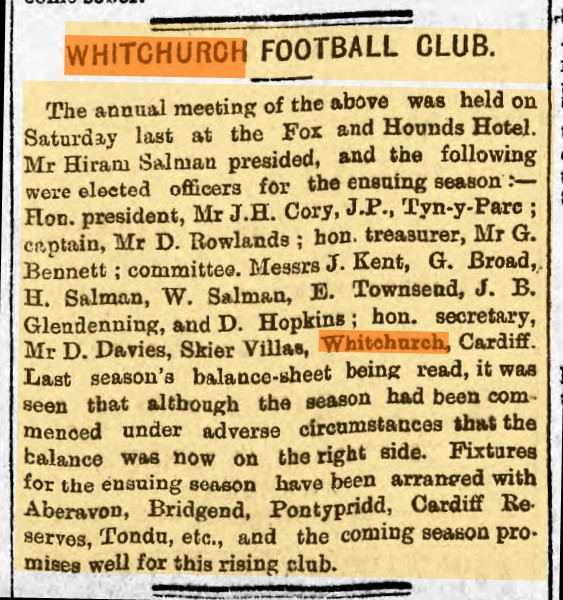 By: Nigel Lewis on 21/07/2022 101 THINGS YOU (PROBABLY) DIDN’T KNOW ABOUT WHITCHURCH 58 DENTISTS
My dad loved Franks Mints. They were made in Newport and were individually wrapped in cellophane. They were square-shaped with light brown and brown stripes, and they were always a ‘go-to’ present for him for birthdays and Christmas. Does anyone remember Franks Mints?
And for me, post-rationing, there were Wine Gums, American Hard Gums and tiny Midget Gems. Then there were sherbet fountains and liquorice sticks. All so lovely! I was never keen on Dolly Mixture, but I can always remember choosing my sweets from the big glass jars on display and then having them weighed and dropped into little paper bags, always finished with a twist by the shopkeeper
What were your favourites?
And where were the shops in Whitchurch where you could buy such confections?
The reason for all of this reminiscing is that I’ve just been to the dentist for a check-up (only now getting back to proper ‘normal’ after the pandemic problems), and I’m so pleased that I was given a clean bill of health
But of course, my mind went back to the flipside of childhood sweets and sweetshops; the School Dentist! Because we lived in Cathays, we children went to Gladstone School, and I can still remember how we were all lined up in the hall for a yearly dental check-up; and then an appointment to have treatment (it seemed always to be an extraction under anaesthetic). Is it just me or do others remember the smell of the rubber mask?
We went to the clinic in North Road for treatment, and I still shudder every time I drive past, even today
Where did Whitchurch children go for treatment in those post-war days? I read a note recently from Bunty suggesting that Tabernacle was used by the school dentist. Her memories c1940 are just like mine! Diane added that they only used local anaesthetic at Tabernacle not gas. Was it in the church or the church hall? Jan, the church secretary at Tabernacle doesn’t know. Does anyone have any memories?
Back to sweets
Locals still talk about the lovely smells emanating from the Jupps Sweets factory near the common. What sweets did they make? I’ve seen a few old photographs of the building, and also a few of the interior. The photograph below shows sweet-making about 1950 (thanks yet again to Steve Nicholas for the image). I wonder what it was like to work there?
What about dentists? Further north, there was a dentist in the Laurels a hundred years ago, and it’s strange that there’s still a dental practice there now. Were there any others?
The Pines in Old Church Road is now a swanky dentist and Chris Dalton in Bishops Road (now Holmes’) is another. And what about dentists in Llandaff North, Rhiwbina and Tongwynlais, were there any?
We’ve looked previously at Templar Malins (his advert was on the first buses in Whitchurch) offering false teeth from his practice in Queen Street
We’re so fortunate that we have ‘proper’ dentists now, and that they take such great care of us, and quite gentle too. But memories of toothache and ‘gas’ extractions are still burned into my memory. Does anyone share my phobias?
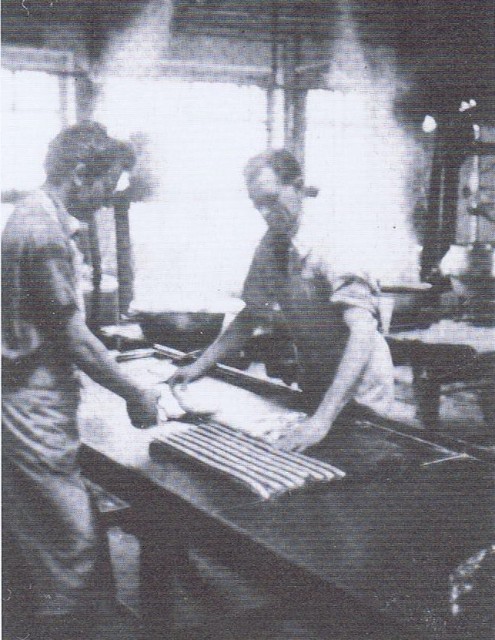 By: Nigel Lewis on 14/07/2022 101 THINGS YOU (PROBABLY) DIDN’T KNOW ABOUT WHITCHURCH 57 WAR MEMORIAL
There can be few alive today who can begin to understand the carnage of World War One. The numbers of fresh-faced young men (mainly men in those days) who had volunteered to take part in the ‘great adventure’ of a European War
Today (15th July) is the 99th anniversary of the unveiling of the War Memorial here in Whitchurch
Ceri Stennett and Gwyn Prescott have written 2 books on the fallen heroes of our village in both WW1 and WW2, and I’m grateful that they have allowed me to use so much of their researches for this blog. Ceri, in particular, has discovered a lot of information about the story of the memorial and the ceremony itself
It seems that just after the end of hostilities there began a great nationwide discussion about how to commemorate the peace, and to recognise the enormous loss. Like so many villages across the country, Whitchurch began this discussion and a parish meeting was held in the YMCA Hut (where was this I wonder?) where various suggestions were made, including the establishment of some kind of institute (as found in many valley towns); perhaps provision for the dependants of the fallen, or possibly scholarships for the children of servicemen. Importantly, it was felt that the monies for the project should be raised solely from the local people of the parish and that the views of the returned servicemen should also be sought
Unsurprisingly, a committee was formed of 20 local worthies who set about planning. A finance subcommittee was also formed to raise funds
Meetings were held very regularly, but little progress was made. It was agreed early on that a memorial hall would be best, but finding land was proving difficult. The Church looked at land adjacent to St Mary’s Churchyard, the site of the YMCA Hall was considered, even buying one of the old mansions in the village (Plas-y-Llan and The Pines were looked at). All to no avail
Time was marching on and nothing seemed to happen (apart from regular committee meetings!). By June 1922, the committee reluctantly acknowledged that a memorial hall would be impossible, and that a monument should be built instead. But what form should it take, and where should it be located? A job for a new committee!
Different locations within the village were considered, and visits to memorials in Radyr, Wenvoe and Lisvane were made. There was talk of a memorial in the style of one at Llandrindod Wells as a possibility. By November 1922 there was agreement that the memorial should be built in front of the library, and that estimates of cost should be invited from Messrs Clarke of Llandaff and also Boulton of Cheltenham
At the committee meeting of 18th January 1923, the design from Boulton was accepted, and the wording on the memorial agreed, ‘The Men of Whitchurch’ was preferred to ‘The Men of the Parish of Whitchurch)
The memorial was to have a bronze figure of a soldier in uniform with his rifle reversed, upon a grey granite base and tiered steps, and surrounded by a light railing. All of this for the cost of £1,000
It was considered very important that the names of the fallen should be inscribed on the memorial, and the committee placed advertisements in the local newspapers and left leaflets at the library and other prominent places asking for relatives to come forward. By the end of January 1923, 110 names had been received, and the list was posted at the library
To continue with the fundraising, a rugby match was held between Glamorgan Wanderers and the Glamorgan Police. I wonder where this was held and what was the score? Anyway, the sum of £37/18/9d was raised. With other donations, the cost seemed to have been raised
In the end, 116 names were inscribed, although Ceri Stennett has discovered that there were many more names that should have been included
Work progressed, and Messrs Boulton advised that the memorial would be completed and ready for unveiling by 14th July. Arrangements for a ceremony were then made
A detailed programme was prepared, and the Bishop of Llandaff invited. There were to be full military arrangements, a male voice choir, brass band, and of course the committee. Albert Bullock who was chair, would lay a laurel wreath
So, on Sunday 15th July 1923, the memorial was unveiled with much pomp and ceremony by the Earl of Plymouth. There was a guard of honour, singing and addresses. The local newspapers reported that there were ‘thousands’ of local residents in attendance. The photograph of the occasion (from Ceri’s book) shows the unveiling
Next year, will be the centenary of that unveiling, and I’m sure that the village will want to commemorate that occasion in a right and proper way
It falls to us who are here today to ensure the flame of remembrance continues on this 99th anniversary
Back in July 1923, the memory of the Great War would have been painfully raw to so many. As we say when we gather at the memorial every November ‘We Will Remember Them’. We really must 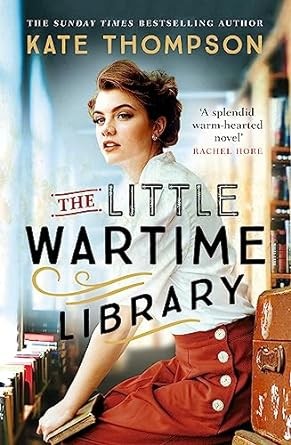 By: Nigel Lewis on 08/07/2022 101 THINGS YOU (PROBABLY) DIDN’T KNOW ABOUT WHITCHURCH 56 JOHN CORNISH
Our first blog in this series was in early May last year, when we discovered the oldest tree in the village. Since then, we’ve been dipping into the history of Whitchurch, sometimes finding strange and fascinating facts
This time, it’s no different; we’re looking at a man named John Cornish. We first find him in the 1841 census when, at the age of 30 he was living in Heol Don with the occupation of ‘flour merchant’
It’s hard to picture, but back in 1841 Heol Don was no more than a green lane with hedgerows, running from Llandaff (and Llandaff North) to the Tithe Barn. John Cornish lived in the only house on Heol Don. Was this the thatched-roof Heol Don Cottage? There’s another old house on the opposite corner, but that doesn’t show on the tithe map and may be a little younger
The house that John Cornish lived in must have been more than a cottage, as he was living there with his wife and 2 children, all looked after by 2 servants (and also using it for his business). The old photograph below shows Heol Don Cottage with its thatched roof, but probably much later
So, why was a flour merchant living in Heol Don? We know that there was a corn mill at Melingriffith, another one at Little Mill, a further mill at Llandaff Yard (North) and at least 2 more in Tongwynlais. Lots of opportunity for a flour merchant to buy the milled flour locally and to sell to the rapidly growing population of the village and the local area
Ten years later, he’s still in Heol Don with his wife and 2 children, but now he refers to himself as a general shop-keeper with a live-in governess for the children, and 3 servants. Things were obviously looking up; I can’t believe that he was just a ‘general’ shopkeeper though. The house must have been substantial, and probably had barns and outhouses for the flour and general provisions. It would have had stabling too
By the 1861 census he’s moved, and was listed as living in the ‘Company Shop’ at Melingriffith, working for the Bookers. John was living with his wife, now with 5 children and 4 servants. With the shop he had an assistant, a general assistant and a letter carrier (all living in). It’s interesting to see that the Bookers living in the big house at Velindre didn’t have many more servants than John Cornish
I wonder where the shop was, and what it was like? It must have been quite substantial to employ all those staff (and for all the hundreds of workers at the mill using it). The tinworks and all of the buildings have long been demolished so we’ll never know, but the Company Store must have been a substantial building near to the entrance
TW Booker (junior) who owned Melingriffith Tinworks was unlike his father, and was considered to be a very difficult (but sadly typical) Victorian mill owner. He paid his workers, not in money but, in tokens which could only be used in his company shop!
What happened after?
Melingriffith Tinworks continued under the Booker family for another 20 years or so before a series of worldwide problems and a war in Europe in the 1880s caused the business to collapse into an enormous financial pit
So, what became of John Cornish, his family and his shopworkers? Does he or his family appear in later census returns. Does anyone know?
Do any of the family still live in the area? We’d love to learn mo  By: Nigel Lewis on 30/06/2022 101 THINGS YOU (PROBABLY) DIDN’T KNOW ABOUT WHITCHURCH # 55 WALKING WHITCHURCH HERITAGE
On Tuesday evening we completed our first heritage walk. We ambled along Old Church Road from the Plough, finishing at the site of Whitchurch Castle. In spite of the weather forecast, over 50 folk joined us (so many in fact that we split into 2 groups). From the feedback, everyone seemed to enjoy the event, and the really hardy folk joined us in the Fox & Hounds for a catchup (I had to have a medicinal Reverend James because I’d done so much talking on the walk!)
With the help of ‘Men in Sheds’, colourful posts and posters were fixed all along the road in 15 locations describing some of the history and people from the neighbourhood. The posts and posters will remain up for a short period, so if you get the chance, look out for them!
We’ve printed special maps of the walk, together with an illustrated booklet (in Welsh and English), describing all of the locations along the walk. The maps and booklets are available free of charge (if you’d like to give a donation though, that’d be good) at our AWEN stall at the Festival Fete on Whitchurch Common on Saturday. Why not come along and say hi. The maps and booklets will also be available at the library/hub as well, so you can enjoy the heritage walk yourselves whenever you like
The booklets are filled with black-and-white illustrations of our village history (produced by Anthony Evans, Chris Griffin and yours truly), and make a lovely keepsake
However, we think that these booklets might make an interesting colouring competition. If any adults or children would like to colour the booklets as a summer activity we’d be delighted. They can be returned to the library/hub at the end of the school holidays, and we’ll ask a prominent local person to choose the best. There’ll be prizes of course
We’re already thinking about our second walk (for the autumn), and this time we’re planning to walk from the Common to the Philog. We already have lots of ideas, but if you’ve got any family stories, photographs or items of interest for the walk, why not bring them along to the fete on Saturday. If you can’t make it, why not share your memories with us on Facebook
As a little taster of what you might discover on this next walk is the story of Richard Lougher. He was the blacksmith who had his forge alongside the brook at the 3 Elms pub. Richard and his wife were well known characters in the village, and lived at the bottom end of the Philog. Every Sunday, he and his wife would solemnly walk (dressed all in black) from the Philog to St Mary’s Church, with Richard wearing his very recognisable top hat!
Does anyone have any stories about Richard and his wife? We’d love to hear
We’re also thinking about other walks around the village. Do you have any ideas for where they might be? Perhaps around Melingriffith or the Hollybush? Please share  By: Nigel Lewis on 24/06/2022 101 THINGS YOU (PROBABLY) DIDN’T KNOW ABOUT WHITCHURCH 54 WHITCHURCH SPORTSMEN In the village we seem to be blessed with very famous sportspeople, a fact that even the national newspapers seem to have noted. However, there are a few sportsmen of yesteryear that seem to have been forgotten, and it seems only right to restore their names to public attention:
YOYO Paul of Heol Gwrgan has been in touch to tell us about ‘Steve’ who lived just behind Old Church Road. At the end of the 1950s, Steve was a champion yoyo exponent with international acclaim. He was in great demand for yoyo displays in both the UK and USA. No one seems to know any more about Steve; where he lived and what happened to him, but there must be someone in the village who can help. We’d love to know more
CYCLING We’re all proud of our local cyclist Chris Harris and his shop in the village, but 120 years ago there was another local with cycling prowess
Billy Brian of Whitchurch was famous in the early years of the 20th century as Wales’s greatest trick cyclist. He was presented with a silver cup in 1904 (one of his most prized possessions) for cycling backwards from Newport to the Moon & Stars pub in Cardiff!
Such was his talent in this unlikely field of human endeavour that the great German trick-cyclist Bud Snyder, who was appearing at the Empire Theatre in Cardiff, begged Billy to join him professionally. Billy, however, seemed content to remain in his secure job in Cardiff Docks, and trick-cycling remained just a hobby. He continued his displays well into his fifties
We’ve managed to find a photograph of Billy in 1904 (see below) performing an unusual trick on his bike. This looks scary, and we don’t recommend anyone try this at home! Does anyone know any more about this local sporting hero? And where was the Moon & Stars pub?
Many thanks to Stewart Williams for the information and Wales Online for the photo
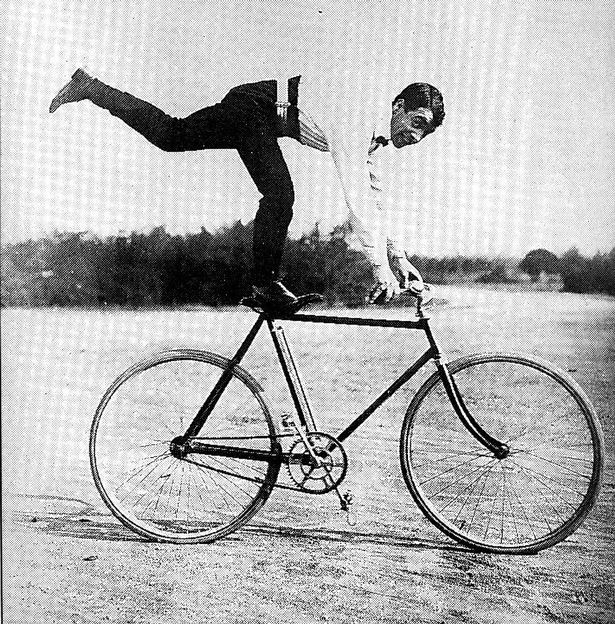 By: Nigel Lewis on 16/06/2022 101 Things you probably did not know about Whitchurch # 53 VELINDRE IN IT’S PRIME
When do you think you’ll be in your prime? If you’re honest, you might say that your prime years are still ahead (not many would volunteer that their best has passed them by already!)
Is this the same with a house? You might like DIY, forever pottering around with paint and wallpaper, catching up with repairs, or you might have plans for a makeover or even an extension. And what about the gardens?
I believe Velindre was a bit like that, so it might be difficult to identify exactly when it was in it’s ‘prime’. In previous blogs we’ve looked at how Velindre developed from a traditional Welsh longhouse into a smart residence for the Quaker ironmasters, and then into something of a grand house for the newlywed couple of TW Booker and his wife Jane by 1820
It's difficult to understand how the house might have developed over many decades, when there are no plans, images or even photographs. All that seems to be available are hints from the tithe map of 1840 and the OS maps of 1880 and 1900
By the time the Bookers moved in, the house had been already substantially rebuilt, and then further remodelled. By 1840, stables had been added at the rear, kitchen and servants’ wings provided, and then the ‘old’ house with a new carriage entrance to the west front
Over the next 40 years, Velindre grew even more into a glittering pile, with even more remodelling. New elevations reflecting the changing styles had been provided, and totally redesigned interiors reflecting the latest technologies
There is a super book called ‘Das Engliche Haus’ published in 1904 which describes wonderfully the style and interiors of grand houses in the UK in the later Victorian times and what facilities they might have had. This provides some great clues about Velindre at that time
We are told that by the 1860s, even the lowliest of grand houses would have had a magnificent hallway, a grand dining room and a ‘withdrawing’ room for the ladies, and a billiards room. A ‘morning’ room would be located to enjoy the early light, and a ‘library/study’ provided for the owner to deal with his important affairs (the head was almost always a man in those days!). The family bedrooms were large with separate dressing rooms for husband and wife. Of course, at this time, there were no ‘facilities’ so discreet pots and chambers would have to be provided in special curtained corners and cupboards, to be emptied and replaced regularly during the day. Every one of the large rooms would have been heated by coal fires, and the live-in servants would have been constantly tending to them
The OS map of 1880 shows Velindre had grown, with an even bigger footprint and yet another revised entrance. The ground floor rooms seem to have been completely remodelled to reflect the latest styles, and the first floor, via a very grand staircase, would have provided bedrooms for the Bookers (with a separate wing of children’s rooms and nursery). Staff accommodation would have been located within attics and adjacent to the service areas. The kitchens would have looked very much like those at Tredegar House, with open ovens and the like, and with water still drawn from the well adjacent
Jan Hughes has managed to find an incredibly grainy photograph of Velindre, showing what the house might have looked like (just before its final demolition). Based on this photograph, the sketch below attempts to show Velindre at its sparkling best. It shows the house with a series of tall Georgian-proportioned windows and bays looking south and west, with the hint of a grand glazed lantern-light over the staircase beyond. You can also see the numerous chimneys on the slated roofs. The house sits in landscaped grounds and visitors are delivered at the entrance, now located on the south face
Between 1860 and 1880, Velindre and its gardens had been transformed into a pleasure palace. The driveway had been extended from a new gatehouse cottage (the only bit of Velindre still in existence) finishing with a swept flourish at the house. The grounds around the house would have been densely planted. Whilst Velindre has been long gone, many of the garden trees planted at the time still exist
The gardens around the house would have been very special and designed for promenading. The OS map shows long borders flanking the lawns (which would have been immaculate). We know that the extensive greenhouses beyond were heated in winter, to provide pineapples and other exotic fruit for the table
TW Booker Blakemore MP had died in 1858 and afterwards, Velindre was occupied by his son TW Booker (junior) and his family. He was far more of a harsh Victorian Ironmaster than his father, and his attitude to servants and workers at the tinplate works was very different. He was more feared than loved. He clearly loved the glittering life, but at no cost to himself
We’ll need to look again at the demise of the Booker empire after 1880
In the meantime, does anyone have any knowledge of Velindre House and the servants during its glittering prime? We’d love to hear 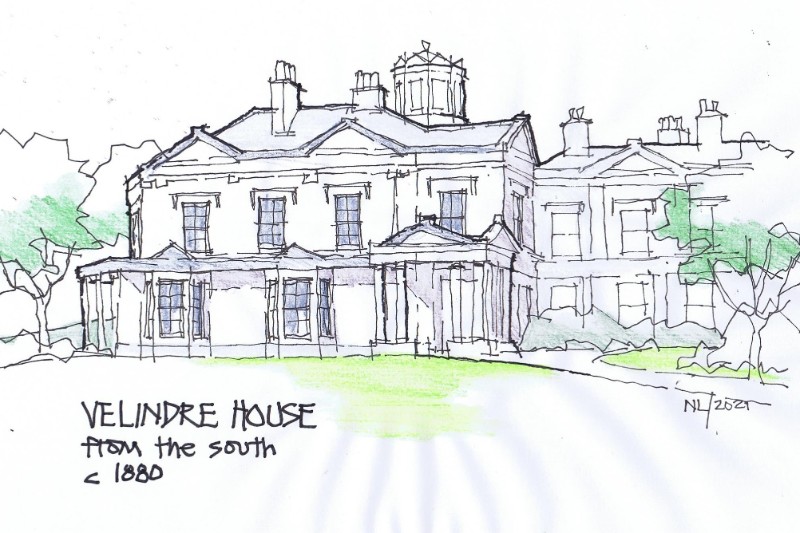 By: Nigel Lewis on 08/06/2022 101 THINGS YOU (PROBABLY) DIDN’T KNOW ABOUT WHITCHURCH 52 WHITCHURCH HOSPITAL
To start the second half of our ‘101 Things’, I thought we could look at one of the most prominent buildings remaining in the village, Whitchurch Hospital
We all know where it is, the splendid water tower is one of the village landmarks, and yet few of us know much about it. Even now, there is something of a stigma in even mentioning the place. Edgar Chappell in his authorative book on the village has just 2 passing mentions in over 240 pages!
The ariel photograph below gives a flavour of the hospital in its early years
It opened in 1908 and is now well over one hundred years old, and even though it’s been neglected and boarded up for years it is still very important to the village and worth knowing more
Built by Cardiff Corporation as a Lunatic Asylum (outside the town boundaries because of the stigma), it was designed with 10 wards to accommodate 750 patients (5 male wards and 5 female) and with a staff of 150
The design with its ‘echelon’ plan form was considered cutting-edge at the time, with each ward have large windows open to the sun and sky. Beds could be taken outside in the summer months
The hospital was huge, with a footprint of 5 acres. It boasted its own theatre, gymnasium and 2 miles of corridors! It even had its own fire station. Opposite was its own chapel (with seating for 900 people) and extensive outdoor sports and bowls facilities
Ty Clyd Farm to the north was part of the site, so that the hospital could be self-sufficient. The whole thing extended to over 115 acres.
Around the hospital, the grounds had been landscaped by William Pettigrew, who was the first Chief Parks Officer for Cardiff. Many of his trees remain today
Arranged around the wards were 6 octagonal seating pavilions, and there was even a bandstand. In the early days, the hospital boasted its own orchestra too
The whole thing was designed to have the appearance of a grand stately home. Ironic really as Velindre (the nearest Whitchurch had to a grand house), had been demolished as part of the development
The very first medical superintendent was Edwin Goodhall, and it was he who insisted that the place be called ‘Whitchurch Mental Hospital’ rather than ‘Cardiff Lunatic Asylum’. Edwin remained in post for the first 20 years
Gwawr Falconbridge and the Friends of Whitchurch Hospital have worked tirelessly to better inform us of how the hospital grew and changed over the years. The have an incredible archive and they are to be saluted
Many of the patients at Whitchurch remained for long periods, some for their entire lives, so its surprising to realise that although there was a large chapel on site, there is no graveyard. So where were the patients (often with no families) buried when they died? Does anyone know?
There’s so much more to tell; how Whitchurch received its first public park, what happened during 2 world wars, and what’s happening now. We’ll come back again to try to answer some of this
In the meantime, if you have any history of the hospital you would like to share, please get in touch
 By: Nigel Lewis on 03/06/2022 101 THINGS YOU (PROBABLY) DIDN’T KNOW ABOUT WHITCHURCH
51 Celebration Time
If you’ve stuck with this blog since April 2021, you can now celebrate on reaching the halfway point in this series of 101 Things You (Probably) Didn’t Know About Whitchurch!
Item 1 was all about the oldest (surviving) tree in the village. Along the way we’ve looked at the Chelsea Pensioner families in the 1860s, old pubs, local builders, and some local celebrities of yesteryear
We’ve dipped in an out of local places and names, and of famous families. We’ve even considered what the village might have been like in the past (even the distant past)
So much has been discovered, and I’ve learned an incredible amount from the fantastic feedback that’s been generated over the past year-and-a-bit
And we’re still only halfway there! So much more to discover
It’s beginning to dawn on me about what makes a village? It’s obviously the history, the surviving heritage and all of the bumps and scrapes that the village has had to contend with over the last 1,000 years or so. But so much more than this; it’s the people, the characters and their legacies which provide the building blocks. But history is not ancient or dusty, we’re living through it even now, Covid, the Ukraine conflict, even our current cost-of-living crisis. We are ‘history’. We are Whitchurch
And we need to record it. We owe it to all those who will be following us in the 1,000+ years to come!
Oh! And I’ve just remembered, there’s another celebration this weekend too. The platinum anniversary of Elizabeth II ascending to the throne, 70 years. I’ve still got a China mug given to me when I first started school celebrating the coronation of the queen in June 1953. I’m surprised and delighted that the mug has survived so many house-moves and spring-cleaning sessions! We’ve also got a tinplate cup (slightly chipped) dated 1837 with Queen Victoria’s image on it (not sure where that one came from). This was to celebrate her ascension on 20th June that year, 185 years ago. I wonder how Whitchurch would have celebrated then? And I wonder how the village will celebrate our special events in the future, even more bank holidays?
Anyway, happy celebration!
PS back to normal next week! It’s all downhill from now!
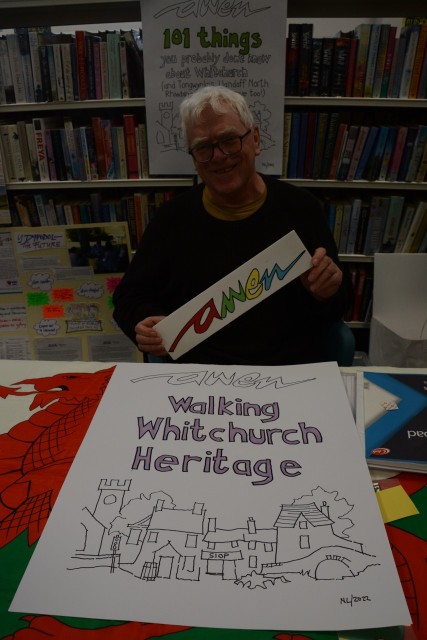 By: Nigel Lewis on 26/05/2022 101 THINGS YOU (PROBABLY) DIDN’T KNOW ABOUT WHITCHURCH 50 Further Memories from Gill
Last week we looked at some of the memories of ‘Gill’, a Whitchurch local, growing up in the 1950s and 60s. She had lots to share about her homelife, so this week I thought we could look at some of her other memories of growing up. She remembers:
Mum and my aunt worked in a local fruiters shop, so at home we always had lots of ‘touched’ fruit and veg. Later I can remember we had Vesta Curry, Erin dried peas and Smash potato
Treats included Eldorado ice-cream bought from the Mayfair shop (was it by Bethel church?)
Holidays were always with my two aunts in Trecco Bay or Tenby. No car back then, but bus or train from Llandaff to Barry Island, Penarth baths or Ponty park
Memories of Sundays were always of Sunday School, then lunch and possibly a walk down the canal; and always playing card games after tea. Sometimes we’d listen or sing to my aunties 76rpm records
I passed the 11+ for Whitchurch Grammar and my grandfather bought me a leather satchel from ‘Mac the Cobbler’ in Old Church Road. The uniform was very expensive and was bought with help from the family from Evan Roberts in Kingsway. My sister who was older, passed to Penarth Grammar and caught the bus and train to school for 6 years!
When I was 16, I became an ‘Avon Lady’. I’d go out in my mini skirt and pvc boots and a lovely Avon sample case. I sold the lot!
I had a Saturday job in the local shoe shop in the village and my best friend sold fish in Birds. When we went out to town to the Top Rank, she always smelt a bit!
At that time, in the village there were still some houses, but I remember the shops; the toy shop, the saddler, the corn stores (for pet and gardening stuff), and of course Anstee’s the flower shop, and the Bon Marche with its amazing suction pipe system to send £s to the cashier. A friend’s house was demolished to make way for Kwiksave on the corner of Bishops Road
By the Library we had Ferda’s wool and clothes shop, Bests Fruiters, Jacksons butchers, the Malvern with its revolving sweet machine and the milk carton machine. Then there was Burleys for paint and wallpaper. You could get everything in Whitchurch
Who can forget the Monico cinema (where I went on my first date), or the Plaza, before they built the flyover, and of course the Rialto off Old Church Road?
As a child I loved the Library and can remember how it was set out with the old men in the reading room and the now antiquated card system. I use the library regularly even today
I hope all this has jogged everyone’s memories and conveys how wonderful Whitchurch is and how it shaped my formative years
What about everyone else? What shops do you remember? Do you have any photographs you’d like to share?  By: Nigel Lewis on 20/05/2022 101 THINGS YOU (PROBABLY) DIDN’T KNOW ABOUT WHITCHURCH 49 Memories
Over the past year, we’ve been looking at so many places and people from long ago, I thought it would be nice to share some of the memories of a Whitchurch ‘local’ with more recent memories of the village
Gill (not her real name) was born in 1951, with parents and grandparents living locally. Both sets of grandparents worked at Melingriffith, and her mum was born in a cottage on Forest Farm
Gill was brought up in a terraced house on Tynypwll Road, which was rented from the Millward family (and who owned the whole terrace). Rent just after the war was about 7/6d a week. Gill’s memories of the house include:
Until I was about 14, we had a lovely coal fire and blacklead range, and Mr Merrey the coalman had to bring all the coal through the house as there was no lane. Eventually we had a Debonair gas fire
The kitchen was tiny, with hot water from a geyser plus a boiler and mangle for the clothes. The bottom part of the kitchen walls were clad in Melingriffith tin sheets to cover the damp
There was an outside toilet only with a wide wooden bench for newspaper and candles
We had a tin bath (hanging up), until we got a (freezing cold) bathroom extension as there was no central heating then
The bedrooms were also freezing, with lino and the odd rug
And the key to the front door was kept on a string hanging just behind the letterbox
All the decorating was done by an aunt (who often hung the wallpaper upside down!)
Rats! You could hear them in the walls as they had the run of the whole terrace roof
The back gardens were long and we kept 12 chickens and sold the eggs, and grew vegetables
There was a gas lamppost outside the house which was lit by ‘Aubrey’. A tiny man who arrived on his bike
When we finally had a phone in the house we had a party line, and neighbours would often come in to make a call. The operator would tell them how much to repay us for the call
We’ll catch up with Gill another time and learn a little of her memories of the local shops and social life in the village
If this little article has jogged a few memories, or if you’d like to tell us about some of your own family stories, why not send us an email or a photograph at awen.cymru@gmail.com. it doesn’t need to be a whole article, just a line or two. We’d love to hear from you By: Nigel Lewis on 13/05/2022 101 THINGS YOU (PROBABLY) DIDN’T KNOW ABOUT WHITCHURCH 48 The Other Mill
Pretty much everyone in the village knows about Melingriffith, Griffith’s Mill on the bank of the River Taff. It seems that it had been there since time immemorial, but the earliest mention is in 1158 when it was described as ‘burnt down’, destroyed by Welsh insurgents fighting the Norman incomers
But there were other mills locally too. There were at least two mills in Tongwynlais, a large mill sited on the river and another on the fast-flowing stream near Castell Coch, and also one in Llandaff North
There was a second mill in Whitchurch too, just behind the Common called Y Felin Fach, the Little Mill. There’s nothing left of the mill now except giving its name to the housing estate built on the site
There must be early references to the mill, but the earliest information found so far is from the Tithe Map of 1840. This notes that the tenant was Edward Williams and that the land was owned by Lord Dynevor, the mill must have been older, as the Taff Vale Railway constructed in the 1830’s divided the mill building and pond from its garden to the south. The mill had been strategically located to take advantage of the natural embankment so that probably a large overshot water wheel could drive the mill stones. A long mill stream had been constructed in a big curve, taking water from the Whitchurch Brook across fields to the mill and then to discharge into the River Taff further south. At the mill, a generous millpond had been constructed for times when the stream couldn’t provide sufficient water to drive the wheel
There were no proper roads back then, so access to the mill was via a simple track off the Merthyr Road (near Island Cottage) so that corn could be delivered from nearby farms
In the census of 1841, Edward Williams (the tenant) did not occupy the mill, rather he was the farmer of Pentre Farm, with his wife Cecile and 4 servants. The mill was occupied by Elizabeth Harding (a widow aged 38 described as a miller) with her 5 children and a lodger. Probably her husband would have been the miller and died a few years earlier. The family might have lived in the mill, but there was a second building adjacent which might have been a separate cottage
So how old would the mill have been? Possibly a few hundred years earlier than the buildings shown on the Tithe map, and perhaps older still. The line of the millstream on the maps seems a natural part of the old field system
A 17th century mill would traditionally have been constructed of local stone with a thatched roof and an enormous mill wheel. The technology for grinding corn was well known and, even the large mill wheel could have been constructed locally
Most of the fields around were arable, growing wheat (for bread), barley (mainly for beer) and oats for animal fodder. Whilst the population of Whitchurch was still quite small at that time, the numbers of farm animals needing fodder was large. So, a second mill in the village would have been quite sustainable. As the population of Whitchurch grew, the demand would only have increased
So, when did the mill finish, and when was it demolished? What became of Elizabeth Harding and her family? Does anyone know any more?
Terry Chard who lives very locally has provided a little insight. In the 1960’s, some of the stone buildings were still there, although quite ruinous, but a wonderful playground for the local children
In fact, Terry has provided a copy of the painting below showing Little Mill in the 1940’s, painted by the son of wartime refugees who were living in Llandaff North at the time. I’m sure Terry can add to the story, but can anyone else help? 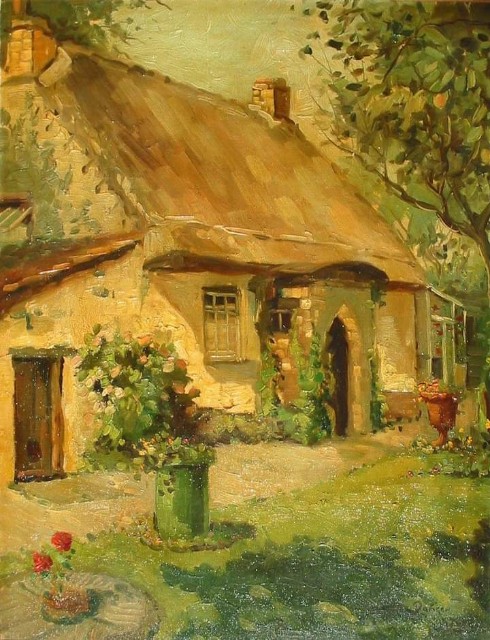 By: Nigel Lewis on 10/05/2022 101 THINGS YOU (PROBABLY) DIDN’T KNOW ABOUT WHITCHURCH A Little Exra One of my favourite words is ‘serendipity’ – a happy accident. Just when I was beginning to think I’d never actually see any of the old houses of Whitchurch that I’ve been writing about still standing, I came across one in the most unlikely of circumstances; serendipity!
I happened to be walking through Whitchurch Village last Saturday afternoon and glanced in the window of one of our local estate agents. In the top left-hand corner were the details of a house in Tongwynlais called Heol-y-Ynys (on the market for a snip at £800k). I cheekily called in and asked for some details, which they obligingly provided. I was intrigued by the name and the photographs, and later with the description of the rooms
Why my interest, you might ask? Because this is The Ynys, the first home of TW Booker Blakemore and his new wife Jane when they married about 1820 (before moving on to Velindre)
The estate agent’s details are fascinating and show grand rooms with (still) lots of period detailing, an enormous entrance hallway with a super-grand staircase and a lofty skylight over. There were lots of reception rooms, bedrooms and secondary utility rooms, all within 8 acres of grounds alongside the River Taff
Obviously, the house has been altered and extended over the ensuing years, but it still gives a flavour of life for the gentry in the late-Georgian times
I’ve tried to produce a quick sketch of the garden elevation (see below) with the large windows, stuccoed walls and hipped slated roofs. Sadly, the chimneys have all been removed and some detailing lost, and there are extensions all round. Nonetheless, it is easy to picture men in long jackets and breeches, and ladies with their glamourous gowns promenading outside
Does anyone know anything about The Ynys, or of the occupants after the Bookers?
And, if you’re tempted to have a look in the estate agents window, or even arrange for a viewing, we’d be delighted to hear from you
PS I hope to have a regular blog on Friday as usual 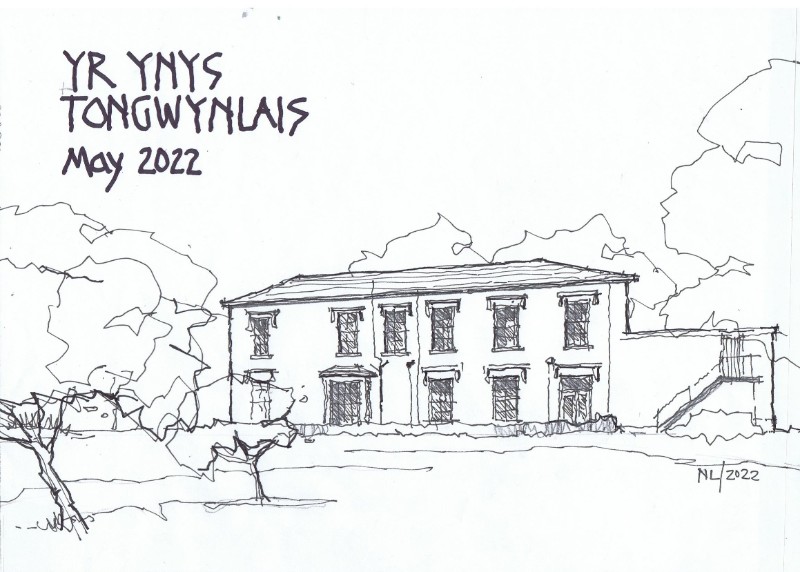 By: on 05/05/2022 101 THINGS YOU (PROBABLY) DIDN’T KNOW ABOUT WHITCHURCH 47 The Methodists
The Methodists have been a pillar of Whitchurch society for such a long time, and we all know the church at the roundabout near the library. But who are they and what is the history?
Before Easter, we looked at the Calvinistic Methodists, who became the Presbyterians at Tabernacle. Over 250 years ago there was another branch of the Methodists in Whitchurch too, called the Wesleyans and they were closely connected
Like so many of our local stories, there is also a connection to Velindre and Melingriffith. We know that the Quakers from Somerset moved into Velindre in the 1720’s and developed the ironfoundry at Melingriffith; they were deeply committed to the spiritual life of their workers
Whilst the Calvinistic Methodists were strong in the local area, with their first pastor at Watford Chapel by 1734, a small independent Methodist society was formed in Cardiff. Sadly, this fledgling society fell apart by 1752 due to personal conflicts based on theological differences
The famous preacher John Wesley first visited Whitchurch in October 1739 and again in April the following year, but the local cause wasn’t helped as the Wesleyans spoke mainly English whilst most of the locals spoke Welsh
Of course, many of the new workers at Melingriffith were English-speaking migrants so heard the Wesley message
As the Melingriffith works grew and the numbers of workers increased, the growth of Wesleyan Methodism also grew. John Wesley continued to visit over the next 30 years, and his brother Charles (the hymn writer) stayed locally at times. All of the Wesleyan Methodist meetings were home-groups for teaching, and then off to St Mary’s for worship
The Methodists were different from the other nonconformists as they relied on lay preachers who travelled around the local area and, in later years, with ordained ministers who only stayed with their local chapel for 7-10 years before moving on. This is largely true even today
About 1820 a first Methodist chapel was formed at Melingriffith. This was in a very small barn at Penylan
TW Booker was drawn to Methodism, and was very sympathetic. He provided financial assistance (and building materials), and within a few years a new, larger building had been erected adjacent. In spite of the earlier conflicts, these early Methodist services were bilingual, but by 1850 were solely in English
Numbers of Methodist attenders continued to increase, and the new building became too small, so another larger building was erected nearby by 1862. Much of the construction and labour was by voluntary contribution
Towards the end of the 19th century, with the continued population growth in Whitchurch and of Methodist attenders, thoughts led to yet another rebuild. This time, land was acquired near the crossroads (the current chapel site) and by 1893 the foundation stone laid. The chapel was completed quickly with the pews and pulpit reused from Melingriffith. The chapel was officially opened in 1895
The sketch below suggests how the new chapel might have looked by the turn of the century. It was set back from Penlline Road and had a small porch with a gas lantern over the front entrance. There is a hint of the houses on the newly-opened Kelston Road beyond
Then even more changes! A harmonium was given to provide music for the Wesley hymns, and by 1900 a vestry was added to the rear. By 1911 the chapel was extended to the front with the façade we see today, all to increase the seating capacity
Between the wars, electric lighting was installed and numerous schoolrooms and halls were added to the rear. A new hall was built on the corner of Kelston Road by 1935, and a pipe organ installed
Whilst the congregations in more recent times have been smaller, the chapel has undergone further adaptions with a complete refurbishment and a new kitchen by 1996, and in 2012 the insertion of a café/coffeeshop, the ‘Roundabout Café’
For the past 125 years, the Methodists have celebrated and sung at this prominent location with so many locally well-known families with a warm welcome offered to all
Does anyone have any memories of the Methodists, their Sunday School and the uniformed organisations held there over so many years? 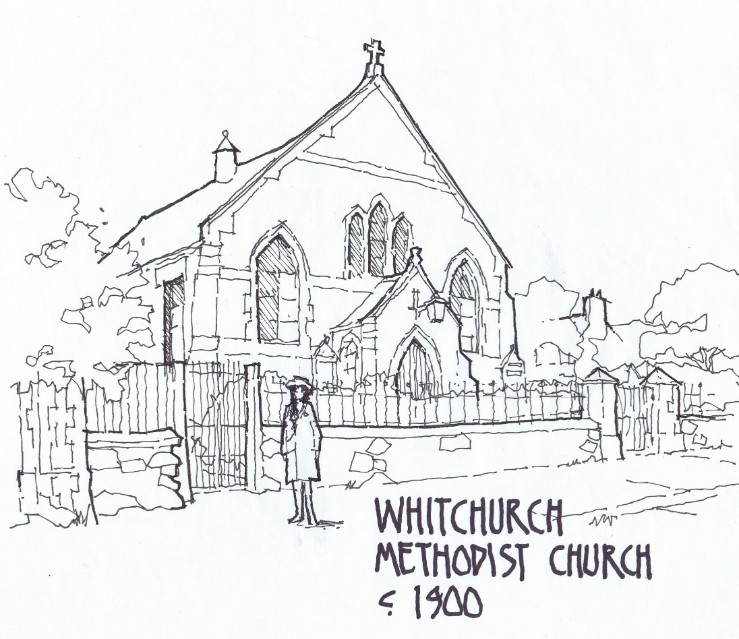 By: on 28/04/2022 101 THINGS YOU (PROBABLY) DIDN’T KNOW ABOUT WHITCHURCH 46 May Day
The May Day holiday nowadays seems to be quite sad and pathetic
However, the May Day celebrations of yesteryear seem to have been quite different
May Day, or Calan Mai here in south Wales (or Calan Haf in north Wales) was always celebrated in the rural villages and hamlets, with roots way back to druidic times
How was it celebrated in Whitchurch? Perhaps we’ll never know, but there are lots of stories and hints of the events that have occurred over the years
May Day was an important time of celebration and merriment and considered to be the start of the summer. For many rural communities it was the end of winter isolation, a chance for socialising and coming together
It was the day when the herds (and flocks) would be turned out to pasture. In the really rural areas of Wales, it was when farming families moved from their valley home (hendre) to higher pasture (hafod)
The day itself was quite special, but the night before, ‘ynbrydnos’ or ‘spirit night’ was celebrated as May Eve. At nightfall, steps were taken to prevent witches from entering houses by marking crosses on the front door. In Monmouthshire there are reports of crosses on doors fashioned from twigs
The lighting of bonfires on May Eve, represented an opportunity for purification, to banish harmful spirits and to protect animals from disease. Traditionally, it was said that the fairy folk would attempt to drive off the cattle or sheep, and driving the stock between bonfires would guard against this. And the placing of cold bonfire ashes in your shoes helped too. Of course, the youths of the village would also attempt to jump over the fires. There are stories of young couples who would jump the fire together to show their faith in each other
May Day itself meant village folk being wakened by the singing of Summer Carols by the village youth, passing from house to house, giving thanks for the seasons to come
And the May Day festivities themselves, consisting of gathering hawthorn branches and may flowers, but only to decorate the exterior of the houses as it was unlucky to bring them inside (I can remember my own mother telling us this when I was little). Then there was the maypole, painted in bright colours, wrapped in ribbons, and dancers; quite a special Welsh celebration. Each village had its own troupe, dressed in white apart from 2 who were the ‘fool’ and ‘cadi’. Fool was dressed as the jester with a bright costume, and Cadi with his Cangen Haf pole festooned with ribbon and shiny objects (such as spoons and cups) weaving their way with their intricate dances
Then there was singing and dancing, May Day games and fortune telling, and most likely lots of drinking and eating
I’m sure that Whitchurch was no different to so many other villages and hamlets throughout south Wales in celebrating. I wonder where the maypole would have been raised? Perhaps on the common?
It’s so difficult to picture our village in the distant past, but I can imagine how important the May Day celebration was for our predecessors. If only they could see us all now, moaning about this pathetic public holiday between Easter and the ‘proper’ Spring Holiday, I’m sure they’d have words to say
But to finish, I came across this photograph from 1980 (over 40 years ago) when the youth of Whitchurch celebrated the ‘Grog Trot’, visiting as many of the local pubs and clubs in the area whilst dressed in fancy costume! Not so different to the celebrations of yesteryear after all
What do you think? 10 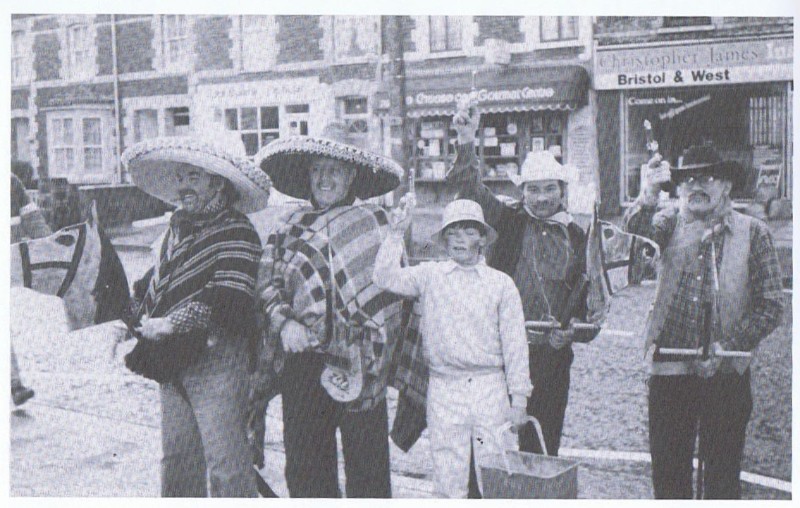 By: on 22/04/2022 101 THINGS YOU (PROBABLY) DIDN’T KNOW ABOUT WHITCHURCH don't forget if you would like to join our Reminiscence group it will meet next on 3rd May at the Hub all welcome 2pm. 45 Servants of the Bookers We’ve all seen the TV programmes of posh Victorian people living in their wonderful houses and the army of servants waiting upon them. But I wonder what the reality of life was for the servants of the Bookers at Velindre?
There’s not much to go on. Velindre was demolished 120 years ago, there are a few grainy OS maps, and then there are the census returns
We know that Richard Blakemore acquired Velindre in the late 18th century and that TW Booker joined his uncle Richard as a young man and later acquired the property. It appears that Velindre then underwent the first big stage of gentrification, so that TWB, his young wife Jane and growing family could move into Velindre in 1830
By 1834, TWB and Jane had 5 children and their gentrified house, so they would have required quite a few servants to run everything
The census of 1841 shows TWB aged 35 as head, with his wife and children with 8 live-in servants and a coachman living next door at Penylan
In the early census returns we see a number of young girls in the millworker families below Velindre, described as ‘servants’. Perhaps they were extra ‘understairs’ servants who carried out the heavy cleaning and fetching duties at the house?
10 years later, there were still 8 live-in servants, including Anna Evans aged 79 (house servant and nurse), Edward Morgan who was a 40-year-old widower as butler, a cook, 4 other female house servants and a 16-year-old male house servant. Within the grounds lived the gardener and his family, and next door in Penylan lived a groom (with his wife and 3 children) and 2 coachmen with their respective families
By 1861, the Booker family had changed dramatically. Both TWB and his wife had died, and his son TWB junior had become head at Velindre. He’d married Caroline and had started their own family. All of TWB’s other children had all either died or moved on, but the servants remained. There were still 8 live-in servants (including Anna Evans, now aged 89)
Anna Evans was obviously a longstanding member of the household. We know from her obituary in December 1865 in the Cardiff Times that she was ‘the favourite nurse of that late estimable lady Mrs J Booker-Blakemore, and claimed the honour of being the nurse of Messrs TW and JP Booker and of Mrs Cyril Stacey. She had lived for the previous 63 years at Melingriffith, out of which time she had resided over 30 years in Velindre’. She was approaching her centenary
As well as Anna Evans as nurse, Velindre would have needed a butler, cook/housekeeper, scullery maid, a lady’s maid, general house servants and a ‘boy’. At Greenmeadow up the road, the Lewis’s had a page and a mail boy as well!
There are no known images of the Booker servants, but the photograph below shows typical servants of the period. There is a coachman, scullery maid, a house servant and others. Which ones would you relate to?
Female servants would have been unmarried, and left service on marriage. So, a 30-year-old (or even 40) would suggest either a cook or housekeeper. Obviously, the Bookers were okay with married male servants in the outside duties
The duties of the live-in servants would have been both long and tiring. Velindre was a house heated with coal fires, lit with candles and oil lamps and relying on well water for cooking and washing. I wonder what sort of wage the servants would have received, and what kind of holiday leave? Probably, not much
Over the next 20 years, with TWB junior, Velindre underwent massive alterations and the house and gardens became a glittering pleasure palace
As part of the ‘county’ set, Velindre would be the host of numerous receptions and weekend parties, when everyone dressed up and the best china and silver was brought out. More cleaning and even more fetching for the servants
By the end of the decade however, everything changed. The Melingriffith empire had collapsed and TWB junior had moved out of Velindre to live in another grand house, in Southerndown (with his own servants)
What happened to all of the other Velindre servants I wonder?
What about your own family stories?
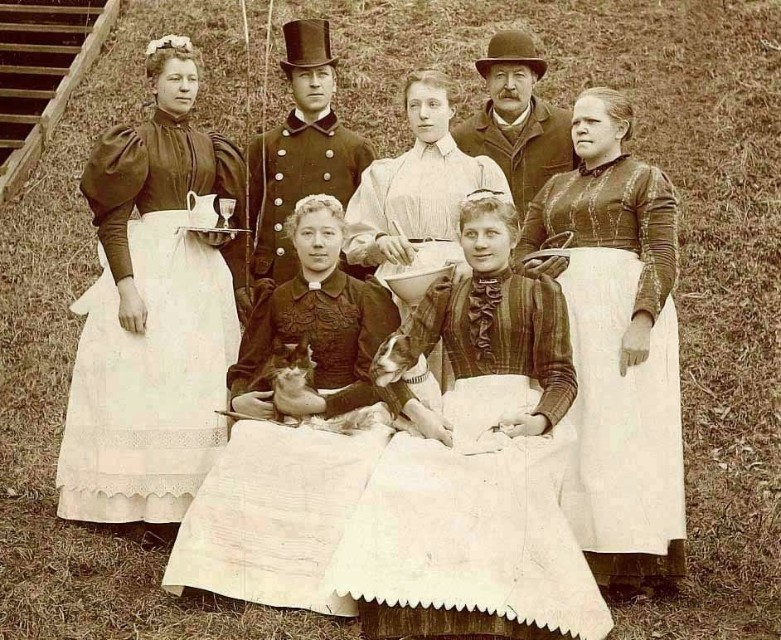 By: Nigel Lewis on 14/04/2022 101 THINGS YOU (PROBABLY) DIDN’T KNOW ABOUT WHITCHURCH 44 Easter To many people in the village Easter is just a long holiday weekend, a chance to meet up with family or friends, and for children to over-indulge in chocolate eggs. It wasn’t always though
Celebrating Easter has been the highlight of the Christian Church for over two thousand years. The victory of Christ’s Resurrection over death. Here in Whitchurch, it’s still incredibly important for Christian believers, and a chance to demonstrate their faith. Until Covid and the lockdowns, the Good Friday Walk of Witness through the village by hundreds of Christian folk was quite a sight; it’s great to hear that the walk is due to recommence today (Good Friday), so watch out
Easter is a moveable feast every year, based on the lunar calendar. It’s generally accepted as the first Sunday after the full moon after the 21st of March. This year it’s the middle of April and last year it was quite early in late March
A few weeks ago, we looked at the changes between the Julian and Gregorian calendars, and all of the upheaval that caused. Easter has always been associated with the Jewish calendar and their Passover festival. And of course, the Jewish year has different months and weeks to the main calendars. No wonder it’s all confusing
There have been calls to fix the date of Easter for many years past, but there seems to be no progress. There is a current proposal to fix Easter as ‘the Sunday after the second Saturday in April’ but this is very controversial still. Apparently, here in the UK there is an Easter Act of 1928 which fixed the date, but this was so controversial that the act was never enacted!
Around the world, Easter customs vary, with sunrise services, midnight vigils, Paschal greetings and the breaking of Easter Eggs (the symbol of an empty tomb)!
Here in Whitchurch, I’m sure that churches and chapels of yesteryear were decorated with spring flowers and candles, after the 40 days of Lent. Today, in all of our local chapels and churches this continues. Of course, it was always traditional that many young couples were married at Easter, and there are reports of Easter baptisms too, in the brook by the Three Elms. Elsewhere, there would probably have been Easter parades, dancing and Easter hat competitions?
Whilst chocolate eggs are a recent introduction, there were many traditional Easter foods consumed. Does anyone have any family stories to share?
 By: Nigel Lewis on 07/04/2022 101 THINGS YOU (PROBABLY) DIDN’T KNOW ABOUT WHITCHURCH 43 Schools
How much do we know about the schools in Whitchurch? There’s lots to discover, so we’ll have to explore in a series of articles. So, this one’s the first
Quoting Dylan Thomas, to begin at the beginning…
It’s not unsurprising to realise that education in the early years was provided by the Cathedral in Llandaff. Apparently, there are records of an early school dating from the 10th century which continued up to the 18th century where children from Whitchurch could benefit from education. In fact, a report from 1817 notes that a National School in the Cathedral ‘village’ provided ‘facilities for the poor children from Whitchurch and other hamlets in the Parish of Llandaff’
There were ‘circulating schools’ in 1752 at Whitchurch Parish Church, in 1753 at Ffilock (Philog) Whitchurch and in 1758 Tynycae Whitchurch; none of these schools lasted long. However, out of the circulating schools grew the Sunday School movement. Mainly from the Methodists (at Melingriffith) and copied by the Anglican Church. It was basic education, and reading was encouraged, from the Bible. Reports from Church Commissioners at the time list 92 children attending Sunday school at 3 chapels in Whitchurch
With the coming of the Quaker ironmasters to Melingriffith in the 1780s, with their enlightened attitude for the wellbeing for their workers, they established scholastic facilities for the children. There are records of an Edward Williams, Schoolmaster at Melingriffith in 1786. I wonder whether this man was Edward Williams ‘Iolo Morgannwg’ the famous/infamous historian who was living in Llandaff at that time? Does anyone know?
The Quakers at Melingriffith were keen to establish a school for the whole village too, and in 1807, consideration was given to establishing a British Society School. A meeting was held and the sum of £53 3s and 3d was raised. As many as 63 children attended the new school, but it had closed 3 years later
A report by William Davies (the senior vicar choral at Llandaff) reported that in 1818 there were two day-schools in Whitchurch with 24 boys and 6 girls and a Sunday school (probably St Mary’s) with 60 boys and 46 girls. A further 20 Whitchurch children attended school at Llandaff
Then, a report of 1842 refers to a school kept by Thomas Phillips in a small outbuilding adjacent to the Fox & Hounds pub. The well-known photograph below shows the Fox School in the early days
Thomas Phillips taught basic reading, writing and arithmetic. Children attended school until they were 13 years old (although some left aged 10 to work at the local mills). A report 5 years later noted that the Fox School was held in a building 30 x 15 feet and had accommodation for 75. Fees paid by the parents amounted to £39 for the year
That same report of 1847 stated that there were two dame schools as well, one started in 1839 by a Miss Crea and a second with a Miss Jordan. Her school was threequarters of a mile from the village and met in a room 13 x 13 feet with accommodation for 28 children (but with 40 enrolled!)
In 1847, only 108 children attended school, less than 8% of the population
The 1847 report is considered notorious and began the controversy against teaching through the Welsh language. Remember, at that time, the great majority of the local population were monoglot Welsh speakers
Thomas Phillips of the Fox School died in 1858, and is buried in old St Mary’s churchyard. His headstone reads ‘for 35 years schoolmaster’
After all these attempts, steps were taken to establish a National School in the village. TW Booker was an enthusiast and provided a £1,000 loan to construct a school building. By 1854, the vicar and churchwardens negotiated a parcel of land in Tynypwll Road from the Wingfield and Mackintosh estates and construction commenced. We’re not sure of the date, but around 1855 the school opened as a combined mixed and infant’s school. This school provided education for the whole parish. The parents of each child attending had to pay 2d per week
With the growing population, other schools popped up in Whitchurch. There was already the school in Penylan for the workers at Melingriffith, a Miss Eliza Brangham had a school in the vicinity of the common between 1855 and 1888 and Robert Small had a boy’s school at the Philog (he was previously an assistant teacher at the National School). Because of his reputation, he charged one shilling a week per boy for ‘superior’ education
There’s so much to write and explore!
Hopefully, another time we can look at the continued growth of the village, the expansion of the infants and junior schools, and the building of the schools we still see about the village today
Has this article prompted any memories of yours? We’d love to hear
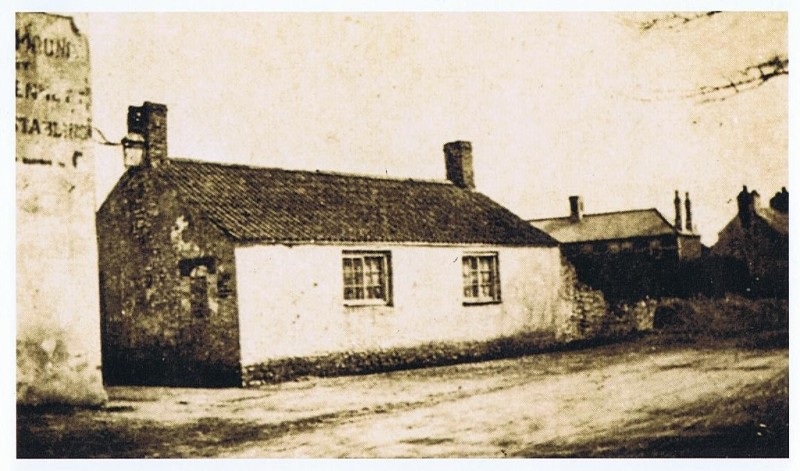 By: Nigel Lewis on 31/03/2022 101 THINGS YOU (PROBABLY) DIDN’T KNOW ABOUT WHITCHURCH 42 All Fool’s Day Canal Police/Smugglers
Today is April 1st, traditionally described as April-Fools Day or All-Fools day! A perfect day for looking at one of the more bizarre items we’ve looked at so far in this series about Whitchurch
Did you know that there was once a body called ‘the Glamorganshire Canal Police’?
From the day in 1794 when the canal was opened around Whitchurch, there was always the risk of goods being pilfered and drunken bargemen fighting each other. By the 1830s, there were upwards of two hundred barges on the canal and countless numbers of men, boys and womenfolk, passenger barges, farriers and stablemen and lock-keepers. In addition, there were victuallers, opportunists and hangers-on and of course urchins throwing stones at all and sundry
And what about the smugglers? As early as 1732, the customs officer at Cardiff called for assistance to rid the area of smugglers (but without success!)
In 1818, a large shipment of smuggled spirits was landed at Barry Island, then still a separate island, and a known haunt of smuggling gangs. The excise men managed to seize three kegs, but most of it found its way to the drinking dens of Cardiff and onto the canal barges to smooth the palette of many a coal miner and foundry worker
By 1850, a small number of canal constables were appointed by the canal company to keep order and to help prevent pilfering. By the time of the census in 1851, Constable Thomas Spencer of the canal police was stationed at Nantgarw and rented a small cottage in the village with his wife Elizabeth
Over the following years, the local newspapers reported on the ‘activities’ of the canal folk. In March 1854 the Cardiff and Merthyr Guardian reported that canal police constable John Thomas was giving evidence in court against David Davies, boatman, charged with stealing coal from a barge (giving it to a person named Jane Henderson, a ‘respectable-looking person’). In June 1857 the same newspaper reported that James Casey, a violent Irishman was charged with assaulting PC Sweeney of the canal company’s police
By March 1859 the Cardiff Times reported George Calligan, one of the police in the Glamorganshire Canal Company’s service charged an ex-constable named Parkinson with assaulting him while on duty
There are no records of the Glamorganshire Canal Police, and no indication of when the force was formed or ceased to function. In 1857, Superintendent John Stockdale, in charge of the Cardiff Borough Police reported that ‘the Glamorgan Canal Company pay and employ two constables under my commend, for duty on the canal. They also have a separate police station at the Old Sea Lock’ The photograph below shows the old Sea Lock Hotel, right at the docks-end of the canal. The police station must have been very close nearby
From the 1860s, the railways began to overtake the canal for trade, and 10 years later, the canal business fell into debt. From 1882 onwards any policing requirements would have been undertaken by the Bute Dock Police
Does anyone know anything of the canal policemen, or of any of their dealings with the canal folk?
Thanks to Headline, the Dock & Railway Police History website for much of this information
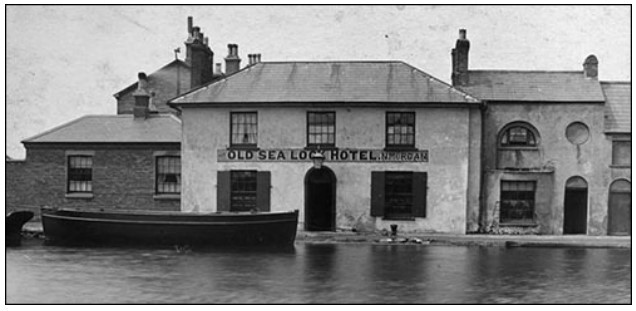 By: Nigel Lewis on 24/03/2022 101 THINGS YOU (PROBABLY) DIDN’T KNOW ABOUT WHITCHURCH
41 New Style/Old Style
Have you ever wondered why the tax year ends on such a strange date, 5th April each year?
In the UK, it has always been tradition that each year would be governed by four quarter days, based on the seasons. Lady Day, (which is today, 25th March), Midsummer Day (24th June), Michaelmas (29th September) and Christmas Day (25th December). These were (and still are) the days when farmers and others paid their rents to the landowners, when servants were hired and when school terms started (many public schools still use these terms). In fact, Lady Day was considered the first day of the financial year
By the late 16th century, it was realised that the ancient calendar (the Julian Calendar) had an in-built error and had allowed for too many leap years in past times. The Pope, Gregory XIII proposed a new calendar to correct this and to catch up, His calendar was adopted throughout Europe, but Britain felt it was too ‘Popish’, so retained the old Julian calendar
It was not until 1751 that Britain decided to adopt the new Gregorian calendar. The effect was that 1751 was only 282 days long, starting, not on 1st January, but on Lady Day instead, finishing on 31st December. In the next year, 1752, the country skipped forward by another 11 days. So, Wednesday 2nd September was followed by Thursday 14th September!
There were stories of riots around the country of local folk who were worried that they’d lost so many days of their life and that saint’s days and holy days were changing, including the dates for Easter. Maybe these stories were only urban myths; however, there is a painting by William Hogarth (see below, courtesy of John Soanes Museum) entitled ‘Give us Back our Eleven Days’ where people in London were picketing with homemade placards
The government of the day realised that they might lose 11 days’ worth of taxes because of the new calendar, so they simply changed the start of the financial year from 25th March to 5th April. The date was tweaked again in 1800 when they realised another leap year hadn’t been included, so the new financial year moved finally to 6th April
I wonder what the residents of Whitchurch thought about all this change? Would they have even noticed? There’s nothing recorded
But there is a community in the Gwaun Valley near Fishguard in west Wales where the changeover never happened, and they kept to the old Julian calendar. Even today, the 200-strong community celebrate New Year on 13th January. They call it ‘Hen Galan’, the Old Celebration. Perhaps we ought to think about having a second New Year in Whitchurch too. What do you think?
Anyway, Happy Lady Day to all! 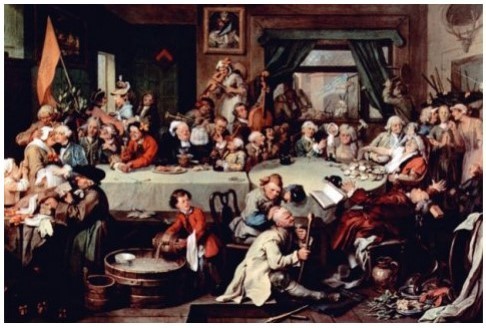 By: on 18/03/2022 101 THINGS YOU (PROBABLY) DIDN’T KNOW ABOUT WHITCHURCH
CATCHUP
I thought that we might have a special catch-up this time and share a little more about our new project ‘Walking Whitchurch Heritage’
As you may know, AWEN have been given a grant of £8,505 from CADW/LHF to establish a history/wellbeing project here in the village so that we can enjoy a series of local walks and to learn a little of our history at the same time
We had a very successful launch event at the library three weeks ago, and we were thrilled when over 120 of us packed into the new library space. We had a series of tables and displays from local groups, interspersed with a number of short talks all about our village and some of the local characters
We’ve had great feedback and lots of new information and suggestions about how we can proceed
We also had a very useful follow-up meeting at the rugby club last week to explore more: so many good ideas. If you’d like to be involved, it’s not too late, just email Judith on www.awenthelibrary.cymru with your details
The Whitchurch Festival organisers have made a kind offer to have our first walk as part of the festival fortnight, and we’ve pencilled in Tuesday 28th June, starting at 6 o’clock so that we can get as many attending as possible
We think this first heritage walk could explore Old Church Road (starting at the Plough), passing old St Mary’s and the Fox, ending up at the site of the old motte and bailey castle. If you’ve got any interesting facts, photographs or information about the route that you think we could use please let us know
We’re planning a colourful bilingual handout to accompany the walk with digitalised information links, and this would also be available at the library afterwards, so that you could enjoy the walk at you own leisure
Later in the year, we’ll have another walk, perhaps exploring Wauntreoda and the lower village, so get your thinking caps on and let us know!
Over the next few years, we’d like to consider other walks around the village as well. So, if you have any ideas for walks that would last no more than 20-30 minutes please come forward
I’m reminded that the old boundaries of Whitchurch were much wider in earlier years and included Birchgrove, Rhiwbina, Tongwynlais and even Llandaff Yard (now Llandaff North!). Perhaps we could think of walks to include some of these areas as well. What do you think?
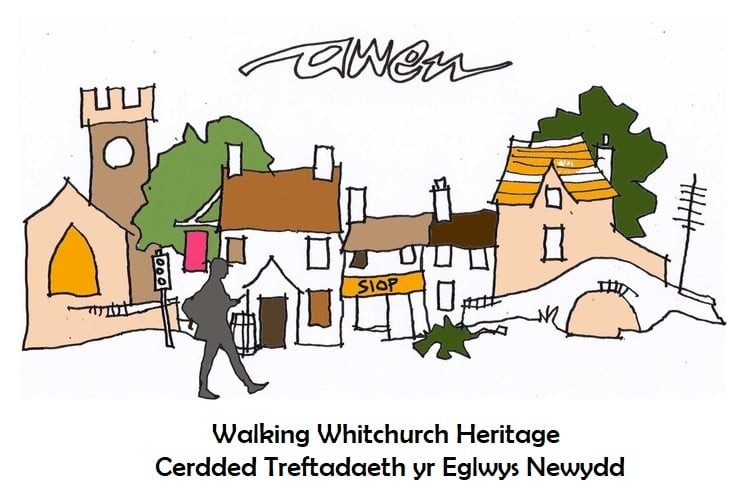 By: Nigel Lewis on 11/03/2022 101 THINGS YOU (PROBABLY) DIDN’T KNOW ABOUT WHITCHURCH
40 The Booker’s of Velindre
Back in November last year we looked at TW Booker and his uncle Richard Blakemore, and how TWB inherited the Melingriffith works and the grand house Velindre
This time, perhaps we can look a little about how TWB grew into his position, his wife and his children
As we’ve discovered, TWB moved to Whitchurch as an eighteen-year-old to live with his uncle at Velindre. By the age of 23 he had married Jane-Anne Coghlan, and settled into married life at The Ynys, a smart house just upriver at Tongwynlais. For the next six years, The Ynys was their family home and they had the first two of their children; Anna (or Hanna) Booker who was born in 1826, and Richard Blakemore Booker, born 1829
By 1830, they had moved into Velindre, a much grander house and set about rebuilding and restoring the old house into the new pleasure palace. They also had another three children; TW Booker (junior), born 1830, Mary Booker born 1832 and John Partridge Booker born 1834
We don’t know much about the early family life of the Booker’s, but they probably enjoyed the life of an affluent Victorian family. The children would have been taught at home, and would have had a nanny. The gardens were expanded and would have made a wonderful environment for children’s play
The census of 1841 reports that Thomas Booker, now aged 35, was the head and described himself as an ‘ironmaster’. His wife, Jane and 4 of her children were being looked after by 8 live-in servants, and the coachman who lived next door at Penylan
The image below (courtesy of National Library of Wales) shows TW Booker in the 1840’s, painted by George Zobel
By the 1851 census, TWB was absent as Jane was noted as head, with her 5 children at home. They still had 8 live-in servants, including Anna Evans aged 79 (as house servant and nurse) and a 40-year-old widower as butler. Nearby, lived the gardener, groom and 2 coachmen. Obviously, things were looking up!
As well as a successful businessman, TWB had been elected as High Sheriff of Glamorgan and later as MP for Hereford. So, he wanted to ensure the succession of the family business. He built large houses for two of his sons, The Pines for his eldest, Richard and Greenhill for John Partridge his youngest. TWB Junior, who was the budding businessman, was obviously going to inherit Velindre
As only one of his sons showed much interest in the business TWB Senior began grooming Junior for a future role in the business. Probably just as well, because just a few years later, TWB (who had added his uncle’s name of Blakemore to his own) died in London in 1858, aged 57. There is a story that whilst he was being considered for better things in Parliament, he was discovered as having an affair with the wife of an admiral, and Queen Victoria was not impressed!
Anna (Hanna), the elder daughter, never married, and died in 1855 aged just 29. Only a few years later in April 1860, her younger sister Mary married the Rev Cyril Stacey at (old) St Mary’s Church, and the local papers reported on the sparkling occasion and the reception on the lawns at Velindre. Sadly, nothing seemed to last, and she too died only a few years later at the age of 35
Of the other 2 sons, Edgar Chappell reported that Richard, the eldest son was ‘of dissolute habit’, and died aged only 32. He could only have lived in the Pines for a very short while
John Partridge Booker, married and started a family with 2 daughters at Greenhill, but he too died young at only 34
TWB Junior seems to be the only one of the children to live to middle age. He took over the business, married Caroline and had 8 children, all daughters. By 1861 he was living at Velindre with Caroline and 8 servants (including Anna Evans, now 89!). In the coming years, he was instrumental in collapsing the whole endeavour and by 1881 he had moved with his family to Southerndown. He died in 1887 at the age of 57 with no male heirs. More about TWB Junior another time
There is a family mausoleum in Old St Mary’s Churchyard where all of the family are interred. The mausoleum was designed and sculpted by local man Eli Jenkins. More about him too another time
By the end of the century, only the widows of TWB Junior (Caroline) and of JPB (Clara) seem to be alive. I wonder which of these ladies was the ‘Mrs Booker’ who sold Velindre and the land adjacent to Cardiff Corporation for the new mental hospital, and who agreed the land exchange for the Recreation Ground (and the future library)? Does anyone know? 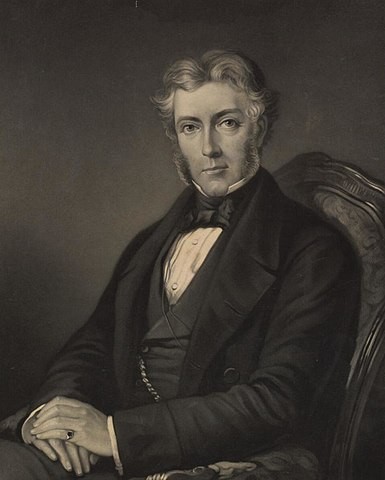 By: Nigel Lewis on 04/03/2022 101 THINGS YOU (PROBABLY) DIDN’T KNOW ABOUT WHITCHURCH 39 Local Builders
Over the past months we’ve looked at various houses in the village, but these have generally been so old that there is no record of who actually built them. In June last year we ‘dipped a toe’ and discovered a little about Cornishman Sam Bennett, and his family, and the houses that they built on Manor Way, Birchgrove and off Kelston Road. This generated a lot of comment, so here’s another article about some of our other local builders:
JOB DAVIES On the Tithe Map of 1841, Old Church Road (or Church Road as it was then called), snaked from the junction of Merthyr Road, past (old) St Mary’s Church and the Fox and Hounds pub to join up with Ty’n y Parc Road. At the junction with Ty’n y Pwll Road is shown a terrace of cottages with large front gardens, called ‘Job’s Row’. A parcel of land adjacent was also owned by Job Davies. The terrace is no longer there, but another terrace of stone-walled cottages still stands. These are opposite the Community Centre
Job Davies lived in Llandaff and was a recognised builder. In all probability, the early cottages were either built by him, or he acquired them and demolished and rebuilt at a greater density when there was a need for extra houses during the middle/late 19th century. The census returns for 1861 and 1871 show that the cottages were tenanted by local families with lots of children. The old corner shop and first cottage near the bend look like they predate the existing terrace. I wonder if they were part of the originals?
Does anyone know of the families, or what became of Job Davies?
FREDERICK MILLWARD Most people recognise Millwards Terrace, on the main road, opposite Island Cottage, the funeral home. This terrace of stone-faced houses was built by Frederick Millward, and they even have a date plaque set up high on the middle house of the terrace. They are of later construction than Job’s Row and have stone facings with brick detailing and slated roofs and canopies over each front door. Very handsome Victorian houses with special character. These houses seem to be more substantial than many in the village, and I’m sure that their owners and occupiers could tell wonderful stories over the years. Does anyone know?
These houses weren’t the first built by Frederick Millward, as we understand that many of the terraced houses in Ty’n y Pwll Road were also built by him in earlier years
We don’t know a lot about Frederick, but his end was very tragic. It seems that there may have been financial problems in finishing Millwards Terrace and some of the materials might have been ‘borrowed’ from other building sites. Frederick was arrested by the police on two separate occasions, and on the second time was found dead in the police cells. At the time there were many newspaper articles about this. All so sad
EDWIN WILLIAMS Another local builder. Edwin Williams built Tabernacle chapel in the 1860’s and went on to build the parish offices in Bishops Road sometime later. He was, however, quite a prolific housebuilder. Janet his great-granddaughter tells us that he hailed from Pontypridd originally but moved to Whitchurch as a young man. He built the houses opposite Tabernacle on Brook Road, and also a pair of semi-detached houses alongside the stream abutting Millwards Terrace. His builder’s yard was behind Tynant, the end house. He also built another large house just north of Tabernacle called Pensford, which is now the tapas bar, and the terrace of houses in Glandwr Place
Edwin’s claim to fame though was to build the mansion Coryton House for Sir Herbert Cory in 1900. This is still standing, just south of the Village Hotel, and is now a special school. The photograph below is of Coryton House about 1920, with the local hunt meeting outside
Sir Herbert was a formidable businessman, as a shipowner and with directorships to 35 companies. He would later become Sheriff of Glamorgan and MP for Cardiff South for many years. Not a man to tangle with. Janet tells us that there was a terrible row between Edwin and Sir Herbert about the cost of ‘extras’ that had been requested, and this ended in court. Sir Herbert had a large legal team whilst Edwin represented himself. Everything pointed to a victory for Sir Herbert, but when Edwin presented all of his paperwork for the extras, with everything signed by Sir Herbert’s agent, their case collapsed and Edwin was awarded his full claim! A real David and Goliath victory for Edwin. This was reported in all the local newspapers at the time
We’ll visit local builders again, another time, but if anyone has any stories to share about other builders and how our village grew, we’d love to hear them
Thanks to Janet Williams for the information about Edwin Williams, and to Steve Nicholas for the use of the old photograph of Coryton House 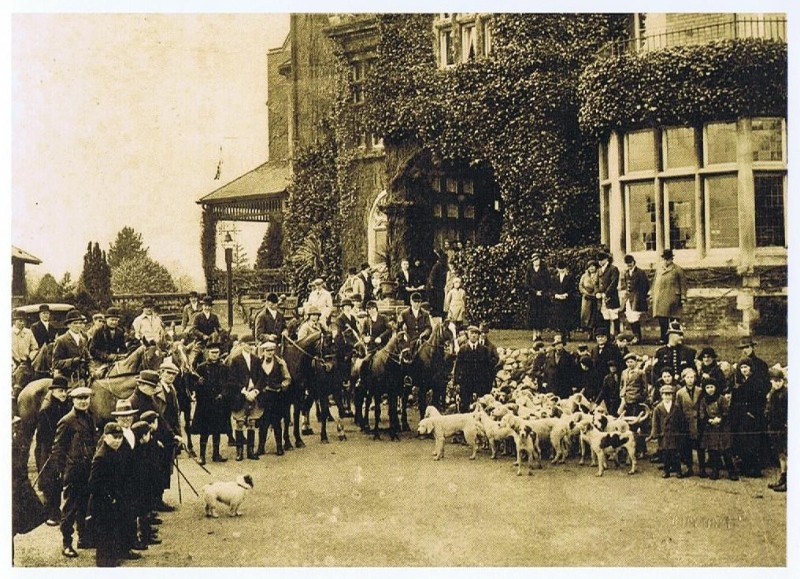 By: Nigel Lewis on 24/02/2022 101 THINGS YOU (PROBABLY) DIDN’T KNOW ABOUT WHITCHURCH 38 Uniformed Organisations Thanks to everyone who came along to the launch of Walking Whitchurch Heritage, hope to see you at the Reminiscence Group on Tuesday 1st March.
If you were to list all of the uniformed organisations that are held (or used to be held) in the village, it wouldn’t be difficult to rattle off a whole list: Boys Brigade, Scouts, Girls Brigade and Guides. And then for the slightly younger ones, BB Junior Section, Cubs and Brownies. And there are other groups, associated with church and chapels and other affiliated organisations, all trying to show young people what’s good in society
Many people will have fond memories of these groups, collecting badges, camping, team games and church parades. What memories can you share?
Nearly 150 years ago, in the Cardiff Times newspaper dated 26th September 1874, there is a report of yet another (even older) group, the Independent Order of Good Templars and the Junior Templars in Whitchurch, who were celebrating their first anniversary. The newspaper report states:
‘They celebrated their first anniversary on Saturday with a plentiful supply of tea and cake. A procession then formed, headed by the Mellin (sic) Griffith Templar Brass Band. There were different colours of regalia together with flags and banners. A public meeting was held in the Wesleyan Chapel, Mellin Griffith’
So, who were they? How many adults and children? Not another mystery, surely!
There are 2 photographs below which seem totally unconnected, but there’s a theme
The first shows a bearded man in an open-top car in 1913 in the civic centre, titled ’Grand Chief Templar Joseph Malins on a farewell tour of the UK’
The second photograph shows an open-top bus (probably post WW1) with an ad on the front for false teeth. All very strange
A bit of digging provides some of the answers
The Good Templars were a temperance movement, determined to stamp out the evils of drink reputedly cursing Britain in Victorian times. The Juvenile Templars were the youth side of the organisation. At its height before WW1 there were hundreds of thousands of members in the UK and even more in North America. Clearly, in 1874 there was quite a large membership in Whitchurch
Joseph Malins (the bearded man in the car), and his family ran a very successful business providing false teeth to the folk of Cardiff from his premises in Queen Street. Apparently, you could purchase a full set of false teeth (made from the best vulcanite and ebonite) for 5 guineas, or an 18-carat gold set for 14 guineas. You were promised ’painless’ extraction, and a 5-year guarantee. By 1907, over 5,000 sets had been sold
What strange reports from the time, and the connections with the village
Does anyone know of the Juvenile Templars in Whitchurch in latter times?
And what about the false teeth from Queen Street? Would anyone locally have purchased a set of the 18-carat dentures? What a family inheritance!
Thanks to Chris Butler and his book ‘Cardiff Mysteries’ for the photograph and information on Joseph Malins, and to Steve Nicholas for the photograph of the open-top bus 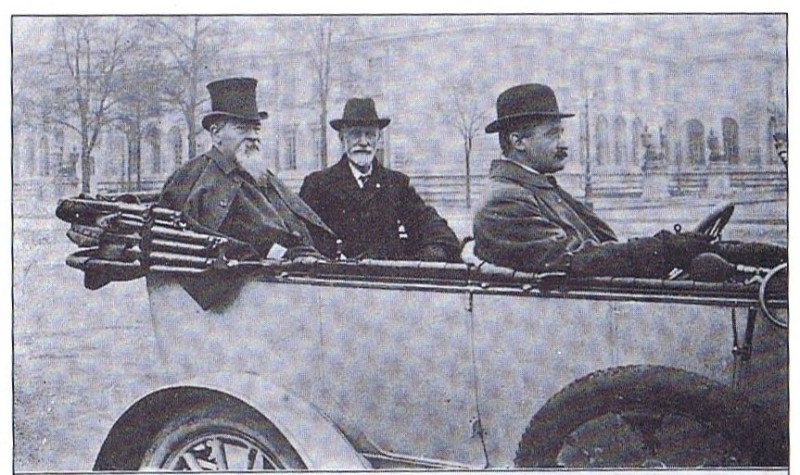 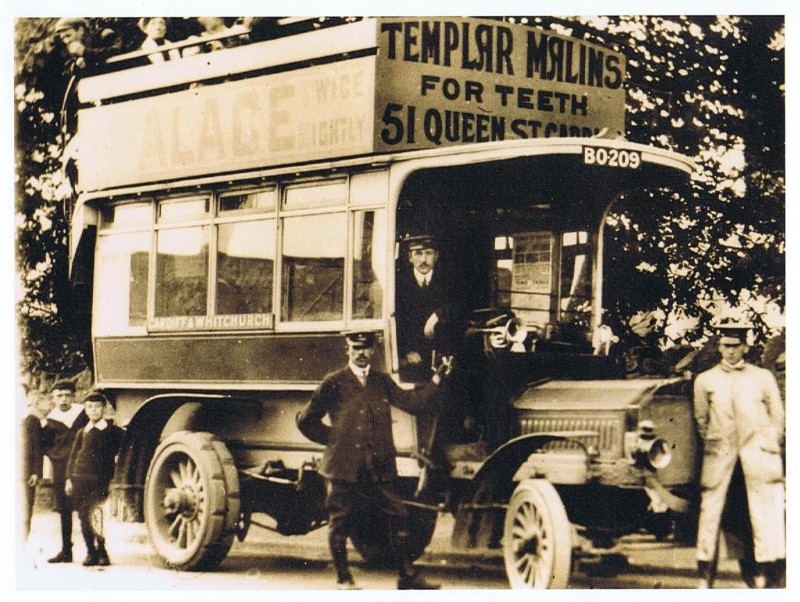 By: Nigel Lewis on 17/02/2022 101 THINGS YOU (PROBABLY) DIDN’T KNOW ABOUT WHITCHURCH 37 Melingriffith
One of the most-frequently raised queries about Whitchurch relates to our subject this time; the mill at Melingriffith
Where was it? How old, and what sort of mill was it? What happened to it, and of course, who was Griffith (of mill fame)?
Perhaps we should start with what we know. It’s pretty clear that there’s nothing there now, except the name, and the old mill feeder. Some people say that the old mill stones near the entrance to the canal walk were from Melingriffith; who knows! There are lots of references to the mill in old documents and clearly, Melingriffith is very old
Quite how old the mill might have been, is tricky. In all likelihood, pre-conquest, and possibly even earlier! If there was a mill at Melingriffith for many hundreds of years until the 18th century, it might easily have had a very early ancestor too. But this would be pure conjecture
Flatford Mill in Suffolk, of John Constable and the Haywain fame, is probably contemporary with Melingriffith (see photograph, courtesy of the National Gallery). It’s suggested that Willie Lott’s cottage and mill in Flatford dates from before the conquest and is mentioned in the Domesday Book. Described as ‘probably a small timber building grinding corn after the harvest in the autumn and into the winter using water power from the River Stour’
Early water mills were very inefficient and would be sited beside a river, with a simple mill stream, powering an undershot water wheel. This is where water would run under the mill wheel and drain away at the same level. Flatford used this type of mill wheel
In all probability, early Melingriffith used this form of water power too. So, one can imagine that the mill would have been located very close to the River Taff with a short mill stream and outflow. We know that the River Taff has a series of natural stony cascades so the mill would have to be located just upstream of one of these, so that’s a good start
We also know from the old records that Melingriffith was subject to fire and war damage numerous times over and was often referred to as ‘ruinous’. The first mention of a mill was in 1158
No doubt, over time, Melingriffith underwent design changes to become more efficient. Sometime (probably medieval), Melingriffith was probably rebuilt as an overshot mill. This required a larger mill wheel where the water was introduced at the top of the wheel and discharged away below. This provided far more power, but required water to be introduced, with a 3-4m embankment. This would also require a feeder/race from further upriver, running gently to a millpond. This is the type of mill that we are all most familiar with. This new mill could well have been located further south, and probably not far from Oak Cottage
The sketch below gives an idea of how an overshot mill might have worked. This one would be typical of the later Middle Ages. Two or even three storeys high and set on an embankment so that the water ran over the mill wheel, discharging below, and back into the river. The gears (which would have been made of timber) would drive the mill stones located on the floor above. The unmilled grain would be stored on the top floor (or attic) and drop through wooden chutes, being collected as flour in sacks at the bottom. This technology hasn’t changed for hundreds of years
Farmers from the area would probably thresh their corn at the farm and deliver the sacks to the mill, collecting the milled flour later. Probably, the cost of milling would be an amount of the grain
It’s interesting that the only house in Heol Don in the census of 1841 lists John Cornish as a flour merchant (more on him another time)
So, yet again, lots of questions and no proper answers
The early mill would have required a miller and perhaps his wife. The later, overshot mill would have required more people; a miller and a few mill workers (and probably the miller’s family as well). Sometimes, the miller would live on the premises, or in a cottage adjacent. We don’t know
And what about Griffith himself? There are no records to help us, except scanty reference that the mill might have been named after Ifor Bach’s son Gruffydd
Does anyone have anything else to share? 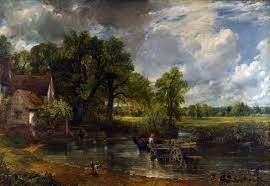 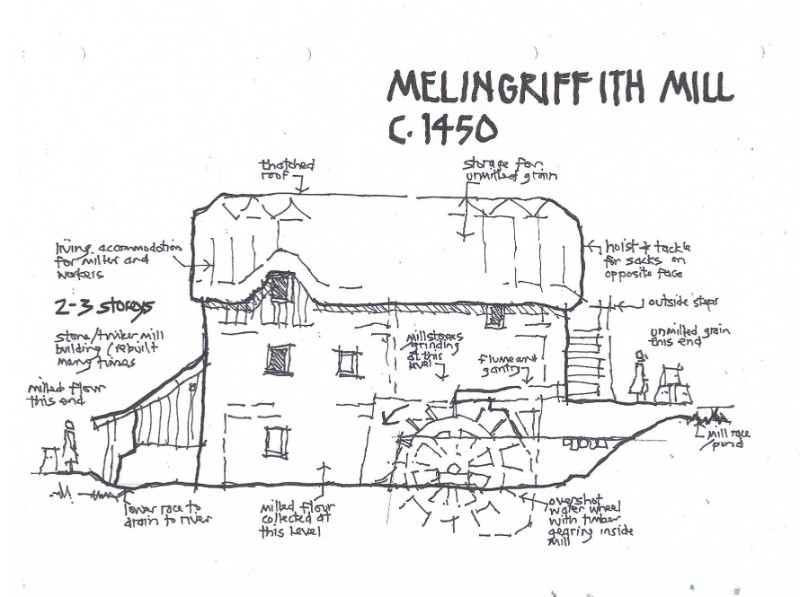 By: on 17/02/2022 Caroline reminds of two key local history books this week: Whitchurch: a brief history by Hilary M. Thomas Were you born in Whitchurch? Lived here for years? Or moved here recently? Want to find out more about our village? Many of you will know the classic “Old Whitchurch” by Edgar L. Chappell, first published in 1945. Less well known is Hilary M. Thomas’ “Whitchurch: a brief history”. This looks at some of the people and places that have made Whitchurch what it was and brings the story slightly more up to date.
Now a Heritage Lottery grant will enable us to continue the story through the Walking Whitchurch project. We are looking to devise walks in the area featuring local people and personalities. But we need your help to find out what Whitchurch means to you. Do you know about Whitchurch in the past? Have you chosen to come and live here recently? Come share your views at a free drop in event taking place in the library to launch the project on Wednesday 23rd February 4 - 8 pm. Families and adults are welcome and there will be talks, games, information, crafts, refreshments and a chance for you to tell us your link with the village and join our timeline.
Both books are available from libraries and the project launch is on 23rd of February. Sent from my iPad
 By: Nigel Lewis on 10/02/2022 101 THINGS YOU (PROBABLY) DIDN’T KNOW ABOUT WHITCHURCH - if you are interested in the history of our village please come to the free event at the Hub on Wednesday 23rd February when there will be lots of local history to enjoy!
36 The Presbyterians
Have you ever noticed the plaque high up on the front of Tabernacle which says ‘Calvinistic Methodists’? how strange for a Presbyterian Church
The plaque is dated 1866, so quite early for a nonconformist chapel in the village. We know that a Baptist Chapel was established at Ararat on the Common in 1824, but the Calvinistic Methodists can claim an even earlier chapel. A first society met in 1808 in an old barn on Pantmawr Road (just up from the Hollybush pub). They named it Ebenezer
These early Calvinistic Methodists were Welsh-speaking and worshipped at Ebenezer for the next 70 years or so. We don’t know much about the membership or ministers, but at that time, lay-preachers would lead services
These early days of nonconformist worship would have consisted of Bible readings and preaching, with very little singing. The Bible had been translated from Latin into Welsh in 1588, but was frowned upon by the established church
Nonconformist worship was clearly popular in the area, and the membership of Ebenezer outgrew their barn; they needed more room. By the mid 1860’s, they obtained a lease on land adjacent to Whitchurch Brook and built Tabernacle. The membership and supporters at Ebenezer provided materials and haulage without cost, and the chapel was built by local builder William Evans
Clearly, the move to a more central location was successful and, even though the small membership were saddled with a debt of £600, by 1870 there were 71 members and a Sunday School of 123 children
As a small congregation, Tabernacle were unable to sustain a permanent minister, and relied on visiting preachers. It wasn’t until 1875 that Tabernacle had its first minister, Rev David Evans (from Brecon), and he stayed for the next 18 years
No long after his appointment, with world trade suffering and difficulties at Melingriffith, there was much unemployment in the village. Rev David Evans gave up his paid pastorate, but still fostered spiritual care until 1893 when it was again in a position to support a minister. Sadly, Rev Evans died just the following year
After the difficulties of the latter part of the 19th century, Tabernacle flourished again with an ever-increasing membership and Sunday School. An organ chamber was built in 1909 by Edwin Williams, the son-in-law of the original builder, and a schoolroom at the rear built in 1929 by Taliesin Williams, the grandson
Gas lighting was installed in 1903 and electricity provided in 1920
Tabernacle remained Welsh-speaking for the first 30 years, with English services introduced by the 1890’s. By 1895, all services were in English
Tabernacle is rightly recognised as an important part of our village history and is listed Grade 2 by CADW. Even the front boundary walls and railings are listed!
But what about Ebenezer? Well, it continued as an independent chapel for a few years, and then as a Sunday School for Tabernacle, before finally closing in the 1880’s. Surprisingly, the building is still there, but was converted into a terrace of 3 pretty cottages nearly 150 years ago. The 3 cottages are now known as Providence Place. Although they are much older than Tabernacle and have a fascinating history, they are not listed. I wonder why?
This piece has raised lots of questions:
Who were the Calvinistic Methodists and when did they start in Wales? And when did they become Presbyterians? What has happened to them? (There is now a very recent Welsh-speaking church planted at Tabernacle) What about the shop next door, and what about the church members?
Does anyone have any answers?
Especial thanks to Jan Cox for a lot of the information on this piece, also intriguing information from Old Whitchurch by Edgar Chappell and The History of Nonconformity in Cardiff (published 1901)
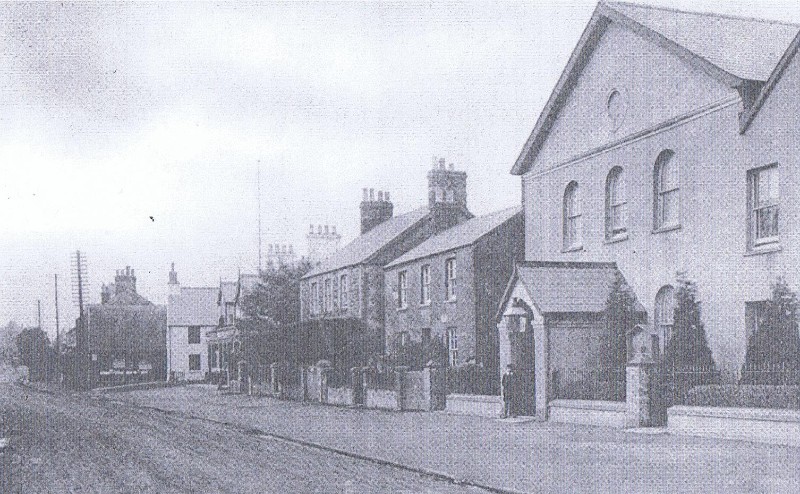  By: Nigel Lewis on 05/02/2022 101 THINGS YOU (PROBABLY) DIDN’T KNOW ABOUT WHITCHURCH ... Exciting news and a catch up... We’re delighted that so many people enjoy our weekly dip into the past history of our village
We’re now a third of the way through ‘101 Things’ and your appetite shows no sign of diminishing. In our most recent blog about the Glamorganshire Canal, we had an incredible 50 ‘likes’, and just before Christmas, the blog about old cinemas drew 14 fascinating comments. Keep them coming! Just about every blog has intrigued, and have been shared with lots of others. Thank you for your continued support. We have lots more ideas for the remaining two-thirds of the series – keep reading
We thought that you might be interested in some good news for our village (just for a change!). In the autumn of last year, we learned that CADW and the Heritage Lottery Fund were offering grants under their 15-Minute-Heritage project, aiming to spread knowledge of local history throughout the Principality, and all within a 15-minute walk from home
We are delighted to share that AWEN have been successful in being awarded a grant of over £8,500 from them for a new project of ours called ‘Walking Whitchurch Heritage’. In fact, we are the only group in Cardiff to have been successful!
Built on our experience of ‘101 Things’, we hope to use the money to explore our 1,000+ year history and begin to introduce a series of digitally waymarked walks around the village with plaques at important locations, that everyone can enjoy
Our AWEN project will last until the end of the year, and we hope that it will improve the health and wellbeing of us all as we slowly emerge from COVID. Who knows, maybe the project can continue to grow in the coming years with further walks
As a community group, AWEN are really keen to have lots of input, so if you have any ideas or memories you want to share (perhaps from mums, dads or even stories told long-ago by ancient relatives) please get in touch. Stories and old folktales of the area will be especially appreciated
And we’re not only asking older folk. We want to hear from children, schools, local groups and clubs to contact us too. Nothing will be wasted, and it will all be included in a new Time Line of Whitchurch which we’ll keep in the Library/Hub. We think the memories of our children over the COVID period will be just as valid as the wartime memories of our grandparents, and worth recording
If you would like to share this blog with your family and friends so that they can contribute, we’d appreciate it
We’re also asking for help with the project, so if you think you might have skills (or time) and certainly enthusiasm, that you think will help, please let us know. Even if it’s only an hour or so
We have organised an inaugural roadshow in the library/hub for Wednesday 23rd February between 4 and 8 o’clock. There will be speakers, stalls, children’s activities and refreshments. This will be very informal and is our opportunity to explain the scheme to the community and what it will mean to the village. Everyone is invited to this and we’re keen to see as many folk as possible. Please note the date. In the meantime, if you would like to share memories, photographs or stories please send them to us at www.awenthelibrary.cymru and we’ll start to catalogue them. Alternatively, just bring them along on the day
And, of course, ‘101 Things’ continues. Next time we’ll be looking at the first independent chapel in the village. Keep reading (and thanks)  By: on 03/02/2022 101 THINGS YOU (PROBABLY) DIDN’T KNOW ABOUT WHITCHURCH CATCHUP
We’re delighted that so many people enjoy our weekly dip into the past history of our village
We’re now a third of the way through ‘101 Things’ and your appetite shows no sign of diminishing. In our most recent blog about the Glamorganshire Canal, we had an incredible 50 ‘likes’, and just before Christmas, the blog about old cinemas drew 14 fascinating comments. Keep them coming! Just about every blog has intrigued, and have been shared with lots of others. Thank you for your continued support. We have lots more ideas for the remaining two-thirds of the series – keep reading
We thought that you might be interested in some good news for our village (just for a change!). In the autumn of last year, we learned that CADW and the Heritage Lottery Fund were offering grants under their 15-Minute-Heritage project, aiming to spread knowledge of local history throughout the Principality, and all within a 15-minute walk from home
We are delighted to share that AWEN have been successful in being awarded a grant of over £8,500 from them for a new project of ours called ‘Walking Whitchurch Heritage’. In fact, we are the only group in Cardiff to have been successful!
Built on our experience of ‘101 Things’, we hope to use the money to explore our 1,000+ year history and begin to introduce a series of digitally waymarked walks around the village with plaques at important locations, that everyone can enjoy
Our AWEN project will last until the end of the year, and we hope that it will improve the health and wellbeing of us all as we slowly emerge from COVID. Who knows, maybe the project can continue to grow in the coming years with further walks
As a community group, AWEN are really keen to have lots of input, so if you have any ideas or memories you want to share (perhaps from mums, dads or even stories told long-ago by ancient relatives) please get in touch. Stories and old folktales of the area will be especially appreciated
And we’re not only asking older folk. We want to hear from children, schools, local groups and clubs to contact us too. Nothing will be wasted, and it will all be included in a new Time Line of Whitchurch which we’ll keep in the Library/Hub. We think the memories of our children over the COVID period will be just as valid as the wartime memories of our grandparents, and worth recording
If you would like to share this blog with your family and friends so that they can contribute, we’d appreciate it
We’re also asking for help with the project, so if you think you might have skills (or time) and certainly enthusiasm, that you think will help, please let us know. Even if it’s only an hour or so
We have organised an inaugural roadshow in the library/hub for Wednesday 23rd February between 4 and 8 o’clock. There will be speakers, stalls, children’s activities and refreshments. This will be very informal and is our opportunity to explain the scheme to the community and what it will mean to the village. Everyone is invited to this and we’re keen to see as many folk as possible. Please note the date. In the meantime, if you would like to share memories, photographs or stories please send them to us at www.awenthelibrary.cymru and we’ll start to catalogue them. Alternatively, just bring them along on the day
And, of course, ‘101 Things’ continues. Next time we’ll be looking at the first independent chapel in the village. Keep reading (and thanks) By: Nigel Lewis on 28/01/2022 101 THINGS YOU (PROBABLY0 DIDN’T KNOW ABOUT WHITCHURCH 35 Santes Dwynwen
Happy Dydd Santes Dwynwen! 25th January, a very important day for all lovers in Wales. Santes Dwynwen is the Welsh patron saint for lovers. A bit like Valentine’s Day, but if you’re Welsh (or aspire to be) it’s so much better
The most romantic day of the year in Wales (it’s not Burn’s Night – which falls on the same day!) You can exchange cards and gifts Or treat yourselves to a special meal Or go for a romantic walk Or perhaps carve a lovespoon Or, best of all, have a cwtch in front of a roaring fire!
So, who was Dwynwen and why is she a saint?
Dwynwen was a princess who lived in the 5th century and was by far, the prettiest of the 24 daughters of King Brychan Brycheiniog. She lived in what is now the Brecon Beacons. The image below gives a suggestion of what Dwynwen might have looked like
Sadly, Dwynwen was unlucky in love. She had fallen in love with a handsome man called Maelon Dafodrill from North Wales. However, her father, the king had other plans and wanted her to marry an important prince. She refused, and Maelon didn’t understand and became angry (so much so that God turned him into a block of ice!)
What was she to do?
In her despair, an angel appeared and offered three wishes (just like all of the best stories!). She asked: That Maelon be thawed from the block of ice That God help all true lovers and (most bizarrely) Her third wish was that she would never marry!
The angel granted all three wishes. So, Dwynwen became a nun and travelled the length and breadth of Wales setting up church communities. When she arrived at a small island off the coast of Anglesey, she realised that this was to be her future home
She set up a nunnery on the island, and lived out her life in isolation and prayer. She’s buried in the churchyard that carries her name, St Dwynwen’s at Llandwynwen on Ynys Mon. She was declared a saint in the Middle Ages, but it was only in the 1960’s that we woke up to appreciate her importance
If you’re looking for a pilgrimage, you can’t ask for a better destination. But be careful, the church is not on an island, just a remote peninsular (except when there’s a high tide), on the southwest tip of the island of Anglesey
So, what has Dydd Santes Dwynwen got to do with Whitchurch? Not much apart from she’s our patron saint of lovers, and also it always falls on my birthday! Happy Birthday Nigel!! 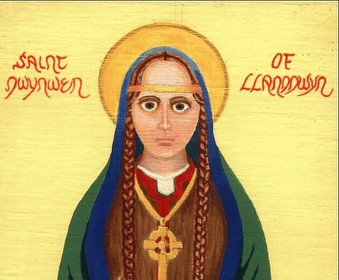 By: Nigel and Chris Lewis on 21/01/2022 101 THINGS YOU (PROBABLY0 DIDN’T KNOW ABOUT WHITCHURCH
34 The Glamorganshire Canal
Everyone knows that we’ve got a stretch of the old canal running through the village, but how many of us know much more than that?
It took 4 years to build the Glamorganshire Canal. Starting in 1790, with an army of navigators with picks and shovels. The 25-mile-long canal had 50 locks and dropped 165m (about 500 feet) from Merthyr Tydfil to Cardiff. It even had an aqueduct over the River Taff at Abercynon!
It wasn’t the best construction, and in the early years there were many breaches and collapses, with squabbles between the builders, designers and the canal owners. The defects were mostly repaired and whilst more money had to be found, the canal was completed
Once resolved, the canal became an overnight success. Even though the canal company could by law only pay dividends of 8% (remember them?), they were making so much money that they reduced their barge tolls by 75% as well
Each of the 50 locks had a lock-keeper’s cottage, and with upwards of 200 barges on the canal, the lock-keepers were kept very busy. Each lock would have been opened and closed every 15 minutes or so, with traffic up and down stream. It must have been an incredible sight, and also very hard work for the lock-keeper (and his family)
Of the 50 locks, there were 3 locks in Whitchurch, 2 upstream in Tongwynlais (including a barge-weighing machine), and 3 downstream in Llandaff Yard
The barges were all of a standard design and were all horse-drawn. There were sections of canal which were widened to allow the barges to pass one another, and basins for barge turning. At Melingriffith there was a basin and a branch canal to allow barges to enter the works. At Tongwynlais and Llandaff Yard were wharves where barges could be maintained and repaired. The photograph below (courtesy of Stephen Rowson and his book Glamorganshire and Aberdare Canals: Vol 2) shows the lock and basin at Llandaff Yard adjacent to the Cow & Snuffers Pub. The Tivoli petrol station now stands where the single-storey buildings are in the photograph
Almost as soon as the canal opened around Whitchurch, Richard Blakemore of the Melingriffith Tinplate Works complained about water shortage to his works (no wonder with all the locks on the canal opening and closing so often!). The canal company paid for a water pump to be installed at the works to help alleviate the problem, but it took over 30 years to financially resolve the problem. The original water pump (which is a listed structure) has been restored and remains on Ty Mawr Road opposite Oak Cottage
With the opening of the railways in the 1840’s, the canal started to lose business, and began a slow decline. The Marquess of Bute acquired the canal business in 1885, And by 1898 closed the top section from Abercynon to Merthyr Tydfil. However, at the southern end, he built an extension in 1888 with a sea-lock to connect the canal to his shiny-new docks in Cardiff
The terminal decline however, continued, and the last barge travelled on the canal in 1942. Cardiff Council bought the canal in 1944 and wanted to close the whole thing, but some traders objected, so some limited trade continued. In December 1951, a sand-dredger crashed into the inner lock-gate at the dock end and all of the water drained out. The gate was never repaired, so the canal finally ceased!
Only 2 stretches of the canal remain, with water; a small section at Pontypridd (behind Sainsburys on the A470), and is well worth seeing, and the long stretch through Forest Farm that we all know and enjoy
When Cardiff Council acquired the canal in 1942, they explored the possibility of utilising the canal north of Cardiff as an amenity with sailing and boating through the countryside. There was never any money for this in the immediate post-war years and anyway, Whitchurch was outside the city boundaries. It never happened
What an opportunity missed. Imagine the canal restored, with the locks and cottages rebuilt
We’re fortunate that the remaining part of the canal and feeder are still being maintained by the conservationists and volunteers at Forest Farm
But what an opportunity there is for even a modest scheme of restoration and improvement to see our canal being used again. What a wonderful attraction that would be, with boats and barges nestled under the backdrop of Castell Coch. Perhaps for another day!
What do you think?
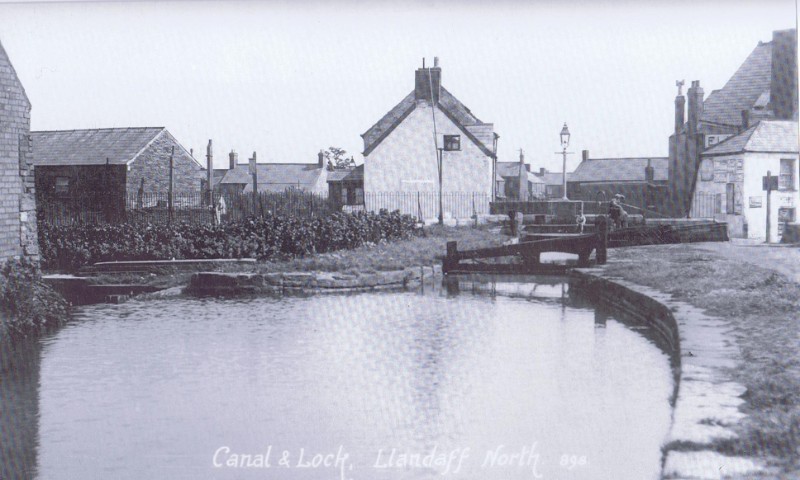 By: Chris and Nigel Lewis on 13/01/2022 101 THINGS YOU (PROBABLY0 DIDN’T KNOW ABOUT WHITCHURCH 33 Old Povey’s House Another mystery house!
In 1904, when the parish council were considering renaming the streets of Whitchurch, there was a proposal to rename the southern end of the old Merthyr Road, to call it ‘The Philog’; a name that continues to this day
The stretch ran from ‘the parish boundary at the south, to Old Povey’s House’
A second section to be renamed as Gwauntreoda ran from ‘Old Povey’s House to the blacksmith at the stream’
But where was Old Povey’s House, and who was Old Povey?
The old maps don’t help much. As we’ve found out previously, there were no houses shown south of the Common on the Tithe Map of 1841, and by the time of the earliest Ordnance Survey map of 1880, a lot of the north side of the old Merthyr Road had been developed (but nothing on the south side, except for the old farm)
By the 1860’s the village was growing, with the Melingriffith Tin Works to the north and the College Iron Works at Llandaff Yard. And of course, the railways had arrived. New people were moving in and houses were needed
The land around Wauntreoda was early in the village growth. We’ve seen how William Vachell built a gentleman’s residence on the north side of the common, and that whole stretch started to be developed in the decades to follow
By the time of the census in 1861, William Vachell’s house, Bryn Glas, was occupied by the Bedlington’s and a number of terraced cottages had been built alongside. There was Philog Terrace to the south and Alma Terrace nearer to Bryn Glas. There was even a grocer’s shop (probably one of the first ‘proper’ shops in the village). The sketch below shows how the area was developing
Amongst the newcomers was the Povey family who were living at Wauntreoda (not sure whether this was the name of a house or the area). John Povey was a 69-year-old gardener from Berkshire, living with his wife Harriet, 3 children, a niece, a daughter-in-law and a lodger. Looking at the 1880 OS map, there was a detached house within a large plot which would have been ideal for a market gardener. I wonder whether this was his home? It’s also at the spot where the change in street name would have occurred
As an aside, John Povey’s oldest son Phillip was living locally too in Pantbach just behind the common. By the time of the 1871 census, we seem to have lost John Povey, but his male children remain in the village
So, was John Povey, who was living on the old Merthyr Road with his family and market garden the basis of ‘Old Povey’ referred to by the parish council over 40 years later? Again, we’ll probably never know. He must have been a character, to have been remembered all those years later!
Interestingly, the plot where I think ‘Old Povey’ lived has now been transformed. A lot more houses have been built, and the old ‘Povey’ house long demolished and replaced by a block of flats, Philog Court This is the 3-storey block with the pierced concrete screen in the front; probably built in the 1950’s or 60’s
Does anyone know anything about this. Or will ‘Old Povey’ and his house remain yet another of the mystery houses of our village?
PS Phillip Povey (aged 81), Old Povey’s oldest son was living in Ironbridge Road Tongwynlais in 1911. I wonder if there are any family members still around in the village? 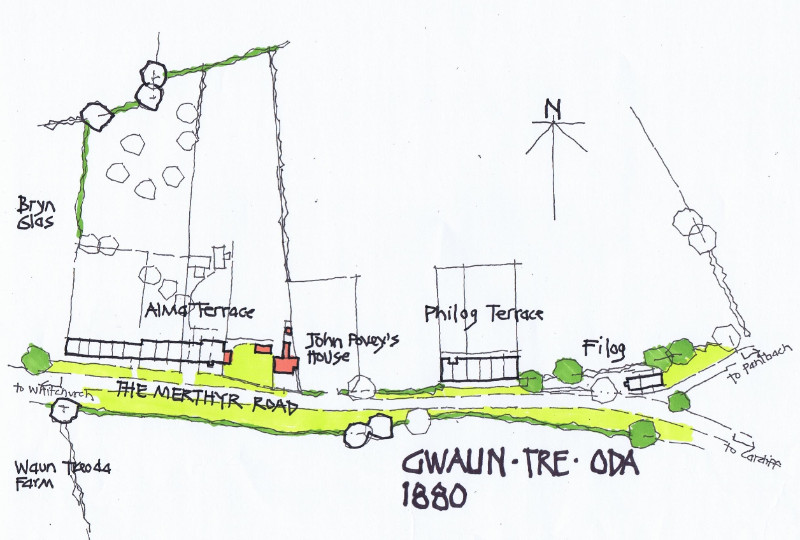 By: Chris and Nigel Lewis on 06/01/2022 101 THINGS YOU (PROBABLY0 DIDN’T KNOW ABOUT WHITCHURCH 32 The Footpaths of Whitchurch
Before the cars and lorries that dominate our lives nowadays, before the horses and wagons, before the roads and lanes were the footpaths and ancient ways
Where were they, and where did they go?
Did they have names? And are there any left?
What were they like? We’ve looked at cart-tracks and the turnpike previously, but looking at the oldest Ordnance Survey maps there were quite a few footpaths around the village too:
The road through the village north, towards Tongwynlais, would probably have been a footpath in ancient times, changing to a cart-track as the village grew
Similarly, the route south from Gwaun-tre-Oda towards Cardiff. This footpath also veered east at the Philog towards the Heath estate, and onwards to the Great Heath beyond
There was a footpath north from old St Mary’s and the castle up to the farms Ashgrove and Pentwyn and beyond. This is now the A470!
The ancient drover’s way from Eglwysilian and Gelligaer over Thornhill crossed Rhiwbina and Caedelyn towards the castle. It then followed the brook, crossing the Merthyr Road at the Village Farm onwards to Llandaff Yard. There it crossed the River Taff at a ford and on to Radyr
A further ancient way followed Pantmawr to the Hollybush, then to the Tithe Barn, crossing fields to the (now lost) Heoldon Farm and towards Llandaff Yard and the old bridge at Llandaff
Then there was the old route from Melingriffith, past Velindre and the crossroads to the old church and castle
There are indications of other footpaths, like the one where Tywern Road now runs And along the bank of the River Taff towards Tongwynlais. We’ll probably never know where all of the footpaths ran, nor their importance
Some of these footpaths were of the long-distance type and simply passed through Whitchurch, but others were naturally formed ‘desire lines’ linking groups of houses or farms
The map below shows some of the footpaths and their routes around the village. This is a map without roads or railways and is timeless. At least hundreds of years old and probably much older!
The only old footpath I know of now runs behind Caegwyn Road and Manor Rise and forms a rear lane. It opens up at the traffic lights on Manor Way and is overgrown with shrubs and trees. Deliberately abandoned, but clearly the ancient footpath
Does anyone know of any other survivors? 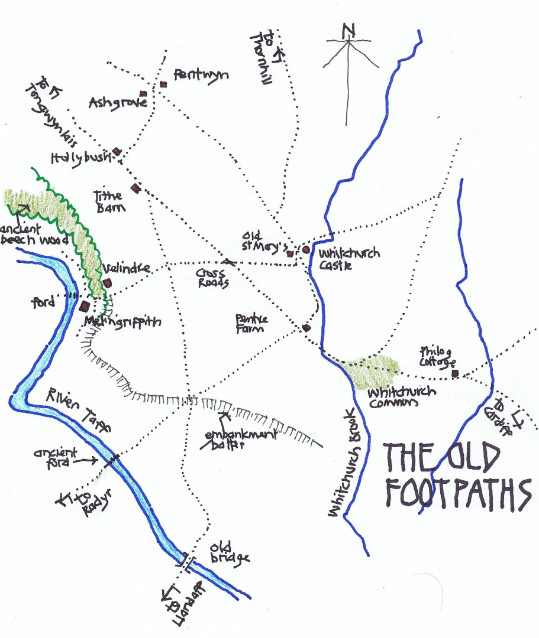 By: Chris and Nigel Lewis on 31/12/2021 101 THINGS YOU (PROBABLY0 DIDN’T KNOW ABOUT WHITCHURCH
31 New Year Celebrations
The turn of the year, and the last few hours of a turbulent twelve months that many might be quite prepared to forget!
How many New Years have there been in our village? Obviously, thousands, but I wonder what happened in times gone by?
In recent times, New Year seems to have been taken over by Hogmanay and the fireworks in London, but it was not always so
Whilst many of our local traditions are largely forgotten there are still memories of celebrations of years gone by. First Footing, Calenig and of course the Mari Lwyd. In the long-lost times, there was also the Roman feast of Saturnalia
In the rural past (before industry came to Whitchurch), there were only scattered farms and just a few cottages. Everyone knew everyone. Was it the case that New Year was more important than Christmas?
Was this the same for hundreds of years? A Welsh-speaking rural community where traditions were very important. Deeply religious, but at the same time mindful of the natural world; the risk of bad luck at the beginning of the New Year would be disastrous. Life was so fragile
To achieve that good luck was very important, so the invitation of a dark-haired man to cross the threshold, seconds after the chiming of the New Year was special. This happened across south Wales, even in living memory
The Calennig (winter festival) in Cardiff has been part of the local Christmas/New Year season in recent times. However, the traditional Calennig in rural Wales was very different. An apple complete with three stick ‘legs’ and raisins as decoration for each child, and a first-day celebration with the children running from house to house singing and ‘trick-or-treat’ splashing of water
And of course, the performance of the Mari Lwyd; strongly held in the rural areas of south Wales where groups of (mainly) men dressed in strange garb with a horse’s skull mounted on a long pole with a white sheet, ribbons, bells and lantern lights, all visiting neighbouring houses in the early hours of New Year’s Day singing and performing their elaborate show
The supporters of the Mari Lwyd would sing and entreat the householder to invite them in, whereas the householder would try his (or her) best to prevent this with song and poetry (called Pwnco). There are many stories of this pageant in the villages north of Whitchurch in the 19th century, and I’m sure that the Mari Lwyd was well known in our village too
The whole thing seems to have died out early in the 20th century, but there have been many attempts to resurrect it. The Folk Museum at St Fagans have held reconstructions in recent years
Wouldn’t it be lovely to think that Whitchurch could plan such an exciting event again, but the horse skull and costume would only be the start. I’m told that there are still Welsh-speaking poets locally who have recorded the Pwnco repartee. So, all of this could be possible. What do others think?
Below is a sketch (a bit fanciful perhaps) of the nightmarish Mari Lwyd
Does anyone know where we could obtain the skull of a horse?
Perhaps for now, in these covid-ridden times, it’s best to bar the door, draw the curtains and throw an extra log on the fire. And if you hear some outlandish sounds outside, just pretend you’ve already retired to your bed
Anyway, stay safe, have a happy New Year and Blwyddyn Newydd Dda! 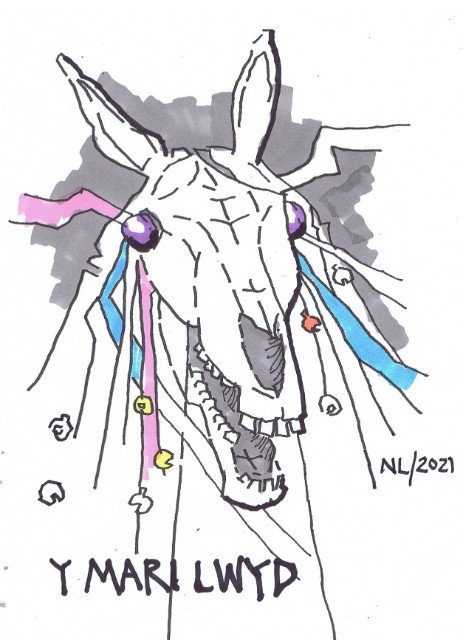 By: Chris and Nigel Lewis on 24/12/2021 101 THINGS YOU (PROBABLY0 DIDN’T KNOW ABOUT WHITCHURCH
30 Christmas in Whitchurch
Happy Christmas Everyone!
Christmas Eve, and it’s a chance to sit down (hopefully by a blazing fire with a Yule Log) and look back on what the Christmas season was like in our village in past times
Before Christianity, the lives of our Celtic ancestors would have been governed by the long winter nights, celebrating midwinter with garlands of Ivy, Holly and Mistletoe. Farming and husbandry would be curtailed by the cold hard winter and folk would keep close to their fires for warmth
I wonder what the early Christian church celebrations were like in the eighth and ninth centuries? The only church would have been at Melingriffith
With the coming of the Conquest, the Church changed with Latin Mass, the forced introduction of Norman French, and the formal introduction of Christmas. Over time, our local church would have been dressed at Christmas with garlands of ivy and holly and lots of candles, to light the darkness
At home, families would still sit around their hearths, sharing stories of long before, and how important a family Christmas was. Over the centuries, Christmas Day grew in importance with family and friends celebrating
By the time of Cromwell, the Commonwealth and the Puritans, Christmas (and over-indulgence) were frowned upon and the whole season downplayed. I wonder what effect this had on Whitchurch? Did things change much in the following centuries?
With the coming of the Hanoverians, and in particular with Queen Victoria, things changed rapidly. Christmas trees and lights (thanks to Prince Albert), Christmas carols and songs, cards, presents and festive food became increasingly important
What did people eat? Not turkey (until much later), goose or chicken perhaps, pork (because it was Whitchurch!), or maybe rabbit; even porridge if you were really poor. Plum pudding/Christmas pudding was always traditional; I can remember a silver sixpence in my pudding. Does anyone else remember this?
St Nicholas was an import from eastern Europe, and Wales always has Sion Corn for the children. Father Christmas was a later American import. How many people knew that Santa and his beard and red coat was an advertising gimmick from Coca Cola!
The Bookers were not exempt from the Dickensian largesse; the Cardiff & Merthyr Guardian of 12th January, 1850 reported:
‘Seasonal liberality on New Year’s Day and the day following, Mr Booker of Velindra made his annual distribution of 100 tons of coal among the poor of the parish, and at the same time Mrs Booker distributed her annual presents of blankets and flannel. The farmers of the neighbourhood very kindly hauled the coal to the respective habitations of the poor recipients’ In more recent times, Ernie Broad remembers the local children singing carols at the door of ‘Squire’ Phillips at the Pines, and being rewarded with Christmas sweets
I can remember a yearly Christmas stocking which always included a tangerine, a piece of coal, some sweets, a few nuts and a small toy. I can imagine that in earlier times the toys were often homemade, perhaps a peg-doll or a carved animal
Christmas wasn’t Christmas without a big cake with icing, Christmassy figures on top and a colourful frill around
Television in the 1950’s and 60’s was quite special with the Queen’s Speech, and in later times a Morcombe and Wise Special. There was always a pantomime if you were lucky!
Room decorations were always homemade paper chains and hanging paper lanterns
Christmas trees were always ‘real’ and the needles that dropped were a hazard when playing with new toys
I’ve never experienced a wartime Christmas, but they must have been quite different. Does anyone have any memories?
And, of course, it always snowed on Christmas Day (or am I just imagining that?)
MERRY CHRISTMAS, ONE AND ALL HO, HO, HO! Next Reminiscence group 1st Feburary 2022! 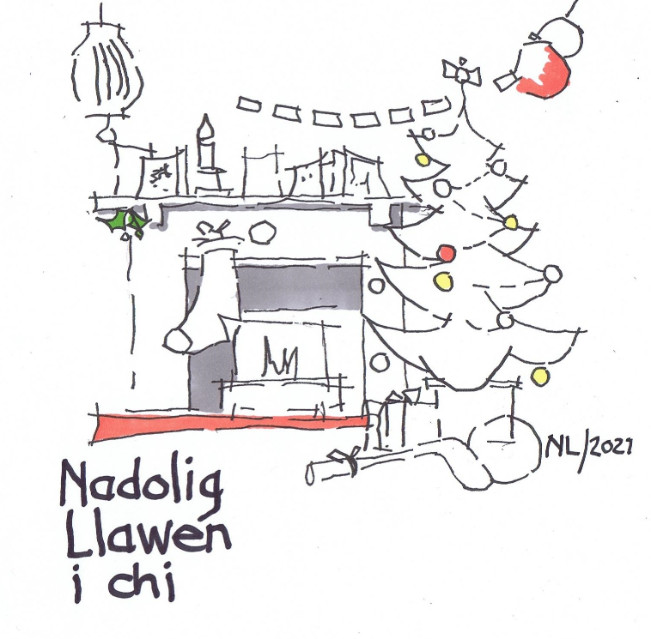 By: Chris and Nigel Lewis on 18/12/2021 Here is this week's instalment of 101 Things You Probably Didn't Know About Whitchurch this week Cinemas 29 Cinemas in Whitchurch
We seem to be fast approaching Christmas, and in earlier times we might be thinking of popping down to our local cinema to watch the latest ‘flick’ from Hollywood
It’s all so different now with streaming, surround-sound television and multi-choice channels, but it wasn’t long ago that, whilst the wireless was okay, the cinema was the only way for some escape from the daily drudge of everyday life
Friday night, or Saturday if you wanted to be really posh and queue up with the swanky folk to ‘escape’ for a couple of hours. There was always a B-movie, the main film (with an intermission between so that you could buy some ice cream), and the National Anthem at the end, where we all had to stand up solemnly to show respect
So where were our local picture-palaces?
The Rialto was located off Old Church Road, just behind the Plough Inn. It’s all gone now, demolished in 1976 and replaced by flats in the 1980’s, but when it was first built it was called ‘The White Palace’. It was built c1914 by Samuel Bennett (the house-builder we learned about back in June) and had 450 seats and a sloping floor. Silent films at first and then converted to sound in the early 1930’s. there are very few photographs, but the sketch below shows how the Rialto might have looked in its halcyon days
Does anyone know more about this cinema, and what films were shown?
In Llandaff North, there was the Tivoli, where the petrol station now is. Another casualty. Also built c1914 and opened as the Royal Cinema, renamed the Llandaff Cinema in 1924 and burned down in 1930! It reopened in 1935 as the Tivoli, seating 500 and sadly closed without warning in 1958
In Rhiwbina was the Monico. This was a ‘proper’ picture palace and dominated the local area. The flats (sorry apartments) which are there now, are often referred to by the locals as ‘the Monico flats’. The Monico cinema was opened in 1937 showing a Gary Cooper film ‘Lives of a Bengal Lancer’. The cinema had 950 seats with stalls and a circle. In the 1970’s when larger cinemas started to become multi-screen, the Monico underwent a transformation with ochre and brown cladding externally and two screens inside, seating 433 and 156 patrons
Both of my sons went to the Saturday-morning matinee at the Monico, where Brian Bull, the owner/manager acted as compere showing a wonderful confection of children’s adventures, cartoons and competitions. Lots of childhood memories for both my boys!
Sadly, the Monico finally closed in 2003
All of these have now gone, and largely forgotten. Does anyone have memories of any of these cinemas they’d like to share?
And now we have the Nantgarw Showcase cinema complex, and the fast-food eateries just outside. Is this the future?
Grateful thanks to the Cinema Treasures website and to the Dic Mortimer blog for much of the detailed content contained in this issue Hyb yr Eglwys Newydd Whitchurch Hub Old Cardiff Pics
1Sarah Duncan-Jones
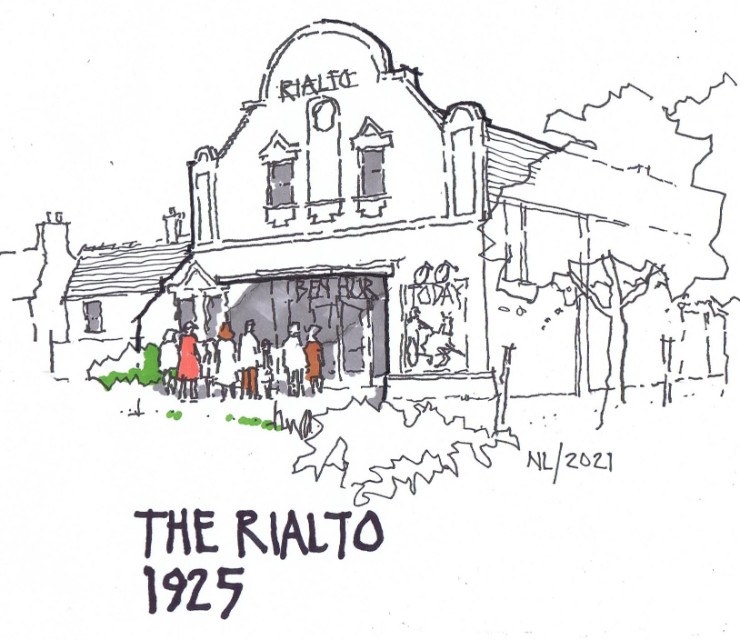 By: Chris and Nigel Lewis on 09/12/2021 28 The Turnpike
The village boundaries today seem to be defined by roads and railways. To the north is the M4 and Junction 32, to the east is the busy A470 and the Gabalfa Interchange to the south. The west boundary remains (as always), the River Taff
Unpick time by a hundred years and the village begins to look different; just the old Merthyr Road and the quieter side roads east and west. Another eighty years (to 1847) and there were no railways, and a further fifty years (1794), no canal. Unpick a further twenty-five years (to 1767) and the village begins to look very different indeed. That was the year the turnpike road was opened
It’s hard to believe that only 250 years ago, there was no road north from the village. There was the ancient unmade cart route to Tongwynlais and the old pack-horse routes over the tops of the hills via Thornhill and Eglwysilian, but that’s all. Anyway, there was no real need to go anywhere north, as all of the hamlets and villages in the Taff valley were very agricultural, self-sufficient and were very similar to Whitchurch The industrial towns of Merthyr and Dowlais were far away and had their own road connections, so there was no need for a north-south road
This was a time before coal was discovered commercially in the valleys
But local land-owners were beginning to realise the opportunity to move goods and people around the country. Just three years earlier in 1764, a private turnpike road had started construction between Gloucester, Cardiff and Swansea. The local councils (such as they were), were being cajoled into improving the county roads, but without much success. That’s why, in 1767 a turnpike road was opened from Tongwynlais, north towards Merthyr Tydfil. All of the turnpike roads were privately-funded and were such an improvement on the old medieval tracks everywhere. However, they still had a stone and dust finish and needed regular maintenance
The old photograph below shows the location of the old tollhouse and gate at Llandaff (actually they used a chain rather than a gate, hence Radyr Chain!)
A gate and tollhouse were opened in Tongwynlais, where the toll was paid. There’s a rebuilt tollhouse and gate at St Fagans with a painted board listing the toll charges The tollhouse and gate in Tongwynlais were only removed many years later after much local complaint and objection
The local road through Whitchurch village was finally ‘improved’ and became the Merthyr Road. In 1820 a daily 4-horse coach service from Cardiff to Merthyr Tydfil was started. The coach would have passed through Whitchurch and would have led to the development of coaching inns at the 3-Horsehoes and the 3-Elms both with stabling and smithy. The Hollybush (which even then would have been quite old) would have provided fresh horses for the climb up to Tongwynlais and beyond. By 1830, a second daily coach service had started
No-one liked to pay the tolls. By 1839 the Rebecca Riots had started in Cardiganshire/Carmarthenshire (led by men disguised as women and known as Rebecca), objecting to the turnpikes and demanding the removal of the tollgate system. By 1842 the riots recurred in west Wales and a year Later to Pontaddulais and the Vale of Glamorgan. I wonder if there was any unrest in Whitchurch?
By then, of course, the Glamorganshire Canal had opened and the first section of the Taff Vale Railway too
When did the tollgate finish in Tongwynlais? Does anyone know? And what became of the tollhouse? 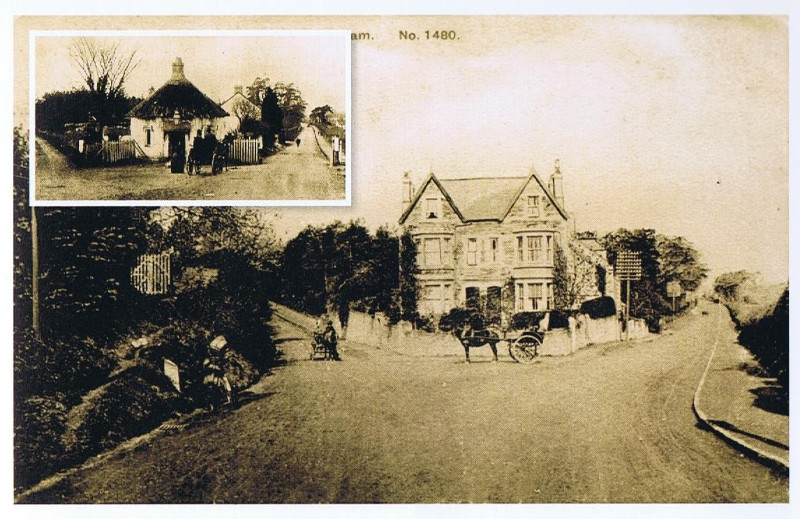 By: Chris and Nigel Lewis on 02/12/2021 101 THINGS YOU (PROBABLY0 DIDN’T KNOW ABOUT WHITCHURCH 27 Old St Mary’s Church Last time, we looked at Whitchurch (or whatever it was called) from the dark ages to the conquest, and where the original church might have been located. We finished by wondering whether a church might have been built close to the Norman ‘castle’, and whether this might have been where old St Mary’s Church stood?
This time we’ll explore the building in Old Church Road, and try to understand a little of what might have happened since 1266
Old St Mary’s was only demolished in 1904 and, like many of our older buildings in the village, lost to us. So, we’ll need to do some digging through the documents we still have
We’re fortunate that there are some old photographs of the church and churchyard. In addition, Cardiff University carried out an archaeological study in 1973 on the remains of the demolished church, prior to the establishment of the ‘garden of ease’ we now have. The study surveyed the demolished church and excavated under the demolition debris, exposing a lot of very valuable detail. This report can be found on www.cardiffparks.org website and is worth reading
Edgar Chappell suggests that demolished St Mary’s was built c14th century, and this is corroborated by the Cardiff University report. They suggest that the chancel was 13-14th century and the nave possibly a little later. The archaeologists also found shards of pottery and construction that could pre-date the church. So, there’s a possibility that ‘old’ St Mary’s was the site of an even older church, perhaps the one we looked at last time. Is this why Whitchurch is also referred to as Eglwys Newydd (the New Church)? John Leland refers to it by this name in c1536, although it was probably well over 200 years old by then!
So, what would St Mary’s have looked like in the 14th century? A possible clue can be gained by looking at St Teilo’s church, rebuilt at St Fagans. This is a slightly older church from west Wales, of similar size with a nave and chancel, with painted masonry walls, a stone-stated roof and small glazed windows
Sketch 1 below, is based on the Cardiff University report, and gives a good idea of the size and footprint of the church in 1876 (only 28 years before it was demolished). It’s intriguing to think that the chancel end might well comprise part of the original Norman church
What was the interior of the church like? Again, referring back to St Teilo’s, in medieval times, the limewashed internal walls could well have been painted with dramatic scenes from the Bible. There would have been no furniture then, with the worshippers standing. The church was tiny, so no more than 50-60 people. A small gallery was constructed in the 1780s to provide for the growing population, and (probably) box pews provided a little after
The churchyard was only granted permission for burials in 1616; before then many of the burials would have taken place in Llandaff
By the time of its demolition in 1904, the graveyard was completely full, and the report from Cardiff University in 1973 noted that the interior of the church was also full of ‘disarticulated skeletons’ indicating that the interior of the church had been used for burial for a considerable time before the graveyard was opened in 1616
The Cardiff University report also noted that the church had undergone many alterations over the years, with a porch added, external doors blocked up, with others opened. The chancel arch had been changed to a much smaller one, and the dry mortar floor partly covered with boarding in later times
The excavation also discovered the base of a font, just inside the south doorway, with possibly a conical clay plug. Parts of old stone roof tiles were found (the photographs taken just before demolition c1900 show a slated roof so the stone tiles pre-date these)
Shards of medieval pots and even fragments of Roman vessels were found. At the east end of the chancel a piece of wall mortar was found with some letters on it. They also found some dated 17th century roof timbers (possibly a repair) inscribed with the names of Llandaff carpenters
Where are all of these finds now? Does anyone know?
Sketch 2 below, shows the church and the churchyard as depicted on the 1876 OS map. The church footprint and graveyard are all as we find them today, but the access is quite different. The lychgate and stone walls opposite the Fox and Hounds all date from the 1970’s. Up until the 20th century, the entrance to the churchyard was from Ty’n-y-Pwll Road. There’s a suggestion of an old lychgate, but all that remains is an old stone pillar which might date back to the old entrance, or even earlier. All very intriguing
After 1974, all that is left is the ‘garden of ease’ provided by Cardiff Council. The churchyard has been cleared with many of the headstones moved to the boundary walls, and just the outline of the church left with an indication of the porch and entrance door
The landscaping of the 1970s has become quite overgrown and very weedy. In recent times, the Friends of St Mary’s Churchyard has been formed, and we need to record our grateful thanks to Zoe, Graham and their team of enthusiastic volunteers, befriending the gardens to maintain them (in spite of the covid), and to Cardiff Parks who have started to remove and replant some of the older planting
Does anyone have more information on the old church?
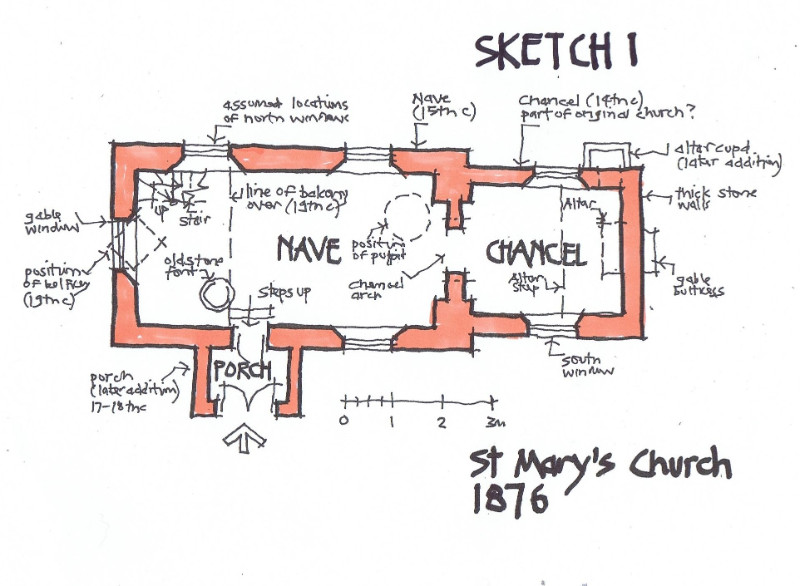 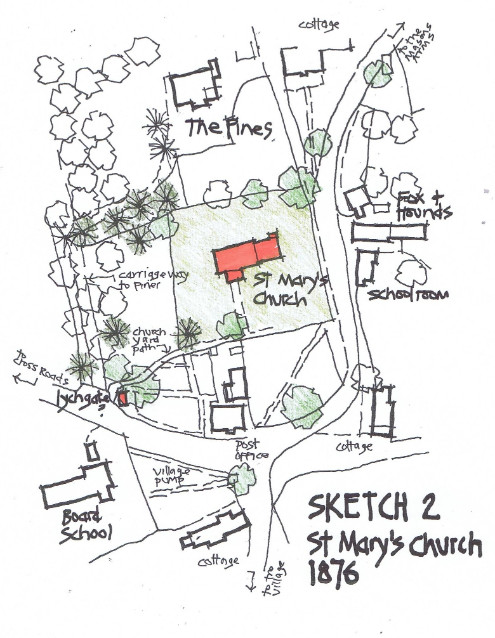 By: Chris and Nigel Lewis on 25/11/2021 101 THINGS YOU (PROBABLY) DIDN’T KNOW ABOUT WHITCHURCH (Really) Old Whitchurch
This time we’re really exploring the dim and distant past of our village. How old is this place we call home, and why is it called so many different names (in at least 3 different languages!). Where was the original church in Whitchurch?
There’s some history available, but it’s not very clear and some digging is required. And as ever, it’s all open to interpretation
We know that there had been a church at Llandaff from about 7-8th century, and later (after the conquest) became recognised as the church associated with St Teilo, a Welsh Saint from west Wales. Edgar Chappell suggests that there was an early monastic settlement at Melingriffith too, associated with the church at Llandaff. But this was some time later, perhaps in the 8-9th century, and probably lasted for a long time
So where was it? If it was at Melingriffith, it could have been on the ancient footpath route to Radyr and Llandaff and the ford across the river. By 1126, a first mention of a religious institution was mentioned ‘associated with an old mill’, perhaps this was the same settlement
Penllan (or Pen-y-Llan) was an ancient farm off Velindre Road, adjacent to the batter at Melingriffith. Pen-y-Llan means ‘above’ or’ top’ of the church, so could it refer to a church building on the river bank below? How long would it have been there, and are there any signs still remaining? Probably not
Did it move?
There’s reference to a castle in Whitchurch about 1100-1200 and this was the time when the Norman lords were fighting a continuous skirmish war with the local Welsh chieftains. It has been suggested that this ‘castle’, was a motte-and-bailey (an earth mound with a timber stockade on the top) and might have formed part of a line of defences set up by Gilbert-de-Clare, the Norman Lord of Glamorgan
We know that there was such a ‘castle’ behind the Fox and Hounds pub until relatively recently
It’s not unreasonable to think that a house, or two could probably have been built adjacent to the castle at the time, and maybe even a small church. For safety, such a church would need to have been quite close, perhaps only a few hundred metres away. Could it even have been on the site of the ‘old’ St Mary’s Church?
There are hardly any examples of pre-conquest churches in Wales so we would struggle to recognise one. The church would have been quite small, and probably built of masonry with a tiled or thatched roof with the outside walls finished with limewash. Could this have been the church referred to c1266 as Blancminster and Album Monasterium by the Normans?
And what was its name? Was it St Mary’s? Before the Normans, churches were often named after local saints. We’ll probably never know
Apart from the castle mound (which was finally levelled in the 1960’s) and the stream running adjacent, nothing remains. So, all of this has to be speculation; but it does sound plausible
Here are a couple of sketch maps. The first shows the area around the castle at the time of the Tithe Map in 1841. Just the castle mound, a diverted stream, a few farms and cottages, a pub and St Mary’s Church. Not very different to the early OS map
The second sketch takes us back to 1266. This is a stretch of the imagination and shows how important the castle was. Even fewer cottages and perhaps a church adjacent. No fields, no roads, just the ancient footpaths and the stream. Was the stream diverted to act as a moat? It certainly provides an excellent defensive barrier from the east
What do you think?
Next time we’ll look at ‘old’ St Mary’s and explore a little of that
  By: Chris and Nigel Lewis on 19/11/2021 101 THINGS YOU (PROBABLY) DIDN’T KNOW ABOUT WHITCHURCH
Richard Blakemore and TW Booker
Do you ever dream about receiving a phone call or a letter from some dusty solicitor advising you that a long-lost relative has died and left you with a sizeable ‘inheritance’?
Back around 1810, Thomas William Booker, then aged about 18 (and who lived in Bristol) was invited to meet up with his uncle Richard, and received such an offer
Uncle Richard (Blakemore) who was unmarried, was fabulously wealthy, had large estates in Herefordshire and had just acquired a flourishing mill and iron foundry in Whitchurch, with a large house and land
All TW had to do was to join his uncle in Whitchurch and help him to grow the business. What an offer; one which he couldn’t really turn down!
The mill and iron foundry (called Melingriffith) were really profitable, employed hundreds of people and had bags of potential. The Glamorganshire Canal had only been opened just over 10 years earlier, and offered incredible opportunity for access to new markets, and the canal flowed alongside the works
The house (Velindre) which was just above the works was quite old, but had been fashionably restored and extended. Uncle Richard also owned local farms such as Ty Clyd and Forest Farm and was quite the country gentleman
Needless to say, TW accepted his uncle’s offer. The sketch below shows Melingriffith and Velindre about 1810, when TW joined the enterprise. Velindre was quite different from the old house that Uncle Richard had acquired from the Vaughan’s and had been expanded and gentrified with extensive gardens and views. Melingriffith had grown too with its own wharf off the new canal. We don’t know very much about the area except the few details from the later tithe map
Over the coming years, Uncle Richard stepped back from the business and left the running to TW. The iron foundry was modernised and expanded, and he acquired the Pentyrch Ironworks just up the river. He even built a railway to link the two together
TW married Jane Coghlan in 1824, had a family and Velindre became the centre of the neighbourhood. TW became well regarded locally, and in 1848 became High Sheriff of Glamorgan, and a few years later was elected MP for Hereford, in Uncle Richard’s old seat!
Life couldn’t get much better for him. Uncle Richard died in 1855, and as promised, TW inherited everything. In fact, just a few months before Uncle Richard died, TW applied for a Royal Licence to change his name to TW Booker-Blakemore!
Everything was glorious, the works were booming, more and more people were employed (maybe 400-500) and TW and his growing family became the most important family in Whitchurch. He built houses for his sons at Greenhill and The Pines, and Velindre grew into a sparkling palace with extensive pleasure gardens and a huge retinue of servants. With the estates in Herefordshire and Whitchurch, TW’s estate amounted to over 8,000 acres
But nothing lasts. Less than 3 years after his uncle died, TW himself died whilst in London, at the age of 57. He died of apoplexy (nowadays referred to as a stroke), and everything that Uncle Richard and TW had worked for fell to the Booker children
But they were quite different! More about them another time  By: Chris and Nigel Lewis on 11/11/2021 101 THINGS YOU (PROBABLY) DIDN’T KNOW ABOUT WHITCHURCH 24. Charles Burley Wood VC
But you can find out more by reading here and by attending St Mary’s Church on Saturday 20th November at 10.00am when we will look at the life of CBW, see his grave and watch a very short film (as well as an opportunity to look around the church). All free.
Ever since we moved to Whitchurch, we’ve heard stories about Charles Burley Ward, the last man to receive the Victoria Cross from Queen Victoria. A man who is buried in St Mary’s Churchyard
Apart from the VC, nobody seems to know much about him. In fact, after he was buried in 1921, his grave was forgotten and lost in the undergrowth for the next 60 years. It was only after a local family history group in 1986 started checking that they found the plot, and persuaded the Commonwealth Graves Commission to erect the beautiful white headstone there
But who was Charles Burley Ward, and what was his connection to Whitchurch? There’s lots of information online, but his whole life seems to be a catalogue of sadness
CBW was born in Hunslet, Leeds in 1877 in absolute poverty. It’s not strange that CBW joined the army as a young man to escape all this and was sent to fight the Boers in South Africa. It was there in June 1900 that his piquet found themselves surrounded by 500 Boers and he volunteered to run across open ground to seek reinforcements. Even though he sustained severe injuries, he ran back to report matters and the post was subsequently relieved. For this, he was awarded the Victoria Cross (see coloured photo below with his VC)
It’s recorded that at his investiture at Windsor Castle in December 1900, CBW was the last person to receive the VC from the queen herself (she died just 5 weeks later). In fact, CBW was discharged from the army only 3 weeks after the investiture as ‘medically unfit due to wounds received in action’
He returned to Leeds, aged 24, as a deserved hero and was feted by the city. He was given a special gold medal and presented with a cheque for £600 (about £60k in today’s money). He bought a newsagent’s shop nearby and married his girlfriend, Emily. They had 3 children whilst in Hunslet, and then moved to Cardiff where they had a fourth child
But why Cardiff? The local story goes that CBW moved to Whitchurch (even the internet stories tell this) and, from December 1904, worked for the Glamorgan County Council as a Physical Instructor with an annual salary of £140
The 1911 census finds CBW, Emily and their 4 children living in Whitchurch with George, CBW’s father. Except, they weren’t living in Whitchurch at all, the census finds them at number 3 Soberton Avenue, Whitchurch Road!
CBW re-enlisted in the army (in his old regiment) in September 1914, at the beginning of WW1, even though he’d been discharged from the army in 1901 as unfit. Re-enlisting with the rank of Private, within 5 weeks, he’d been promoted 5 times to become Company Sergeant Major, and spent much of the war as an instructor. He was then discharged for a second time just 3 weeks after the end of the war in November 1918 as being ‘no longer medically fit’
It is suggested that he was suffering from mental issues; today they would probably suggest PTSD. And, if fighting through 2 horrific wars weren’t enough, things got really bad. CBW returned to Cardiff (back to Soberton Avenue?) to his family, but relations became much worse. His wife Emily died on a level crossing at Gabalfa in February 1919
Later that same year, CBW re-married, to Annie McNally (who was his cousin) and she moved into the family home and they had a child, Eric in 1920
CBW was obviously suffering from some form of breakdown as he was next found in the County Asylum in Bridgend, where he sadly died of ‘myelitis and mania’ in December 1921, at the age of only 44. He was buried with full military honours in St Mary’s Churchyard in January 1922
As a postscript, the widow of CBW was refused a war pension because he had not died of injuries directly in connection with his duties as a soldier! Even though he’d been discharged twice from the military and carried his wounds for the rest of his life. In fact, there’s an exhibit in the military museum in Doncaster showing his army jacket (see photo below) riddled with all of the bulletholes!
So, where is the connection between CBW and Whitchurch? There doesn’t seem to be one, except that he’s buried in our local parish churchyard
Nonetheless, this tragic story of an incredibly heroic man who died in such sad circumstances, bears telling and re-telling. Perhaps when we’re next in the village we should seek out his grave and give thanks to such a special ‘Whitchurch’ man
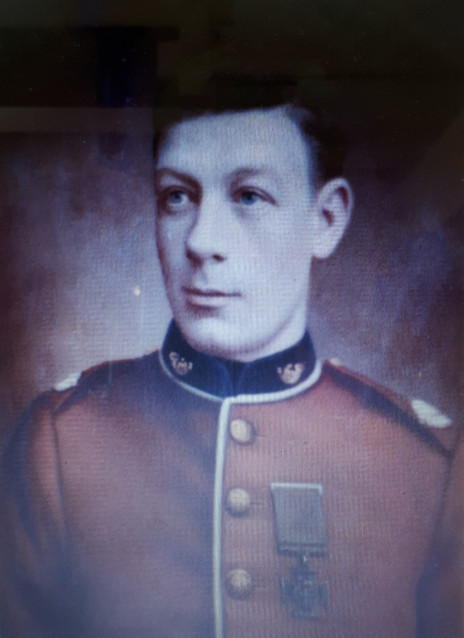  By: Chris and Nigel Lewis on 04/11/2021 101 THINGS YOU (PROBABLY) DIDN’T KNOW ABOUT WHITCHURCH
23 Tithe Barn
Did you know we had a Tithe Barn in Whitchurch?
So where was it? On the route of an ancient footpath called ‘Heol Don’ from the Wenallt to Llandaff, and just south of the Hollybush Pub (this is the footpath that had to be abandoned to allow the mental hospital to be built) It was on the west side of the Merthyr Road, just north of the current hospital entrance There’s nothing there now, but on the OS maps it’s recorded. Shown as a building on the maps of 1880 and 1900, and just as an outline on the 1920 map. All that is there now is a stand of pine trees. Perhaps the foundations of the old Tithe Barn might still be there, covered by the undergrowth?
How old was it We don’t know, but probably many hundreds of years old. When a man called Draper was found hanged in the Tithe Barn in 1810, it was referred to then as ‘old’. There are examples of tithe barns locally in Glamorgan dating back to the 12th and 13th centuries
What did it look like? Back then, it was the biggest building in the village by far. If you measure the OS map footprint it would have been about 30m long and 9m deep (100 feet by 27 feet) The Royal Commission of Ancient and Historical Monuments Wales (RCHMW) suggests that these buildings were generally long and narrow with a central doorway on both front and back faces, tall enough for a haycart (or wain) to pass straight through. In Glamorgan the building were usually built of stone, although some were built of timber with rendered panels. Because they were so tall, maybe 7-8m (20-24 feet high) to the eaves, they needed buttresses. To ventilate the hay within the building, long slot vents or windows would have been provided all around And of course, our Whitchurch Tithe Barn had a thatched roof The sketch below suggests what it might have looked like in the middle of the 19th century at harvest time
So, what were tithes, and why did they need a barn to store them? From the time of the Conquest, and probably before then, tenant farmers were required to pay their rent as a tenth (a tithe) of their crop. This was often due to the church or abbey who owned farm land. In Whitchurch, in mediaeval times, there was no great abbey, just Llandaff, and there were a number of feudal landowners as well Who had the tithe barn built, and who collected the tithes? Perhaps we’ll never know
By 1841, the Tithe Map noted that the tithe barn was in a yard approximately 1 rood and 25 perches in extent! This is about half of an acre. The tenant was David Thomas, who was also the tenant of Ty Clyd Farm adjacent. The landowner was Richard Blakemore, the man who had taken over Velindre and the Melingriffith Tinworks It’s interesting to note that the tithe barn and yard were considered of no tithe value!
What happened to it? Nearly 60 years after the Tithe Map, when the village was expanding fast and the Cardiff Railway had been built, the bridge and sloping embankments (still there today) separated the Hollybush from the Tithe Barn. However, a disastrous fire broke out, and a report in the Evening Express newspaper dated 7th February 1900 reported:
‘Shortly before ten o’clock on Tuesday morning the Tithe Barn near Holly Bush, Whitchurch, was found to be on fire. An alarm was at once given, and Police-constables Bowen and Campbell, with some of the members of the Whitchurch Fire Brigade, were soon on the spot with the fire appliance. The barn, which had a thatched roof, contained a large quantity of straw, and there was no hope of saving it’
How can it be that one of the oldest and biggest buildings in Whitchurch could be lost without trace in such recent times? Even Edgar Chappell, in his chronicle of Whitchurch gives it scant reference
If the tithe barn was located in a village in England, or even elsewhere in the county, probably the ruins or the building outline would have been preserved. We have nothing, not even a plaque. The building deserves better. What do you think? 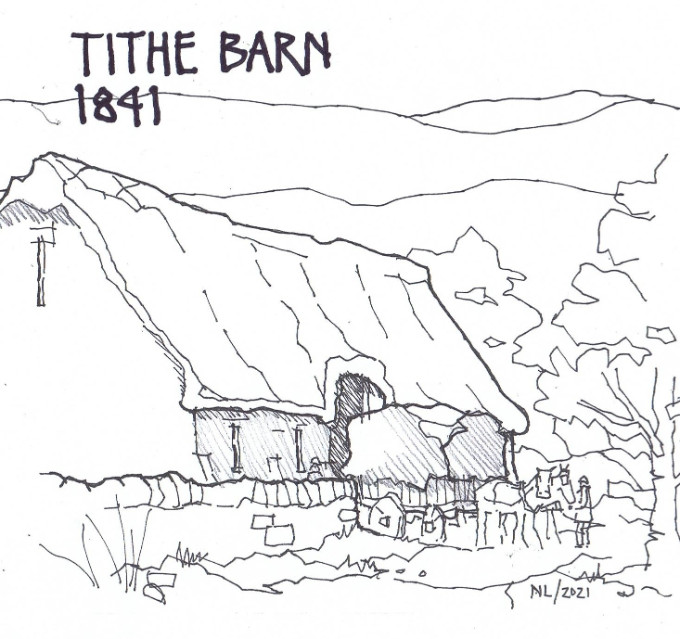 By: Chris and Nigel Lewis on 29/10/2021 101 THINGS YOU (PROBABLY) DIDN’T KNOW ABOUT WHITCHURCH
22 Ghost Stories
Now that the nights are drawing in and Autumn starts to turn to Winter, there’s nothing better than to curl up on a cosy armchair, in front of a roaring fire and to share ghostly tales from long ago
Clearly this has been happening in our village for years and years. Tales of mothers warning their young children to go to sleep quickly, to avoid the ghostly apparitions and shadowy forms in the dark corners of the bedrooms
We are fortunate that both Edgar Chappell and Ernie Broad were able to write down some of the scarier (and more lurid) tales
I love the story of the brave local lads exploring subterranean tunnels under the old ruined Castell Coch, seeking an iron chest of Cavalier treasure – only to be confronted by two ghostly royal eagles with burning red eyes protecting it, and then the boys running away in sheer terror. Is the iron chest still there? Was it ever true?
And what about ‘Y Ladi Wen’ scaring all the local boys in the dark woods near the old tithe barn? Or of the ghost of a man called Draper who was found hanged in the tithe barn?
Glenys Evans shares the story of the ghostly apparition of a young servant girl, on dark nights, all in white, wandering near to the hedges on Whitchurch Common
Both Edgar Chappell and Ernie Broad share a tale of an old cobbler and his encounter with the Devil! The old cobbler realising he was speaking to ‘Old Nick’ (who was Hell-bent on damming-up the Taff Valley at the Garth) tricks him into thinking it was miles away, so abandons his mission – if both Edgar Chappell and Ernie Broad tell the story, it must be true!
Some of the local ghost stories, like the roaring lion at Ty Mawr farmhouse were, eventually proved to be wrong, but there are so many more that have become folklore:
The spirit-lady ‘Mallt-y-Nos’, dating from Norman times
The ghostly horse ‘Ceffyl-Dwr’ in the streams at Gwauntreoda, and
The story of the ghost of a grandfather and the silver spurs hidden in the thatch of an old cottage
And what about the White Lady’s Well at Ty Clyd and its special powers (all lost now), the grim story of Llewelyn’s Tree at Penylan Farm at Velindre Road and the ghostly galloping horses in the ruins of Greenmeadow House. The lady owner of Greenhill was convinced that the old Booker house was haunted, and the old sad story of the young girl captured by Royalists, imprisoned and slain at Cilynys, Tongwynlais, the blood-splattered wall and her ghostly apparition
There must be so many more local stories; do you have any that you’re brave enough to share? 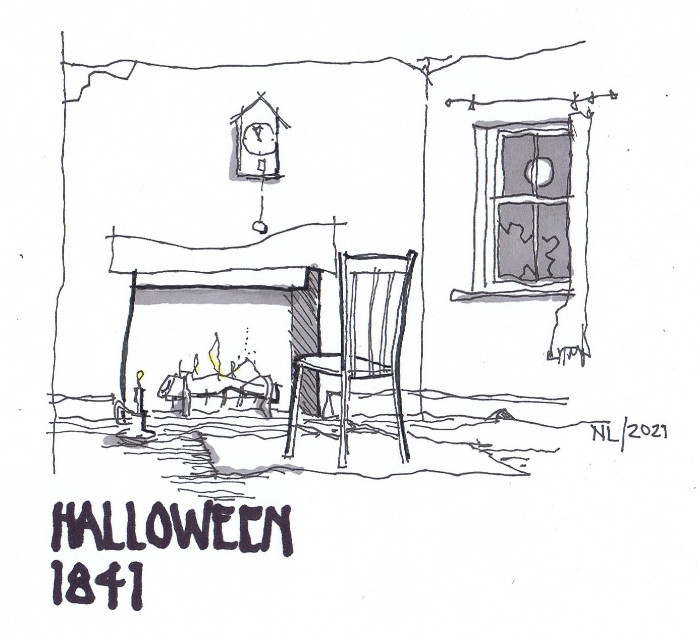 By: Chris and Nigel Lewis on 21/10/2021 101 THINGS YOU (PROBABLY) DIDN’T KNOW ABOUT WHITCHURCH 21: Why have we got so many chapels in Whitchurch?
In many villages in England quite often there is only a Parish Church and perhaps one or two Nonconformist Chapels. So why, in Whitchurch do we have so many?
We have St Mary’s Parish Church, and the site of the Old St Mary’s too, and of course St Teilo’s
However, if you count the number of chapels in Whitchurch it’s quite surprising. If you include Llandaff North, Rhiwbina and Birchgrove (all of which used to be part of the old Whitchurch Parish), you might count more than a dozen
Starting at the Common, we have Ararat, then Tabernacle, Bethel, Whitchurch Methodist, Bethesda in Ty’n-y-Parc Road and finally the old Whitchurch Hospital chapel. And there’s Ebenezer Welsh Chapel who meet in the Community Hall
In Llandaff North there’s Copleston Road Methodist and Belle Vue Crescent URC, three in Rhiwbina and another three in Tongwynlais. If you count those chapels that have been lost or demolished, there would be another three or four
So why so many?
Up until the early 1600’s, there was only the established church and everyone was expected to attend regularly. Dissenters started meeting in their own homes and in farm outbuildings, but this was very dangerous. There were executions
Locally, the first independent chapels were at Watford in Caerphilly and in central Cardiff. Both starting about 1730
The independent chapels had quite a range of religious views. There were Baptists, Methodists and some truly independent. Some Methodists followed John Calvin’s doctrine of Predestination, whilst others followed John Wesley’s view of Salvation for All. By the 1740’s the rift became too great with some of the independents becoming Calvinistic Methodists and others Wesleyan Methodists. The Calvinistic Methodists later renamed themselves as Presbyterians (and also Congregationalists), whilst the Wesleyan Methodists became simply Methodists
Independents Howell Harris and Daniel Rowlands (both Welsh speakers) preached in Whitchurch around 1739, whilst in 1741 John Wesley and George Whitfield preached in English
The earliest independent chapel in the village was Ebenezer which used a farm building in Pantmawr Road (later called Providence Place) in about 1808. This was Welsh-speaking
About the same time, the Wesleyan Methodists began meeting at a farm building called Penylan (or Penlan) near Melingriffith preaching in English to the newly arrived mill workers
Baptists from Cardiff felt called to start a church in Whitchurch, and after using yet another farm building built a first chapel on Whitchurch Common in 1824 called Ararat. This was also Welsh-speaking
As Whitchurch grew during the 19th century with a steady influx of English speakers, pressure was placed on the Welsh-speaking Baptist and Presbyterian chapels to introduce more English services. Methodists were already mainly English-speaking
A growing village, with more folk seeking Christian services away from the established church saw the chapels expanding and being rebuilt. Ebenezer from Pantmawr Road relocated to the village as Tabernacle in 1866 and Ararat being rebuilt more than once. The Melingriffith Methodists relocated near to the crossroads
As the English language gained superiority in the second half of the century, some of the Welsh language chapels split and built English-speaking chapels as well. Ararat remained Welsh-speaking, but a new English language Bethel chapel was built in 1867. In Tongwynlais, English-speaking Salem separated from Welsh-speaking Ainon
In time, Ararat became (mainly) English-speaking with occasional services in Welsh, as did Tabernacle. The sketch below shows Ararat as it might have looked in 1900
In Rhiwbina, an English-speaking congregationalist chapel was built in 1848, called Beulah
Each of these chapels had a Sunday School, and many village children learned basic reading and writing skills long before any state schools were introduced
Unlike many parts of the UK, nearly all of these chapels remained, and in fact grew again in 1904 with the Welsh Revival. New chapels were being built into the 20th century, with Bethesda in 1926, Rhiwbina Baptist in 1934 and Rhiwbina Methodist in 1936. In Llandaff North, a Gospel Hall was built near to Hailey Park, and an Assembly of God chapel called Rehoboth built in Tongwynlais
Whilst many chapels today have smaller congregations there are exceptions, and nearly all of the late 19th century chapels are still here. In fact, we have a new congregation, Ebenezer, meeting in the Community Hall
Here in 2021, some may say we have much to thank our forebears for
Does anyone have any stories to share? 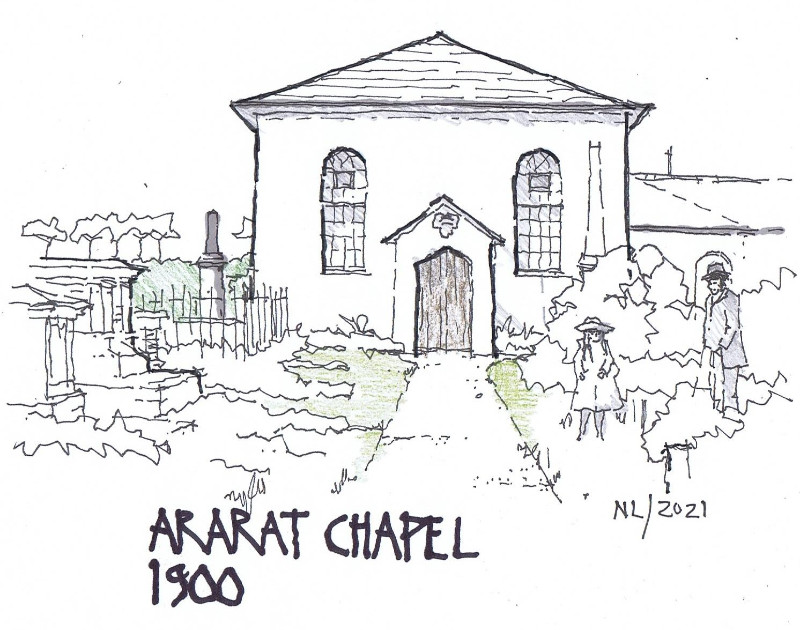 By: Chris and Nigel Lewis on 15/10/2021 101 THINGS YOU (PROBABLY) DIDN’T KNOW ABOUT WHITCHURCH
Time for another catchup, and hopefully a few answers:
WHERE WAS SCRAP ROW? Apologies to Terry and others, the ariel view of the Melingriffith Works was accidently left out of the blog. It’s been included this time (see below). There’s a second photograph too showing the canal basin just below the works. If you look carefully at the right-hand side, you can see the end of the block that might just be Scrap Row
Steph was asking about the Tithe Map. You can access this free from the National Library for Wales website (www.library.wales). Just type in ‘Whitchurch Glamorgan’ in the library search box and you should be taken directly to it. Good luck
POLO IN WHITCHURCH Jim sent us a copy of a newspaper article from the Evening Express (see below) describing the club members
THE LOST PLACES John wondered whether the place of executions in 1605, might just be at the Crossroads (where the library now is). Any thoughts?
CHURCH ROAD Denise tells us about her great grandmother who lived in Church Road in 1912 working for Doctor Dover. He is another interesting character from our local past. We’re told that Dr Dover became the works doctor for the Melingriffith works, and on the strength of that, he had a new house built for himself on Penlline Road. Until recently, this was the HQ for the Conservative Party in Wales (now recently refurbished and reverted back to a smart house) And we were also reminded about Lamorna School. Does anyone else have any memories of this school?
Venessa asked about the ancient footpath that was shown on the map running parallel with Church Road. It’s now Bishop’s Road
BRYN GLAS Nicola was asking about the age of the cottages further along from Bryn Glas, and in particular the Old Coach House (the cottage with the arched doors). We need to explore this area further in another blog
THE VILLAGE PUMP Thomas sent us 2 links to the Evening Express newspaper dated 4th and 6th November 1880 with letters from Whitchurch residents, the first complaining about how the pump was located within 50yds of the ‘crowded churchyard’, and the second letter hoping that the council would not install water pipes around the village as the stream water had benefits with ‘a dozen or more local inhabitant now reaching a century old’ Mary thought that the old pump was still extant and was near to the entrance to the community centre. Anyone remember this?
Roger asked whether the second pump was located on Brook Road
DALE OF THE BLACKBIRD This blog raised lots of interest with lovely photographs of a wedding party outside a long, thatched cottage. If you count the chimney stacks, it wasn’t the old pub
However, this is so intriguing that further research is needed. Apparently, there was a third long cottage (perhaps of even older age) in the vicinity, so more digging is needed
FINALLY Once Again, thank you for all your contributions and ‘likes’. We really appreciate it and do come to our Reminiscence group on 9th November if you can.    By: Chris and Nigel Lewis on 08/10/2021 101 THINGS YOU (PROBABLY) DIDN’T KNOW ABOUT WHITCHURCH 20 Whitchurch Fire Brigade
It’s hard to believe that Whitchurch had its own fire brigade. There’s no detail of when it was established but we know that on special occasions the fire brigade was turned out as a guard of honour. When the new free library was opened in 1904, the firemen resplendent in their brass helmets were prominent in the parade
There is an old photograph showing the village firemen in their uniforms, but sadly, this has been lost. If anyone has a copy we’d love to see it again
For anyone who has difficulty in picturing our local brigade, just think back to the BBC children’s programme Trumpton and their splendid crew of Pugh, Pugh, Barney McGrew, Cuthbert, Dibble and Grub. Unlike the Trumpton fire brigade, the Whitchurch fire brigade were all local volunteers, and the pump was fitted onto the back of a wagon. They didn’t have their own horse, so the local butcher’s horse was pressed into service. Before the fire brigade could be dispatched, the horse had to be sent for!
There are many newspaper reports of domestic and farm fires, and clearly the brigade provided sterling service in the village. Haystacks and ricks regularly caught fire
The installation of water mains only started in 1895 and were not completed until after 1903, so whenever the brigade was called out, they either had to carry their own water on the fire wagon, or to pump it from local streams or ponds. When the tithe barn caught alight in February 1900, the fire brigade had to stretch out their hoses quite a distance. In fact, such was the fire on the thatched-roof building that neither the building nor the considerable quantity of hay inside could be saved. The newspaper article in the Evening Express of 7th February 1900 describes in graphic detail the ‘Fire at Whitchurch Tithe Barn’
When a cataclysmic fire broke out on the Elm Farm (adjacent to the current Tesco petrol station on Manor Way) in October 1901, five horses were burnt alive and a considerable amount of harness and stored hay were consumed
From the beginning, the fire brigade undertook training, and in 1897 the volunteers were reported to be ‘making good progress’ with their drill. So much so, that a parish meeting was called for the purpose of agreeing to the purchase of fireman’s clothing, outfit and equipment. Goodness knows what they were wearing previously! Police Sgt Williams was in charge of the training and was paid £3. He was later voted a salary of £7 (later increased to £9) per annum as captain/instructor. The new equipment consisted of a pump, standpipe and hose
In an article in the Evening Express of 28th September 1903 we learn that: On Saturday afternoon the annual inspection of the Whitchurch Fire Brigade took place in the ground attached to the Glanynant School. The firemen turned out in their full equipment, and were under the command of their captain (Mr MW Davies), Lieuts Hale & Parsons also being present Several drills were gone through in a satisfactory manner, and the councillors present expressed themselves pleased with the appearance of the men, their smartness in going through the different evolutions and the condition and cleanliness of the appliances
All was not well however, as in 1909, the brigade went on strike after seeking a permanent headquarters. It was only after this that a fire brigade garage was built in Bishops Road (with parish council offices over). The brigade was even provided with better equipment
They had to wait until 1914 before the council purchased a shiny red Merryweather Fire Engine, just like the one in the photograph
By 1921, the parish council queried whether the fire brigade members were getting too old, and they all resigned! The council decided to organise a fully paid brigade with the captain (Mr Griffiths the butcher) paid a yearly salary of £15, and the other firemen paid £3-15s per annum. It all cost £71-10s each year
It didn’t last however, and not long after, the parish council requested Cardiff Fire Brigade to service the district
I wonder what happened to the 1914 Merryweather fire engine? It would be worth a fortune today
Does anyone have any more information about our local fire brigade, we’d love to hear?
Don't forget you can read all these pieces at the Hub and our next reminiscence group takes place on 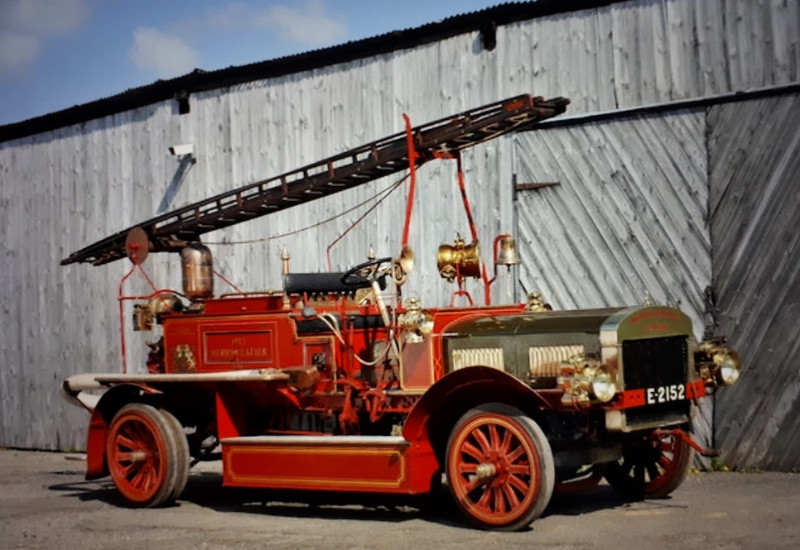 By: Chris and Nigel Lewis on 01/10/2021 19 Where was Scrap Row
By the 1840’s, the Melingriffith Tin Works was booming. The British Empire was expanding around the globe and there seemed to be an insatiable demand for tin, iron and coal, and south Wales had this in abundance
Here in Whitchurch, communications were vastly improved with the turnpike road, the new canal and the start of the railway age. Melingriffith was growing fast with new mills being provided to meet the great demand for tinplate
By 1842, Melingriffith was employing over 140 men, women and children and there was hardly anywhere to house them. And the demand for more workers was growing. Terraces of mean cottages had been built by the 1780’s when the Quaker families were running the works, and the cottages were filled to capacity, with 2 or even 3 families in each house
In the census of 1841, mill families were listed as living in Sunnybanks, New Houses, Penylan and Scrap Row. In addition, others were living just further away in Tongwynlais, Llandaff Yard and also in Whitchurch
The old OS maps show where many of these houses and cottages were, although almost all have now been demolished
Sunnybanks was probably built first by the Quakers in 1780’s with New Houses shortly thereafter. Some of the cottages around Velindre House might have been even earlier and been associated with the estate
However, where was Scrap Row? (and what a terrible name). The 1841 census lists over 20 families living there. Assuming that multiple families were living in each house, Scrap Row must have been at least 6-8 houses long. But where?
The first OS map of 1880 shows Sunnybanks and New Houses north of the works, with Penylan just to the east
The only candidate for Scrap Row lies to the south, lying between Oak Cottage and Ty Mawr (both still extant). The map shows what might be a terrace of houses tight against the batter at the rear, and the road in front These houses seem to have rear gardens at the top of the batter (presumably accessed via lots of steps), and there appears to be front gardens too, across the road adjacent to the canal
There’s nothing there now, not even a hint that nearly 90 men, women and children once lived there
Strangely, the Tithe Map of 1841 shows nothing of this terrace
The OS map of 1880 is hard to read. The area is printed on 2 sheets and the tinplate works was hugely different. After the world-wide financial collapse of the 1870’s, the Booker family had pretty much disappeared
However, by piecing together the various early OS maps and the Tithe Map, it is possible to get an idea of the various building around and to the south of the Melingriffith works in an earlier time. The sketch below shows how Melingriffith might have been in 1841
Hemmed in between the River Taff and the Glamorganshire Canal, the tinplate works occupies most of the level ground, with the works feeder running literally through the works
To the south, the canal takes a sweep to the southeast towards Ty Mawr, and this is where the possible Scrap Row might have been
It’s only when you look very carefully at the ariel photograph below of Melingriffith, taken about 1910 that you can get a possible clue. One’s eye is naturally drawn to the extensive Melingriffith works, Velindre House has been demolished and replaced by a smaller house and one can see the outline of the new mental hospital at the top edge
However, in the bottom righthand corner of the photograph, there seems to be a terrace of houses (perhaps 6 if you count the chimney stacks) with a lean-to outbuilding to the southern end. In the large field behind, there might be the remains of the gardens
What do you think? Could this be Scrap Row, and if not where? And what became of all of the mill workers and their families who used to live there?
Does anyone know? 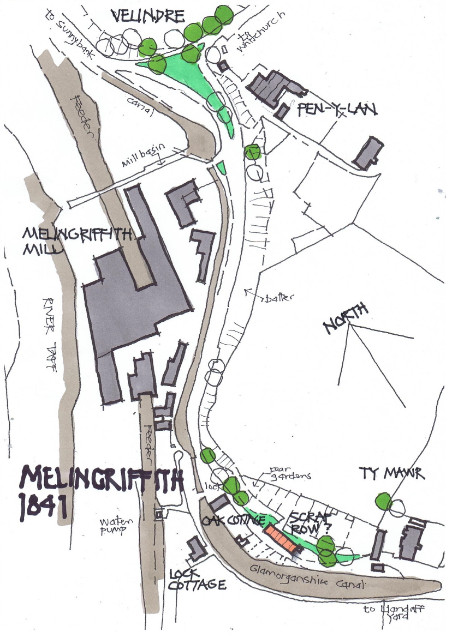 By: on 24/09/2021 101 THINGS YOU (PROBABLY) DIDN’T KNOW ABOUT WHITCHURCH # 18 Harvest
200 years ago, Whitchurch was very rural any just about everyone celebrated the changing seasons
Pretty much the whole community were farming families or agricultural workers and would come together at seedtime and harvest and be involved in the fields
Harvest was a particularly special time during the farming year. The extended farming families would come together with their workmen to gather in the harvest crop of wheat, barley and oats. The best land was always used for wheat growing with the poorer ground for barley and oats. Early starts and long days whilst the weather permitted. Always trying to harvest during the dry spells (not always possible in Wales!)
Before the industrial age, harvest was very labour intensive. Teams of experienced men would scythe the corn, leaving just the stubble. Others would follow behind gathering the corn stooks into sheaves and tying them into bundles standing vertically in the cleared field. These then were bundled onto horse-drawn wagons (or wains), then collected together into stacks in the open field or (in later years) to purpose-built ricks. Mums, dads and children all had their special roles
Harvest songs and traditional hymns set the rhythm for work and could be heard from one end of the village to the other
So, whilst we know what a traditional harvest would be, not many would know when. The Harvest Festival usually fell on the Sunday nearest to the Harvest Moon (the full moon that occurs closest to the Autumn Equinox), usually late September
The best wheat and barley stooks were also used for thatching. Remember, most houses and cottages at that time would have thatched roofs and would require constant patching and completely re-thatched every 30 years or so. There were still a few thatchers living in the village at the time of the early census’
So, harvest was always one of the high points of the year and to be celebrated. Ancient rituals can only be guessed at, and pagan celebrations would have been quite special with much eating, carousing and dancing (you only have to look at the modern druidic celebrations today to get an idea. Harvest home and corn dollies are the nearest we get today
Puritan attitudes to harvest were quite different and many of the traditional celebrations were frowned upon. Whitchurch was almost totally Welsh-speaking and the Mabon celebrations formed the central focus
With the coming of the new chapels and the English-speaking workers at Melingriffith and Pentyrch, the 19th century and Victorian harvest festivals changed again. This time within the churches themselves. Choirs and pipe organs and celebratory teas
Our modern church harvest festivals are now quite different again. Lots of us can remember church or chapel harvest services with decorated church buildings and vast displays of locally grown vegetables, all topped off by at least one specially-baked harvest loaf in the shape of a wheatsheaf (just like the one in the picture), in a prime location at the front of the church
Nowadays, the collected food is often tinned, and is donated to the local foodbank
Does anyone have any memories of harvest that they recall or were told about? 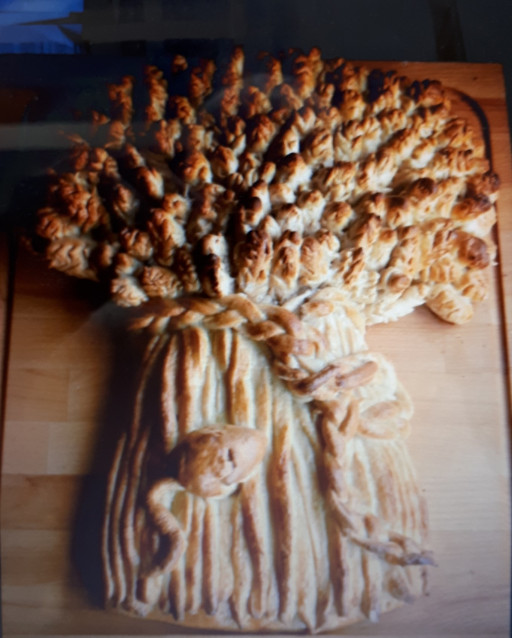 By: Chris and Nigel Lewis on 17/09/2021 101 THINGS YOU (PROBABLY) DIDN’T KNOW ABOUT WHITCHURCH # 17 Elizabeth Young
Sometimes you come across someone so unusual that you can hardly believe it’s true. For example, the American Clarence Birdseye, the man who invented the frozen Fish Finger (yes, it’s true!)
Here in Whitchurch, we have someone even more enigmatic, a lady called Elizabeth Young. So, who was she?
We know that she was a landowner in the early 19th century, because she’s listed on the Tithe Map in 1841. But there’s no record of her on any of the local census returns; so, who was she and where did she live? Does anyone know?
This lady owned nearly 70 acres of land in Whitchurch, which doesn’t sound a lot, but it is the land itself which makes her surprising
She owned and tenanted out a small cottage and garden in Birchgrove (then in Whitchurch Parish) to Edmund Harman, which in itself is not unusual. However, she is listed as owning St Mary’s Church and Churchyard (the old one in Old Church Road). How can that be? St Mary’s Church was still being used then, and would be for the next 60 years!
Even more surprising, she owned the land on which Ararat Chapel would be built just a few years later. And she also owned land at Penllan in Melingriffith, where the early Methodists in Whitchurch would gather to worship
If that wasn’t enough, it gets even stranger. She owned over 7 acres of ‘common’ land at Wauntreoda (what we now recognise as Whitchurch Common). Can a person ‘own’ common land?
To complete the mystery, she also owned 36 acres of parish road and 24 acres of the bed of the River Taff. These figures don’t sound much, but if you assume that a typical road in the 19th century would be about 5m (16 feet) wide, she owned 18 miles of public road! Even if you allow for the grass verges it would probably amount to over 12 miles. That must be just about every bit of road in the parish
And 24 acres of the River Taff, which, (if you measure it, is approximately 40m, 120 feet wide) equates to 1.5 miles of river. That is all of the River Taff from the bridge at Llandaff upstream to Forest Farm. If she had riparian rights (that is, only to the centre of the river) her ownership ran from Llandaff Bridge upstream, nearly all the way to Tongwynlais and Pentyrch
Attached is an extract from the Tithe Map apportionment (thanks again to the National Library) where you can see her landholdings. So, who was she, Elizabeth Young, where did she live and why did she own such unusual parcels of land? Does anyone know any more about her? Or is there a simpler answer? Elizabeth Young comes last in the alphabetical list of landowners in the parish, with her cottage in Birchgrove Below that, are listed the church, chapels, common land, River Taff and public roads At first glance you might think that she owned all of this, but perhaps all of these others have no ‘owners’ and are simply part of the public realm. What do you think? 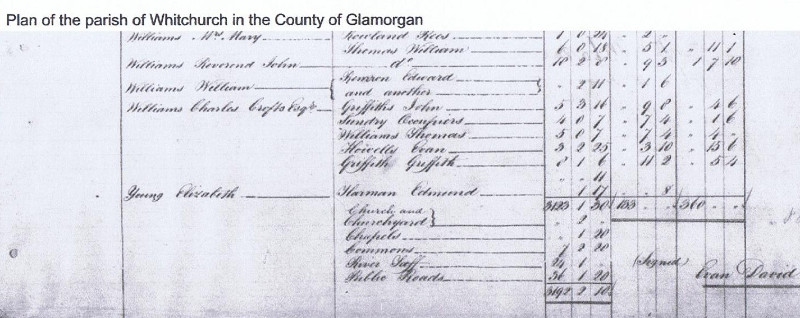 By: Chris and Nigel Lewis on 09/09/2021 The Papers An occasional dip into the newspaper archives with history of our village – with grateful thanks to the National Library of Wales
Evening Express 18th October 1894 A memorial has been signed by about 50 Whitchurch inhabitants asking for 3 additional drivers to be licensed between the corner of North Road and the Plough Inn
Evening Express 2nd April 1902 WHITCHURCH & LLANISHEN OMNIBUSES At a meeting of the Llandaff and Dinas Powis RDC, a communication was read out from the Cardiff Tramways Company intimating their intention to apply at the forthcoming licensing meeting for licences for eight omnibuses for Whitchurch. The services would run every 15 minutes between Whitchurch and North Road Cardiff, and an intermediate service between Whitchurch and Llandaff Yard The licensing committee of the council meets on May 13th
Obviously, the application to Cardiff Corporation was successful. The well-known photograph of the 2-horse omnibus outside the Plough (which is dated c1902) probably celebrates the start of the service However, the letter from a ‘Whitchurch Mother’ below bemoans the new service and presciently foretells the traffic we have today (apart from the flying cars!)
Evening Express 27th July 1900 A MOTHER BLESSES THE CORPORATION: ‘Sir, Whitchurch is getting on, or rather not getting on! Motor Cars! What next! We mothers have sufficient to do now to prevent our children from being run over by bicycles. When the ‘flying’ machines make their appearance what shall we do? We shall be constantly on the alert, I suppose, to stop the demon crushing our little ones. The cabs committee are humane. They don’t want half of Whitchurch to be killed. I admire them for their humanity, but it would be well for the head-constable to keep an eye on the poor break-horses. For what purpose will the next company be formed? There is no doubt that in the future we shall be able to travel between our village and Cardiff at 40mph. Will that not be delightful? But to imagine a motor car flying through the village makes me very nervous I am etc A Mother
AND FINALLY… If you’ve been enjoying our ‘101 Things’, why not join us As part of the Whitchurch Festival, we are planning a gentle history walk through Whitchurch Village on Saturday 18th September The walk will start at 2.30pm and last about an hour (weather permitting)
Starting outside the Three Elms Pub we’ll meander up the Merthyr Road past the shops and finish at the Library. At the same time, we’ll discover some of the stories, the lost places and meet some of the local characters
There are places to stop and sit on the way (and shops and pubs to visit if you prefer) Join us for the whole hour, or just dip in or out as you feel
And finally our next reminiscence group will meet at the Hub at 2.15pm on Tuesday 21st September.
We look forward to seeing you! 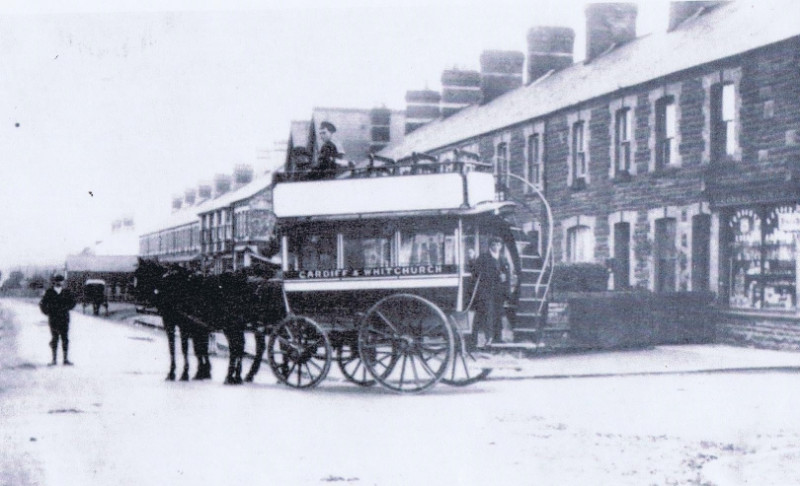 By: Chris and Nigel Lewis on 01/09/2021 16 The Naming of Streets Some people say that the roundabout at the top of the village is over one mile in circumference, and that it’s the biggest roundabout in Europe
A hundred and twenty years ago, at the beginning of the 20th century we had one road running from the southern boundary of the parish, continuing to the north of Tongwynlais (and probably beyond) with a single name; the Merthyr Road. This could well have been the longest in the area and was causing all sorts of problems to the posties delivering letters and parcels to residents of the rapidly growing village at that time
Many of the new blocks of houses being built had been given their own names (Millwards Terrace for example), but that just seemed to confuse even more. The streets of the parish were just confusing, and Merthyr Road was just too long and needed to be broken up into more manageable slices
The parish council had been pondering on the problem for quite a while and it was discussed at length. A special parish meeting was held in August 1905 for the purposes of naming the streets, with the object of fitting platenames and numbering the houses in the parish. They concluded that with a few exceptions, the names by which the roads and streets were currently known would be retained
In Tongwynlais, however, it was decided to change ‘Spout Road to Ironbridge Road, Canal Parade to Railway Terrace and the road leading to the Old Ton Inn to Church Road’. In addition, ‘the road leading from the Hollybush would in future be known as Pantmawr Road’
It was also decided to divide the Merthyr Road ‘from the Cross Inn to the Library into sections. From the boundary of the parish near the Cross Inn to Old Povey’s House on the Philog, The Philog; from the latter to the bridge near the blacksmiths shop Wauntreoda; the next stretch to the Plough Hotel Hafod Road; and from thence to the Library Penllyne Road’ ‘In addition, ‘Park Road was selected; and Heol Don for the road leading to Llandaff Station from Velindra Road’
There was a problem however! The parish council did not have the powers to change the names and they would have to get the approval of the Dinas Powis and Llandaff Rural District Council, who were the highway authority. With some minor tweaks the changes were agreed, and the newspaper advertisement dated 1st November 1905 shown below confirms the names. There is one difference, however, the main section which was to be called Hafod Road, remained as Merthyr Road; and so it is even today!
The photograph shows one of the 1905 cast iron platenames which are still around, even today. How many can you find? 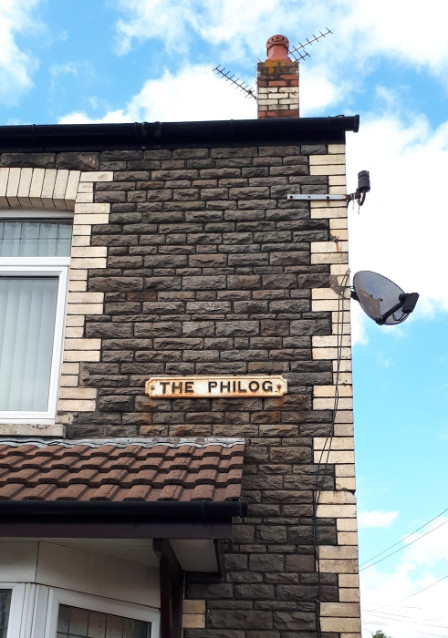 By: Chris and Nigel Lewis on 25/08/2021 101 THINGS YOU (PROBABLY) DIDN’T KNOW ABOUT WHITCHURCH Polo in Whitchurch
On some of the older maps of Whitchurch there is a field behind the funeral home by the Three Elms, called ‘The Polo Field’. It’s all built upon now and there is no indication of why it was once called such a strange name
Ernest Broad in his article ‘The Farms of Whitchurch’ remembers that ‘at the entrance to the Polo Field by the cowsheds was the Polo House in which a Mr Johns lived. The Polo Field was fourteen acres, a very large field. There was a pavilion on the field where the polo players had their tea’
In the 1911 Census, William John, age 31, was living in the Polo Ground Cottage, with his wife May and their 4 children. He is described as a groundsman, employed by the Polo Club
It seems strange that such a sport as polo would be played in Whitchurch, and that there is no local recognition of this. The Polo Encyclopaedia (yes there is such a book!) helps: ‘the Cardiff and County was a Welsh Club founded in 1903. The grounds are at Whitchurch, near Cardiff. Godfrey Charles Morgan, Lord Tredegar was the first president. The local tournament was the Cardiff & County Cup; the club stopped play in 1914. Colours: dark purple’
Lord Tredegar (of Tredegar House fame) had been a captain in the Lancers, one of ‘The 600’ who took part in the famous Charge of the Light Brigade at Balaclava, and there is a magnificent statue of him sitting on his horse, in front of the National Museum in town (see photo below). Obviously, a man with the right credentials for being president of the polo club
So, who were the members of the club? Probably the young aristocratic young men of the district who rode to hounds and enjoyed the privileged life of the affluent. But why did the club finish in 1914? One can only guess that these same men and their polo ponies went away to fight with great enthusiasm at the start of the Great War, only to perish in the conflict. Lord Tredegar himself died just before the war in 1913
And what became of the Cardiff & County Polo Cup?
Now the polo field is all built upon, with the flats at Ty Nant and the houses around Tynewydd and Maes Glas
Just in case you fancy the idea of playing polo, here are some of the rules: Polo is played on a field 300 yds long and 200 yds wide (about the size of 6 rugby pitches squashed together) Goalposts at each end are 8 yds wide (which are open at the top so a mounted player won’t be dislodged) Each match consists of 4 chukkas (or play), each of which lasting 7 minutes. The whole match can last two and a half hours – so lots of stoppages Teams swap ends after each chukka or when a goal is scored so neither team gains an advantage of waterlogged or turned-up ground Players are encouraged to physically challenge opponents’ ponies to gain the ball There are 3 referees, 2 on horseback and the third in the grandstand (or in the case of Whitchurch probably at the pavilion There are 4 mounted players on each team (and each player normally has 2 ponies as they get tired) At half time, spectators are encouraged to walk onto the field for ‘divot-stamping’ Equipment: Jodhpurs, mallet, helmet and of course a polo pony A white ball, now hard plastic is used, but traditionally was bamboo covered in leather
It’s interesting that in south east Asia, elephant polo is still played, whilst in China yak polo is popular
Does anyone know any more about the polo club or what became of its members in Whitchurch? Or of William John and his family? 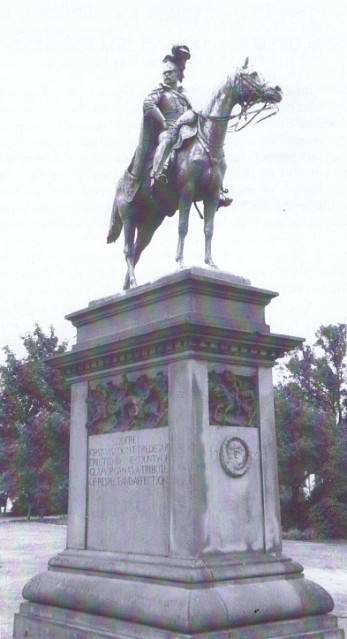 By: Chris and Nigel Lewis on 19/08/2021 14 The Vaughan’s of Velindre Many people will know of the Bookers of Velindre, but who were the Vaughan’s and what was their connection with Velindre? Before the Booker family and Richard Blakemore, and even before the west-country Quaker families of the later 18th century became involved, Velindre and Melingriffith were quite different. This was a time before the Glamorganshire canal, or the railways, and Melingriffith was linked to the rest of Whitchurch by a simple unmade road. There was a similar road south towards Llandaff Yard, where there was an old bridge over the River Taff. Just to the north, there was an ancient ford over the river linking to Pentyrch. In 1700, Velindre was described as ‘a mill hamlet’
There are headstones in old St Marys Churchyard for members of a family called Vaughan who lived in Whitchurch at that time. The oldest, Joseph Vaughan was born in 1697 and his headstone reads ‘in memory of Joseph Vaughan of Velindra’. A second headstone for another Joseph Vaughan (possibly his son) who was born in 1736 reads ‘in memory of Joseph Vaughan of Velindre in this parish, many years agent at Melin-Griffith works’ In all probability, the Vaughan’s gained possession of Velindre sometime in the early 1720’s and ran the old mill and forge. So, what was the house like in the early 18th century?
Velindre was probably ‘old’ by the time the Vaughan’s took over, and might well have been a medieval stone-built Welsh hall-house with a tiled roof and small stone-mullioned windows. There are existing examples of similar houses in Glamorgan even today, many where the properties have been much altered over many centuries with new floors inserted and many additions. Ty Mawr nearby is of similar heritage There’s no way of knowing, but based on the Tithe Map, the 1700 Velindre would probably have sat on the same house footprint as the later ‘gentrified’ house and been accessed off Velindre Road through a gate and long driveway. Stables would have been located beyond. A 1700 record describes Velindre as a ‘house and garden’, so not just a farm and yard. The sketch below shows what the house and garden might have been like in 1700 By 1788, the lease of ‘Vaughan’s Forge’ was renewed by Hartford Partridge & Co from William Vaughan (was this another member of Joseph Vaughan’s family?). So, by the 1770’s, the Vaughan’s have gone and replaced by the new Quaker ironmasters We’ll explore another time how Velindre was ‘gentrified’ and much extended over the following 50-100 years In the meantime, does anyone know any more about the Vaughan’s and early Velindre? 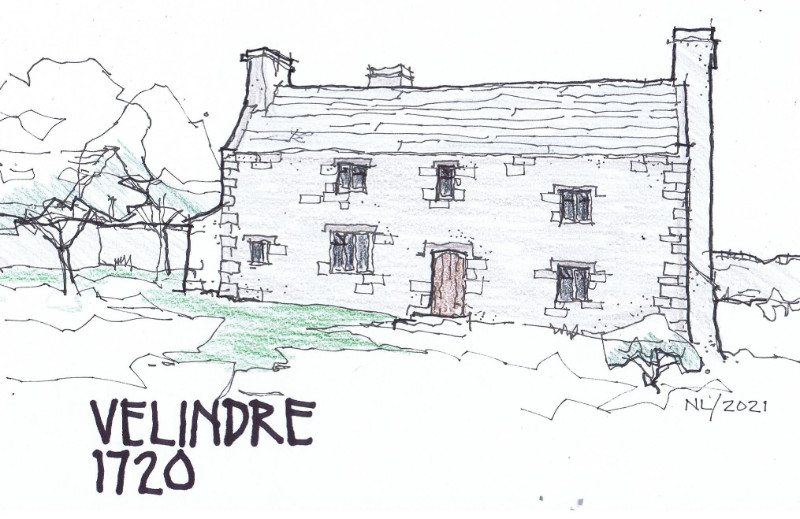 By: Chris and Nigel Lewis on 13/08/2021 13 The Lost Places There are many local placenames which have been forgotten or lost over the many centuries. The old records list a few, and one could almost make a guess of where they might have been
But where was Plwca-Halog and what about Heol-Rhiw’r-Cyrph? An innocent question for two rather sinister place names in the village
Plwca-Halog means ‘an ancient place of execution’, and Heol-Rhiw’r-Cyrph translates as ‘the lane at the slope of the corpses’
British History Online and Cardiff Records (volume 5) suggests that both of these places were in our village, and date from around 1605; a long time ago and in a very turbulent age. A time when catholic and protestant kings and queens fought for their religions, and 1605, a year when Guy Fawkes and his fellow conspirators failed in their attempt to blow up Parliament! It was in 1555, Rawlins White was burned at the stake in the centre of Cardiff for his protestant views, and it wasn’t many years later when puritan soldiers were fighting royalists in the fields around our village
But where were these ancient local places? Were there really executions in Whitchurch at Plwca-Halog? And who were they, the poor souls buried in the un-consecrated ground of Heol-Rhiw’r-Cyrph?
Often these places of execution were either quite prominent in a town (where locals might watch), or at a landmark at the entrance, to warn others of the consequences. So where? Near to old St Mary’s Church and the castle mound? Or perhaps on Waun-tre-Oda Common to the south?
Wherever they were, the whole macabre vision is horrible and best forgotten; perhaps remembered as part of our local history. Or do you know something about these places? 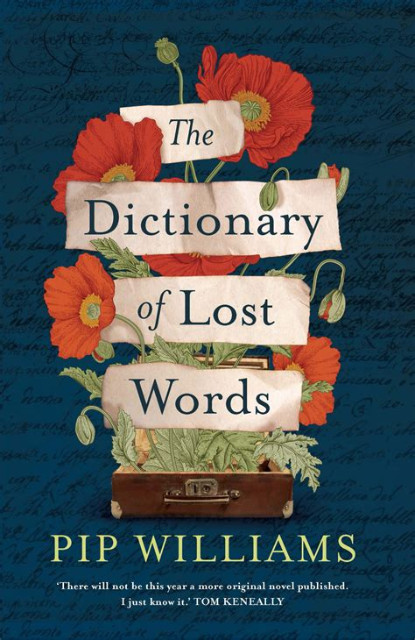 By: Chris and Nigel Lewis on 05/08/2021 101 THINGS YOU (PROBABLY) DIDN’T KNOW ABOUT WHITCHURCH 12 Church Road
What was the original name of the winding road, starting at the Plough Inn, passing the Fox & Hounds pub and the (old) St Mary’s Church? There’s no guidance on the 1841 Tithe Map, nor the OS map of 1880. From older newspaper articles, there is reference to residents living in Church Street and Church Road. Perhaps we’ll never know
By the latter part of the nineteenth century Whitchurch village was growing, and the open fields opposite the Plough Inn were changing. The vicarage had been built by 1875, and a new churchyard (to replace the very full old graveyard) had been opened on Penlline Road with a high stone wall and lychgate by the early 1880’s. The new St Mary’s Church was built by 1885
The OS map of 1901 then shows a completely new road constructed, running across the open fields from the Plough towards Heol Don. On this map, the road is called Church Road and the winding original as ‘Old’ Church Road. In the parish council records of the time there is a suggestion that the new road be called ‘New Road’
The sketch below suggests what Whitchurch village was beginning to look like with the construction of the new road. The shops and houses opposite the Plough were still being built, and the junction of the new Church Road at its western end with Heol Don had a traffic island, steering all the traffic eastwards
The Taff Vale Railway station in Llandaff Yard had already been built by the 1840’s, and the only route to Whitchurch was either across the ancient footpath by Village Farm, or via Heol Don and Velindre Road (both very rural tracks – no houses then!). So, the new road linked Whitchurch and Llandaff Yard in a much more direct way. In fact, on the OS map of 1901 the main road through Llandaff Yard is called ‘Whitchurch Road’
There were only 4 houses built on the new Church Road at the Heol Don end on the 1901 OS map, and one of them has a date plaque of 1885, so there was already a bit of a road early on. The ancient footpath from the village to Llandaff Yard and Radyr was still shown running parallel just a field way
By 1920, Church Road had fashionable Victorian and Edwardian villas along the complete length, ultimately making it the conservation area we have today. The well-known photograph below was probably taken about 1910 looking west, with a few more houses and the acetylene street lamps
The parish council clearly saw the new Church Road as being special and had plans to plant trees along its length. However, at their November 1904 meeting they agreed that the trees would be brought from Church Road to be planted in the new Library Park instead!
Does anyone know any history of the new Church Road or of any of the families who moved in?
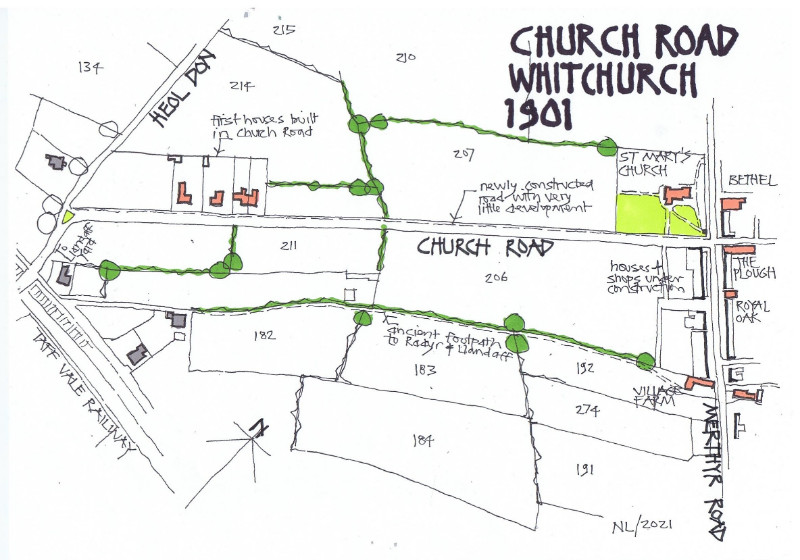  By: Chris and Nigel Lewis on 30/07/2021 101 THINGS YOU (PROBABLY) DIDN’T KNOW ABOUT WHITCHURCH
11 William Vachell and his Mystery House
William Vachell (who was born in 1796) was a leading member of a well-known family firm of druggists in Cardiff in the nineteenth century. His father was a ships surgeon during the French Revolutionary wars and his brother Charles (and fellow druggist) became Mayor and developed houses in Charles Street (named in honour of their father)
The family prospered with William and Charles running the firm. William married in 1813 to Mellicent Thomas and they had 5 children. Sadly, Mellicent and 4 of the children died, only Frederick Charles surviving. William married a second time and had a further son. Sadly, both his new wife and new son also died
Like many gentlemen of that time, William decided to retire from business and move to the country. We find him first in 1841, living on Waun-Treoda Farm (later of Flays Farm fame) and tenanting all of the farmland on both sides of the Merthyr Road. At that time there were no houses on Wauntreoda, just the farmhouse, its barn, Ararat Chapel, and open fields on both sides of the road
10 years later, we find William on the 1851 census, aged 62 still living in Whitchurch, with the occupation of ‘retired druggist’. He was living with his now 23-year-old son Frederick Charles, a housekeeper and 2 other servants in a house on the Filog in the East Division of the parish, seemingly opposite the farm. And there was a different tenant in the farm house!
So, where was he living if there were no other houses?
Around this time, on the north side of the Merthyr Road a large detached house was constructed called Bryn Glas. This is shown on the OS map of 1880 set back from the road with a sweeping driveway. The sketch below gives a flavour of how Bryn Glas might have appeared in 1851, with its tree-lined carriage drive and landscaped front gardens. There seems plenty of space around the house for the pleasure garden that would come next. Was Bryn Glas built by William Vachell as his home in the census? There don’t seem to be any other candidates
By 1880, the house was flanked on both sides by terraced houses, but 30 years earlier it was in splendid isolation. Bryn Glas is now demolished and the site is now occupied by the Retford Court flats. Are some of the big trees in the car park survivors of old Bryn Glas?
By the census in 1861, William Bedlington an engineer from Durham was living in the house with his family and no sign of William Vachell, and no sign of the extensive gardens. Maybe William Bedlington acquired the house; his family were still living there in 1891
So, what did become of William Vachell and his son Frederick Charles? It seems that William died in 1860, before he had chance to enjoy the house, and his son went on to bigger and greater things. More of him another time
Does anyone know any more about William Vachell, his family or about Bryn Glas?  By: on 23/07/2021 101 THINGS YOU (PROBABLY) DIDN’T KNOW ABOUT WHITCHURCH this week it is a CATCHUP, following your contributions on Fb. It’s a real treat to see how many people are enjoying our weekly dip into the stories and history of our village. We always knew that there was so much more to the story of Whitchurch than the words already written. With your help, let’s hope that our latest offers and your contributions to ‘101 Things’ continues As we’ve now completed the first 10 weekly items, we thought it would be good to catch up and share some of your thoughts and try to answer some of the queries:
THE OLDEST TREE There’s a group of volunteers who have offered their help to maintain and improve Old St Mary’s Garden. Even though the pandemic has caused great difficulties, the improvements are already noticeable. If you’d like to know more (or would like to volunteer) email saintmarysgardens@gmailcom THE CROSSROADS This has raised all sorts of queries. The sketch showing the Crossroads in 1851 was so rural, and none of the streets, houses and shops that we know had been built Martin suggests that there was a pond in Ty’n-y-Pwll Farm, and if you look closely at the OS map of 1881, you can just make out what looks like a pond Sian asks about the New Station housing estate (what is now St Margaret’s, St John’s and St Mary’s). Perhaps we can look at this as a further item of ‘101 Things’. If you have any information, please let us know
CHELSEA PENSIONERS We’ve been sent a wonderful photograph of a snuff box (see below) inscribed with the name of the Badger family and dated 1892 DALE OF THE BLACKBIRD We’re amazed at how much interest has been shown about this little cottage. Gemma tells us that the Johns were her family, and Liane has sent through a few photographs of the cottage in it’s prime. One (see below) dated 1909 shows the John family in front of the cottage celebrating a family wedding
THE FARMERS ARMS Tony has asked for more information about James Brookman and his beer house. The information we shared was collected and analysed from the Tithe Map of 1841 and the early census returns Sarah has contributed further; James and his family moved to Llandaff Yard to run the Railway Inn, and Gareth tells us that James is his ggg grandfather! HOUSEBUILDERS Sian, Duncan and another Sian have been writing about the local builders in Whitchurch. We’ve already written about Cornishman Sam Bennett who built houses in Manor Way and off Kelston Road, but clearly, we need to find out more about the Coffin houses, Charles Henry Hockridge and all of the other local builders
GENERAL Many people have commented on the Fox and Hounds so we’ve already made contact with the manager who tells us that he has lots of photographs and facts that we might like to discover. Again, this is a wonderful candidate for a future ‘101 Things’ Lots of people have reminded us about the Edgar Chappell books and we’re currently looking to visit the Glamorgan Archives to see the Chappell Archives (once the pandemic is finally over). Martin recommends the Rice Merrick book published 1578 (in old English) Apparently, the family of Oliver Cromwell lived in a farmhouse in Llanishen (on the site of the Wolf’s Castle pub), where he stayed Thank you for all your contributions and ‘likes’. We really appreciate it 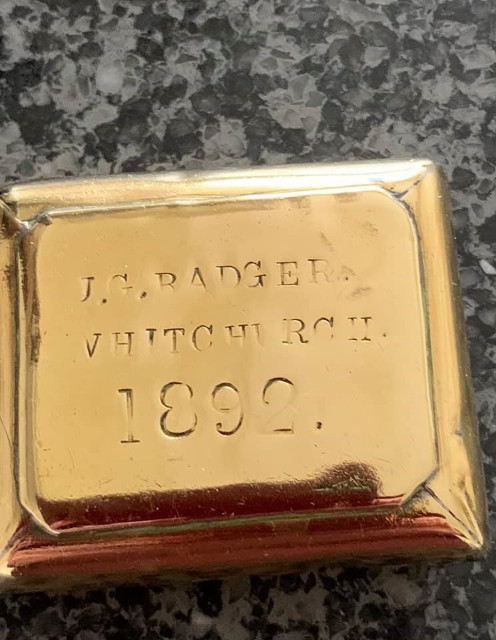  By: Chris and Nigel Lewis on 15/07/2021 10 The Village Pump There was no piped water supply to the village until 1893 at the earliest, and individual houses were only connected into the supply after that
Before then, everyone had to rely on either well water, or from the various streams around. Farmyards would have had a pond for the livestock and cottages might have had a tank in the yard (or perhaps collected rainwater from roofs)
The OS maps of the village for 1901 show various locations for the wells. Perhaps you know where they might have been; some may still be there but simply capped off
Many towns and villages had a village pump, often with a horsetrough alongside. In many cases, these were very elaborate in cast iron, sometimes with a canopy and drinking fountain, often inscribed with some form of memorial. We don’t know of anything like that in Whitchurch though
The first Medical Officer of Health for the Cardiff Union Sanitary Authority was Dr FW Granger. He was appointed in 1875 and wrote annual reports on general health conditions. They were not very encouraging and he was very aware of the potential of possible epidemics of typhoid and similar diseases. In the early years he had a number of unfit wells in Whitchurch closed, and tried desperately to have livestock removed from rear garden yards. In 1883 and he reported that he was ‘constantly waging war with the house owners, who often resort to all sorts of artifices to delude us to prevent their pigs from being removed’. The sanitary authority had powers to remove the pigs, but not the pigsties!
In 1882, he reported that Whitchurch was served by two public pumps and by private wells. Ernest Broad in his well-known article ‘Old Whitchurch from End to End’ says that in Old Church Road at the corner by the boy’s school stood the village pump. We wonder how old this was, and what form did it take? Was there a horsetrough with it? The sketch below shows what a pump and trough might have looked like. Many of these pumps were made in the nineteenth century by specialist cast iron manufacturers in Scotland, and we might have had one. Does anyone know?
And, where was the second public pump that Dr Granger mentioned? Ernest Broad also suggested in his article that the first cottage in Brook Road had a (communal) pump at the back of the house for water. Was this the row of thatched cottages where Jupps Sweets factory was?
Now that the factory has gone, and replaced by an office block, I can’t imagine that the pump still exists, but does anyone know? Perhaps this wasn’t the pump referred to by Dr Granger and that there was another perhaps located on Waun-tre-Oda. Does anyone have any ideas?  By: on 09/07/2021 9 Count de Lucovich
Most people know about the Booker family and their connection to Melingriffith, but how many, I wonder know about Count de Lucovich, Antonio Leonardo Trifone and his family who also lived in Whitchurch about the same time
Antonio had been born into a very distinguished family who lived on the Adriatic coast of what is today Montenegro, and inherited the title Count de Lucovich from his grandfather. Knighted by King Francis Joseph 1st of the Austro-Hungarian Empire, Antonio became a Knight of the Order of the Iron Crown, a knight of the Order of Franz Joseph the First and an Admiral of the Noble Corps of the Bacchese Marines
Antonio was born about 1832 but decided to leave his country in 1848 to pursue a commercial profession in the UK and moved to Cardiff. He established a coal and metal exporting business in partnership with his brother who remained in Dalmatia
Antonio, Count de Lucovich married Isabella Maude Dawkin in Cardiff in 1876 and they lived first in Llandaff and then later at Ty’n-y-Parc in Whitchurch where they had a family of 4 children. Ty’n-y-Parc, now demolished, was an ancient farm (just along from the Tesco petrol station and opposite Upper Ty’n-y-Parc Terrace) but in the nineteenth century was obviously a very elegant place indeed and considered to be a fine ‘Gentleman’s Residence’
Ernest Broad in his well-loved article ‘Whitchurch from End to End’ describes Ty’n-y-Parc as ‘there was a very large stone archway. From this archway ran a high wall as far as Pantmawr Road. The archway led to a very large farmhouse and stable. The tenant was a Russian (sic) noble, Count Lucovitch. I saw the count and his sister ride to hounds many times and they made a magnificent pair’. Perhaps the count was one of the gentlemen on their horses with the hunt outside the Fox and Hounds on the well-known local photograph!
The count clearly had done well, and moved in grand circles. In an article of the South Wales Daily News of 8th January 1893 it describes how he had a marble bust of himself carved by a well-known Genoese sculptor and how it was on display in a swanky shop in the centre of Cardiff
There are no photographs of Ty’n-y-Parc, but we do have a fantastic photograph of the count himself, sporting a wonderful beard
Antonio retired in 1909 and left his business to his son. Sadly, Antonio died only 2 years later and he is buried in Cathays Cemetery. He has a very imposing memorial there complete with a huge stone cross and a plinth embossed with his family coat of arms. His son Oscar inherited the title
Does anyone know any more of this flamboyant character, his family or about Ty’n-y-Parc?
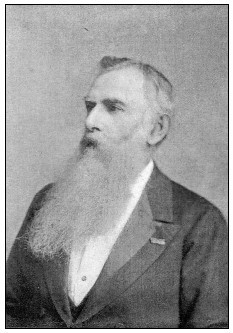 By: Chris and Nigel Lewis on 01/07/2021 101 THINGS YOU (PROBABLY) DIDN’T KNOW ABOUT WHITCHURCH – this week Whitchurch in the news….
Cardiff & Merthyr Guardian 16th September 1848 Novel Plough Our attention was called at Wauntreoda by some agriculturalists to an iron plough which Mr Reuben Lewis, blacksmith of Whitchurch had brought to the ground. We were told that it was constructed on a new and novel principle and gave particular and peculiar facilities for cutting and turning over the furrow
Cardiff & Merthyr Guardian 6th July 1850 Wauntreoda and Whitchurch Odd-Fellows Society The members of this lodge held their anniversary on Saturday last
Cardiff Times 17th December 1859 Rifle Corps On Monday evening a large and respectably attended meeting was held at the Fox and Hounds Inn Whitchurch to form a rifle corps for the district of Whitchurch, Pentyrch, Llandaff and St Fagans. The chair was taken by TW Booker Esq making appropriate remarks A very enthusiastic spirit was manifested and 89 names were enrolled before the meeting broke up Mr Booker, we believe will be the captain and the corps will commence drill immediately, if they have not already done so (Subsequently, the group became the 13th Rifle Volunteers)
Cardiff Times 28th March 1862 Daring Act of a Fox Mr George Lewis, Three Elms was aroused from his repose by Mr W James, his neighbour, a farmer about 1 or 2 o’clock on the morning to render assistance to one of the animals which was ill, and on his return, he found that the dog was exceedingly ferocious and anxious to get out. On being let out he instantly seized on what at first Mr Lewis thought was a dog, but was soon convinced was a fox The dog and fox fought 3 good rounds, but the latter soon bolted. Mr Lewis and Mr James with their dogs followed the fox track but without success. The fox was not willing to yield his prey and soon returned and ate nearly half of the goose he had previously killed. There were 11 eggs within a week of being hatched!
South Wales Daily News 28th January 1882 Death of an Old Inhabitant On Thursday night at his residence Penlan Whitchurch, Mr Thomas Thomas died after a protracted illness in his 76th year. He was the son of Mr Thomas William George whose father came from Bedwas to Pentyrch and established the Pentyrch Works with Mr Partridge in 1713
Reuben Lewis reappears in 1861 as Innkeeper of the Plough Inn. I wonder what happened to his novel plough? Does anyone know what happened to either the local Odd-Fellows Society or the Rifle Corps? And what about Mr George Lewis of the Three Elms (or his neighbour Mr James)? 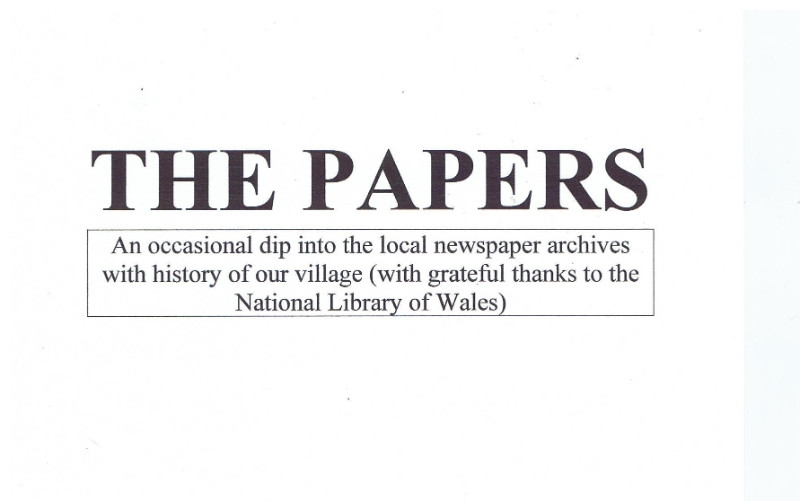 By: Chris and Nigel Lewis on 24/06/2021 Sam Bennett and Manor Way
Between the two world wars, Whitchurch was expanding rapidly with new houses being built from the northern edges of the village to the south There were quite a few builders active in the area, and prominent of those was Sam Bennett. He was born in Cornwall in 1875 and moved to south Wales at the turn of the century to find his fortune. We first find him living in Treforest in 1901, with his wife Frances, brother James, 4 children (and a servant)
We’ve not been able to find out much about him for the next two decades, but he was then living at number 11 Penlline Road (is this where Lloyds Bank is now?) and was building houses in Pantbach Road
About the same time, Sam started the Camborne Estate off Kelston Road (Sam was born in Camborne Cornwall), and built the houses on Kelston Place and Camborne Avenue, backing onto the high school In 1928/29 Sam started building at the southern end of the village. Along Philog Road (later renamed Birchgrove Road) Sam built a detached house, three houses in a block and then three pairs of semi-detached houses. Across what would later become Manor Way, he built a further detached house and three pairs of semi-detached houses down to the (then) city boundary, which was a stream crossing the road At that time, the Merthyr Road carried all the traffic from Cardiff up to Whitchurch. The grainy photograph below (thanks to Stewart Williams and his book Cardiff Yesterday no 34) shows the Bennetts building the town end of Manor Way. This rare photograph taken from the middle of the Merthyr Road shows the (now) Manor Way quite separate, with a field between. If you tried to take the same photograph today you wouldn’t last long with the traffic! Sam died in 1932, and left the business to his two sons Arthur and Donald. They obviously carried on and built many more houses. They built a detached house for their mother Frances (Sam’s widow) at the junction of Manor Way and the Merthyr Road, and called it Manor House. They also built a small hairdresser’s shop with a flat over for their sister (also called Frances). Is this the strange shaped building on the right as you leave the A470? Does anyone know more about the Bennetts, or do you live in a Bennett-built house? 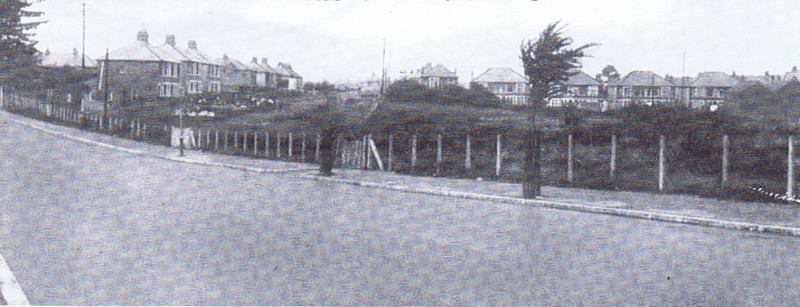 By: Chris and Nigel Lewis on 17/06/2021 A weekly digest on unusual and quirky items about our village supplied by the AWEN Reminiscence Group
7 Heol Gwrgan and Heol Iestyn
In the centre of the Coat-of-Arms for the City of Cardiff is a shield with a red dragon. The dragon is proudly holding a square standard of three silver chevrons on a red background
This square standard (shown below) with the chevrons is the insignia of Iestyn-ap-Gwrgant, the last Welsh King of Glamorgan
So, who is Iestyn-ap-Gwrgant and what is his connection to the Cardiff flag and particularly why have 2 streets in Whitchurch been named after him?
Iestyn-ap-Gwrgant was part of an ancient Welsh family who for many hundreds of years held lands throughout Glamorgan from their strongholds in Senghenydd, a castle at Morgraig (the ruins of which still lie next to the Travellers Rest) and a homestead called Treoda somewhere in Whitchurch. Some have suggested that this homestead was located a little to the north of Whitchurch Common. Like many of the Welsh chieftains, Iestyn-ap-Gwrgant continually squabbled with his family, and the other Welsh princes, but maintained order and a general peace
After the Norman invasion in 1066, Robert Fitzhamon, a Norman knight swept through Monmouthshire and Glamorgan and captured Cardiff. He raised a motte and bailey castle in the town and made this his base. After many skirmishes he encountered Iestyn-ap-Gwrgant and attempted to win the lands north of Cardiff too
In 1088, there was a decisive battle between Iestyn-ap-Gwrgant and Robert Fitzhamon’s Norman knights. The location of the battle is unsure, but was waged over lands around Rhiwbina and north Whitchurch. Some books refer to this battle as the ‘Battle of the Little Heath’. The brook which flows through Cae Delyn and Whitchurch was renamed ‘The Bloody Brook’ or ‘Nant Waedlyd’. Sadly, the battle did no go well for Iestyn as his army was defeated. The rest as they say is history!
What became of Iestyn? One legend claims he became a monk at Keynsham Abbey near Bristol, while another maintains that he was slain and buried locally under a mound known as the ‘Twmpath’. Is this the mound below Cefn Onn, or the ancient mound near to the Fox and Hounds in Whitchurch?
So, two little roads in Whitchurch, just off the common are the only memorials to our last local king, the Welsh King of Glamorgan
Does anybody have any other information or stories about this last King of Glamorgan? Simply email awen.cymru@gmail.com
Thanks go to Dennis Morgan and his book ‘Discovering Cardiff’s Past’ for the information on the Cardiff coat-of-arms 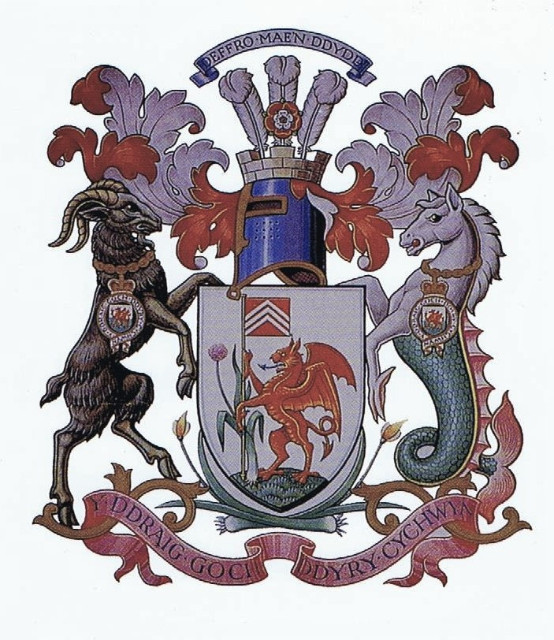 By: Chris and Nigel Lewis on 10/06/2021 101 THINGS YOU (PROBABLY) DIDN’T KNOW ABOUT WHITCHURCH A weekly digest on unusual and quirky items about our village supplied by the AWEN Reminiscence Group #6 Whitchurch Pigs At the beginning of the 19th Century, there were no more than 400 people living in Whitchurch and probably less than 80 houses and cottages. Most of the cottages were very simple, with only a few rooms and an outside yard Most families kept a pig and a few chickens and grew their own vegetables Without mains drainage or piped water supply, conditions were primitive. In the outside yard was a privy (most likely an earth closet) with a basic pigsty adjacent. Perhaps, the sketch below gives a flavour of what most families had (there are rebuilt examples of similar outbuildings at St Fagans), but I don’t think there are any left in Whitchurch now
The residents were obviously very proud of their pigs, as an article in the Cambrian newspaper dated 20th February 1846 advises: ‘Fat Pigs, two pigs about 20 months old were slaughtered and weighed 24 score and 5 pounds (about 220 kg) and the other 34 score and 6 pounds (over 310 kg). they were pure Glamorgan breed, reared from old stock in the Parish of Whitchurch, a place celebrated for the superiority of its breed of pigs’
In his book ‘Old Whitchurch’ Edgar Chappell suggests that the local community came to be known by the popular nickname ‘Whitchurch Pigs’ Folk living near the tinplate works were apparently called ‘Melingriffith Quackers’ and anyone living in Pentyrch would be a ‘Pentyrch Cuckoo’!
Does anybody have any other information or stories about the livestock, people kept in Whitchurch? Simply email awen.cymru@gmail.com  By: Chris and Nigel Lewis on 04/06/2021 101 THINGS YOU (PROBABLY) DIDN’T KNOW ABOUT WHITCHURCH
A weekly digest on unusual and quirky items about our village supplied by the AWEN Reminiscence Group
5 The Farmers Arms
We probably all recognise this view of the village, with the Fox and Hounds pub. Did you know however, that, in days gone by, there was another old inn just to the left of the big tree?
On the Parish Tithe Map of 1841, James Brookman was listed as the publican of the Farmers Arms, near (the old) St Mary’s Church. From the tithe map, it shows a line of small cottages set on the bend of the road. In all probability it would have looked like the old Blackbird Inn on the Philog that we mentioned last time
So why were there at least two old cottages in the village selling beer, when there were established pubs nearby?
Less than 10 years earlier, when the only water came from wells and streams and was often contaminated, many people drank alcoholic beverages (in particular gin) instead, and the government of the day were worried
Beer houses were the idea of William IV and when he came to the throne, he established the Beer Act of 1830. This allowed any ratepayer to brew and sell beer (and only beer) in payment of an annual licence of 2 guineas. The Beer Act became very popular and over 25,000 licences were issued in the first 6 months! The price of a pot of beer was reduced by at least 20% and it encouraged people to drink beer instead of spirits. Fascinatingly, the Beer Act was only repealed in 1993
The Farmers Arms didn’t last very long, as in 1861 it had changed to The British Hotel with Thomas Evans as House Steward. By 1880, all of the old buildings had been demolished and a new house built called The Cottage. Now it’s called The Pines
Does anyone know of any other old beer houses (rather than pubs) in Whitchurch? Simply email awen.cymru@gmail.com
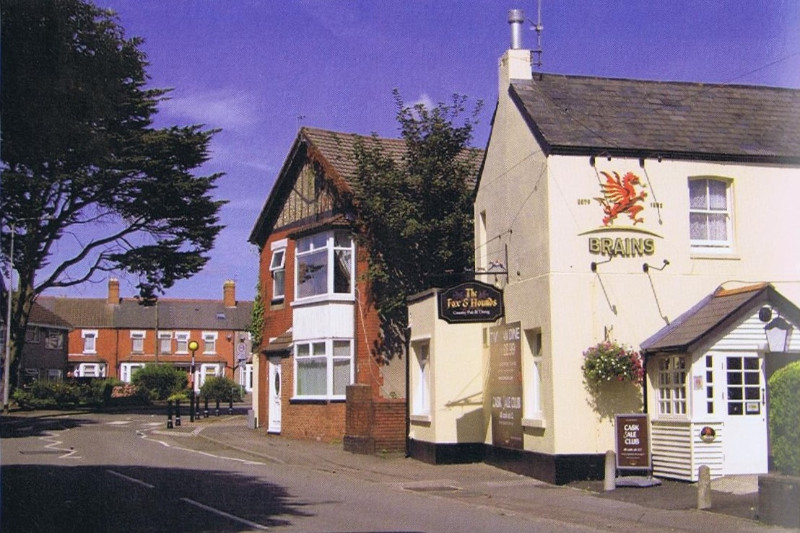 By: Chris and Nigel Lewis on 27/05/2021 101 THINGS YOU (PROBABLY) DIDN’T KNOW ABOUT WHITCHURCH A weekly digest on unusual and quirky items about our village supplied by the AWEN Reminiscence Group Dale of the BlackbirdThere was an old thatched cottage at the southern end of the village called Cwm-y-Fwyalchen, (which means dale of the blackbird) According to British History Online, it was ‘an ancient thatched house at the hamlet of Ffilog on the west side of the Llanishen Road’
Was this the same house called Mwylach-Bwlch shown on the 1880 Ordnance Survey map near the Birchgrove School on Pantbach Road? In the 1851 Census, a cottage called the Blackbird Inn (next door to Birchgrove), had Thomas Howell as head of the family with his wife Blanch and an adult daughter. They also had 3 lodgers This image, courtesy of Cardiff Library, shows Cwm-y-Mwyalchen Cottages at the Filog. It must be the same one The current Post Office on the corner of Pantbach Road sits in the middle of the cabbage patch in the photograph! Does anyone know any more about this old part of the village? 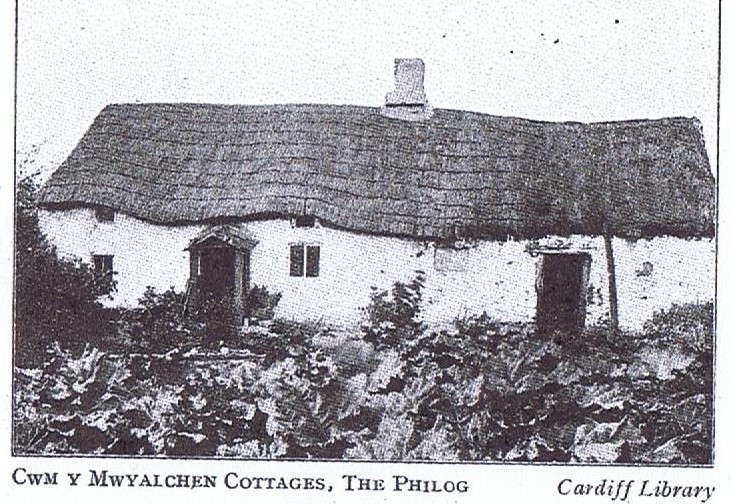 By: on 21/05/2021 Did you know that we had Chelsea Pensioners living in Whitchurch?
In the Census of 1861, there were 2 separate families of Chelsea Pensioners (the smiley men in bright red coats) living in Whitchurch
At the crossroads in one of the thatched cottages we mentioned last time, William Richards, aged 75 was living with his wife Anne and daughter Margaret. He was old enough to have fought against Napoleon in the Peninsular Wars or even at the Battle of Waterloo (we’ll never know)
In the image below, is the cottage in which he lived
In the Lower Village (probably Gwaun-Tre-Oda), lived another Chelsea Pensioner. We don’t know exactly where he was living, but his name was William Badger, aged 52 (from Worcestershire) with his wife and seven children. This William was too young to have fought alongside William Richards (of the Crossroads), but it is fascinating to learn about his children. His first 3, John, George and James were all born in Gibraltar. The next, William was born in the West Indies and the next, Joseph in North America. The youngest 2, Elizabeth and Caroline were born in Gloucestershire and Durham. It would seem that William Badger took his wife and family with him wherever he was stationed around the empire
By 1871, William Badger had left the area, but his oldest son John was married with a 2-year-old son and living in Sunnybanks. By 1881, John had left the area too to and was living near to his parents in Roath
Does anyone know any more about either family? 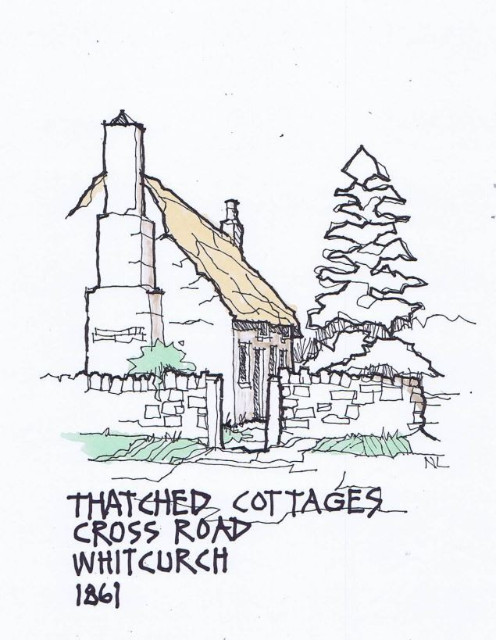 By: Chris and Nigel Lewis on 14/05/2021 101 THINGS YOU (PROBABLY) DIDN’T KNOW ABOUT WHITCHURCH
2 Where are ‘The Crossroads’ in Whitchurch?
In 1841, The Crossroads were a very important spot, located at the junction of the Merthyr Road and Ty’n y Pwll Road where the Library now stands. Back then, there was just one building on the crossroads, a pair of very small and very old thatched cottages surrounded by fields
The sketch below shows an ariel view of how the crossroads might have looked in 1841, at the time of the Parish Tithe Map
The roads would have been dusty stone-finished (probably with lots of ruts and potholes), no pavements or kerbs, and the grass verges and hedges would have been roughly trimmed, with occasional gated openings into the fields behind. Ancient trees would have been growing in the hedgerows
The crossroads formed the junction of at least 3 farms, Pentwyn, Ty-Clyd and Glannant and the individual fields mostly had names. Where the Library now stands was a Ty-Clyd field called ‘The Ten Acres Cross Road Field’!
The site of the 2 thatched cottages is now the Velindre Cancer Charity shop (Jennifer’s Gown shop as was), and field number 69 has the Library and the Library Park behind. There is no roundabout, shops, houses or the Methodist Chapel
What else is missing?  By: Chris and Nigel Lewis on 07/05/2021 A weekly digest of quirky Whitchurch facts....The oldest tree in Whitchurch is probably the yew in St Mary’s Gardens in Old Church Road According to Cardiff Parks, the tree started growing in about 1641 (one year before the start of the English Civil War!). If you would like to contribute or comment please email AWEN on A new weekly digest on unusual and quirky items about our village supplied by the AWEN Reminiscence Group
If you would like to comment or supply something for this digest simply email awen.cymru@gmail.com  By: Chris Soughton on 15/04/2021 The Reminiscence group of AWEN are researching various topics to include in our Timeline. We thought you would like to read the Report on how schools started in Whitchurch written by Chris Soughton. If you have any school memories or any thoughts on the Timeline we will soon have an AWEN box at the Library to receive your thoughts and memories. As part of the Timeline we are particularly keen to receive information on the Public Houses. Many of them appear on maps as early as 1841 before many of the houses were built. Please help if you can.
Education in Whitchurch Basic education seems to have been considered as part of the churches’ functions, and in particular the Circulating school movement was set up by an Anglican clergyman in the 1700s to teach children to read the bible in their own language. These schools were established by schoolmasters who stayed in an area for a few months and then moved on to another place, leaving their best scholars to carry on teaching others. There was a Circulating school in 1752 attached to St Mary’s church, and another in 1753 on the Philog. From these grew out the Sunday school Movement, which became a much wider influence. In Whitchurch the ironmasters of Melingriffith who were Quakers seem to have provided some schooling for the children of workers. There are no clear records, but in the works accounts there are references to repairs to a school building in 1786, and to a schoolmaster. The Sunday school movement was later the main provider of basic reading skills, and it is noteworthy that there was one attached to Ararat Baptist church, near the Philog, and another attached to St Mary’s church, then situated near the Fox and Hounds. Sometime later in 1821 a small school was set up in a building attached to The Fox and Hounds, known as the Fox school, perhaps as a successor to the previous school. Early in the 19th Century it was felt that a more regular system of education was needed and The National schools came into being – one was set up in Whitchurch in Tynypwll Road in 1854 on land given to the parish of Whitchurch to be used for education. This school was also associated with the Melingriffith works and was managed by the Vicar and the Booker family of Melingriffith. There were also several ‘Dame’ schools in Whitchurch: one run by Miss Eliza Bramham near the Common, another near the Melingriffith works in the charge of Miss Richard; one near the site of Whitchurch Library and one at The Philog, run by Robert Small, noted on a map of 1875 as ‘for girls and boys’ which was fairly unusual. In the 1880s new Acts changed the face of local government and so Education. In 1884 the National School was handed over to the new School Board, which was to have the use of the site except on Christmas Day, Whit-Monday , Ash Wednesday, Good Friday, and Ascension Day. This explains why my brother had a holiday on Ascension Day while the girls’ school remained open, a cause for dissension for some years! The school remained providing for both girls and boys, but a new infants’ school was built in Glan-y-nant Road in 1902.. The School Board remained in charge until 1903 when it was handed over to Glamorgan County Council. There was also a school built in what was at that time part of Whitchurch, at Birchgrove in 1896. It was later taken over by Cardiff City Council, but it is still clearly marked Whitchurch-Heath on the building. In 1916 a new Infants’ school was built in Glan-y-nant Road, and the older building became the Girls’ school, while the Tyn-y-pwll Road building was used solely for boys. The need for premises for older children as the school leaving age was raised became a necessity, and a mixed school for children aged eleven years and older was opened in 1939, close to the Glanynant site. At the same time demand had grown for secondary education to be provided locally, as children from Whitchurch were attending schools at either Caerphilly or Penarth. A new school was built and opened in 1937 in Penlline Road, but was still not adequate for the demand, and some pupils still had to travel to Penarth. After the war this situation continued for some time. Girls were able to sit the “Scholarship” exam as it was then known, for three schools: Whitchurch Grammar (Penlline Road) , Penarth Grammar, or in the case of the top twenty girls from Rhiwbina and Whitchurch, for a place at Howell’s school, Llandaff, a local private school. Boys had the option of two schools, Whitchurch or Penarth. The journey to Penarth included a bus to Llandaff station, train to Penarth station, and a 20 minute walk to the school, - quite an effort for eleven- year old children. School buses were not provided in those days. In the 1950s a large estate of council houses was built and the need for more schools became a necessity. A new primary school was built on the estate, known as Eglwys Wen, and the previous Glanynant became known as Eglwys Newydd. A small Welsh department later became attached to Eglwys Wen, which has grown so much that the schools have been reorganised: the Welsh school, Melin Gruffydd, is now based at the Glanynant site, while the English primary school is situated at the Eglwys Wen site. The secondary schools have also been reorganised into one very large Comprehensive school based on two sites, said to be the largest comprehensive in Europe. By: Geoff Atkins on 09/04/2021 The recent meeting of the reminiscence group: Chris introduced the programme and the speaker for this meeting, Geoff Atkins from the Melingriffith Brass Band to talk about the band’s history. > > Geoff said there had probably been a history of music in the area since 1798, but the first written evidence of the band was from 1849 when the band played in Pentyrch. The band, sometimes known as Booker’s band, may have been up to three separate bands and the band’s frequent name changes were part of its history. > > The earliest photo Geoff had of the band was from 1908 below - Whitchurch Brass Band the forerunner of Melingriffith. In 1920 they appointed a new conductor, T.J. Powell, who would be associated with the band for the next fifty years. Geoff’s grandfather, great uncles and father were all in the band, as is he himself. The band played for carnivals, and competitively. > > After the closure of the Melingriffith works the band moved to Excelsior and took the name Excelsior Rope works band. Success in competitions meant that they won in eisteddfods more than once and even played at the Royal Albert Hall. The band took on more name changes as they moved practice halls and they took on their first female member in 1969. > > Currently they are based in Tongwynlais where they have several bands, showing how playing a brass instrument has become more popular in recent years. Melingriffith 1 is the senior band, Melingriffith 2 is the band which helps bring on young talent and includes some senior members and the youth band (Melingriffith 3). There is also a beginners’ band and a community band, which plays for fun. This last year they have been performing on line. Most of the instruments are owned by the band rather than individuals. > > Chris thanked Geoff for his fascinating talk and photographs of the band and some of the premises they have practiced in over the years. > > Other items for discussion today included Penylan Farm, Plas y Llan, which was opposite the present vicarage, and The Farmer Arms, which was in the area of The Pines. > > Chris has looked into some of the early board schools and has sent the information to Chris Lewis who will send it out. > > Lynette talked about the 1830 Beer Act which was supposed to help curtain excessive drinking. Any ratepayer could apply to brew beer with a licence, and this was only repealed in 1993. The act was brought in in the reign of William IV and his name is the most popular of monarch’s names on pub signs. > > Chris told us about Millward Terrace and the story of Fred Millward who was arrested for stealing from another builder. He went to prison and committed suicide after an earlier failed attempt. Jan knew of two elderly sisters and a brother who all had houses in the terrace and wondered if they had a family connection to the Millwards. > > Ceri Stennett has asked if anyone has any further information on an Audrey W. Davi(e)s, the W possibly standing for Winifred. She is named on the War Memorial although she was born in Gwent and died in London. He is not sure why she is listed there. He would be grateful for any further information. > > Our next meeting will be on Wednesday 5th May.  By: Chris and Nigel Lewis on 26/03/2021 Whitchurch Timeline
The Reminiscence Group of AWEN @ the Library would like to produce a Timeline of Whitchurch and Tongwynlais. We know of some notable dates and occasions which set Whitchurch and Tongwynlais apart but there is so much more and this is where we need the help of the Community. When the Library re-opens we would like to have an open day where people can bring in their knowledge of what should go on the Timeline.It has been suggested that there was a Roman camp in Whitchurch and we know that the local Welsh tribes had running battles with the Norman invaders. In more recent times there were horse fairs on the Common. So until we can meet put your thinking caps on and we will start a “101 things we never knew about Whitchurch and Tongwynlais” column. Please contribute as much as you can. Many thanks from the reminiscence Group 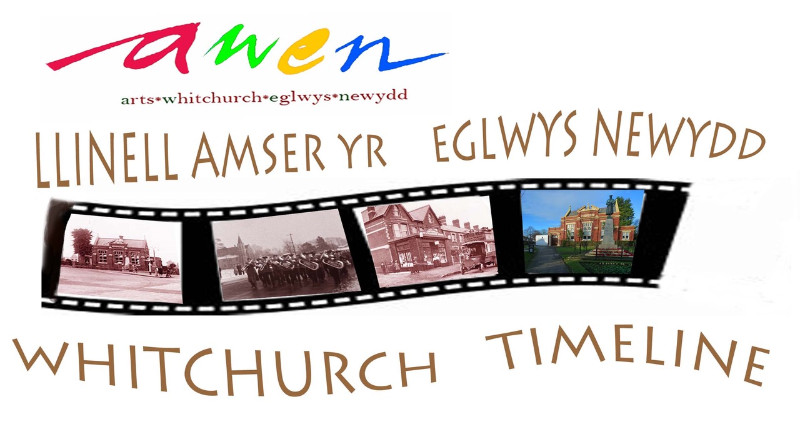 By: on 26/03/2021  
LET'S GO GARDENING
Yesterday was a much brighter day and one I had been looking forward to because the garden centres opened at last ! The sun is shining ! Hopefully now we can all have another think about fruit and veg to grow in a small garden or on a patio. We’ve already looked at garlic, shallots, radishes and potatoes in bags. Here are a few more ideas but first......
Now is a good time to do some tidying. Those patio pots will need a soapy clean with a stiff brush to get rid of the winter dust and dirt. If you’re going to plant any veg amongst your flowers or in a small bed of their own, think about a plan and maybe jot down a sketch to remind you. This is a good month to apply some fertilizer to areas you want to plant. This could be in the form of chicken pellets, blood fish and bone meal or seaweed mixture. These will help the soil before any seedlings are planted in later months.
Blueberries
Blueberries are self pollinating so it is fine to have one bush on its own. They make an attractive bush as a patio plant with flowers in spring and rust coloured leaves in autumn. They are hugely nutritious and are easy to grow. What better than cereal or granola with a little crème fraiche and a topping of blueberries freshly picked for breakfast ? If you buy a bare rooted plant – that is one not already growing in a pot – you need to get it in now. Don’t leave it any later. It’s better and easier to buy one already potted. You can then transfer it to a larger decorative patio pot keeping it’s roots and existing soil intact. Surround it in ericaceous compost as it needs an acid soil. Remember to put a few stones or broken crockery in the bottom of the pot to improve drainage. Come July and August they’ll be ready for picking. Delicious !
Salad leaves
Salad leaves are cheap and easy to grow and are great for container growing. They are also packed with goodness. A packet might contain any of the following – rocket, spinach, lamb’s lettuce, radish leaf, mustard and many more. When ready to pick, simply cut off the leaves you need with scissors, wash and add to your salads. Use as soon after picking as possible. Try to leave the main stem in place unless the plant “bolts”. A pot of salad leaves near the kitchen door is really handy and could last you ages.
In April we’ll look at getting some carrots and beetroots going. In the meantime, if you haven’t already done so, and as long as they have chitted to about ¼ inch, get those potatoes into the compost bag or sack as advised last month. Remember to water in dry weather.
Happy gardening !
By: Anthony Evans on 07/03/2021 Wartime Whitchurch Do you have memories of Whitchurch during the Second World War? Were you told stories of that time by parents or grandparents? Would you like to be involved in the Wartime Whitchurch project? We are hoping to gather together photographs, drawings, stories and information to produce a collection of material to be kould you like further information? If so, please get in touch and look out for an information regarding and event we hope to have in the library. Part of the project would be to create an art work, possibly an illustrated map of the village. Illustrated maps can include pictures or drawings of buildings to help bring the area to life. What should we include pubs or churches? Schools or shops? Houses or the hospital? Or maybe you have other ideas? Do you have material which would help us see Whitchurch as it might have looked at the time? Email Awen.cymru@gmail.com to get involved
By: Chris and Nigel Lewis on 17/02/2021 Our next reminiscence group will take place on Zoom on Wednesday 10th March at 2.15pm. All most welcome to share memories of our village and to contribute to our local timeline. Here is the Zoom information - just click on the link Topic: Reminiscence Zoom Meeting Time: Mar 10, 2021 02:15 PM London Join Zoom Meeting https://zoom.us/j/3366546191?pwd=Znc3VTQyWnFuai9pMGdJRHhEaXE3Zz09 Meeting ID: 336 654 6191 Passcode: AWEN21  By: Chris and Nigel Lewis on 19/01/2021 Join our Zoom reminiscence group on Wednesday 10th February at 2.15pm. You will be most welcome. It is a great chance to share memories of our village and to hear about our exciting new project - a Whitchurch time line. Here is the Zoom link. If you are not sure about coming to a Zoom meeting get in touch as soon as possible and we can help. awen.cymru@gmail.com The Reminiscence Group are thinking of producing a Whitchurch Timeline and would welcome suggestions of events/names/buildings which could be included. We have a number of dates already but we feel sure people will have so much more information to add. We hope, when the Library is open for events, we will be able to also host an Open Day about this.
Join Zoom Meeting https://zoom.us/j/3366546191?pwd=Znc3VTQyWnFuai9pMGdJRHhEaXE3Zz09
Meeting ID: 336 654 6191 Passcode: AWEN21 By: Chris and Nigel Lewis on 30/12/2020 Our next informal reminiscence meeting is on
Wednesday 13.1.21 2.15pm Come and join us for a chat over a cup of tea and share your memories of Whitchurch. Here is the Zoom joining detail, all most welcome. Zoom Meeting ID: 336 654 6191 Passcode: AWEN21 * awen.cymru@gmail.com
 By: Chris and Nigel Lewis on 18/11/2020 The Old Tithe Barn Whitchurch - another local history mystery...
Did you know that we had a Tithe Barn in Whitchurch? As far back as 1126 a reference was made to a religious institution and tithes at Stuntaf (the bend in the River Taff), was it at Melingriffith? It seems that a substantial Tithe Barn was situated on Park Road on the western side just south of the Hollybush Inn. Was this the same barn as mentioned in 1126? We don’t know how old the Park Road barn was, but there are examples around Glamorgan in the fourteenth century. A reference in 1791 talks about an ancient lane crossing fields (that are now part of Whitchurch Hospital) to the old Tithe barn, so it was very old even then! The first Tithe map of 1841 shows a Tithe Barn in Park Road with the tenant David Thomas, and the owner Richard Blakemore of Ty Clyd Farm adjacent. The Tithe Barn outline is shown on all of the old OS maps and measures about 100 x 27 ft, probably the largest building in Whitchurch at the time. Was it built of stone or timber framed? Did it have a thatched roof or tiles? Probably with large double doors in the centre to accommodate a full hay wagon.
Here are 2 photos of where I think the old tithe barn used to be
First photo is taken from the 'green' in front of the convenience store (by Park crescent), looking north
Second photo is taken within Whitchurch Hospital car park looking north
The stand of mature pine trees occupies the site
Does anyone know about this? We would welcome any information on the Tithe Barn; we believe the ruins were still visible in 1920. Further fascinating comments see Awen's facebook page.
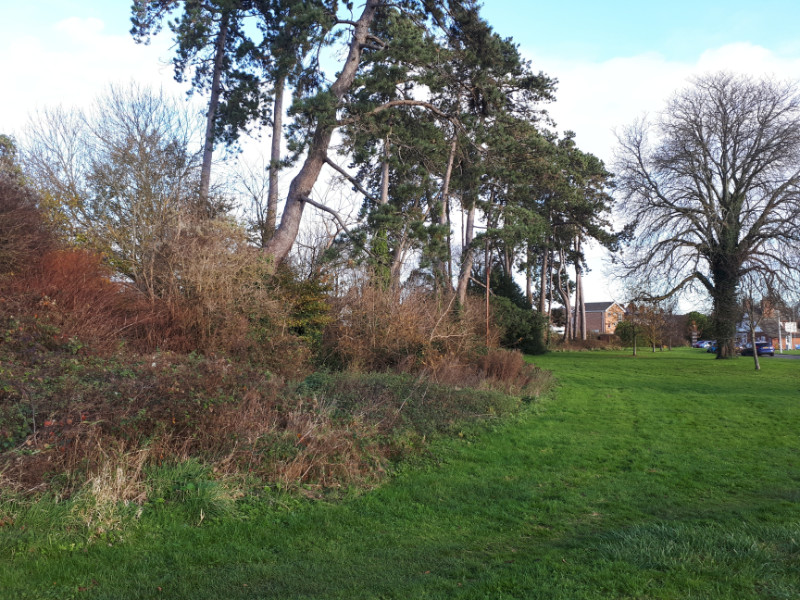 By: Chris and Nigel Lewis on 25/10/2020 Do join our second Reminisence Group on Zoom - bring a cuppa and come and share your memories. All very welcome. Please email us for the joining link. If you are unsure about Zoom do get in touch and we will try to help you!  By: Chris and Nigel Lewis on 24/09/2020 The Reminiscence group will meet by Zoom on Wednesday 21st October at 2.15pm, so make yourself a cuppa and join the conversation. Email Judith on awen.cymru@gmail.com to get the Zoom joining instructions. If you would like help accessing Zoom please ask and we will try to help.  By: on 03/09/2020 1. Pwy oedd yn ddiolchgar am y lletygarwch roedden nhw wedi ei dderbyn gan drigolion yr Eglwys Newydd? 2nd Evacuation Unit US Army 2. Ar College Road beth yw enw’r bwthyn ble mae iâr fach yr haf yn hongian ar y wal? White Rose Cottage 3. Pryd cafodd Millward Terrace ei adeiladu? 1894 6. Ewch am dro bach i lawr Church Road i ddod o hyd i adeilad gyda’r dyddiad 1908. Neuadd yr eglwys 7. Ewch am dro i’r fynwent i chwilio am faddon adar sy’n 85 mlwydd oed. Er cof am bwy mae’r baddon? Win Dunford 8. Ym mha adeilad ar Penlline Road mae ffenestri’r cyntedd wedi eu gorchuddio? Y ficerdy neu rhif 49! 9. Pryd oedd carreg sylfaen y Methodistiaid wedi ei gosod? 1911 10. Pryd oedd yr estyniad wedi ei adeiladu? 1935 11. Beth agorodd yn 1904? The Free Library By: Chris Lewis on 03/09/2020 Do hope that you enjoyed finding answers to the quiz questions - here they are...
Who was grateful for the hospitality shown by the citizens of Whitchurch. 2nd Evacuation Unit US Army
Take a moment to leave the main road and look into Church Road to find the name of the building dated 1908 St Mary’s Church Hall
Which building on Penlline Road has blocked up windows in the porch? The vicarage or possibly number 49! When was the Methodist foundation stone laid? 1911 When was the extension built? 1935 What was opened in 1904? The Free Library
By: on 25/08/2020 More free history resources from the library pages on line - follow this link for the 19th Century British Newspaper archive. https://wales.ent.sirsidynix.net.uk/client/en_GB/card_en/?rm=ONLINE+RESOURC1%7C%7C%7C1%7C%7C%7C0%7C%7C%7Ctrue
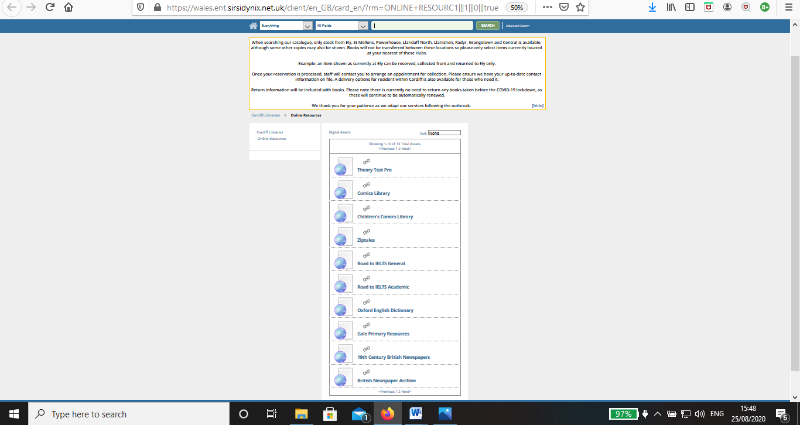 By: Cathays Heritage Library - find our more about our City and your family on 25/08/2020 If you would like to find our more about your family in the past and access Ancestry FREE via your library, take a look at the attached guide from Cathays Heritage Library.
For general library information - take a look here.
https://www.cardiff.gov.uk/ENG/resident/Libraries-and-archives/lockdown-activities/Pages/default.aspx and look for updates in our Facebook pages:
Facebook English https://www.facebook.com/cardifflibraryservice/ Facebook Welsh https://www.facebook.com/gwasanaethllyfrgelloeddcaerdydd/ Twitter https://twitter.com/cdflibraries
By: on 25/08/2020 Treasures of local history available from the Glamorgan Archives - the building may be closed at the moment but you can still follow your local history intererst on line https://glamarchives.gov.uk/ By: Chris and Nigel Lewis on 25/08/2020 Dysgwch am ein hanes lleol yn yr Eglwys Newydd gyda Chwis Awen@thelibrary
2. Ar College Road beth yw enw’r bwthyn ble mae iâr fach yr haf yn hongian ar y wal? 3. Pryd cafodd Millward Terrace ei adeiladu? 6. Ewch am dro bach i lawr Church Road i ddod o hyd i adeilad gyda’r dyddiad 1908. 7. Ewch am dro i’r fynwent i chwilio am faddon adar sy’n 85 mlwydd oed. Er cof am bwy mae’r baddon? 8. Ym mha adeilad ar Penlline Road mae ffenestri’r cyntedd wedi eu gorchuddio? 9. Pryd oedd carreg sylfaen y Methodistiaid wedi ei gosod? 10. Pryd oedd yr estyniad wedi ei adeiladu? 11. Beth agorodd yn 1904?
Diolch i chi am gymryd rhan yn y cwis. Bydd yr atebion ar ein tudalen Facebook ac ar wefan awenthelibrary.cymru ar 1 Medi. By: Chris and Nigel Lewis on 22/08/2020 Keep an eye out for a Zoom meeting of the Reminiscence group, but meanwhile you might like to try this walking quiz? Start from Ararat Church on the Common and end at the library. There are some diversions from the main roads, and don't get carried away by the clues - keep an eye on the traffic, and remain socially distanced of course.
Who was grateful for the hospitality shown by the citizens of Whitchurch.
Take a moment to leave the main road and look into Church Road to find the name of the building dated 1908
Which building on Penlline Road has blocked up windows in the porch? When was the Methodist foundation stone laid? When was the extension built? What was opened in 1904? Thank you for taking part in this quiz. The answers will be on our Facebook page and website on 1st September.
By: Chris Lewis on 06/08/2020 Awen's reminiscence group had shared this picture of the Whitchurch Post Office - corectly identified as Bishop's Road. Listed below are the five locations that we know about where the post office has been in the village - do you know of any more?
Bishops Road near the council offices (c 1910)
Merthyr Road adjacent to current Coffee #1 (c 1920)
Merthyr Road again, corner property leading to Dugdales Garage, where Monmouthshire Building Society office is (c1920)
Merthyr Road again where Caring Cards now stands (more recent)
Merthyr Road yet again within McCalls on corner of Bishops Road (very recent)
In addition, there was also a sorting office and depot in Heol-y-Forlan up until c 1980s. If you have any pictures or memories of Old Whitchurch to share, please get in touch.
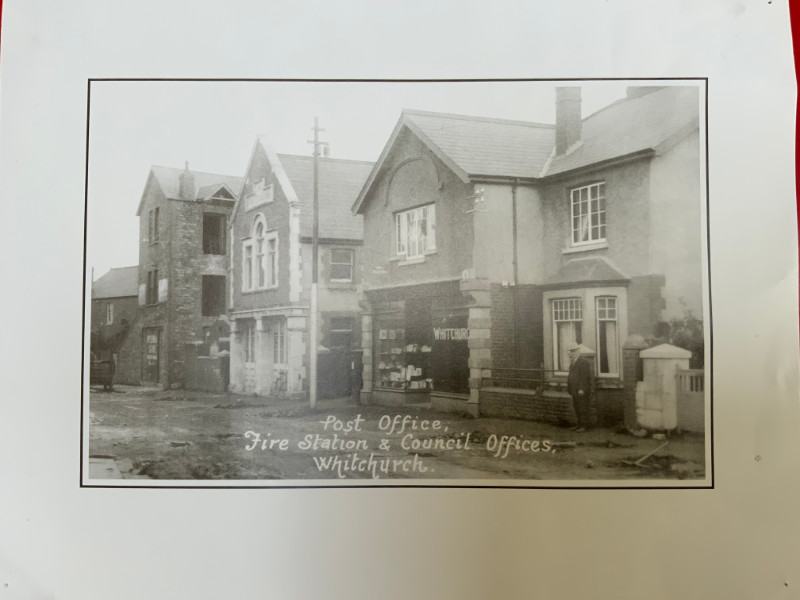 By: Sarah on 05/07/2020 Here is Whitchurch PO, do hope that you can share information about it - where it was then and how many times has the Post Office moved around Whitchurch village? If you have more pictures to share, please do.
 By: Sarah on 17/06/2020 Thank you Carol Spackman for sharing another view of thatched cottages in Whitchurch in a painting in the National Museum on line collection - follow the link below. Nigel and Chris from Awen reminiscence continue the story: We’ve seen this and we were confused then (and are still confused). It is a super composition and quite bucolic; nothing like Whitchurch or South Wales 200 years ago. The brook through Whitchurch has always been a simple stream, and I’ve never seen any evidence of a bridge as shown. The cottages are wonderful and clearly idealised rural homes of the type typical of the village. The castle and mound seem to be much closer than actuality (the castle ruin was long gone according to records). Not sure what the buildings below the castle mound are but we don’t recognise them. Is it a suggestion of the Melingriffith works? The magnificent tree (is it an elm?) would have been gone long ago. Clearly, the painting is titled Whitchurch, near Cardiff so there cannot be any argument... We’d love to hear about others' thoughts, and more about the artist James Baker Pyne. Does anyone else know anything? Thanks Nigel and Chris A catalogue of paintings and sculptures in the collection of the Art Department of Amgueddfa Cymru — National Museum Wales, and includes drawings, watercolours, prints and photographs applied art objects Thank you so much Terry Chard for sharing your knowledge of this painting of Whitchurch and of the painter - really interesting and helpful: I like this painting a lot. I first came across it in the 90’s and kept a copy of it on my computer ever since. I have been to see it numerous times in the museum in an effort to identify its precise location. James Baker Pyne was a notable artist and a follower of Turner. In his early years he was a member of the Bristol School of artists. He was known to travel to Wales to paint. Personally, looking at its provenance, I would have no reason to doubt the claim that it is of ‘our’ Whitchurch. It was owned by Sir Leonard Twiston Davies a notable man with a lot of interest in things Welsh. I can’t see the expertise of both getting this painting wrong. It has cropped up on Facebook before (18th April 2015 for ref), numerous people commenting on it. In my humble (very humble) opinion I see no reason why it could not be 1843’s Whitchurch. At the time our ‘village’ had a very rural landscape. However, I do believe that a lot of ‘artistic license’ has been used by the artist to provide a unique, romanticised version of reality. From the painting I have mapped out the general layout and have compared it with maps of that time. It’s fair to say there is no direct resemblance to any particular location.The only landmarks to go on really are the bridge, the track/road layout, the water and the buildings. The backdrop, arguably, bears a resemblance to what we see of the Lower Garth/Garth area. I have magnified the painting and I am not entirely convinced that is a tower on the left. At the time, in places, ‘the brook’ did not take the same path as it does today. Its route has been conveniently straightened for modern times. As I see it there were only 5 realistic bridge/footbridge possibilities. One at Brook Road/Tabernacle area; one at Ty’n y Cae (Cae Delyn area); one at Ty’n y Parc Mason’s Arms/ castle mound tumulus) area; one behind the tumulus at what we now know as Glan y Nant Terrace and one at The Three Elms. The bridge shown in the painting is not well represented in my view. The left and right hand arches are disproportionate and I believe the artist has been very imaginative with it. The Tabernacle was built in 1866 and so wasn’t there when the painting was done, however there was a row of cottages almost identical to that shown in the painting on the site of what was Jupp’s old sweet factory. I believe it’s just a very imaginative painting of what the artist wants it to be possibly extracting various aspects of his eye line to suit a composition. There that’s my take on it (you can see I’ve got plenty of time on my hands). By: Sarah on 08/06/2020 Nigel and Chris of AWEN’s Reminiscence Group have been walking Whitchurch Village on a Sunday afternoon, comparing the area with the old maps which AWEN have (dating from 1880-1940) This image is of Brook Cottage, which was taken about 1900. It had a thatched roof and painted stone walls and located on Whitchurch Brook. Not sure of it’s age but is shown on the tithe map of 1841 By 1920 it had been demolished and shortly afterwards the Jupp Sweet Factory stood in it’s place. Jupps closed in 1966 and the building then became the Fish Fryers Association. That building was then demolished, and it was replaced by a modern office block The terrace of houses adjacent are still there – does anyone know when they were built?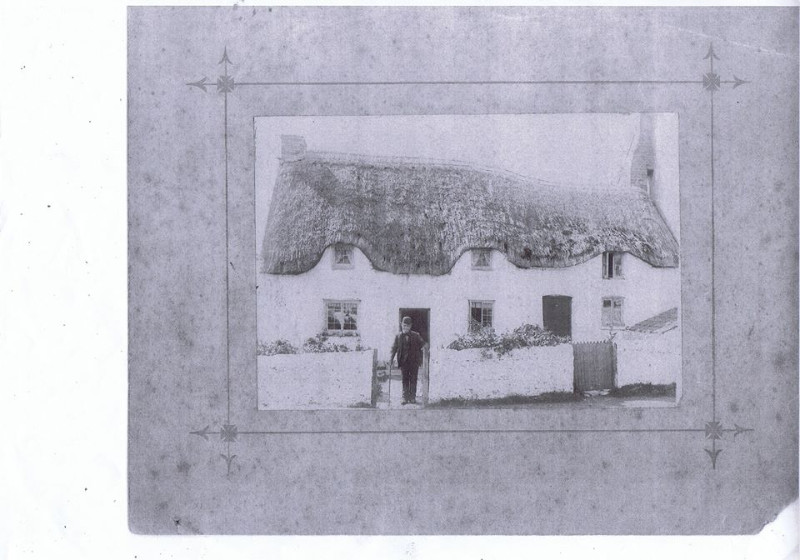 By: Sarah on 09/05/2020 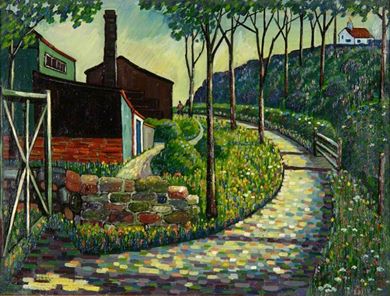 Melingriffith Works Melingriffith WorksThis is Cardiff painter Charles Byrd`s view of Mellingriffith Copper works - where the great librarian John Ballinger grew up - and the reason Whitchurch grew as it did between the Taff and the hills, between city and hinterland. By: Sarah on 28/04/2020  Treoda House Treoda House
Memories of Treoda House Whitchurch This was where the flats are now just past the Fox & Hounds and the family were market gardeners. Very few pictures of this house exist. If you have any pictures or memories to share please message us or email awen.cymru@gmail.com, we would love to hear from you. A map of 1875 shows both Treoda and Trewertha cottages/houses. Treoda was just passed the Fox & Hounds on the bend leading to Manor Way where they have built the flats. The grounds were turned into a small market garden.
Comments John Barrow - My grandparents lived in this house until my grandfather died around 1962 when the house was demolished. The castle mound behind the house was excavated but nothing was found. Manor Way was named for the castle/manor. An original of this painting is hanging in my mother's front room. So this is probably right where my flat is now? (Clos Treoda, facing the road) Would that also be where the castle mound was? Lovely to see that. I used to live in a flat there (Clos Treoda) I live in Brookside Court in Glan y Nant Road. Before the flats were built in 1965 thee was a garden centre in the site. Is it the same place? |
|||||



